- Skip to main content

Food Tours Japan
Eat, Drink & Cook in Japan

Discover Japan’s best gourmet travel experiences
GET FREE UPDATES! No charge. No spam. Only love.
Main Content

Tokyo Food Tours: 12 Best Gourmet Travel Experiences

Kyoto Food Tours: 9 Best Gourmet Travel Experiences

15 Best Osaka Food Tours [2024 Update]
[social_warfare]
Food Tours Japan helps you discover the best gourmet experiences in Japan, the world’s number one food destination. Pack your chopsticks, and dive into elegant and harmonious cuisines developed from centuries of artistry, to deliciously addictive soul foods.
Start your journey in Tokyo, the world’s premier city for food-lovers with the most Michelin-starred restaurants. Savour the best of Japan’s cuisine and local delicacies on a Tokyo food tour .
Stroll around Shinjuku’s narrow back streets and taste sizzling yakitori in Memory Lane, or discover where the locals go out at night. Fun-seekers will love the Robot Restaurant’s sensory overload of action and lights, which is more cabaret show, than a place for serious foodies. Or, combine sightseeing with a culinary experience during the day.
Tantalise your taste buds with fresh-off-the-boat sashimi at Tsukiji Market and witness the drama of Tokyo’s famous tuna auction at its new home, Toyosu Market . After all that delicious sushi, wash it down with a sake tasting or brewery tour .
For a more hands-on culinary experience, learn how to cook ramen and gyoza, wagyu beef and more at a Tokyo cooking class .
Ranked number two in the world for the most Michelin star restaurants, Kyoto is home to some of Japan’s most refined dishes. On a Kyoto food tour , experience the finest kaiseki multi-course meal and discover restaurants and bars in Kyoto’s geisha districts, Gion and Pontocho.
But don’t leave spotting a geisha to chance! For a once-in-a-lifetime experience, enjoy the company of Kyoto’s elegant and legendary entertainers at a geisha and maiko dinner show .
Or, take a break from shrines and temples with a sake brewery and tasting excursion in Kyoto’s quaint and pretty Fushimi district.
Osaka is a foodie paradise, and its people are famous throughout Japan for their love of food. They’re so passionate about cuisine, they have a saying kuidaore which means to ‘bankrupt oneself through extravagance with food.’
Osaka’s friendly and outgoing locals makes it a perfect place to experience delicious local soul foods like takoyaki and Japanese cuisine.
Take a food tour in Osaka and wander around Dotonbori’s neon-lit streets tasting food as you go at one of the many izakaya or standing bars. Or, why not visit Kuromon Market with its seafood-laden food stalls.
Taste the beauty of Japan on a culinary adventure and get a deeper insight into the nation’s culture. A Japan food tour is a must-do travel experience and one you’ll never forget!
Image: Sushi!!! / 鮨 by Toshihiro Gamo , used under CC BY-NC 2.0 DEED / Edited from original
The Best Japan Food Tours
Discover the best Japan food tours for a wide variety of cultural and culinary treasures! Japan’s food culture is a delightful blend of tradition and innovation, offering everything from delicate sushi and sizzling yakitori to soul-warming ramen. Whether you’re an adventurous eater or a seasoned connoisseur, our Japanese food tours suit every type of traveler. Factors like group size, dietary requirements, and city preferences are essential when choosing a tour. This guide will help you navigate the delectable world of Japanese cuisine. Keep reading to explore the incredible food tours in Japan and create unforgettable memories in the Land of the Rising Sun!
View this post on Instagram A post shared by Tourist Japan (@tourist__japan)
Most Comprehensive Japan Food Tour
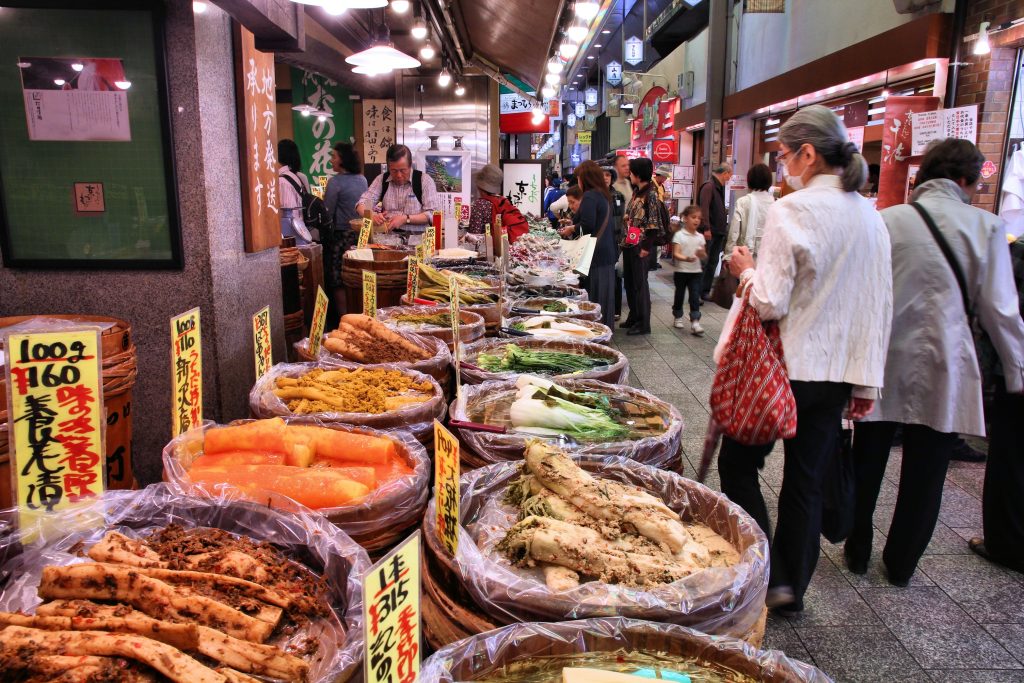
Immerse yourself in a captivating culinary journey with our Flavors of Japan 7 Day Tour Package . Showcasing the delectable cuisines of Tokyo and Kyoto , this tour is perfect for foodies seeking a blend of history, culture, and delectable delights. With pre-arranged accommodations and activities, you can relax and enjoy one of the most extensive food tours Japan offers, led by knowledgeable local guides.
In Tokyo, you’ll explore Nihonbashi, Tokyo’s oldest district, uncovering its rich history and culinary gems. Next, discover Asakusa’s enchanting Sensoji Temple, where ancient traditions come alive. Savor diverse flavors in cozy restaurants on an izakaya adventure in Tokyo’s contemporary Rokku area. Then, treat yourself to traditional Japanese drinks like sake , whiskey , and cocktails at the best bars in Kyoto . Finally, wander the Nishiki Market, called the “Kitchen of Kyoto,” and absorb its vibrant energy.
Tokyo Market and Cooking Experience
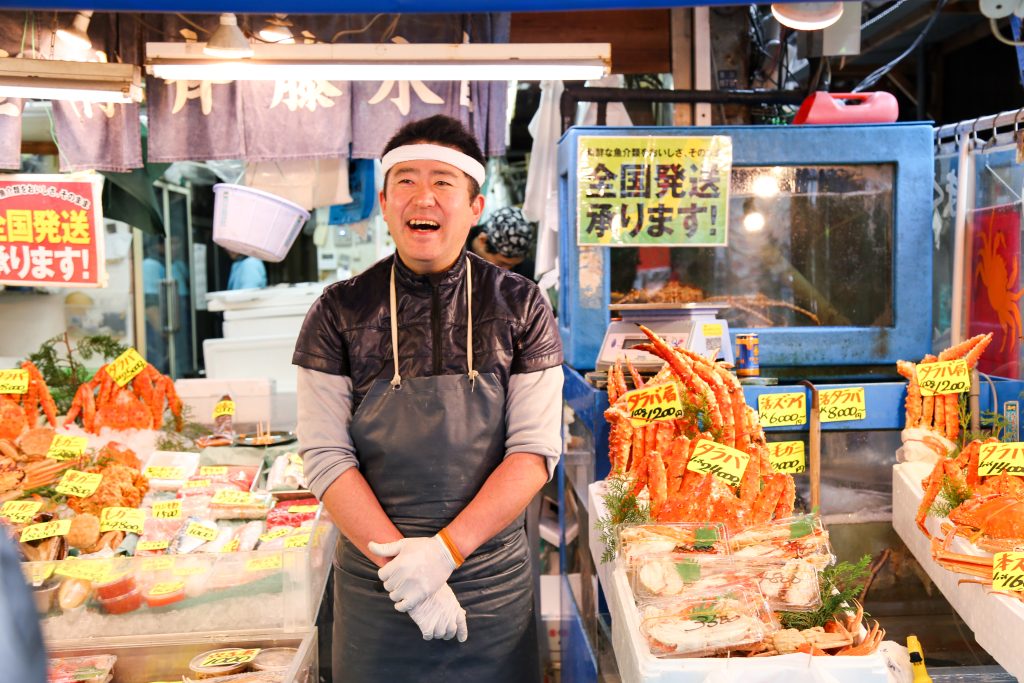
Delve into the heart of Japanese cuisine with our Tokyo Tsukiji Fish Market Tour and Cooking Experience . This is a delightful opportunity to find the essence of local food culture and master the art of sushi. Depending on availability, you may join a bento , matcha sweets, soba noodles, or ramen cooking class instead. Whether you’re a food enthusiast or a curious traveler seeking an immersive cultural encounter, this Japanese cooking class promises an unforgettable gastronomic adventure.
An expert guide will lead you through Tsukiji Fish Market , an iconic Tokyo farmers market and emblem of the city’s culinary heritage. Learn about its historical significance and explore the vibrant array of stalls offering fresh produce and seafood. Then, learn to create various sushi styles during a hands-on cooking workshop guided by a professional chef. This is one of the best Tokyo food tours, granting you insider access to the market’s history and dynamics and teaching you to craft sushi with Japan’s rich flavors.
Kawaii Culture and Food Tour in Tokyo
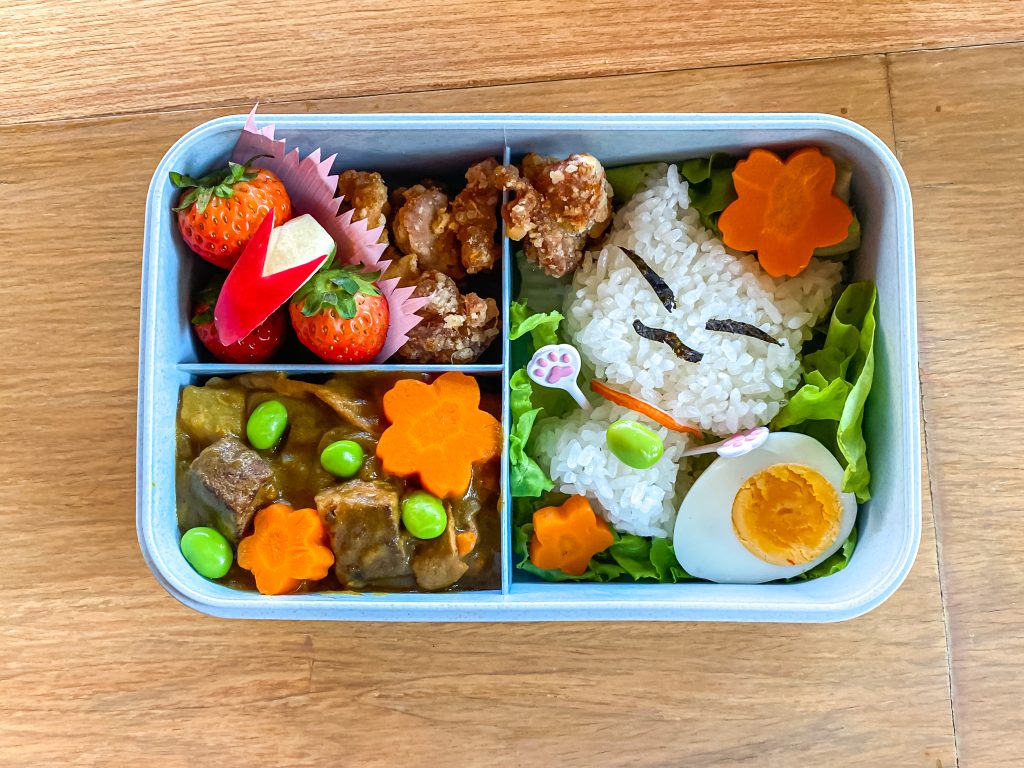
Experience Tokyo’s vibrant and quirky side in the lively Harajuku district. Discover the enchanting world of “cute food” culture. Enjoy the latest trends, explore colorful streets, and savor a sweet rainbow treat. Expert guides will show you Harajuku’s hidden gems and share captivating stories of its evolution as Japan’s pop culture capital. You’ll also enjoy a memorable lunch inside a pop art masterpiece. This is an exclusive and unparalleled tour that truly captures Harajuku’s unique spirit.
Best Ramen Tour in Tokyo
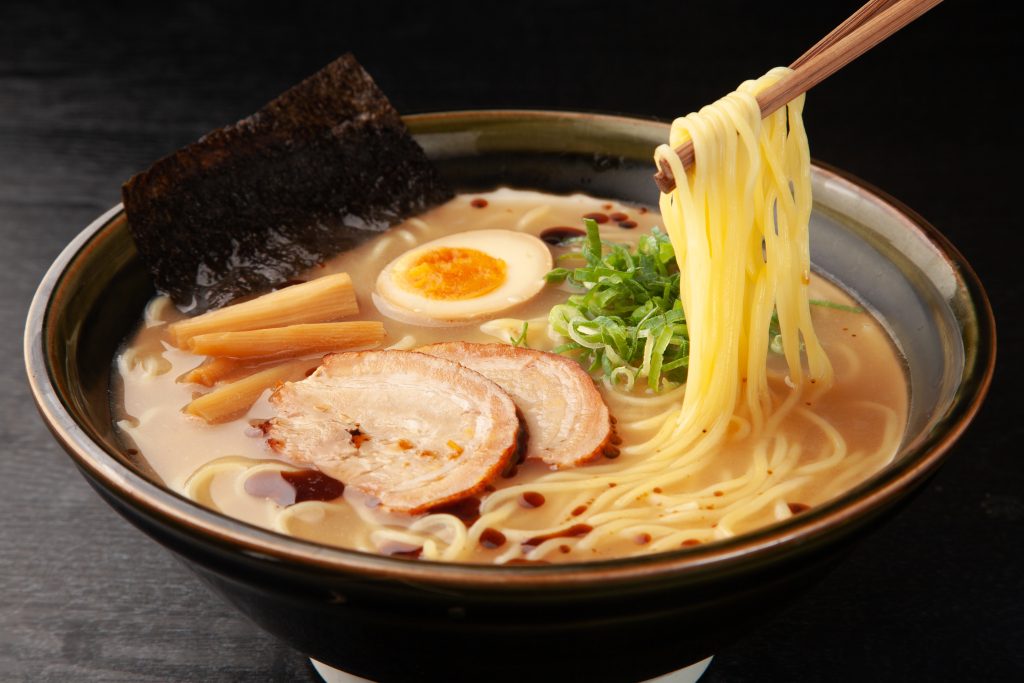
Embark on the Ultimate Ramen Tour in Tokyo , a three-hour culinary expedition that introduces you to the soul-satisfying world of ramen. This tour is an excellent fit for food enthusiasts and globetrotters seeking an authentic taste of Japanese cuisine . Savor the rich flavors and cultural significance of six different mini-bowls. Led by a local expert, you’ll delve into the artistry, history, and etiquette behind this beloved dish. Learn the intricate process that creates ramen’s unique essence to gain a profound appreciation for this iconic comfort food.
Best Kyoto Food Tour
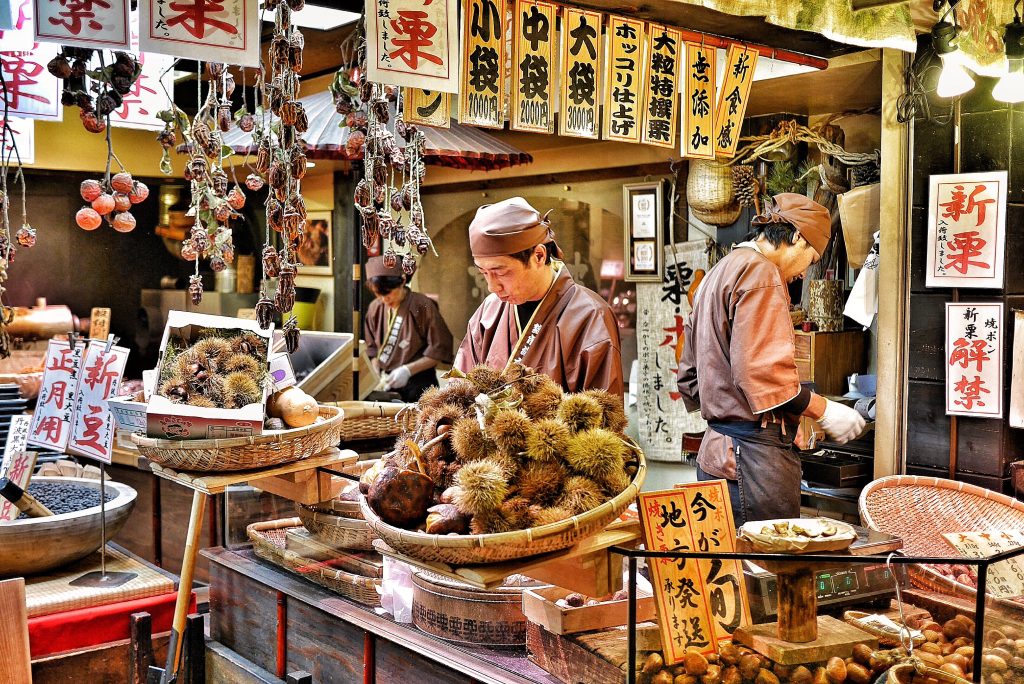
Indulge yourself in our enchanting Evening Food Tour in Kyoto , a captivating exploration of history and flavors. Ideal for those drawn to cultural heritage and culinary delights, this tour allows you to meander through iconic streets in the geisha districts of Gion and Shirakawa. Savor light bites as you uncover hidden treasures and enjoy fascinating stories of the local history. The multi-course Japanese dinner that concludes the tour is a fusion of global and regional tastes. Delve into the world of geisha as you embark on one of the most authentic Japan street food tours.
Most Unique Hiroshima Food Tour
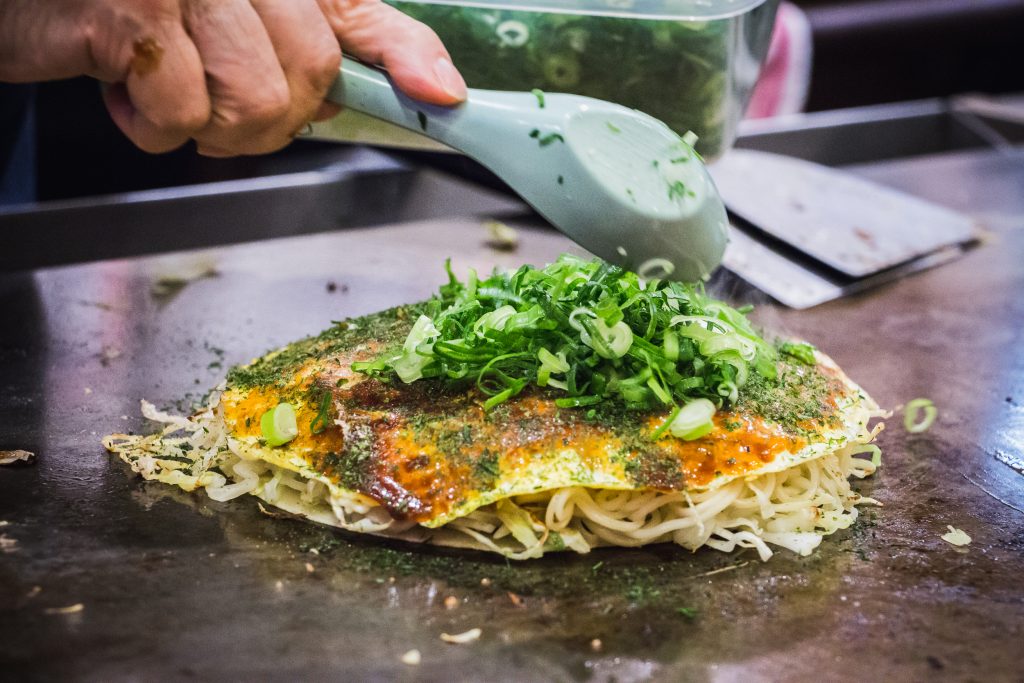
Our Hiroshima Food Tour is a guided exploration unveiling the city’s rich flavors and history. Savor the true essence of Hiroshima’s friendly community atmosphere through a diverse range of local eateries. Perfect for foodies and culture seekers alike, this tour blends authentic tastes with intriguing stories from expert guides. Revel in local delicacies like tsukemen, a unique twist on traditional Japanese ramen. You’ll also visit family-owned stores filled with distinctive snacks and souvenirs. This journey through Hiroshima’s best food and drinks connects you with the region’s vibrant heart and spirit.
Most Immersive Osaka Food Tour
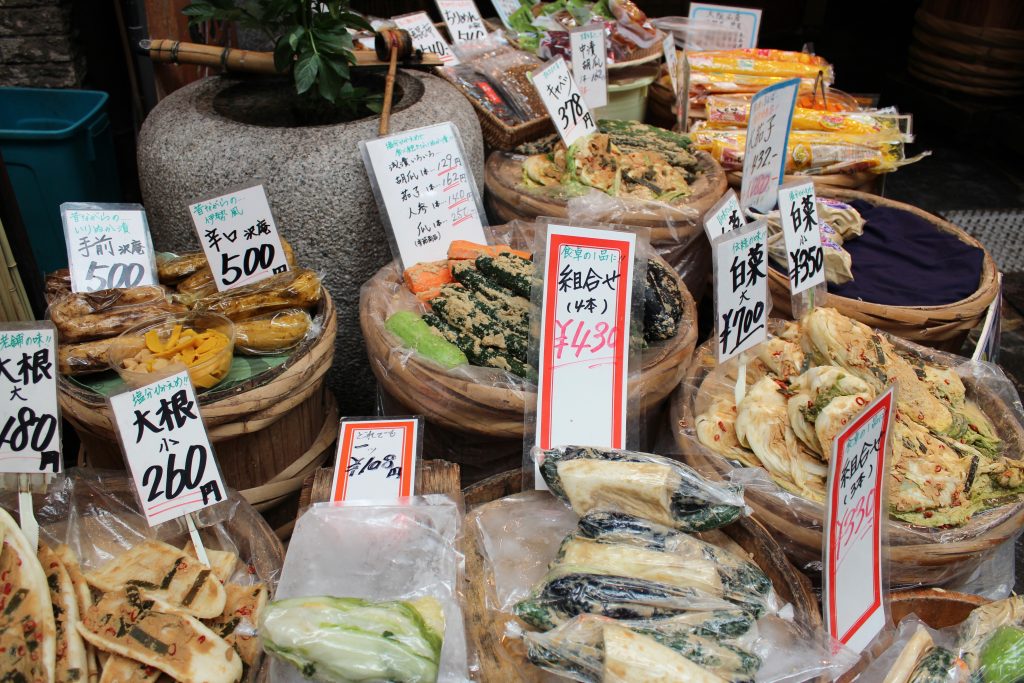
Step into the vibrant world of Osaka’s Kuromon Market during this Osaka Market Tour and Cooking Class . This excursion is ideal for travelers seeking a hands-on introduction to the local food scene and an authentic connection to the city’s culinary culture.
Explore the lively Kuromon Market as a local expert reveals the market’s history and helps you select the freshest local treats. The adventure continues with a cooking class where you’ll learn to prepare your choice of Osaka street food or Japanese home cooking. You’ll master sumptuous dishes in an intimate city studio, gaining insider tips to recreate the magic at home. If you’re passionate about food and eager to dive into local gastronomic treasures, this Osaka food tour is the one for you.
We’re Hopeless Ramen-tics!
The best food tours in Japan offer diverse experiences for every kind of traveler. From bustling market tours that immerse you in the heart of local flavors to hands-on cooking classes that unveil the secrets of Japanese cuisine, food tours provide an authentic gastronomic journey. If you have a taste for exploration, our multi-day tour packages showcase the best of each city’s culinary gems. Whether you’re an avid foodie, a cultural enthusiast, or simply seeking to savor the essence of Japan, these food tours cater to your cravings and curiosities. Let Tourist Japan help you to savor Japan’s culinary treasures in the most unforgettable way. Looking for more inspiration for your trip to Japan ? We have plenty of valuable information, like when to visit , how to find Japan’s best beaches and important cultural tips .
See all Japan Food and Drink Tours
Subscribe for insider tips to Japan Enter your email address to stay in-the-know of what's new in Japan. We promise to only send you guides to the best experiences. Email Keep Me Updated
Recommended

Related Articles

6 Important Japanese Customs

5 Things You Can Only Do in Japan

5 Things To Do In Japan In Autumn

Kaiseki: A Feast for the Senses

Best Bars in Kyoto

Best Restaurants in Kyoto

Best Bars in Tokyo

Tokyo Farmers Markets

Japanese Chopstick Etiquette

Best Bars in Osaka
THE 10 BEST Japan Food Tours
Japan food tours.
- Historical & Heritage Tours
- Cultural Tours
- Sightseeing Tours
- Up to 1 hour
- 1 to 4 hours
- 4 hours to 1 day
- 5.0 of 5 bubbles
- 4.0 of 5 bubbles & up
- 3.0 of 5 bubbles & up
- 2.0 of 5 bubbles & up
- Chinese (Simplified)
- Likely to Sell Out
- Special Offers
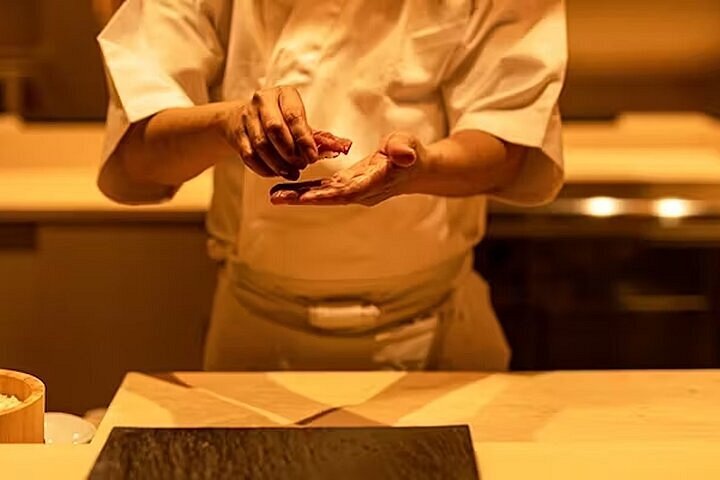
- The ranking of tours, activities, and experiences available on Tripadvisor is determined by several factors including the revenue generated by Tripadvisor from these bookings, the frequency of user clicks, and the volume and quality of customer reviews. Occasionally, newly listed offerings may be prioritized and appear higher in the list. The specific placement of these new listings may vary.

1. Tokyo Bar Hopping Night Tour in Shinjuku

2. Tokyo Tsukiji Fish Market Food and Culture Walking Tour

3. Kyoto Night Foodie Tour

4. Shinjuku Izakaya Food Tour

5. Nighttime All-Inclusive Local Eats and Streets, Gion and Beyond

6. Osaka Local Foodie Walking Tour in Dotonbori and Shinsekai

7. TeamLab Planets Walking Tour with Toyosu Fish Market Buffet Lunch

8. Tsukiji Fish Market Food Walking Tour

9. Best of Shibuya Food Tour

10. Shibuya All You Can Eat Food Tour Best Experience in Tokyo

11. Osaka Bar Hopping Night Walking Tour in Namba

12. Small-Group Wagyu Beef and 7 Japanese Dishes Tokyo Cooking Class

13. Nishiki Market Brunch Walking Food Tour

14. Famous Gyoza (dumplings) and Karaoke Experience Tour in Ueno

15. Small Group Tokyo Food Tour - A Journey Through Time Through Food

16. Secret Food Tours Tokyo w/ Private Tour Option

17. Eat, Drink, Cycle: Osaka Food and Bike Tour

18. Tuna Auction and Tokyo Toyosu Fish Market Tour

19. Kyoto Bar Hopping Night Tour

20. Tsukiji and Asakusa Food and Drink Cultural Walking Tour (Half day)

21. Kyoto Foodie Night Tour

22. Tokyo Tsukiji Food & Culture 4hr Private Tour with Licensed Guide

23. Tokyo After 5: Savouring Culinary Delights of Japan

24. Kuromon Market Food Walking Tour in Osaka

25. 3-Hours Tokyo Local Bar & Izakaya Crawl in Shinjuku Area

26. Toyosu Tuna Auction and Tsukiji Market by Gov Licensed Guide

27. The Award-Winning PRIVATE Food Tour of Kyoto: The 10 Tastings

28. Explore Nishiki Market: Food & Culture Walk

29. The 10 Tastings of Tokyo With Locals: Private Street Food Tour

30. Tokyo downtown bicycle tour Tokyo Backstreets Bike Tour
What travelers are saying.
- Alexander S 1 contribution 0 5.0 of 5 bubbles Good and drinks to local areas and a bit of history along with it Angelito was awesome and took us to some great spots! We went to a couple places to drink and eat and also saw a couple Geisha and passed the red light district too which was a lot of fun. Would recommend for people who want to experience what it's like to be a local of Kyoto Read more Review of: Nighttime All-Inclusive Local Eats and Streets, Gion and Beyond Written April 24, 2024 This review is the subjective opinion of a Tripadvisor member and not of Tripadvisor LLC. Tripadvisor performs checks on reviews.
- Biswas L 1 contribution 0 5.0 of 5 bubbles Recommended Had a great time with Noz. A really fun group, great food and good locations. I would recommend for anyone visiting Osaka. Read more Review of: Osaka Local Foodie Walking Tour in Dotonbori and Shinsekai Written April 25, 2024 This review is the subjective opinion of a Tripadvisor member and not of Tripadvisor LLC. Tripadvisor performs checks on reviews.
- +61 7 3368 1966
Food Tours in Japan
Home / Small Group Tours /
Small Group Gourmet Food Tours, Japan
Our 2024 &2025 Food Tours of Japan are adventures, where you can see the sights and nature, experience the culture, and eat exceptional food.
Journey to the East’s Food Tours of Japan are a wonderful way to see Japan. Their foundation,’ Washoku’ , Japanese food, is UNESCO recognised as an Intangible Cultural Heritage.
The Japanese food has deep and complex traditions and is regionally based. That is why these culinary extravaganzas are staged in different regions of Japan, like Kyushu and Hokkaido. One of our goals is to showcase the depth and breadth of the Japanese food culture from Michelin-starred restaurants through to excellent street food, as well as introducing some modern fusion delights.
Our Japan Food Tours are not just “eatathons”. We will introduce you to some amazing people, including some outstanding chefs and producers, show you beautiful landscapes and famous sites.
Along the way, you will learn the care and pride of generations old producers of Japanese ingredients such as soy sauce, green tea and vegetables. Other food-related cultures such as ceramics, knives, lacquerware are also all part of your experience on these culinary tours.
Signature Our Signature tours offer the most comprehensive cultural exposure.
Discovery Our Discovery tours provide up-and-close encounters with traditional life and natural landscapes into the more remote regions of Japan.
Comfort With a focus on comfort and ease, our Comfort tours deliver an authentic experience with a few extra creature comforts to make for a more relaxed and supported trip.
Spring (Mar – May)
Summer (Jun – Aug)
Autumn (Sep – Nov)
Winter (Dec – Feb)
13 day tour
2024 food tour of kyushu, japan in autumn, 14 day tour, 2025 food and cherry blossom tour of kyushu, japan, 2025 food tour of hokkaido japan, more about japan, food tours features, why travel with us, accommodation styles, related articles, japan food tours 2024 &2025.
We have released a number of gourmet food tours of Japan. They operate in different parts of Japan and take maximum advantage of the seasonal food of the regions. The Food Tour of Kyushu operates in spring with the cherry blossoms and in Autumn under the beautiful fall colours. The Kyushu tours will introduce you to some of the famous pottery and the influences of a number of countries on Kyushu’s history and culture.
To the north is the Food Tour of Hokkaido. This tour operates during May when the weather is pleasantly warm and the fresh food of the area is superb. It is a wonderful opportunity to learn about the culture in Hokkaido and the indigenous Aino people.
At Journey to the East we are committed to providing authentic and most memorable experiences in Japan – for both Small Group Tours and custom-built Private Tours. Whether it is your first visit or you have been several times to Japan, you will always find something new and have special experiences with Journey to the East. Our travel style is chosen to immerse you in the culture and landscape of the country and expose you to a rich variety of unique experiences.
We do this by taking you beyond the tourist hotspots to explore the lesser-known parts of Japan. Our tours are designed to strike the right balance between the classic highlights and local secrets, the urban and the rural, the historic and the contemporary, and in doing so, reveal the true heart of Japan.
With Journey to the East, you will have fun and be safe on your deeply rewarding journey through this endlessly fascinating country!
We are specialists that just handle tours within one country, Japan. Whether you are from the USA, Canada, UK, Australia, New Zealand or beyond we meet you at the airport upon arrival into Japan and ensure a smooth and stress-free time in a foreign land.
Ryokans is a Japanese style accommodation, mostly consists of Japanese style rooms with tatami matt floor and futon bedding, and private ensuite. Some ryokans have a western style room with beds. A Japanese style room always has a low table and flat cushions to sit on, but the room may or may not have chairs. Most ryokans have an additional large public bath for guests and includes kaiseki style dinner. Breakfast can be Japanese style (rice, miso soup, fish etc.) or western style buffet.
Western Style Hotels
Size and standard vary from 5-star large international chains to regional small business hotels. Generally, in Japan twin rooms (two single beds) are more common than double rooms (one double bed), and some hotels in regional cities only have twin rooms. Room sizes are generally smaller in cities. Also beds and pillows tend to be firmer than those in western countries.
Shukubo (temple lodging)
The vast majority have Japanese style rooms and shared bathroom although there are limited number of temples with a western bedroom with ensuite. The stay at shukubo includes Buddhist vegetarian dinner and breakfast. Dinners are served early, around 5pm. They are run by monks, and facility and services are basic. Guests can attend morning service in the main hall.

Japanese home cooking recipes Vol.5 – Okonomiyaki

Japanese Home Cooking Recipes Vol.4 – Tempura
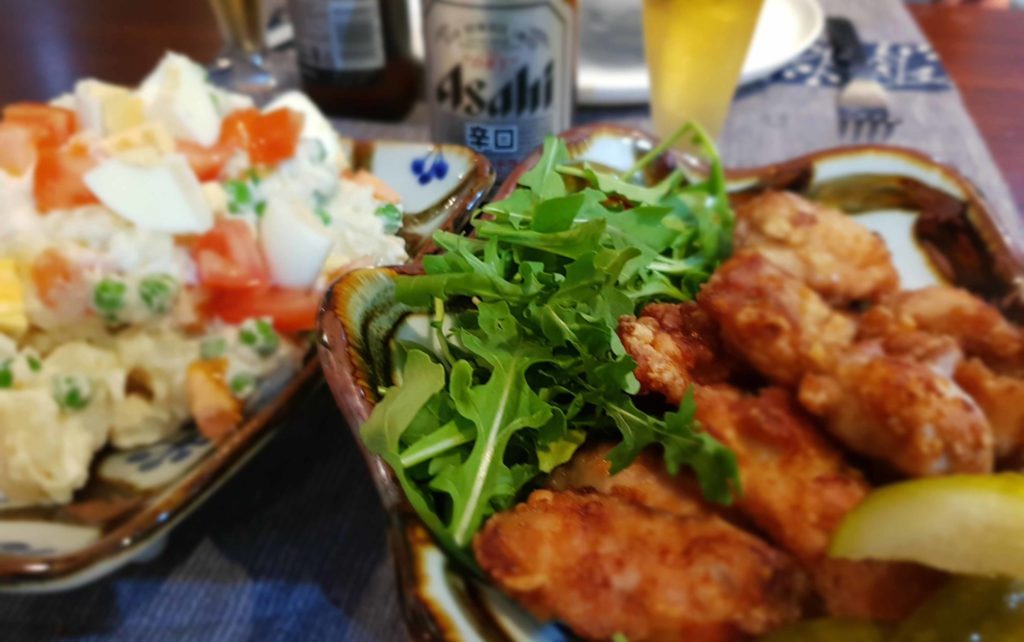
Japanese Home Recipes Vol.3 – Karaage and Potato Salad
Get in touch and book your next trip with journey to the east, privacy overview.
Boutique Japan
Japanese Food: Culinary Travel in Japan
If you’re planning a trip to Japan, chances are that Japanese food is one of the things you’re most excited about (whether or not you refer to yourself as a “foodie”).
Japan is a wonderful destination for so many reasons , including its history, tradition, culture, and arts. But for most of our travelers, Japanese cuisine alone is reason enough to visit.
In the years since our team started Boutique Japan, we’ve watched Japan go from being slightly under the radar — hard to believe now! — to becoming one of the world’s top culinary meccas, as food-loving travelers worldwide have discovered that Japanese cuisine is much more than sushi and ramen (so much so that even foodie honeymoons to Japan have become popular).
If you’ve never visited, chances are you’ve only begun to scratch the surface when it comes to the astounding diversity of foods available in Japan. So to help you enjoy a delightful range of Japanese culinary experiences, both “high” and “low,” we’ve compiled the following:
- Japanese Culinary Experiences : A sampling of some of our favorite types of culinary experiences in Japan.
- What to Eat in Japan : A handy list of Japanese foods to eat during your trip to Japan (and a few “infamous” dishes many visitors find challenging).
- The Best Websites on Japanese Food and Drink : A short list of the best websites dedicated to Japanese cuisine, including sites devoted to everything from street food and Michelin-starred restaurants, to Japanese whisky and coffee.
Originally written in 2014, this page was updated and republished in August 2021.
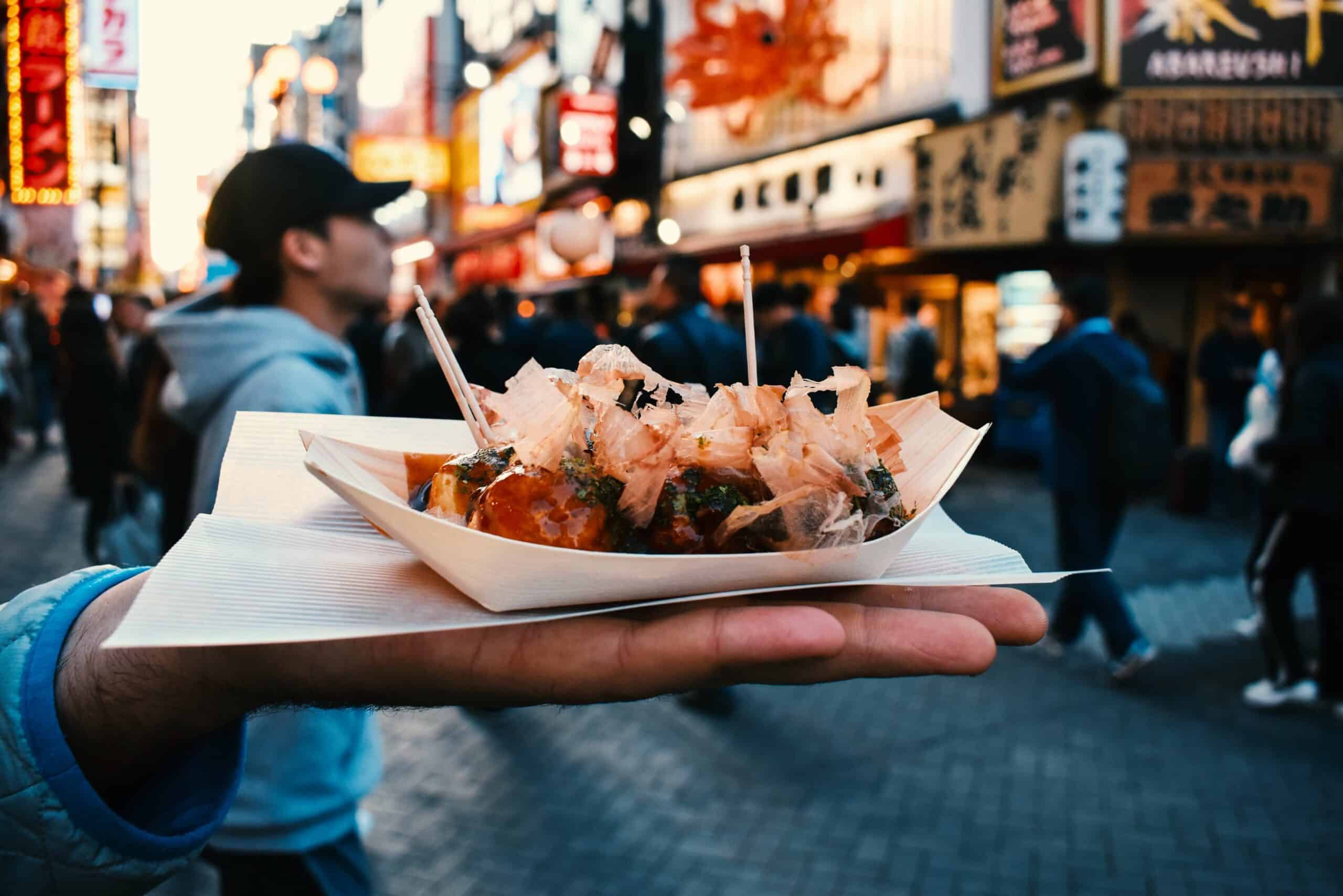
Japanese Culinary Experiences
Below are some of our favorite types of culinary experiences in Japan, though they represent just a sampling of what you’ll discover as you travel around the country!
Private Market Tours in Japan
Visiting a Japanese market with a local expert is one of the best way to immerse yourself in Japan’s culinary culture. Whether you want to visit a famous market, or even a neighborhood grocery store, a private food tour is a great way to get beneath the surface – and of course your guide will have expert insights on where to eat afterwards!
Perhaps Japan’s best-known market is Tokyo’s Tsukiji Market , a must-visit if you are eager to learn about Japanese food. In Kyoto, the best place to immerse yourself in Kyo-ryori (Kyoto cuisine), is at Nishiki Market, a long and narrow shopping arcade packed full of vendors selling a beautiful array of Kyoto’s culinary specialties .
Another unique culinary experience we highly recommend is a visit to a department store food hall, known as depachika . Japan’s department stores are a foodie paradise, offering a mouthwatering selection of sweet and savory, Japanese and foreign, and more food than you could possibly hope to ever sample.
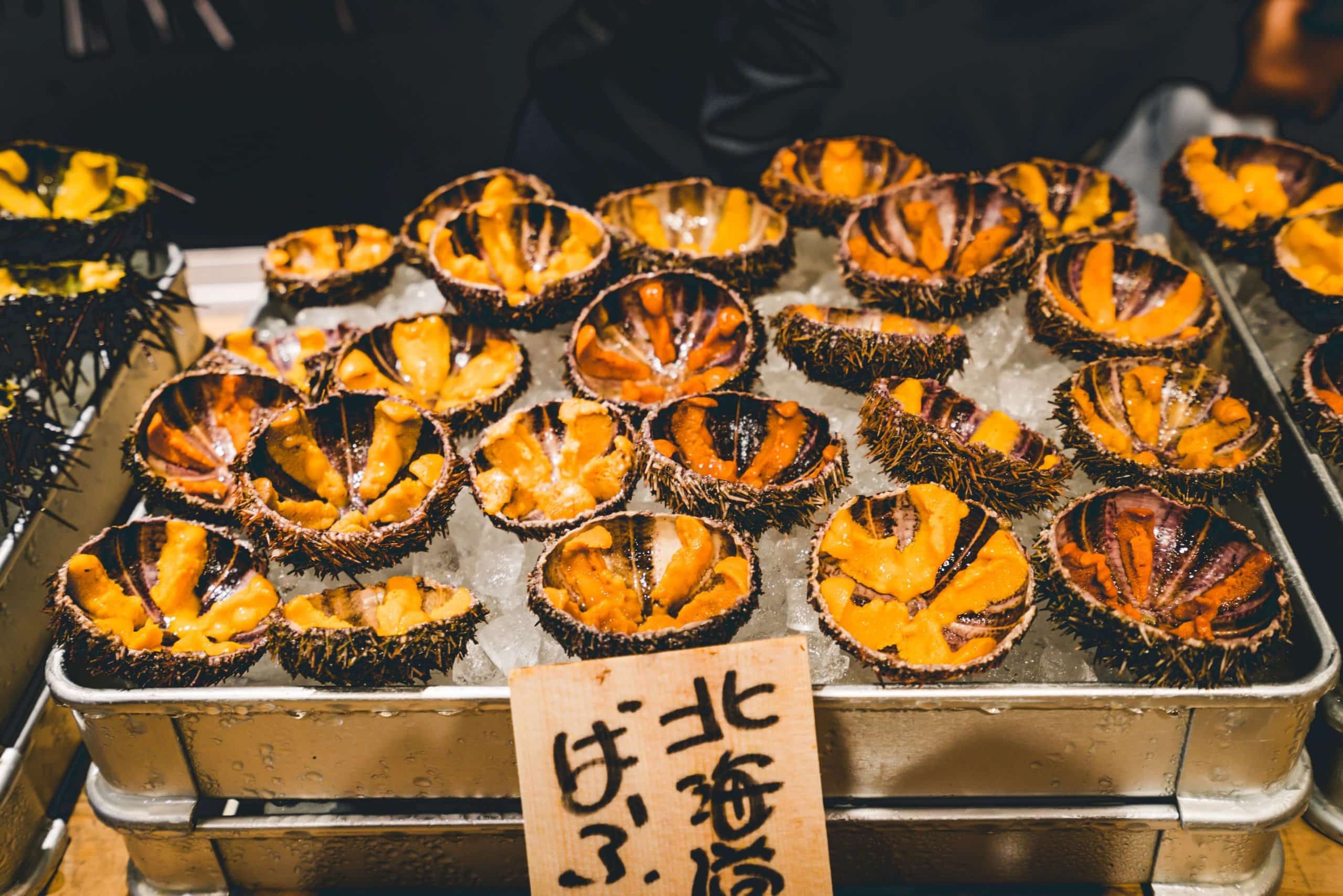
Sushi in Japan
For many travelers, eating sushi in Japan is at the top of the list. Modern-day sushi’s roots are in Tokyo, and for a quintessential sushi experience get counter seats for a special dinner at one of Tokyo’s best sushi-ya . You’ll also find top-quality sushi and sashimi in many other parts of Japan, including Kanazawa , Hokkaido, Fukuoka, and Toyama.
Even if your budget doesn’t allow for extravagance, you can find good sushi at neighborhood sushi shops, depachika food halls, and even kaiten-zushi (“conveyor belt”) restaurants.
Kaiseki Cuisine
Kaiseki is Japanese cuisine in what is often considered its most refined form. A kaiseki meal consists of course upon course of masterfully-prepared dishes featuring seasonal and local specialties.
A stay at a luxury ryokan usually includes a kaiseki dinner – often served in your room, or in a private dining room overlooking a small Japanese garden. Even if you’re not staying in a ryokan during your Japan trip , restaurants specializing in kaiseki cuisine abound, particularly in cities such as Kyoto and Tokyo.
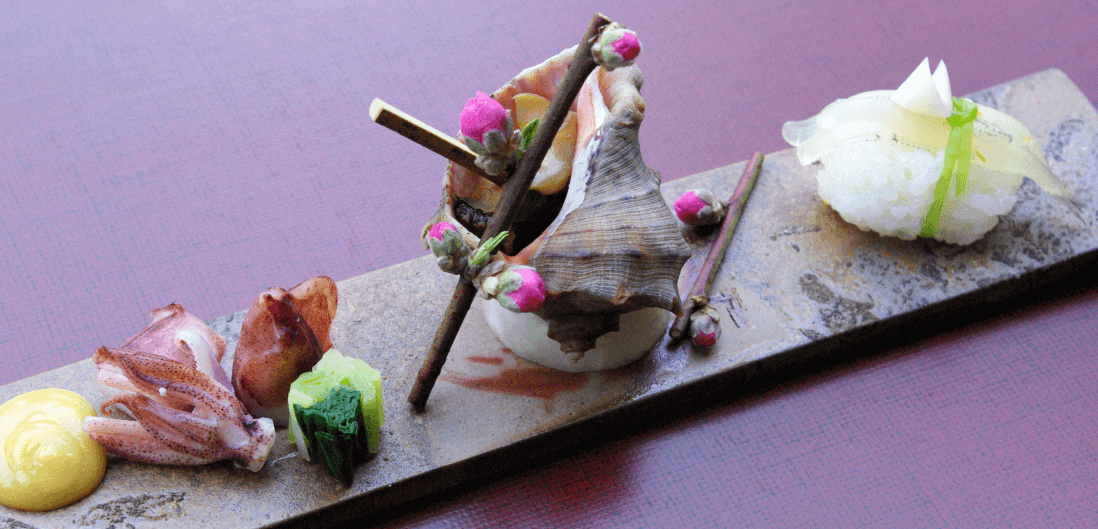
Izakaya , Tachinomiya , and Street Food in Japan
Japan is far from all haute cuisine, and some of your best meals will likely be some of the most casual. While you can experience these without a guide, a local expert can heighten the experience. Not only can your private guide take you to hard-to-find “hidden” establishments, they will also be able to interpret, as most lack English menus or English speakers.
Izakayas in Japan
One of the quintessential Japanese dining experiences, see our full article on the izakaya experience in Japan .
Tachinomi: Stand Bars
At izakaya, the focus is equally on eating and drinking. For an even more casual and drinks-focused experience, head to a tachinomiya . Tachinomiya ( tachi means stand, nomi means drink) are “stand bars,” where you can really rub shoulders with locals. These casual bars can be found throughout Japan, and are a great place to strike up a conversation with locals over reasonably-priced drinks and unpretentious Japanese bar food.
Street Food in Japan
In Japan, street food is generally not as prevalent as in other countries in the region. However, there are some cities — such as Osaka and Fukuoka — with thriving street food cultures. You’ll also always find great street food at Japanese matsuri (festivals) , when colorful food stalls line the streets.
Fine Dining and Michelin in Japan
The Michelin Guide is controversial in Japan. While many in Japan embrace it, some chefs and critics denounce it as a foreign standard being imposed on Japanese cuisine.
No matter your stance, one thing is certain: Japan is home to more Michelin-starred restaurants than any other country in the world — and when Japanese critics and Michelin inspectors agree on a restaurant, you can usually be assured of a remarkable culinary experience.

Dinner with a Geisha or Maiko
When done in an authentic, non-touristy manner, the chance to enjoy tea or dinner with a geisha or maiko (apprentice geisha) is a fascinating cultural experience. Kyoto , with its thriving geisha culture, can be a good place to do this, but it’s also possible in other cities such as Kanazawa, and even Tokyo.
Cooking Lessons in Japan
Taking a private Japanese cooking class is a great way to learn more about Japanese ingredients, while adding some recipes to your repertoire. You can learn highly authentic dishes, or a mix of authentic and slightly-adapted dishes to ensure you can re-create the recipes using ingredients available to you in your home country.
Sake Tasting and Breweries
Most people don’t realize how complex and delicious nihonshu (sake) really is. Going on a private tour with a local sake expert is the best way to learn about different varieties of sake, through tastings and explanations.
In many parts of Japan you can also visit a shuzo (sake brewery). During a brewery tour you’ll have the opportunity to see where and how sake is made, and the chance to ask all the questions you might have.
Other Countries’ Cuisines
Japan is home to some of the world’s best French, Italian, and Chinese restaurants (not to mention excellent Thai, Korean, and Indian restaurants). While most travelers understandably prefer to focus on Japanese food while in Japan, in larger Japanese cities it’s worth seeking out a top-notch non-Japanese meal.

What to Eat in Japan: Foods to Try
As you embark on the culinary experiences described above, you’ll have the chance to sample a huge variety of Japanese foods. Here is a list of foods we recommend trying during your trip Japan, along with a few some travelers choose to avoid!
(If you have special dietary needs, see our article on traveling to Japan with dietary requirements ).
- Bento : Few things are as pleasant as enjoying a gorgeous seasonal ekiben (bento box designed for train travel) while riding the shinkansen (bullet train ).
- Croissant : As those who already know are well aware, the quality of bread and pastries in Japan is simply amazing.
- Curry : While not spicy like the curries of many other countries, there’s nothing more comforting than a made-from-scratch Japanese curry.
- Fruit : Square watermelons aside, it’s seriously worth splurging on some high-end Japanese fruit, and one of the best places to do so is at a depachika .
- Gyoza : Dumpling heaven.
- Karaage : Japan’s mouthwatering take on fried chicken.
- Katsuobushi : Some travelers resist the ubiquitous bonito fish flakes, but those who love them do so with a passion. They’re served on top of a variety of foods, including tofu and takoyaki .
- Kushi-katsu : Deep-fried skewered meats and vegetables.
- Mabo-dofu : The Japanese take on Sichuan’s mapo tofu , this spicy tofu-focused dish is rich and addictive.
- Miso : Whether in miso shiru (miso soup) or on its own, authentic Japanese miso is leaps and bounds better than what most people find in their home countries.
- Nabe : Nabe literally means “pot,” and the food — a family-style hotpot featuring ingredients that can include vegetables, meat, and seafood — is one of our favorite things to eat in winter .
- Niku-man : Chinese-style meat buns often found at convenience stores , but better at depachika and shops specializing in buns and dumplings.
- Niku-jaga : A stew featuring beef and potatoes that is a national home-cooked favorite.
- Oden : Oden features a variety of ingredients (daikon, egg, fish cakes, and more) slow-cooked in a dashi-based broth. Specialty shops are usually best, but in winter oden also appears on izakaya menus and — like niku-man above — is even available at conbini .
- Okonomiyaki : An essential casual specialty of western Japan, okonomiyaki is one of the richer and heavier foods you’ll try in Japan. Read more about this famous dish in our full post on foods to eat in Osaka (it’s also particularly famous in Hiroshima ).
- Onigiri : One of the world’s most perfect snack foods, onigiri are triangle-shaped rice balls that can be prepared simply or filled with goodies (such as fish or umeboshi ).
- Ramen : One of the country’s most famous foods, see our full article on ramen in Japan .
- Rice : Rice is an obsession in Japan, and diners seek out famous varieties from Japan’s best rice regions (but even “average” rice in Japan is fantastic).
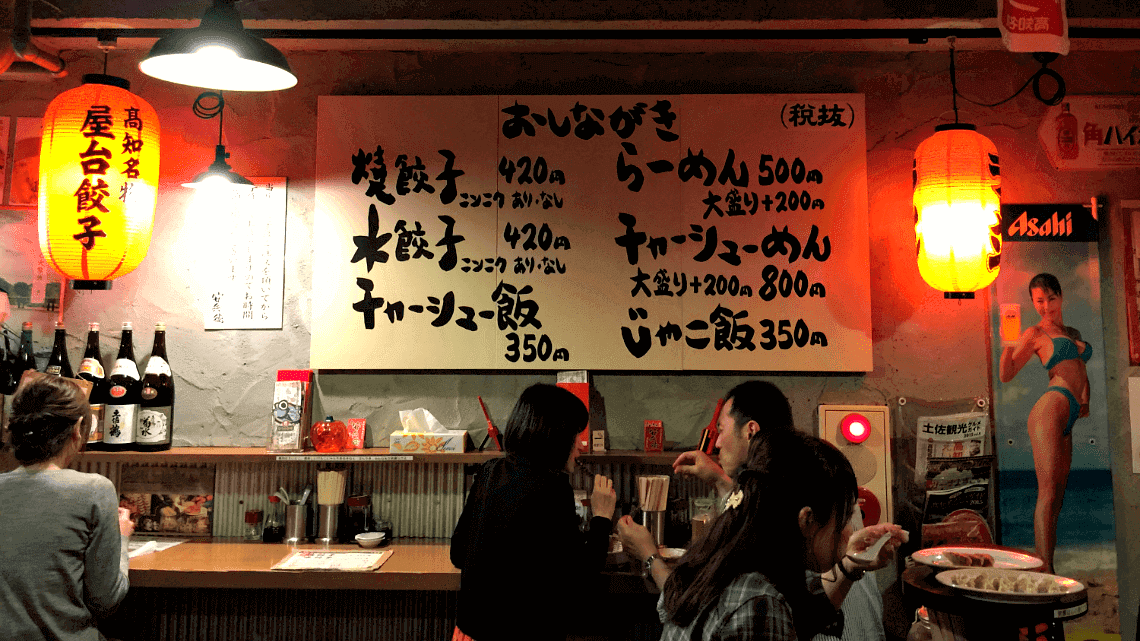
- Saba : Grilled mackerel, a simple classic you’ll find on the menus at most izakayas and neighborhood shokudo (cafeterias).
- Shabu Shabu : A famous variety of nabe (see above), meat is the star of shabu shabu (the name of the food refers to the sound of stirring the meat and vegetables in the hotpot).
- Shishamo : A drinking person’s favorite, these almost bite-sized grilled smelt fish are served whole and filled with roe. “Real” shishamo come from Hokkaido, but these days in most places they’re imported.
- Shojin Ryori : Traditional Buddhist cuisine, some of the best vegetarian food you’ll ever have, is one of the highlights of staying at a temple (in places such as Koyasan ), and can also be found in cities such as Kyoto.
- Soba : Made from buckwheat, and generally considered to be the healthiest of Japan’s three major noodles (along with ramen and udon), seek out te-uchi (handmade) soba.
- Sushi : For more on Japan’s most famous food, see the sushi section above under Japanese Culinary Experiences .
- Tamago Sando : One of Japan’s most iconic convenience store foods, the egg ( tamago ) sandwich is considered an essential for many food-loving travelers.
- Takoyaki : Sometimes called “octopus balls,” these bite-sized balls filled with octopus ( tako ) are a street food staple in Osaka, but also found throughout much of Japan.
- Tempura : The quality of this famous dish in Japan, particularly at high-end tempura restaurants, may blow your mind.
- Tofu : Fresh tofu in Japan is shockingly good, particularly compared to what most visitors are used to outside of Japan.
- Tonkatsu : Breaded and deep-fried pork cutlet, typically served with shredded cabbage, tsukemono , rice, and miso soup.
- Tsukemono : Japanese pickles, which pair perfectly with white rice, and are also delicious on their own. An integral part of Japanese cuisine, you’ll find tsukemono throughout the country, but Kyoto’s are perhaps the most revered.
- Umeboshi : Ume is often translated as “plum,” but most people consider apricot to be more accurate. Umeboshi — pickled ume — are incredibly sour, healthy, and to those of us who love them, irresistible.
- Wasabi : Freshly grated wasabi bears almost no resemblance to what you’ve likely tasted at sushi restaurants outside of Japan.
- Yakiniku : The Japanese take on Korean barbecue, featuring a variety of grilled beef.
- Yakitori : Legendary grilled skewers of chicken.
Hopefully this will get you started! There are far more to try as well, and the great news is that you can find almost all of these foods (and many others) in almost any Japanese city.

Japanese Foods To Avoid?
You’ll probably have more fun — not to mention memorable experiences! — if you keep an “open palate,” but just for reference here are some foods that many non-Japanese are often wary of, at least at first:
- Natto : Perhaps Japan’s most “infamous” food, natto is made from fermented soybeans and is notorious for its pungent smell and sticky texture.
- Chicken and horse sashimi : In a country as hygienic as Japan, both of these are considered safe (and, to many, delicious). However, despite their domestic popularity, many non-Japanese people seem to steer clear of them.
- Horumon : This offal-based cuisine is very popular in Japan, and is considered great “drinking” food. While it may be perfect for Anthony Bourdain- esque eaters, it’s not always a hit with less adventurous diners.
- Fugu : Fugu is poisonous pufferfish (sometimes called blowfish), and can be deadly. Even though it’s strictly controlled and generally considered safe “enough” at established fugu restaurants, a handful of people still die every year from consuming it.
- Shirako : Shirako (cod milt, i.e., sperm sacs) is a delicacy in Japan, and a favorite of sake enthusiasts and adventurous diners.
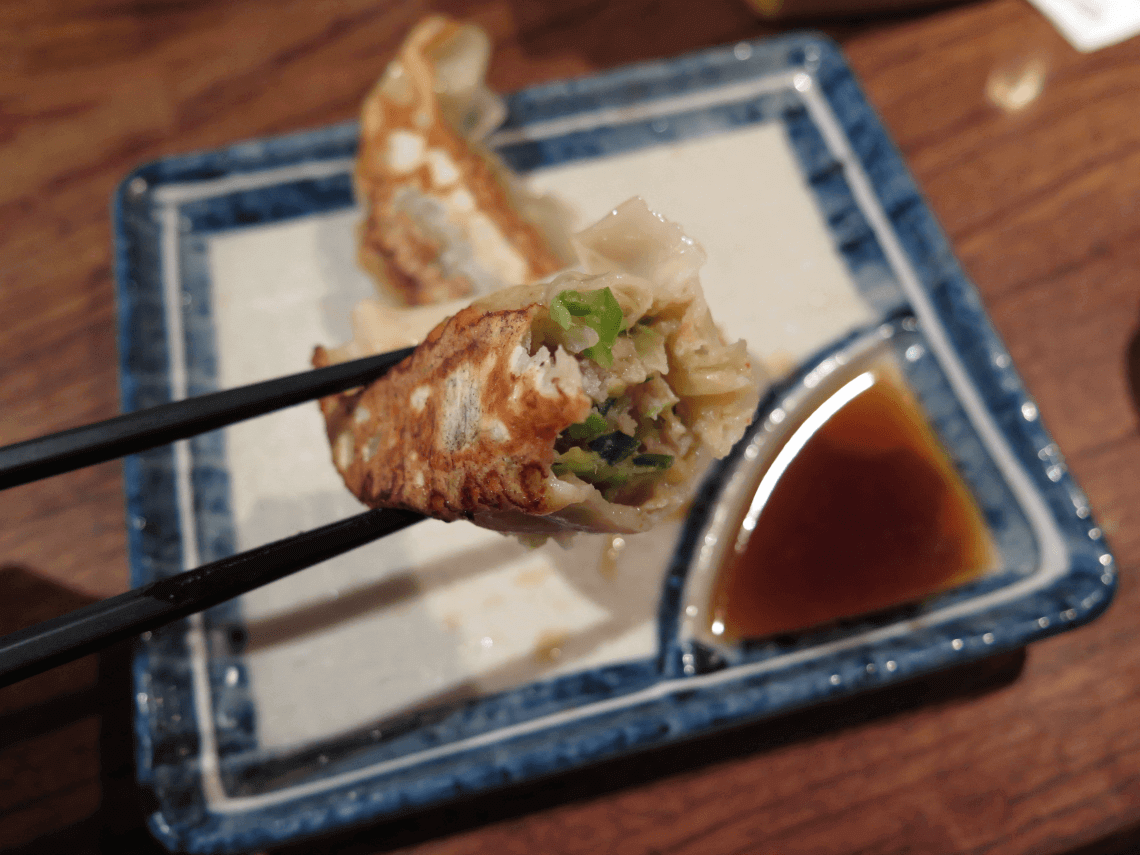
The Best Websites on Japanese Food and Drink
Finally, in case you want to go down the rabbit hole, we’ve compiled what we believe are the best Japanese food and drink websites and pages from around the internet.
Unless you’re a professional eater (we know some of you are), we strongly recommend against trying to plan all your meals in advance. We’re all for obsessive preparation in general (our trip-planning depends on it), but we’ve also seen countless ambitious diners craving a simple meal after one too many “special” reservations — and keep in mind that canceling is a major breach of dining etiquette .
As for casual meals, while you can certainly pre-plan some, many informal restaurants don’t take reservations. The good news is that (outside of hyper-touristy areas) it’s hard to find a bad meal in Japan, and the quality of food is extremely high across the board.
So if you’re set on making some reservations, our suggestion would be to use the resources below to plan them, while also letting yourself experience how wonderful Japan can be with a little flexibility.
Best Websites on Japanese Cuisine
- Tabelog Award : Want to know where Japanese people eat? Tabelog is Japan’s preeminent ranking and review site for restaurants, and an incredible resource. It’s safe to say any restaurant on their Gold, Silver, or Bronze list will be worthwhile. You can also use the site to deep dive for other restaurants. When searching, make sure to toggle the sort function to “ranking.” Also, keep in mind that Japanese people are “stricter” in reviews, so a 3.0 out of 5 is actually pretty good, a 3.5 is generally very good, and 4.0 usually means a place is stellar.
- The Hungry Tourist : Our friend The Hungry Tourist is serious about food. While his list of Japan’s best restaurants doesn’t contain much fluff, you can essentially bet that any place included on his list will be worth dining at.
- Michelin Guide Japan : As alluded to above (under Fine Dining and Michelin in Japan ), the Michelin Guide is not necessarily the be-all and end-all it’s sometimes made out to be, but it can still be a fantastic resource, and at the very least a good starting point for diners seeking top-quality dining experiences in Tokyo, Kyoto, Osaka, and beyond.
- TableAll : There are many reservation services that have popped up in recent years to help travelers make dining reservations in Japan, perhaps none better than TableAll. To complement its relatively reasonable and easy-to-use reservation service, the website also features excellent features on the chefs and restaurants it works with throughout Japan. TableAll is a fun place to go down the rabbit hole – and you may find yourself making an impulse reservation at one of Japan’s best restaurants! (Especially for travelers who don’t have access to the concierge at a luxury hotel or ryokan , services like TableAll and its competitor Pocket Concierge can really help.)
- Eater Japan : At times, Eater can feel like a content farm, but they do tend to work with good writers, and their listicles featuring 38 Essential Tokyo Restaurants and 38 Essential Osaka Restaurants are both full of great dining inspiration.
- Ramen Adventures : For ramen lovers, there is perhaps no better resource on ramen throughout Japan. Brian of Ramen Adventures is truly a hardcore ramen enthusiast, riding his motorcycle throughout Japan in search of obscure and amazing bowls. Another great ramen resource is Ramen Beast , which offers a free app (as well as an outstanding and fascinating ramen-obsessed newsletter via Substack ).
- Tokyo Food File : Robbie Swinnerton offers some of the most interesting, informative, and enjoyable English-language writing on Tokyo’s ever-evolving food scene. His articles in The Japan Times feature a wide range of restaurants, from casual izakayas to top-end fine-dining establishments.
- LuxEat : A beautiful website devoted to mostly high-end gastronomic explorations in Japan (and beyond).
- Food Sake Tokyo : Perennially one of our favorite writers on Japanese culinary culture, the insightful Yukari Sakamoto tends to update her Instagram more than her blog these days, but regardless both are a joy to peruse.
- Andrea Fazzari : The blog of James Beard Award-winning photographer Andrea Fazzari gives you a taste of what you can expect from her magnificent books on Japanese chefs and cuisine.
- Takefumi Hamada : The Instagram feed of this extraordinarily well-traveled diner is worth a trip down the rabbit hole for bountiful culinary inspiration in Japan and beyond.
- Roads & Kingdoms Guide to Tokyo : We’re always fans of Roads & Kingdoms work, and this mini-guide to Tokyo is a fun read. For more from the R&K team, make sure to check out Rice, Noodle, Fish (one of our absolute favorite books on Japanese cuisine ).
Along with the great resources above, also make sure to see our articles on Tokyo’s best sushi restaurants , foods to eat in Kyoto , foods to eat in Osaka , and foods to eat in Fukuoka .
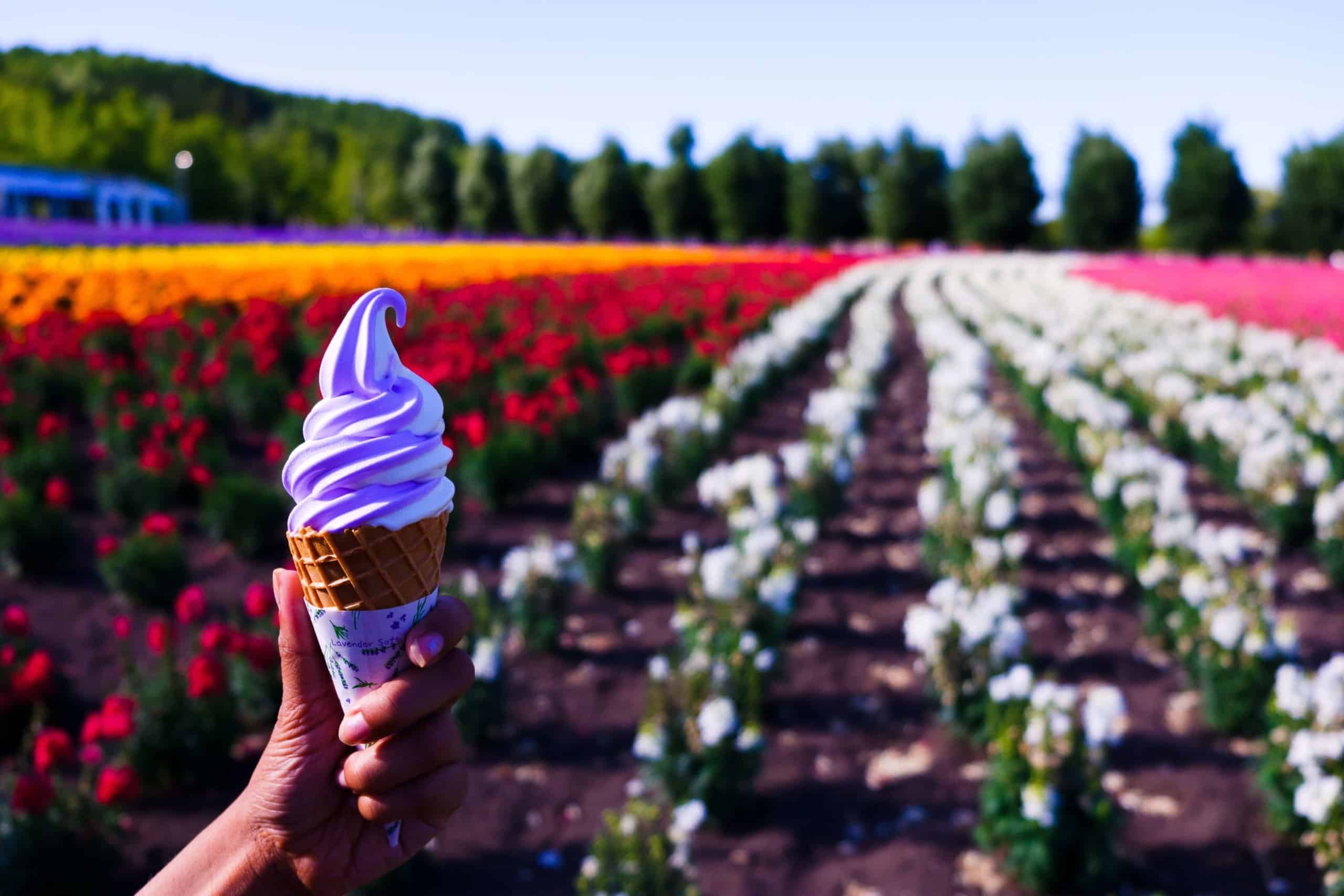
Resources for Travelers to Japan with Special Dietary Needs
- Happy Cow : Vegan and vegetarian restaurants in Japan.
- Gluten Free Japan : Guide to eating gluten free in Japan.
- Traveling around Japan with Dietary Restrictions : A post from our site for travelers with dietary restrictions.
Best Websites for Bars and Drinking in Japan
- PUNCH : The PUNCH guide to drinking in Tokyo.
- Kanpai Culture : Melinda Joe’s excellent column in The Japan Times on drinking in Tokyo.
- Dekanta : Highly informative blog on Japanese whisky.
- Urban Sake : Comprehensive sake-focused website.
- Sake / Shochu / Whisky : Our introductions to these essential Japanese beverages.
Online Resources for Tea and Coffee in Japan
- Japanese Tea : An overview of tea in Japan.
- Tea in Kyoto : A selection of teahouses in Kyoto.
- Good Coffee : Lists of great coffee shops in Tokyo, Kyoto, Osaka, and beyond.
- Tokyo Coffee : Guide to specialty coffee in Tokyo.
- Coffee / Tea : Our introductions to coffee and tea in Japan.
We hope our comprehensive introduction to Japanese food helps you get the most out of your culinary travels through Japan!
Plan Your Japan Trip
Learn more and contact us to discuss your unique trip.
Get Started
- The Process
- Testimonials

Food in Japan: 32 Popular Dishes You Need to Try on Your Next Visit
Satisfy your cravings for food in Japan with our list of 32 must-try Japanese dishes. From teppan to ramen to gyoza , we've got you covered.
Japanese cuisine is renowned worldwide, but there are numerous other dishes to sample besides sushi . While many are familiar with sashimi , tempura , and ramen , Japanese culinary culture is much more diverse. If you are planning a trip to Japan, you may wonder what foods are worth trying. To assist you in making a decision, we have assembled a list of 32 delectable Japanese dishes that everyone should experience.
1. Buta-No-Shogayaki (豚の生姜焼き): The 'B-Grade Gourmet' Ginger Pork Classic
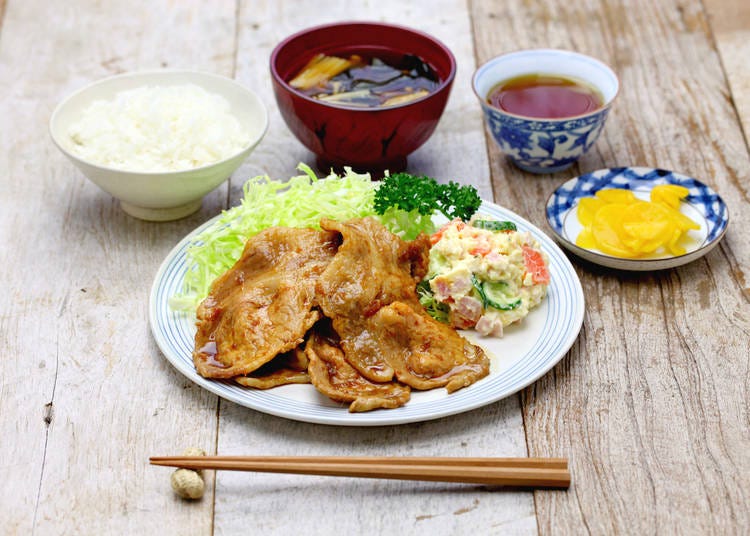
Buta-No-Shogayaki is one of the most popular and delicious Japanese dishes that you can find in many restaurants, izakayas (traditional Japanese restaurant/ bars ), fast food chains, and even as a bento box (a pre-prepared Japanese-style lunch) available in many grocery stores and convenience stores . The word "yaki" literally means "grilled." This dish is prepared by grilling thin slices of pork that are dressed with a delicate sauce made of mirin, soy sauce, sake (Japanese rice wine), granola oil, sliced onions, and ginger. This dish is perfect for a quick and tasty meal that you can enjoy any time of the year.
2. Champon (ちゃんぽん): The Essence of Japanese Noodles
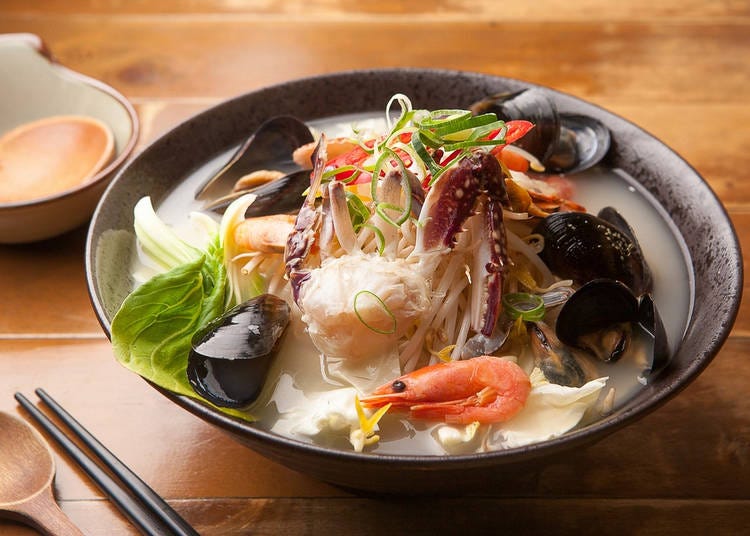
At first glance, Champon might be mistaken for ramen , but it is actually a unique dish in its own right. Originating from Nagasaki , it was first served in a Chinese restaurant during the Meiji era (1868-1912). Unlike ramen , the noodles used in Champon are boiled in the soup itself, giving it a distinctive taste and texture. Champon is a seasonal dish that uses a combination of ingredients such as pork, seafood , and vegetables. These are fried in lard before a soup made from chicken and pig bones is added to create a flavorful broth. As a result, each serving of Champon is different and offers a unique experience that varies depending on where you eat it. In fact, Champon is not just limited to Nagasaki ; it can be found in many countries throughout Asia and in different regions of Japan. Each place puts its own spin on the dish, creating a diverse range of styles and flavors that are sure to satisfy your appetite.
3. Edamame (枝豆): The Irresistible Boiled Soybean Snack
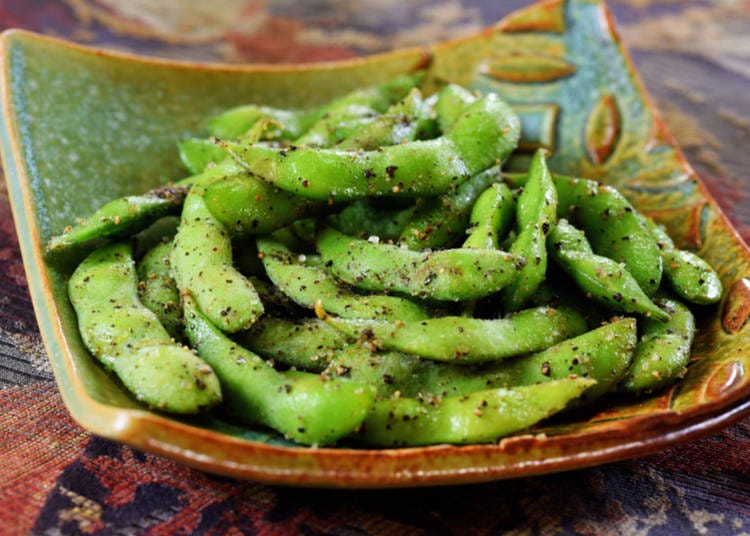
Edamame are not technically a dish, but they are a very popular food in Japan. These are immature soybeans that are still in their pods. They can be served hot or cold, and sometimes grilled instead of boiled. Typically, they are only dressed with salt, and they make for an amazing appetizer. Once you try a few, you'll find yourself reaching for more and more. Edamame usually accompany a meal in all izakaya , and they are almost always part of the menu in the vast majority of Japanese restaurants in Japan.
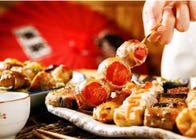
4. Fugu (ふぐ): The Delicate Dance with Pufferfish
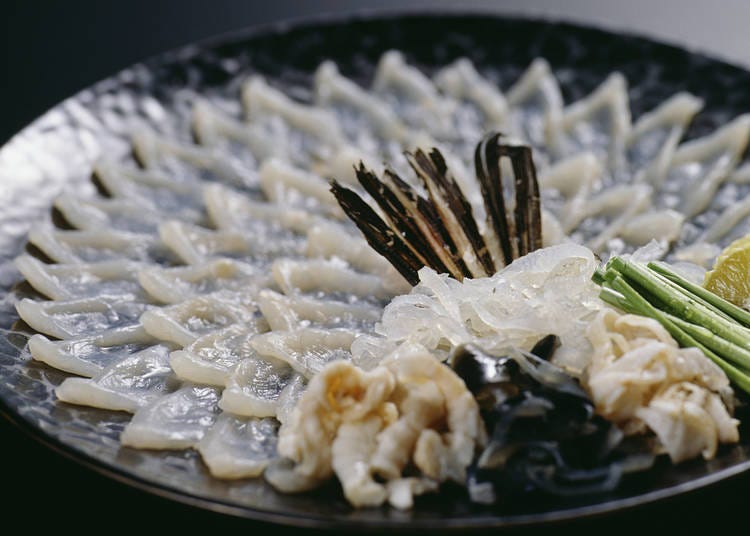
For those looking not only for amazing food in Japan, but also for a thrilling experience, fugu is the dish to try! The fugu is a pufferfish that is, yes, delicious, but it can also be lethal due to a toxin in some parts of its body. Fugu is usually served as sashimi or in certain kinds of Japanese nabe hot pots . The preparation of this fish, due to its characteristics, is rigidly controlled by the Japanese government. Chefs who aspire to prepare this fish must undergo at least three years of very rigorous training to get their license. Before being served, the toxic parts of the fish are removed, making it safe to serve. Interestingly, fugu liver is considered the tastiest part of the fish, but it’s also the one that can be the most poisonous. As a result, serving fugu liver was outlawed in Japan in 1984. Should you try this dish, you’ll certainly remain amazed by its taste, but do careful research before ordering it in a restaurant (and never try to prepare it by yourself).

5. Gyoza (餃子): The Delightful Journey of Japanese Dumplings
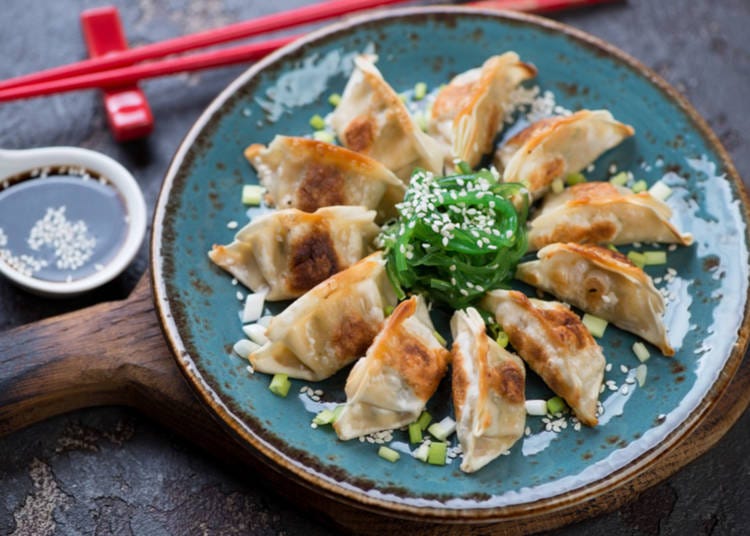
Gyoza are dumplings that are shaped like a crescent moon. They are a popular dish in Japanese restaurants and can be found almost everywhere, regardless of their style. Although originally from China, the types of gyoza you will find in Japan are usually quite different from the original. There are various types of gyoza available in Japan, but one of the most popular is "yaki- gyoza ". These dumplings are made with minced pork, cabbage, garlic, onion, and ginger. They are then lightly fried until they become crispy and turn a nice dark golden color. You can enjoy gyoza with a dip made of soy sauce, rice vinegar, and spicy oil.
6. Gyudon (牛丼): The Bowl of Beefy Goodness
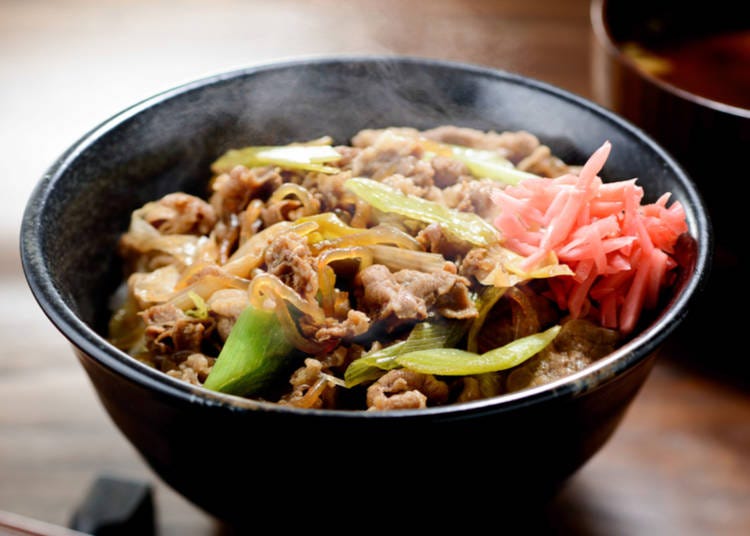
Gyudon is a mouth-watering dish consisting of beef served over rice (gyu = beef). It is a quick meal that is often served in specific restaurants or Japanese fast-food chains such as Yoshinoya. To make this dish, thinly sliced beef and tender onion are simmered in dashi broth (a popular Japanese ingredient) and then seasoned with mirin and soy sauce. The dish is then served over a bowl of steamed rice. Sometimes, it is topped with a lightly cooked egg. If you want to experience a typical Tokyo office worker’s lunch break, this quick and tasty dish is a must-try. You will feel full and satisfied, and ready to continue your sightseeing and exploration with renewed energy.
7. Gyukatsu (牛カツ): The Lure of the Beef Cutlet
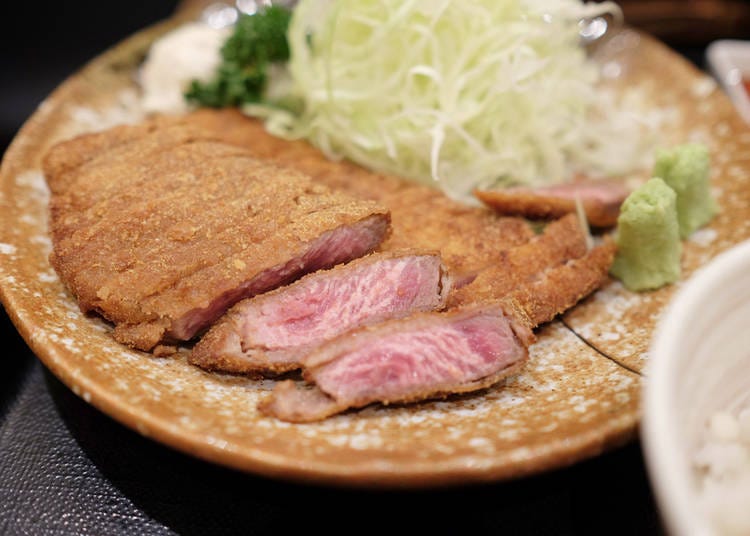
If you're fond of tonkatsu , a popular pork-based dish, you should definitely give its beef variation a try. This dish involves deep-fried breaded beef, which is served with a side of cabbage, barley rice, miso soup, potato salad, and pickles. The preparation method results in a tender and crunchy texture, and the dish has a flavorful taste that's not too overwhelming. Although it's not as commonly available as the pork version, if you do happen to come across it, it's definitely worth trying.
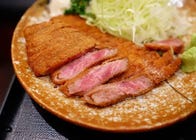
8. Gyutan (牛タン): An Ode to Beef Tongue Delicacies
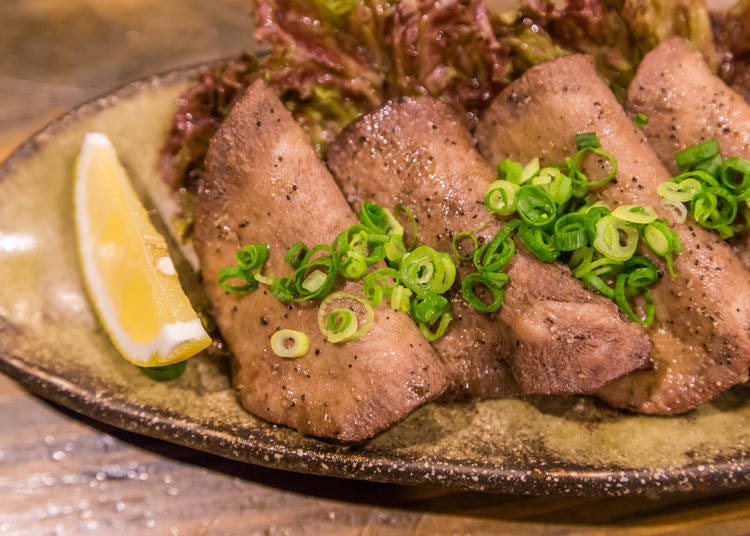
At first glance, this dish may seem unusual depending on where you're from, but we encourage you to keep reading. Gyutan is a dish made of grilled beef tongue, as the name suggests - "gyu" meaning cow and "tan" meaning tongue. This dish is typically found in yakiniku restaurants, prepared with salt or various sauces (often including lemon) and scallions. The meat is thin, delicious, and tender. Gyutan originated in Sendai, where the owner of a yakitori restaurant opened a new establishment in 1948 which offered gyutan. Since then, the dish has become increasingly popular throughout Japan. Give it a try and you'll quickly see why!
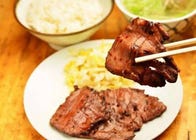
9. Karaage (から揚げ): Japan's Tasty Fried Chicken
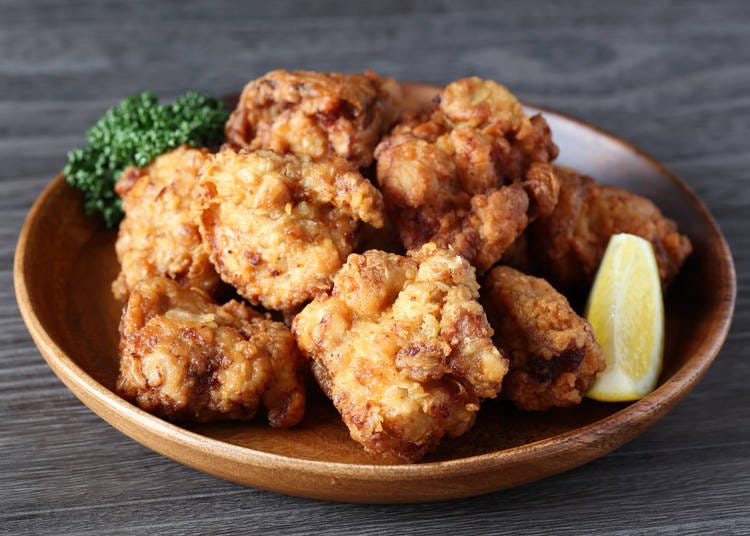
When you arrive in Japan, you will instantly notice the popular Japanese fried chicken dish called karaage. Although karaage usually consists of chicken, some regions may use other meats such as pork. The meat is lightly coated with wheat flour or potato starch and is then deep-fried in oil. In some cases, the meat is marinated before cooking. Karaage is typically served with a slice of lemon, but it can be enjoyed with or without it. Restaurants, street-food carts, izakaya , and convenience stores frequently serve the chicken variety of karaage. It's a delicious, fast, and affordable dish. However, the only downside is that it's so tasty, it can be addictive!
10. Katsudon (カツ丼): The Breaded Pork Bowl
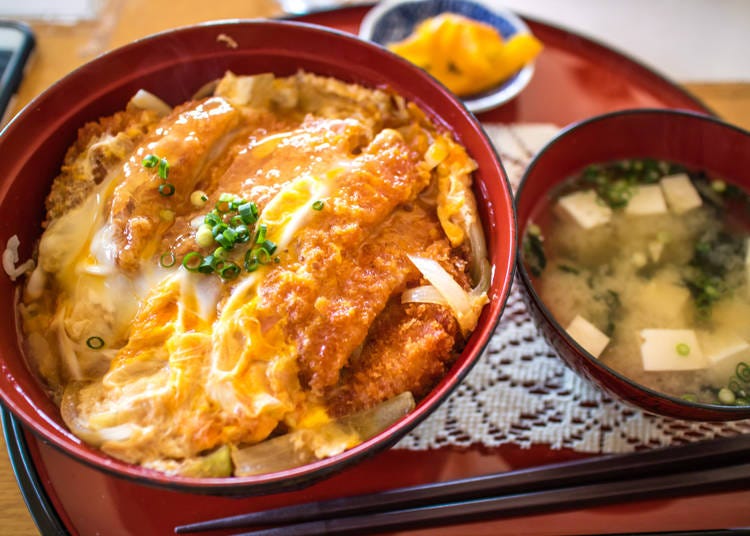
If you're a fan of beef bowl dishes like gyudon, you'll love Katsudon, a similarly popular Japanese dish made with pork. This tasty and affordable meal is often overlooked by foreign visitors, but can be found in many restaurants and Japanese-style fast food chains. The dish consists of a bowl of rice topped with deep-fried pork cutlet, egg, vegetables, and condiments, making it the perfect option for those on the go. Although it's a common dish in Japan, there are several varieties to choose from, including those served with tonkatsu sauce, demi katsudon (a specialty of Okayama ), shio-katsudon (flavored with salt), or miso-katsu (originally from Nagoya). Regardless of which type you choose, you're sure to enjoy this delicious and satisfying meal!
11. Kushikatsu (串カツ): Thrilling Skewered Deep-Fried Treats
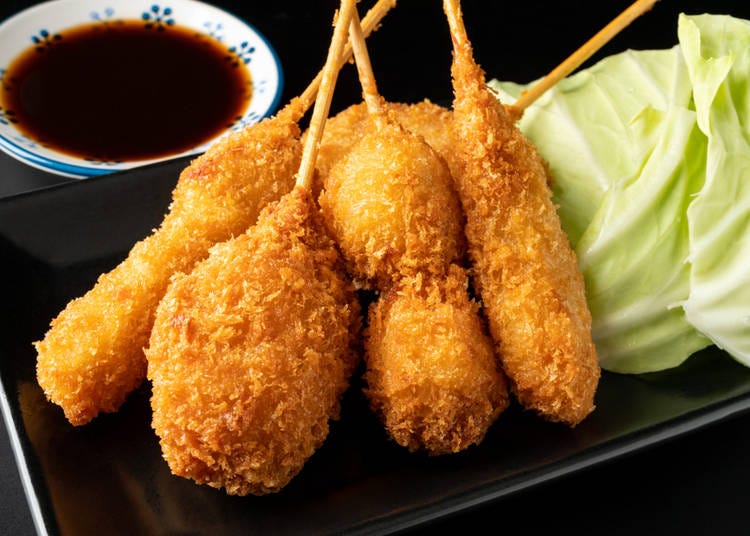
Kushikatsu , also known as kushiage, is a delicious dish consisting of crunchy deep-fried skewered meat, fish, or vegetables. The name of the dish refers to the way it is prepared, with "Kushi" meaning skewers and "katsu" referring to the deep frying of a meat cutlet. Kushikatsu can be made using a variety of ingredients, including bamboo shoots, lotus root, cartilage (nankotsu), and gizzard (sunagimo). Each ingredient has its unique flavor and texture, making the dish even more exciting to taste. Apart from the different ingredients, there are also several geographical varieties of Kushikatsu . For example, Osaka and Tokyo (which also serves pork rib kushikatsu ) prepare the meat slightly differently and dress it with brown sauce. In Nagoya, Kushikatsu is served with doteni, a rich miso-based dish with beef tendon, offal , and daikon radish. The region also uses different sauces and batter to prepare the dish.
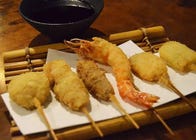
12. Miso Soup (味噌汁): The Soul-Warming Broth
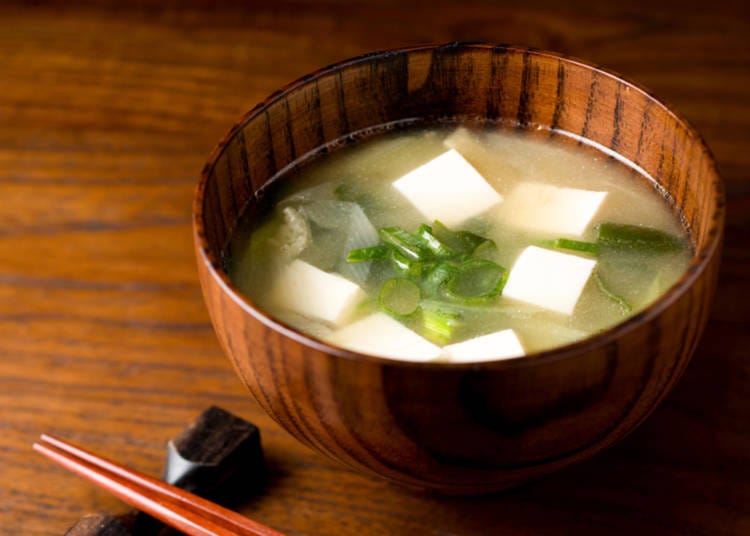
Miso soup is an unavoidable dish when it comes to talking about food in Japan. It is a staple in Japanese cuisine and can be served with almost any meal, be it breakfast, lunch, or dinner. This simple yet flavorful soup makes a fantastic side dish to complement the rest of your food. Dashi, one of the primary ingredients in miso soup, is mixed with miso paste, which is made by fermenting soybeans, to create this famous soup. Other ingredients are added according to individual preferences. Typically, miso soup is served with tofu , scallions, and wakame seaweed. However, other ingredients such as daikon, shrimp, fish, mushrooms, potatoes, onions, or meat can also be added. Miso soup is highly recommended during the cold winter months, and it is a must-try dish before leaving Japan.
13. Nabe (鍋): Enjoy Japan's Hot Pot Culture
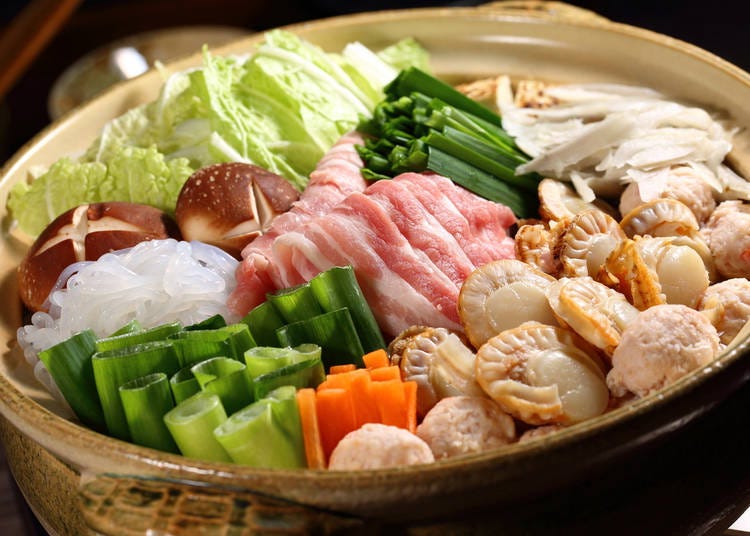
Nabe refers to a cooking pot, and in Japanese, it can also be referred to as "nabemono," which translates to "things in a cooking pot." While the name suggests that it's a simple dish, in reality, there are many variations of nabe in Japan. It's a popular dish throughout the year but is particularly enjoyed during colder months. Nabe is a dish that can be enjoyed both in Japanese restaurants and at home. The preparation involves boiling a variety of ingredients such as meat, fish, shellfish, vegetables, and tofu in seasoned or unseasoned water. Sumo wrestlers are known to be big fans of nabe , especially "chanko nabe ," which usually includes meatballs, chicken, vegetables, and noodles. It's designed to be served with extra ingredients so that wrestlers can gain weight. Another popular variation of nabe is shabu-shabu , named after the sound made when thinly-sliced meat is dipped into boiling water. This dish is served with beef or pork, vegetables, and tofu and is enjoyed with a sesame dipping sauce or ponzu, which is a lemon-based dressing, or a combination of both. Sukiyaki is a sweeter version of shabu-shabu where the ingredients are stewed in sweetened water and soy sauce and then enjoyed with a raw egg dip. Yose nabe , which means "putting together," is a nabe variety where all the ingredients, such as meat, fish, vegetables, and tofu , are cooked together in the pot at the same time. This dish is usually based on a soup of miso or soy sauce. There are many types of nabe available in Japan, and it's definitely worth trying them all to find your favorite!

14. Natto (納豆): The Fermented Soybean Sensation
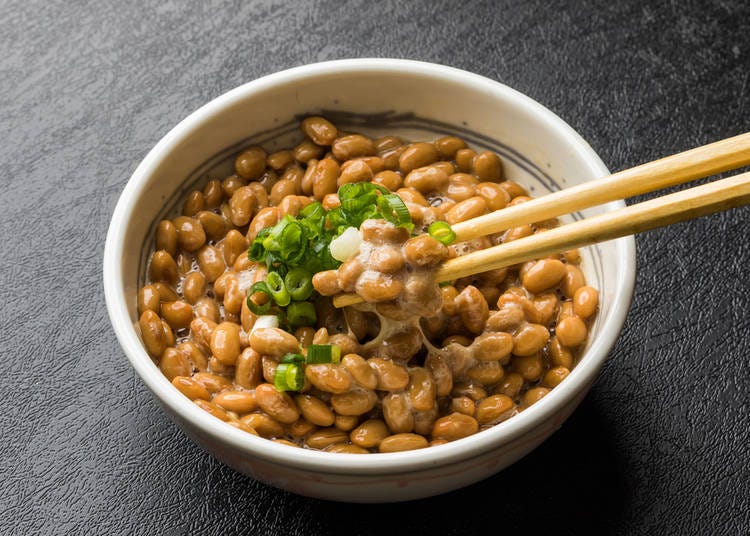
Natto, a fermented soybean dish, is a staple in the daily diet of most Japanese people. However, it's a type of food that many foreigners find unappetizing due to its strong smell and sticky consistency. Despite this, natto is a genuine Japanese delicacy that is worth trying at least once. Typically served with rice and dipped in soy sauce or spicy mustard, natto can be an acquired taste. It may take some getting used to, but don't let that intimidate you from giving it a try. You might be surprised to find that you enjoy it and have a more Japanese palate than you thought!
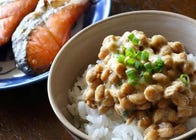
15. Oden (おでん): The Wintry Delight of Japan
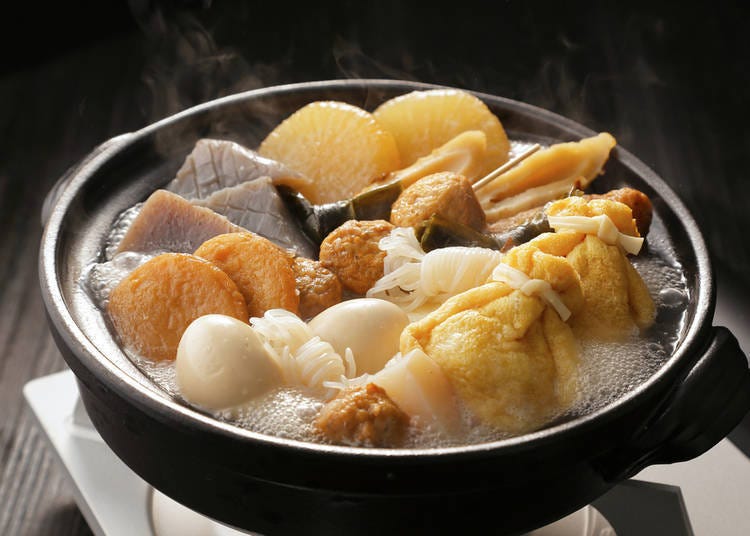
Oden is a delicious and warming dish that is perfect for cold winter days. It is a type of one-pot meal made with various ingredients, such as eggs, konjac, fish cakes , and daikon, all served in a dashi and soy soup. Although some restaurants specialize in preparing this dish, you can easily find oden in many Japanese fast-food chains and convenience stores . Oden can be prepared in different ways, and its name may even vary depending on the region. For instance, in Nagoya, it may be known as Kanto-ni. Additionally, the soups used to boil the ingredients can also differ depending on the area. Oden is an inexpensive and unique dish that you will never tire of, particularly if you are traveling through different cities in Japan.
16. Okonomiyaki (お好み焼き): Japan's Savory Pancake Paragon
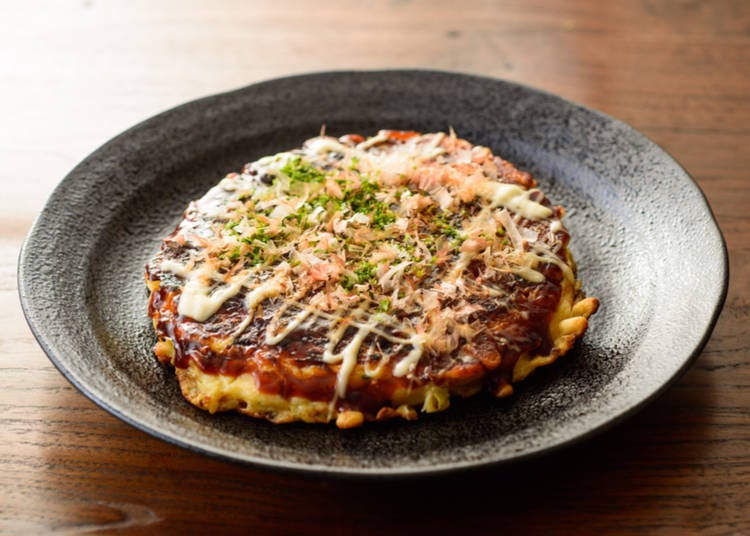
If you're traveling to Japan, trying out the various types of okonomiyaki , a staple dish, is a must. This savory dish, which can be compared to a Japanese frittata or pancake, is made using a wide range of ingredients, as suggested by its name's etymology (meaning "what you like" or "how you like" + "grilled"). Two of the most popular varieties of okonomiyaki are the Kansai-style and the Hiroshima -style. The Kansai version is the most common, with a batter prepared using flour, nagaimo (a kind of yam), dashi (or water), eggs, cabbage, pork belly, octopus, squid, shrimp, mochi, or cheese, and konjac. Osaka is particularly well-known for its okonomiyaki , as it is believed to be the dish's birthplace. In the Hiroshima -style, the ingredients are arranged in layers rather than mixed together. Toppings usually include noodles such as yakisoba or udon , eggs, and a lot of sauce. There are many other types of okonomiyaki available in various regions of Japan, such as Tokushima , Hamamatsu, and Okinawa . If you're in Tokyo, you should visit the Tsukishima district , which is famous for both okonomiyaki and monjayaki. On Monja Street , you can try monjayaki, a dish similar to okonomiyaki but with a less dense texture and different ingredients.
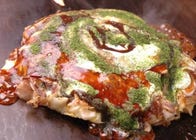
17. Omuraisu (オムライス): The Enchanting Omelette Rice Creation
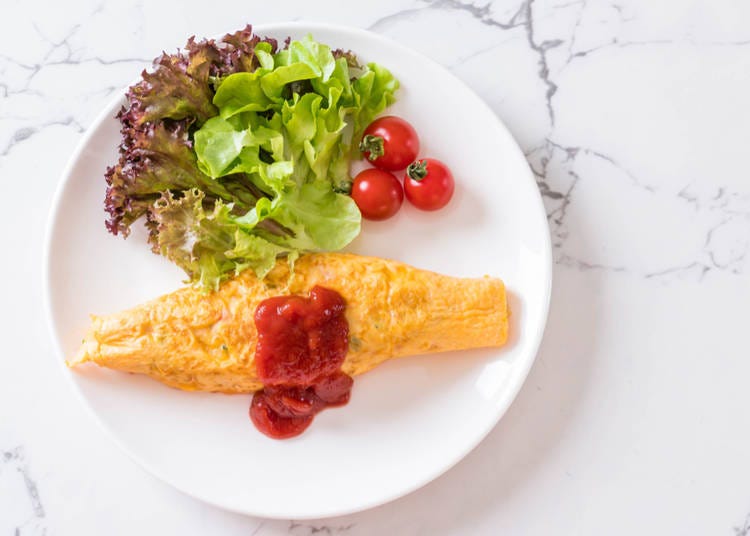
The name of this flavorful dish derives from the contraction of the words omelet and rice. Omuraisu, as the name suggests, is an omelet filled with fried rice and usually topped with ketchup. The dish seems to have originated in Tokyo, in a western-style restaurant, roughly 100 years ago. You’ll find this dish in most Japanese cafes that also serve food, as well as in several restaurants. If you’re staying with friends from Japan, chances are they’ll know how to prepare it, as it’s a common dish among Japanese people. Once again, a filling, cheap, and tasty one-dish meal that will certainly be popular among adult visitors, as well as children!

18. Onigiri (おにぎり): The Staple Rice Ball Delight
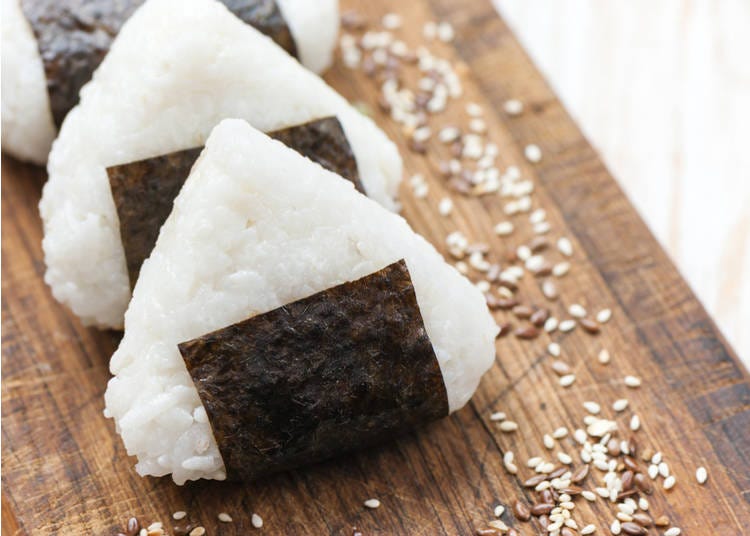
Have you ever come across the famous Japanese rice ball, the onigiri, in an anime , movie, video or documentary? Although it is not a very common menu item in restaurants, it is considered the king of on-the-go dishes and can be found in almost every grocery and convenience store . The onigiri is a simple rice ball that can be flavored with spices or filled with various ingredients such as vegetables, meat, fish, seafood , and more. Depending on the region and one's preference, it can be wrapped in a sheet of flavored or unflavored nori (seaweed). While sightseeing in Japan, many people tend to eat mainly onigiri due to its cheap price (usually under 200 yen), availability, and simplicity.
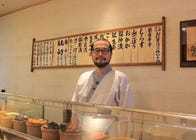
19. Ramen(ラーメン): The Delectable World of Noodles and Broth
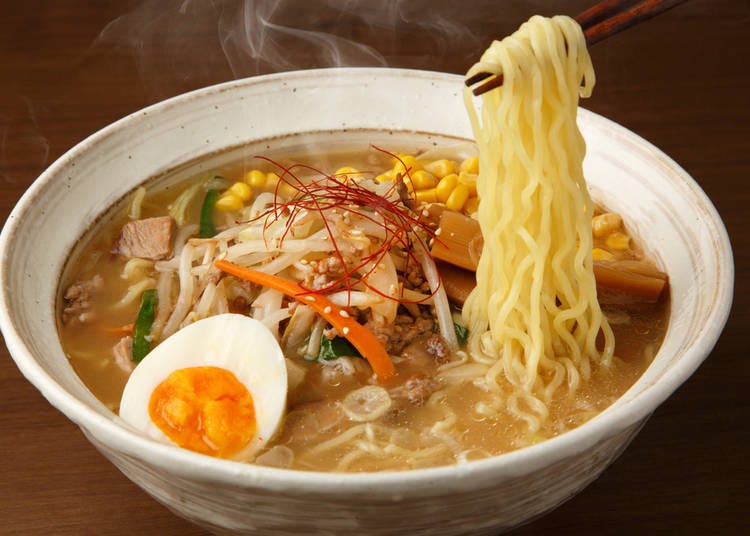
Ramen is a well-known dish globally, especially the instant variety. However, in Japan, the authentic version is far superior to its instant counterpart in terms of taste and variety. The broth for ramen can be made from chicken, pork, beef, fish, or vegetables, flavored with soy sauce, miso, dashi, and many other seasonings. It is usually served with scallion, seaweed, tofu , and bamboo shoots, but there are countless other combinations to choose from. Each region and restaurant has its unique recipe, leading to original and delicious meals. The noodles used in ramen are also specially made and have a soft yet chewy texture. The most common soup stocks used for ramen are miso, salt, soy sauce, and curry . Ramen is the go-to meal for the Japanese after a long day or night out, and it's commonly regarded as fast food . It's typically served hot, although some variations can be served cold, and it's a favorite on cold days.
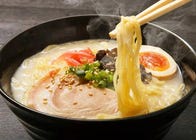
20. Robatayaki (炉端焼き): The Art of Fireside Cooking
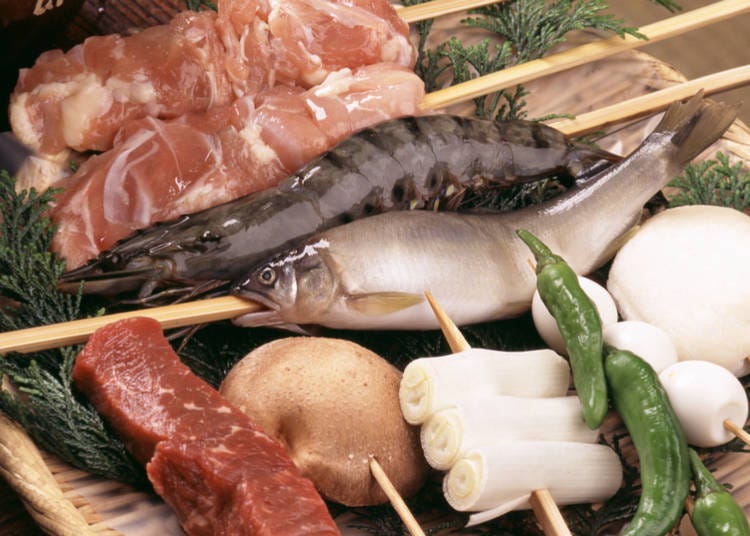
Robatayaki (or robata) is a unique Japanese cuisine in which food is grilled on an irori style fireplace (wide, flat, open fireplace) over charcoal. This particular dish is usually found only in specialized restaurants, so you may have to look/ask specifically for it. The list of food at robata restaurants is everything you can think of, although traditionally it is a combination of seafood and vegetables. Most visitors miss this amazing food in Japan. Make sure you taste a real slice of Japan by looking for a good robata (there are many in Tokyo and all over Japan).
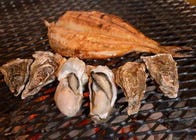
21. Soba (蕎麦): The Buckwheat Noodle Escapade
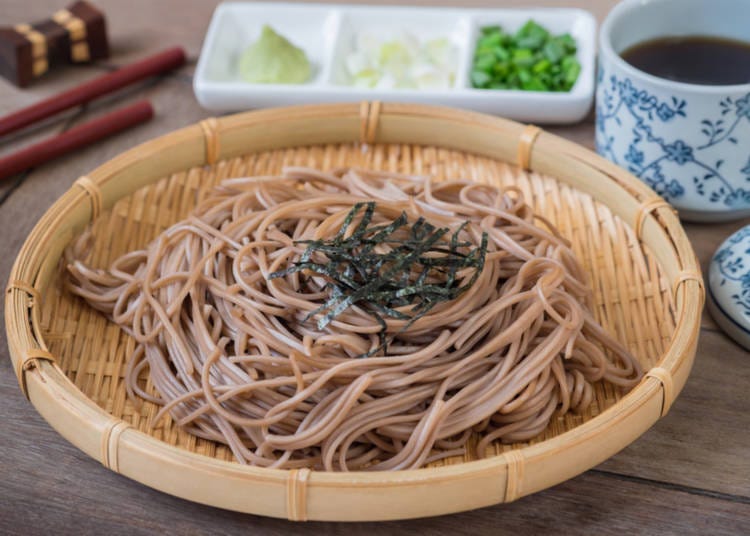
Soba is a type of noodle made from buckwheat flour, which is a specialty dish from Japan. It is a very popular dish and can be found in both general noodle restaurants and specialized, often expensive ones. Preparing soba at home is relatively simple, as you can buy the noodles and soup in which they are dipped from a grocery store . Soba can be enjoyed in different ways, either in a cold dip or a broth as a noodle soup. This dish comes in various varieties depending on the region and the season you are visiting. Don't forget to try a soba dish next time you visit a restaurant in Japan!
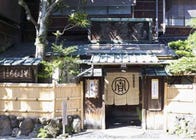
22. Somen (そうめん): Delightful Thin Noodles
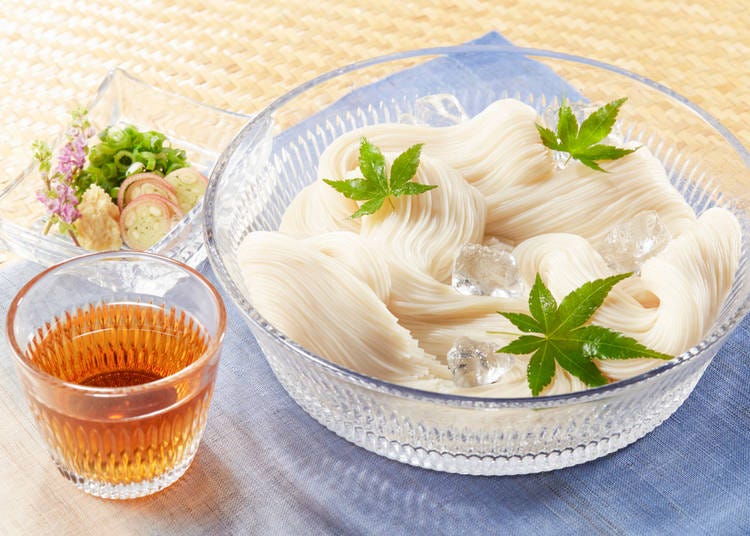
Somen is the Japanese version of a prevalent kind of noodle across Asia. Made out of wheat flour, it’s usually served cold. These skinny noodles are served with a simple cold dipping sauce or a sauce flavored with onion, ginger, and myoga (a different kind of ginger). This dish is particularly popular in summer when a dish of somen chilled with ice cubes is all you need to recharge, fill up, cool off, and take a break from the brutal Japanese summer heat.
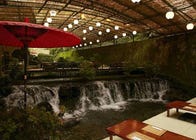
23. Sushi and Sashimi (寿司 & 刺身): The Raw Elegance of Japanese Cuisine
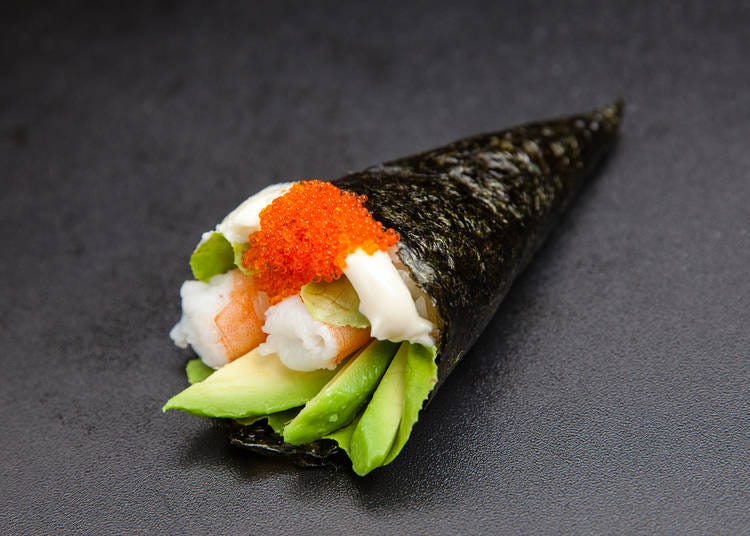
Sushi and sashimi are among the most famous foods in Japanese cuisine . They are regarded as an art form, with sushi chefs often practicing as apprentices for years before being considered masters. Despite their popularity, many people fail to understand the variety of cuts and preparation that go into creating these dishes. However, good quality sushi and sashimi can be found in Japan at a fair price. There are options available for all palates and budgets. One unique dining experience in Japan is offered by rolling sushi restaurants, where you order from a tablet at your table and the sushi is served to you via a rolling mat. At these restaurants, known as 100 yen- sushi or sushiro, each dish costs only 100 yen and the food is excellent. A dish that is often missing outside of Japan is temaki zushi, or hand-rolled sushi . While you can find restaurants offering this dish, it's a fun and easy dish to make at home. You'll need sushi rice, thin slices of your favorite fish, seaweed sheets, and any other ingredients you'd like to add. Common ingredients include cucumber, crab, avocado, and wasabi. To make temaki zushi, spread the rice on a sheet of seaweed, add your fillings, roll the seaweed into a cylinder or cone, and enjoy with soy sauce. If you're in Japan, consider proposing a temaki zushi party - it's sure to be a hit!
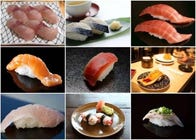
24. Takowasa (たこわさ): The Wasabi Octopus Experience
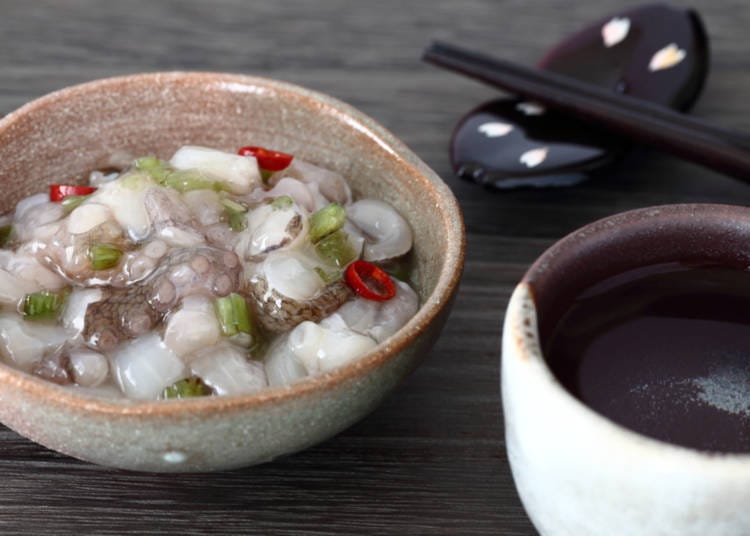
Takowasa is raw octopus (tako) served in a wasabi sauce (wasa). This is one of those Japanese dishes that, depending on your cultural background, may appear weird. Do try it out! Takowasa is a common appetizer in many restaurants, especially in an izakaya . It’s very popular and for a good reason. It’s tasty, unique, and a true symbol of Japanese popular food tradition.
25. Tempura (天ぷら): Japan's Light and Crispy Masterpiece
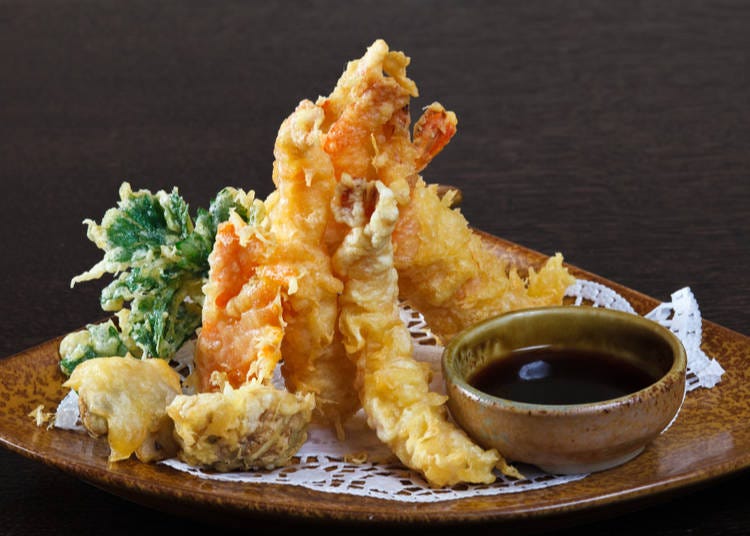
Tempura is a delicious dish that can be enjoyed throughout the year, especially for those who love to socialize with friends over drinks. Tempura typically includes shellfish, fish, chicken, or vegetables coated in a flavorful batter and then deep-fried to a perfect level of crunchiness. You can savor tempura as is, or with a dipping sauce. While many restaurants offer this dish, some specialize in it, providing a wider range of options for an even more fantastic immersion into traditional Japanese cuisine .
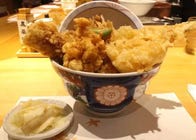
26. Teppanyaki (鉄板焼き): The Theatrical Grilling Artform
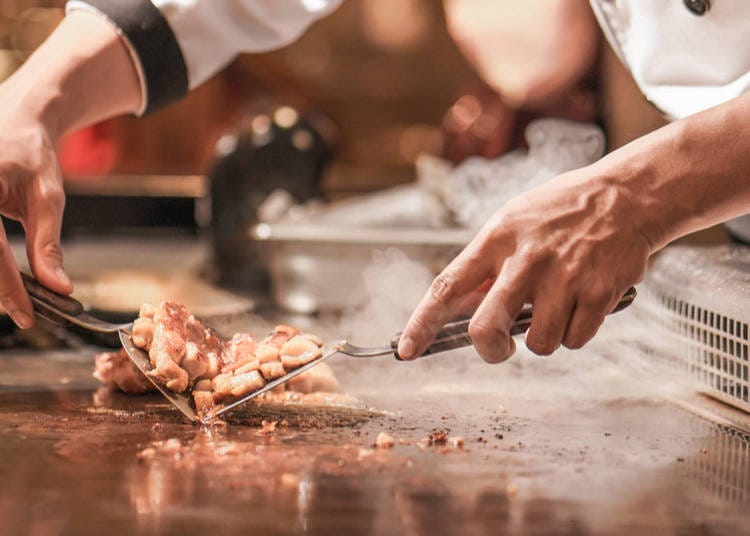
Teppanyaki is a Japanese style of cooking that is not very well known but still absolutely delicious. The word Teppan means iron plate, while yaki means grilled. The term Teppanyaki is used to refer to a wide variety of dishes, including okonomiyaki , yakisoba, and monjayaki. However, it's typically used to describe a particular type of western-influenced food preparation. Typical ingredients for Teppanyaki dishes are beef, shrimp, vegetables, chicken, and scallops. These ingredients are cooked on a hotplate, usually with soybean oil. Some of you may be familiar with this type of cooking because in the United States, Teppanyaki restaurants are quite popular, although they're known as hibachi. If you visit Japan and want to try some amazing food that blends the best of Japan and the West, you should definitely give Teppanyaki a try.
27. Tonkatsu (とんかつ): The Crispy Pork Cutlet
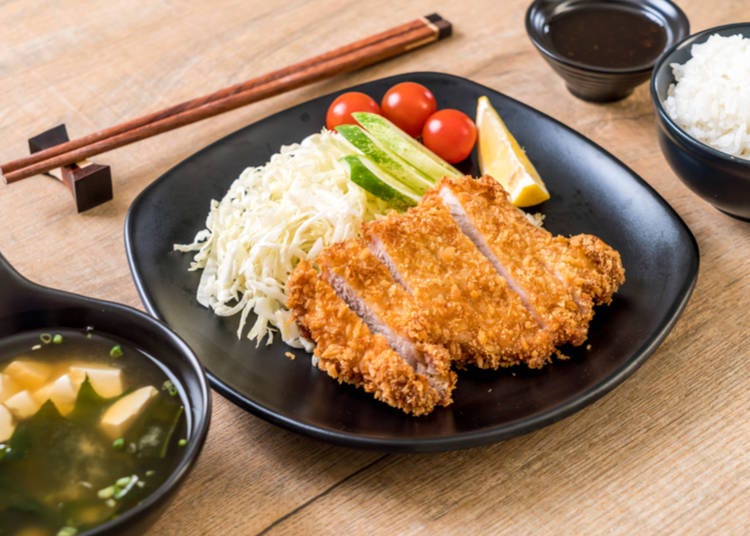
Tonkatsu is a popular and easy-to-find Japanese dish consisting of a breaded pork cutlet that is deep-fried in vegetable oil until golden brown. You can easily find this delicious and affordable dish in many chain restaurants, grocery stores , and convenience stores , or you can even make it at home! To prepare the dish, season the meat with salt and pepper, coat it in flour, dip it in beaten egg, and cover it with panko (Japanese bread crumbs). Then, deep fry the cutlet until crispy and serve it with cabbage, potato salad, and a brown sauce or karashi. Tonkatsu is also great for making sandwiches, making it the perfect meal on-the-go.
28. Udon (うどん): Glorious Thick Noodles
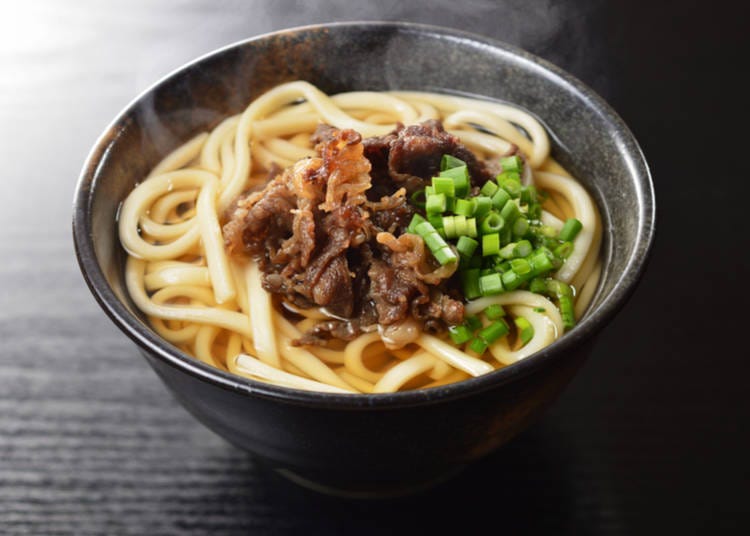
Japan has a wide variety of noodles, and udon is one of the most popular, just like ramen . Udon is a thick noodle made from wheat flour, which you can enjoy either in its simplest form - with broth made of dashi, mirin, and soy sauce - or in many different combinations. For a hearty meal, try it with tempura , or for a more delicate taste, with tofu . Udon can be served hot or cold, depending on the season or your personal preference, and the style of preparation varies depending on the region you're visiting. Although the word " udon " refers to the noodles themselves, there are no limits to the flavors, soups, and ingredients that can be added. As a matter of fact, challenge yourself to try out as many styles of udon as possible during your trip to Japan. Not only will you be satisfied, but you'll also be nowhere near the end of the list of possible dishes!
29. Yakiniku (焼き肉): Grilled Meat, the Japanese Way
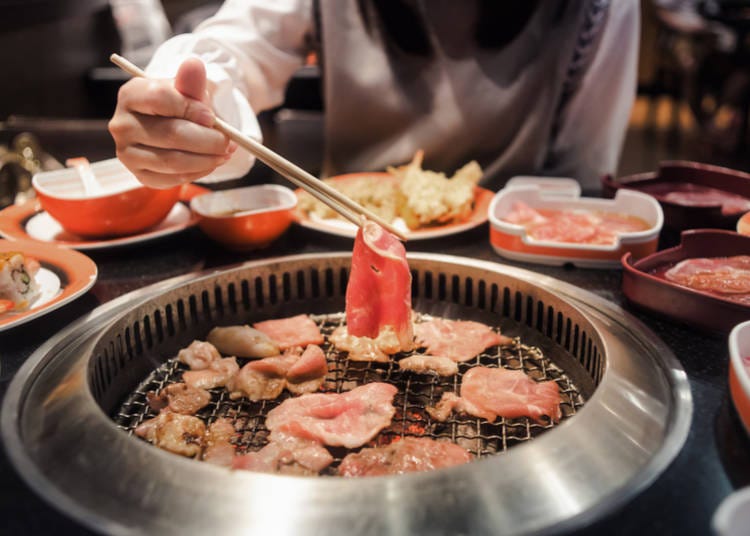
Yakiniku is a style of cooking that involves grilling meat, also known as Korean or Japanese barbecue. While Korean-style barbecue typically involves marinated meats, Japanese-style barbecue does not. Yakiniku restaurants are very popular and offer a wide range of options, from high-end to budget-friendly, with some even offering all-you-can-eat menus. When dining at a yakiniku restaurant, you can choose from a vast selection of meat or vegetables, seasoned or unseasoned, which you then grill yourself on a hot plate or grill embedded within your table. You can then add various sauces, such as lemon, BBQ, and many others, or simply salt and pepper to taste.
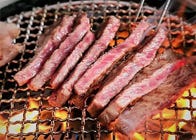
30. Yakisoba (焼きそば): Tasty Fried Noodles
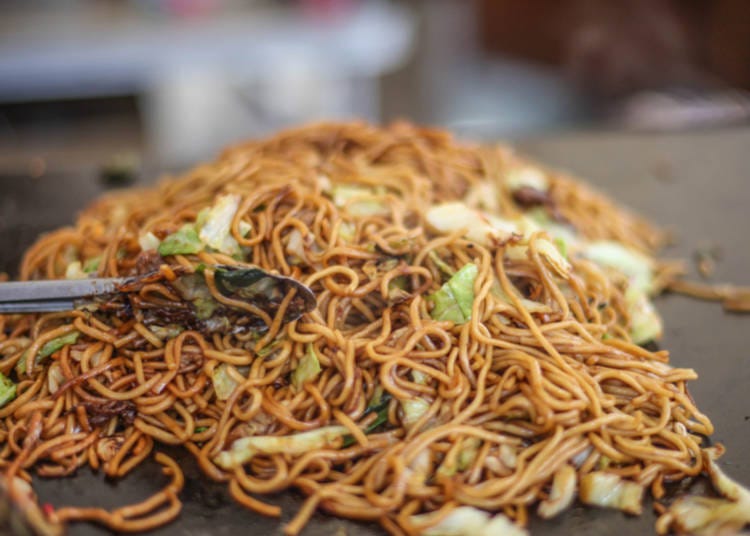
Yakisoba is a Japanese dish that consists of grilled soba noodles and is usually served at festivals. However, you can also make yakisoba by stir-frying the noodles. You can add various ingredients such as pork, fish, or vegetables and enhance the flavor with toppings like seaweed powder, ginger, and fish flakes. Finally, add sauces such as oyster sauce to give it a delicious taste.
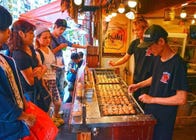
31. Yakitori (焼き鳥): Savory Grilled Skewers
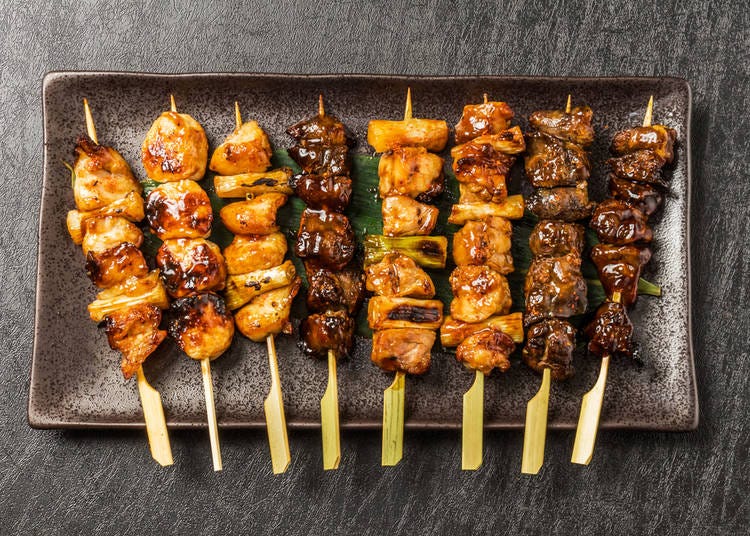
Yakitori , which literally means grilled chicken, actually refers to all kinds of skewered meat (as well as vegetables) cooked on a grill. This dish is simple yet flavorful, and there are countless combinations of ingredients to try. You can find Yakitori in many restaurants and specialty shops. When you visit a good izakaya , it is highly recommended to try this popular Japanese food .
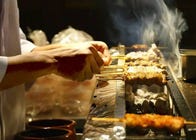
32. Yakizakana (焼き魚): Grilled Fish Delicacies
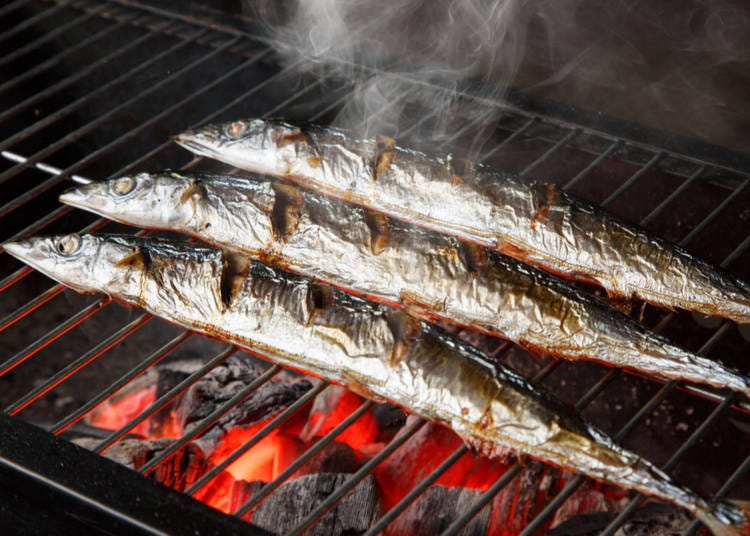
While in Japan, it's essential to try grilled fish, Yakizakana. Although sushi is more famous outside Japan, raw fish is not as common as grilled fish in the country. Typically, a whole fish is grilled and served with side dishes consisting of various vegetables and rice. You can try it at specialized restaurants for an immersive experience or at chain restaurants for a delicious, inexpensive, and quick meal that will keep you energized for several hours of sightseeing ahead.
You’re now on the way to become a true expert on food in Japan! Yet there’s much more to Japanese cuisine that can be discovered! While visiting this amazing country and taking in all the sights, the fun, and the culture, don’t forget to eat!
Written by:

Lucio Maurizi
Lucio Maurizi is an automotive expert specializing in Japan's car scene and auto-tourism. With an MA in East Asian History from La Sapienza Università di Roma, he's a multi-talented contributor to travel platforms like LIVE JAPAN, Japan Travel, and GPlus Media. His Instagram account (50k+ followers) offers insider views on Japan's automotive culture. Lucio also actively collaborates with professional drivers and influencers and organizes can't-miss car events in Tokyo. Instagram: @italian_in_japan Other links: https://linktr.ee/italianinjapan
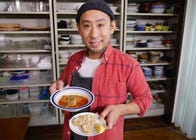
- Category Japanese cuisine
Share this article.
Limited time offer: 10% discount coupons available now!
Recommended places for you.
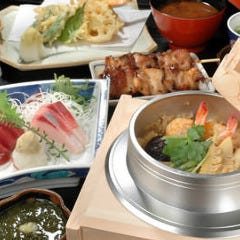
Ganso Kamameshi Haru
Japanese cuisine
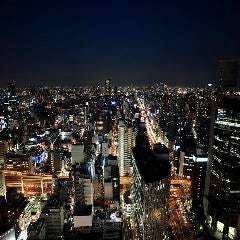
Kawakyu Umedaten
Umeda, Osaka Station, Kitashinchi
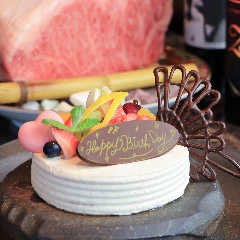
Miyazaki Ozakigyu Washoku Teppanyaki Gin Umeda Hiruton Puraza Uesuto
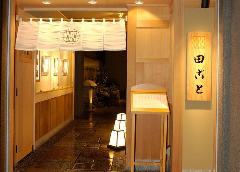
Gion, Kawaramachi, Kiyomizu-dera Temple
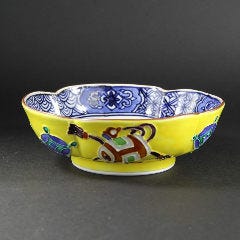
Kitcho Nambadainingumezonten
Namba, Dotonbori, Shinsaibashi
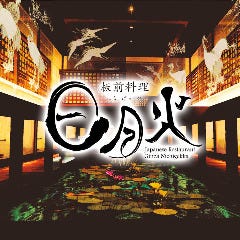
Nichigekka Ginza

15 Must-Try Sushi Restaurants in Tokyo (+5 Trending Areas to Explore for Foodies)

Best Things to Do in Tokyo in April 2024: Events, Festivals & More

12 Unique & Fun Tokyo Food Tours to Enjoy in 2024

The CASIO S100: How CASIO's Masterpiece Calculator Redefines Business Elegance With Japan-Made Reliability

Step Into the Story: Inside Immersive Fort Tokyo

A Complete Guide to the JR West Kansai Area Pass
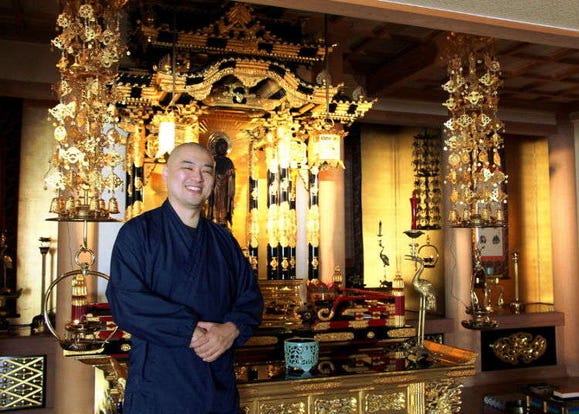
Of Tomatoes, Laptops, and Prejudice: Meeting the Monk of Kurayami Gohan, Tokyo’s Buddhist Dark Dinner
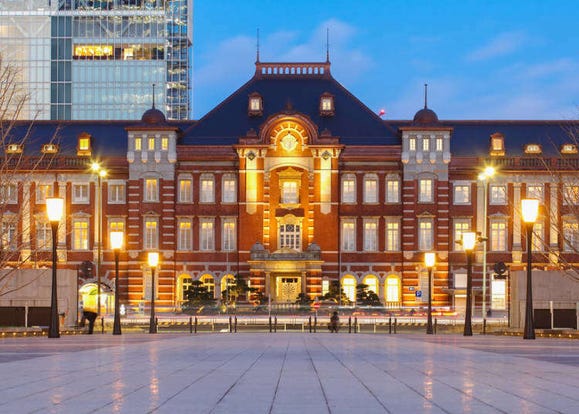
Exploring Tokyo: 3 Must-Visit Spots around Tokyo Station
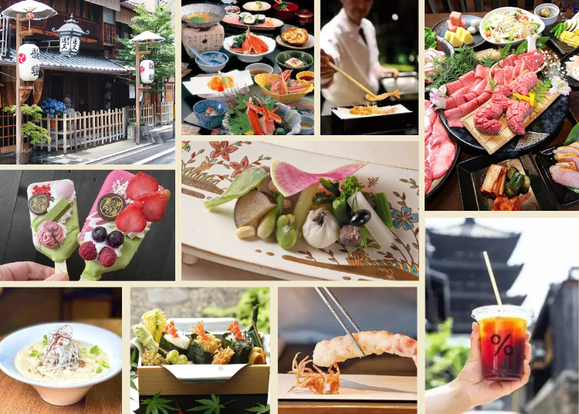
40 Must-Try Foods in Kyoto's Gion District: Indulge in Kaiseki Cuisine, Wagyu Beef BBQ, and Non-Stop Matcha Desserts
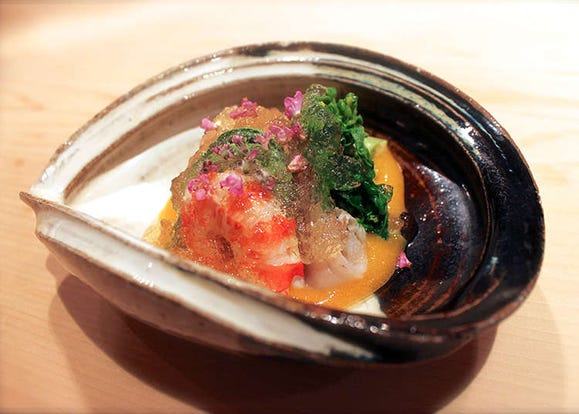
Fine Japanese dining in Tokyo
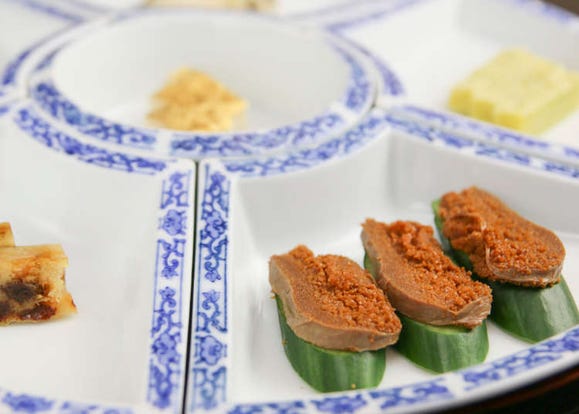
Indulging in Authentic Japanese Cuisine
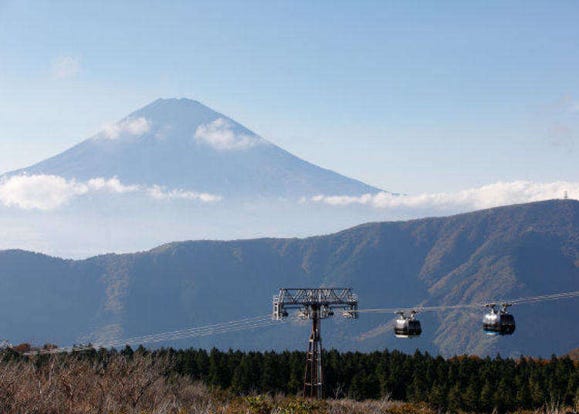
Easy Day Trip from Tokyo! Ultimate Sightseeing Guide for Hakone & Lake Ashinoko!
- #best sushi japan
- #what to do in odaiba
- #what to bring to japan
- #new years in tokyo
- #best ramen japan
- #what to buy in ameyoko
- #japanese nail trends
- #things to do japan
- #onsen tattoo friendly tokyo
- #best coffee japan
- #best japanese soft drinks
- #best yakiniku japan
- #japanese fashion culture
- #japanese convenience store snacks
10 Best Food Tours in Japan
Taste the Traditions: Iconic Food Experiences Across Japan
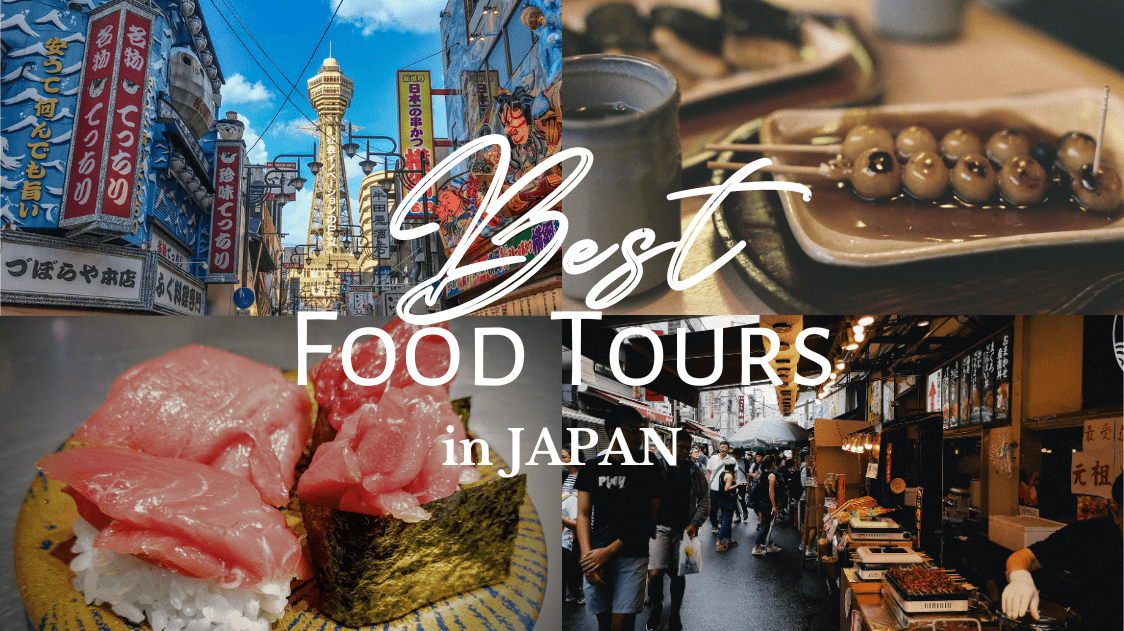
Japan, an archipelago renowned for its centuries-old traditions and modern marvels, offers a culinary landscape as diverse as its culture. Also, who doesn’t love Japanese food?
While the country’s iconic sushi and ramen have already made a mark on global palates, there’s so much more to discover. Taking a food tour in Japan is not just about satiating one’s appetite, but also a journey through its rich history, traditions, and local flavors. For international visitors, embarking on one of these tours provides an immersive experience that goes beyond regular dining. It’s a bridge to understanding the soul of Japan, a feast not just for the taste buds but also for the heart and mind.
In this article, I will introduce to you our list of the 10 best food tours in Japan.
*Please note that this article contains affiliate links.
What are Food Tours?
Japan’s culinary landscape is a delightful fusion of tradition, innovation, and an unparalleled commitment to quality. What makes Japanese food truly special is its emphasis on fresh, seasonal ingredients, meticulous preparation methods, and a deep-rooted respect for the art of cooking. From the intricate layers of flavors in a bowl of ramen to the delicate artistry of sushi, every dish tells a story.
Embarking on a food tour in Japan offers the most efficient way to delve into this rich culinary culture. With knowledgeable guides leading the way, you not only get to taste an array of delectable dishes but also gain insights into their history, preparation, and significance. Every question you might have, from ingredients to customs, will be addressed by these culinary experts.
What’s more, many food tours are flexible, adapting to individual preferences and dietary requirements. So whether you have a penchant for street food or a specific regional dish, there’s likely a tour that caters to your tastes.
In addition to the gastronomic pleasures, food tours provide an excellent platform to interact with fellow enthusiasts. You’ll find yourself sharing a table with people from all corners of the globe, enhancing your experience and fostering a sense of global community over shared meals.
1. Tokyo Night Foodie Tour in Shinjuku
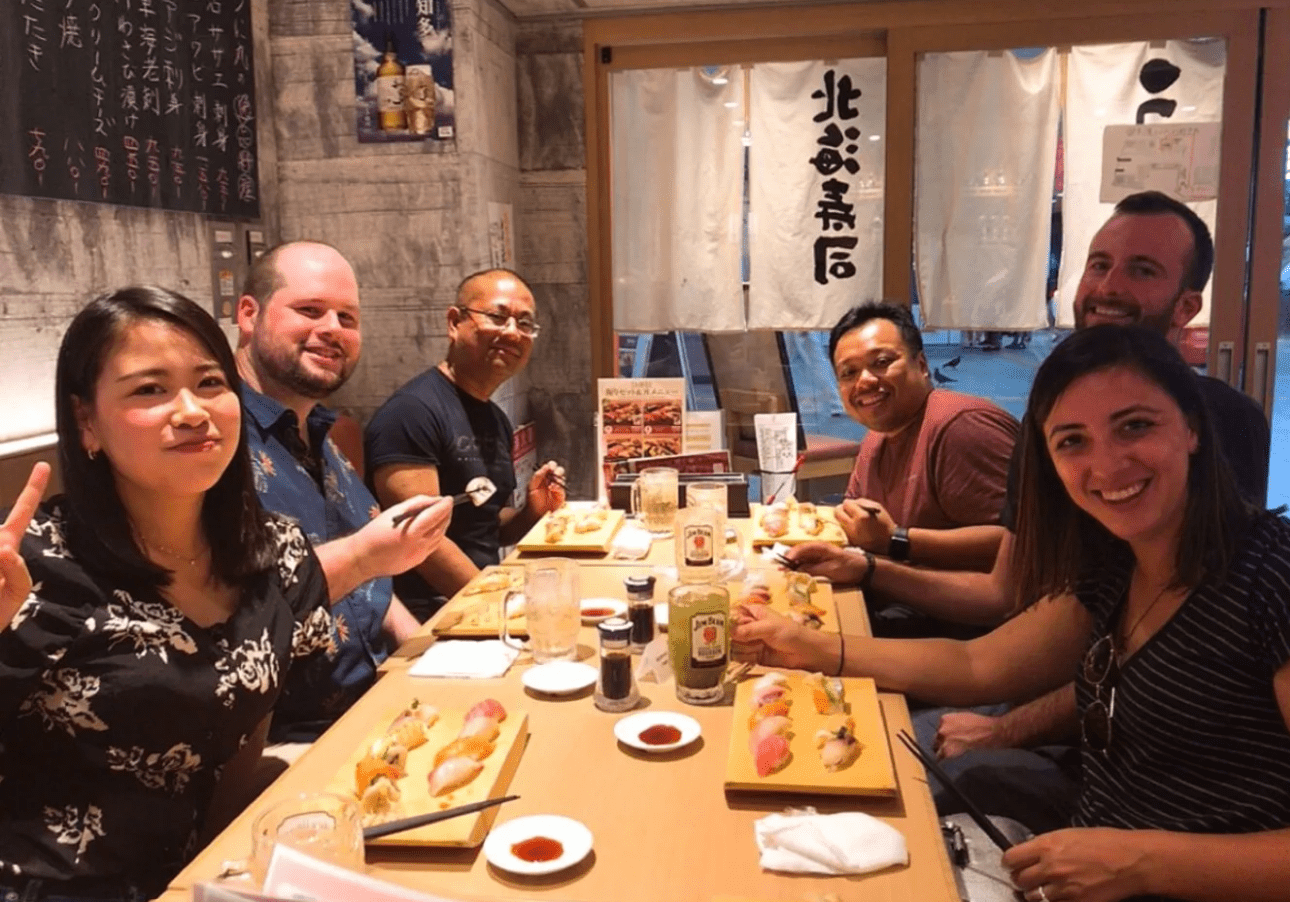
The first food tour on our list is the Tokyo Night Foodie Tour in Shinjuku . You can go through various Japanese culinary experiences in one night.
Shinjuku is a great area to explore Tokyo’s diverse culinary scene, offering a wide range of food experiences, but you may not have enough time to go through them all with a single visit. This small group tour, led by an English speaking guide, takes you to three different eateries and offers various bucket-list-worthy food experiences including Omakase sushi, premium wagyu beef, and drinking at Kabukicho, the neon-lit red light district.
<<Book Online: Tokyo Night Foodie Tour in Shinjuku>>
2. Tokyo Fish Market Tour at Tsukiji
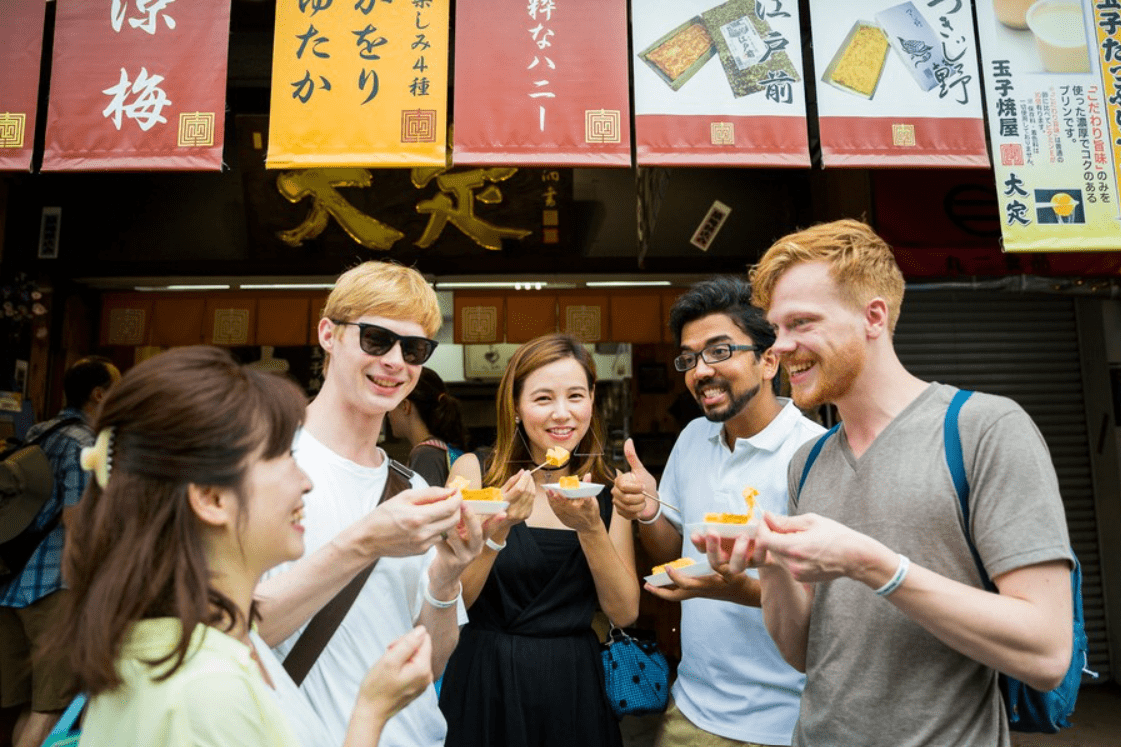
The second food tour on our list is the Tokyo Fish Market Tour at Tsukiji . Embark on a culinary journey through Tokyo’s renowned Tsukiji Fish Market with our expert guides, well-versed in the intricacies of Japanese food culture.
On this tour, indulge in a diverse array of Japanese delights, from tantalizing finger foods to unique local specialties. Witness the bustling small wholesale section, showcasing an impressive variety of seafood, including the much-sought-after fresh tuna. The tour culminates in a visit to an esteemed local sushi establishment, where you’ll savor some of the freshest sushi offerings. Whether you’re a Tsukiji first-timer or language barriers concern you, our accommodating guides ensure a seamless and enriching experience.
<<Book Online: Tokyo Fish Market Tour @Tsukiji – Enjoy Local Food and Drink>>
Check out our experience when taking part in this food tour from the following link!
▶ Tsukiji Fish Market Tour: Best Food Walking Tour in Tokyo
3. Kyoto Food and Drink Tour at Nishiki Market
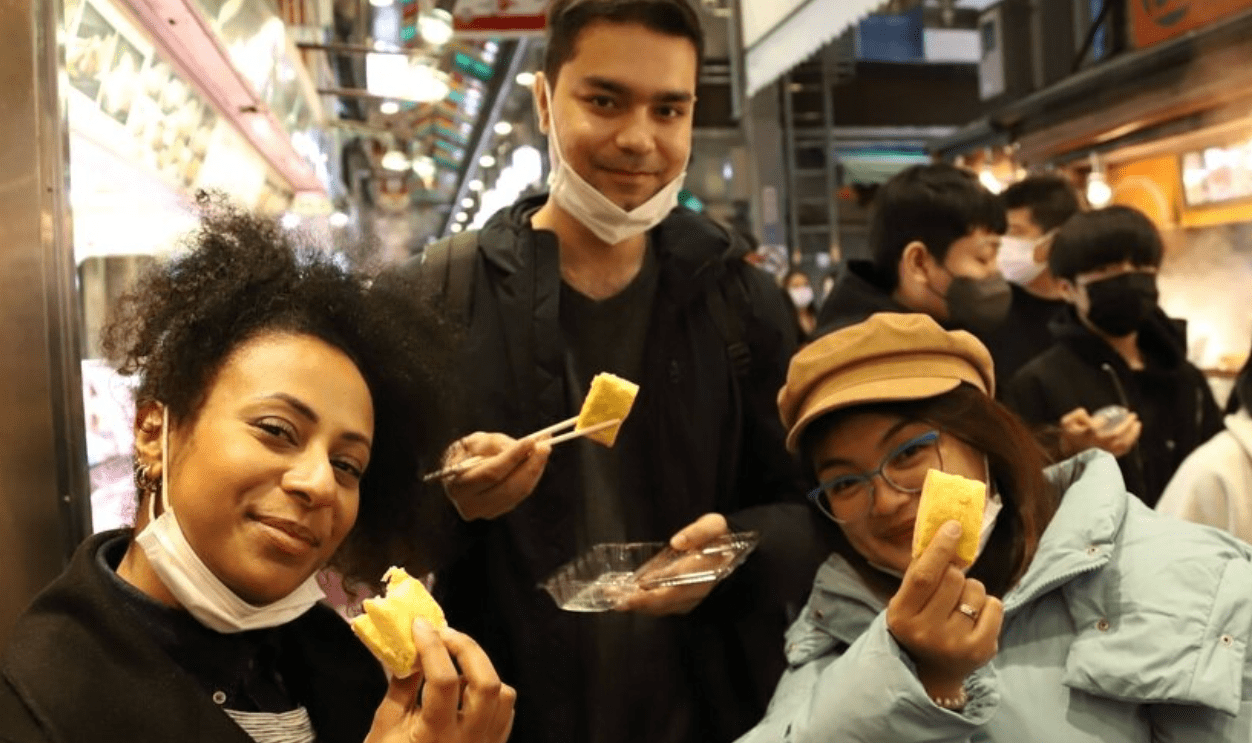
Next, we have the Kyoto Food and Drink Tour at Nishiki Market . Take part in a Kyoto culinary journey with an intimate Nishiki Market Food Tour, offering insights into the city’s deep-rooted heritage, blending the traditional with the contemporary.
This tour is more than just a tasting experience; it paints a vibrant picture of Kyoto’s everyday life and centuries-old history. Navigate through the bustling Nishiki Market, discover hidden gems like Takoyakushido Eifukuji Temple and Rissei Garden Hulic Kyoto, and get a taste of modern Kyoto at a café repurposed from an old elementary school.
<<Book Online: Kyoto Food and Drink Tour @Nishiki Market>>
▶ Nishiki Market Tour: Food and Shopping Guide
4. Hiroshima Bar Hopping Food Tour
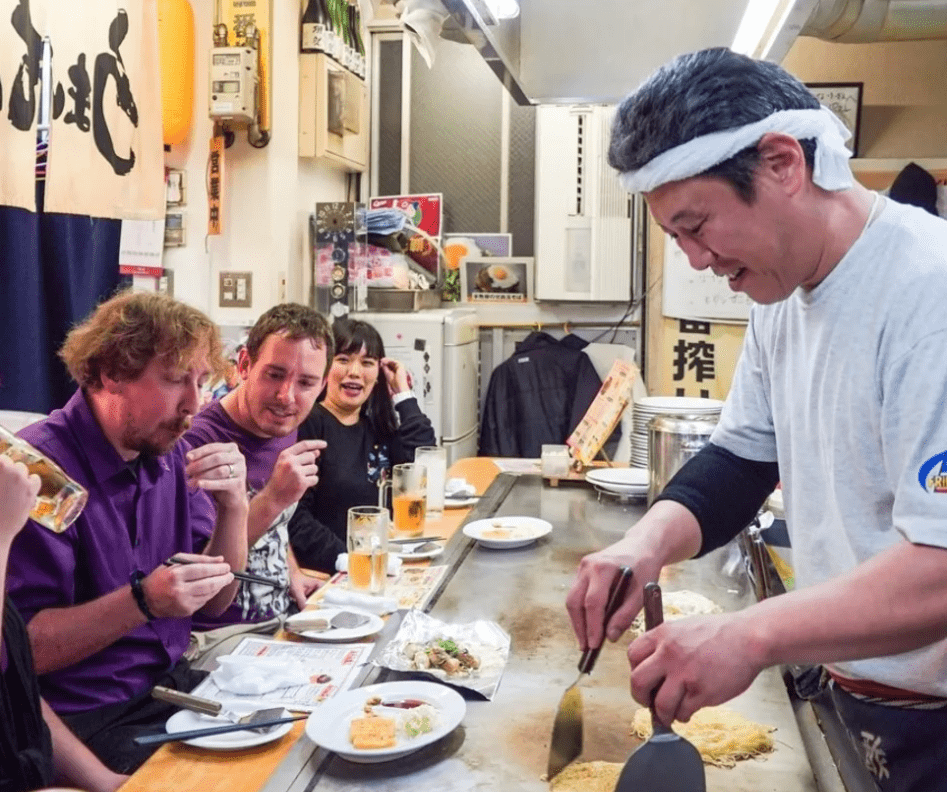
Another Place you should consider taking part in a food tour is Hiroshima! The Hiroshima Bar Hopping Food Tour is our recommendation!
Discover Hiroshima’s vibrant nightlife on this bar-hopping tour through the heart of Nagarekawa. Experience authentic Hiroshima, securing seats at three select izakayas, where delectable local delicacies await. Savor iconic Hiroshima-style okonomiyaki, fresh oysters, and the unique horumon tempura.
As you mingle with the city’s friendly locals, immerse yourself in the genuine ambiance of Hiroshima’s culture and gastronomy, making for an unforgettable night out.
<<Book Online: Hiroshima Bar Hopping Food Tour>>
5. Tokyo Local Street Food and Drink Tour at Sunamachi
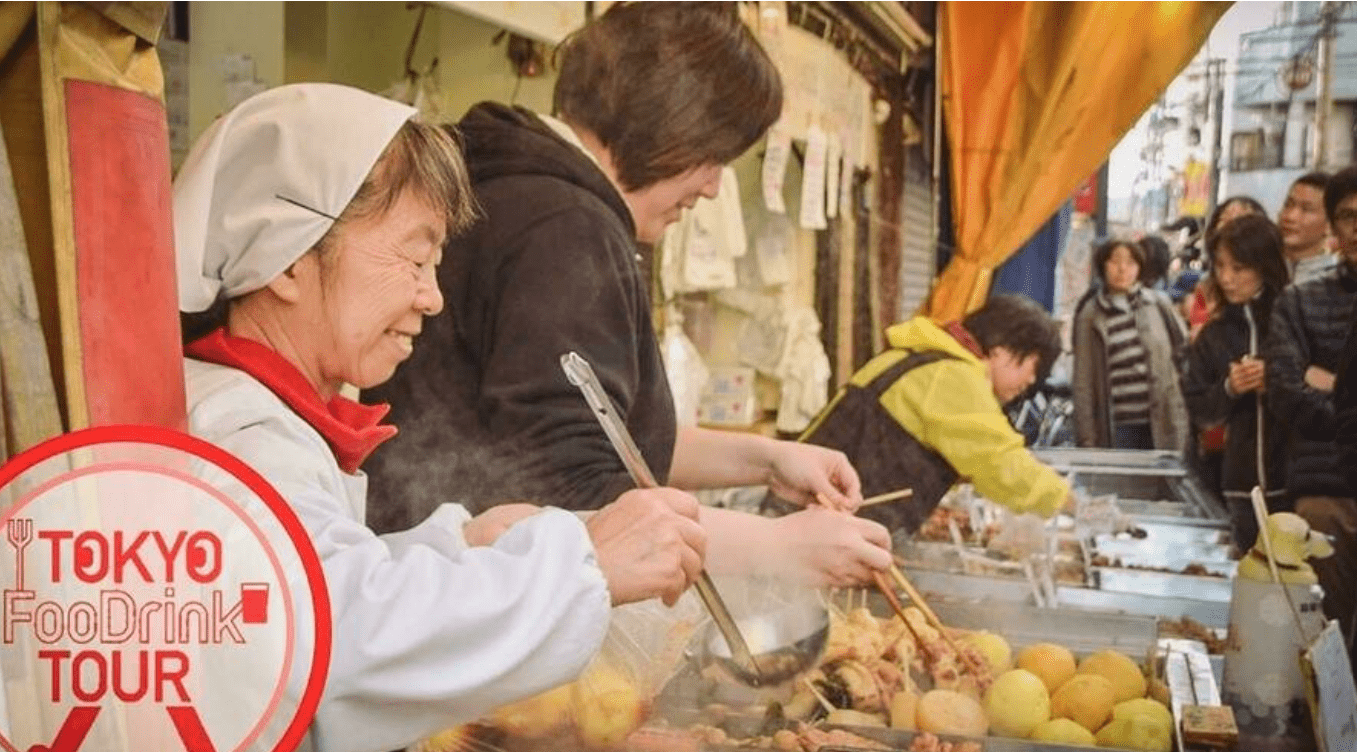
Dive into the heart of Tokyo’s culinary scene with the Tokyo Local Street Food and Drink Tour at Sunamachi .
Stroll along the nostalgic 670-meter-long Sunamachi shopping street, home to over 180 establishments, and experience the warmth of its community. From the crispy Tempura to succulent Yakitori skewers and comforting Oden hot pot, relish dishes freshly prepared in family-run kitchens. Raise a glass with a spirited “Kampai” using traditional Japanese Sake right on the street.
With your guide bridging the language gap, engage with the welcoming locals, making you feel right at home amidst the flavors and tales of East Tokyo.
<<Book Online: Tokyo Local Street Food and Drink Tour @Sunamachi>>
6. Osaka Local Foodie Tour in Dotonbori and Shinsekai
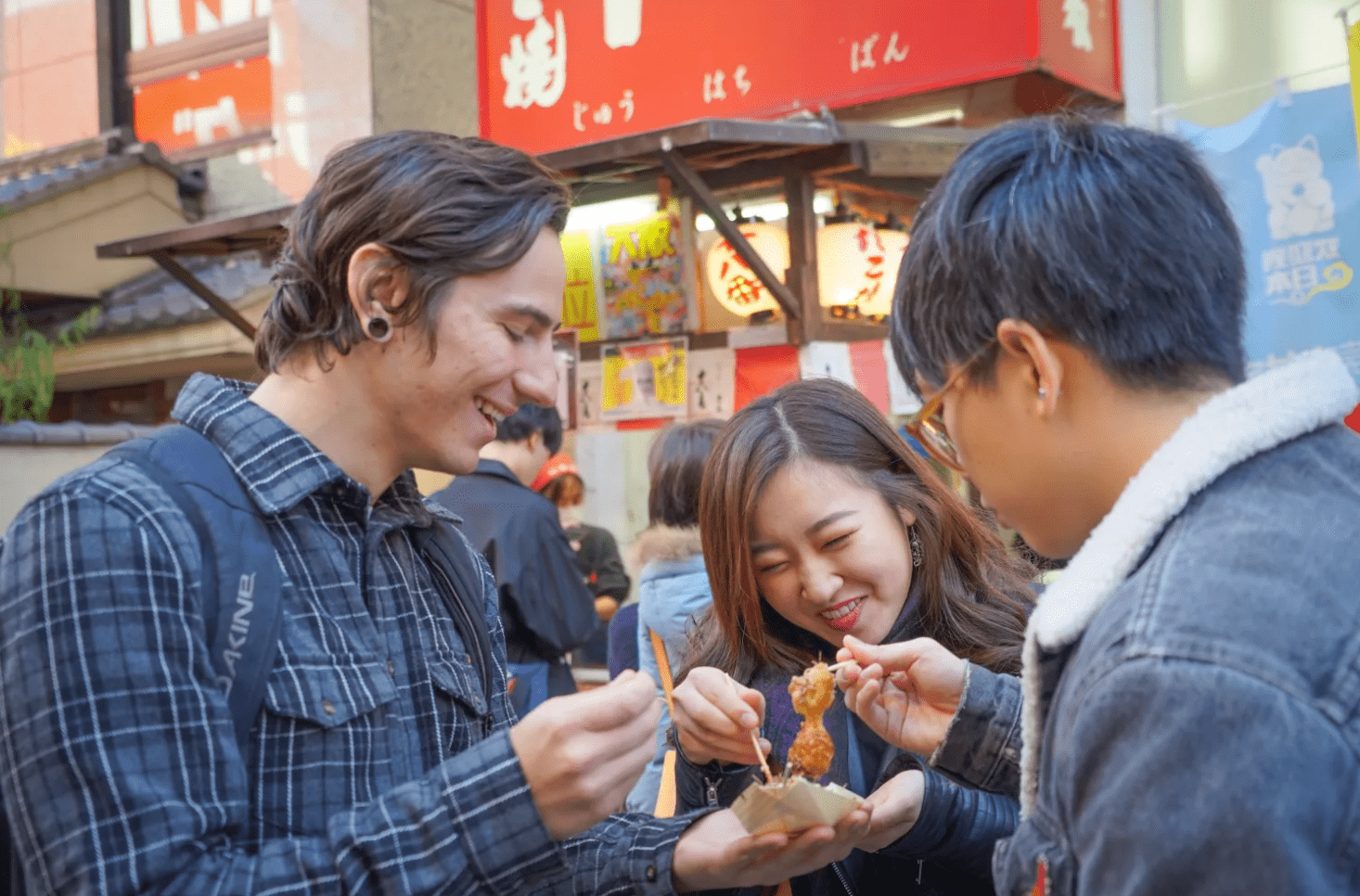
Embark on a flavorful journey with the Osaka Local Foodie Tour in Dotonbori and Shinsekai .
Within a span of 3 hours, let the local guide introduce you to 8 delectable Osaka specialties including the iconic Takoyaki, Okonomiyaki, and Kushikatsu. Venture beyond the bustling streets into hidden alleys and ancient temples, unveiling Osaka’s rich history. Relish the flavors of yesteryears in Shinsekai with delicacies like Kushikatsu, and meander through a nostalgic food alley that transports you back in time. Cap off your food adventure in Dotonbori, fondly known as the “nation’s kitchen,” and indulge in its gastronomic treasures.
<<Book Online: Osaka Local Foodie Tour in Dotonbori and Shinsekai>>
7. Sapporo Bar Hopping Food Tour
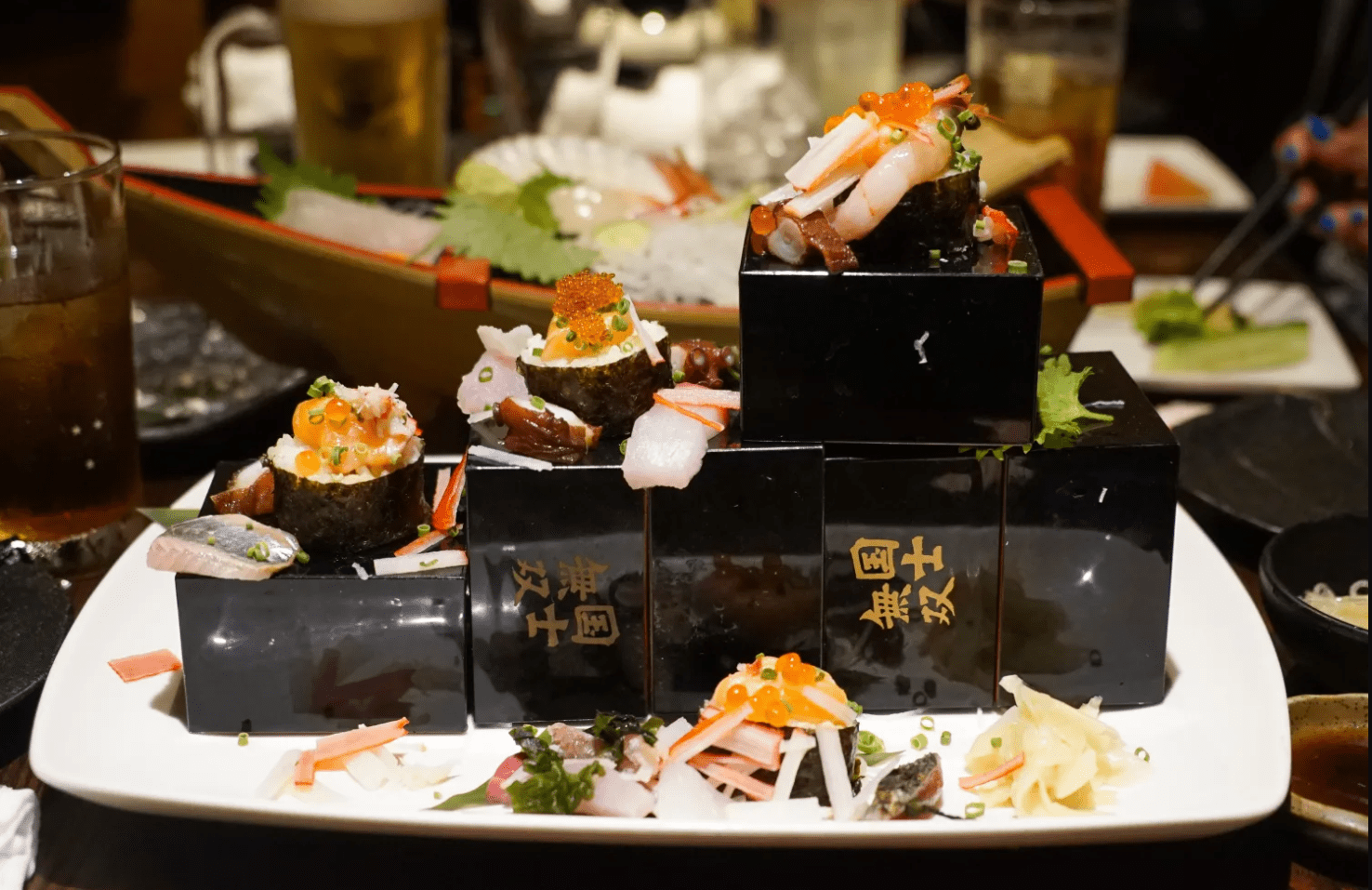
Next on our list is the Sapporo Bar Hopping Food Tour . The local guides lead the way to three unique izakayas, including an enchanting igloo-shaped one, places you might miss on your own.
Relish the bounties of Hokkaido with delectable seafood freshly sourced from its icy waters. The tour doesn’t just highlight food; it’s a curated beverage experience too. And as the night draws to a close, decide between a decadent parfait or a bowl of savory ramen to wrap up this memorable Sapporo escapade.
<<Book Online: Sapporo Bar Hopping Food Tour>>
8. Osu Street Food Tour in Nagoya
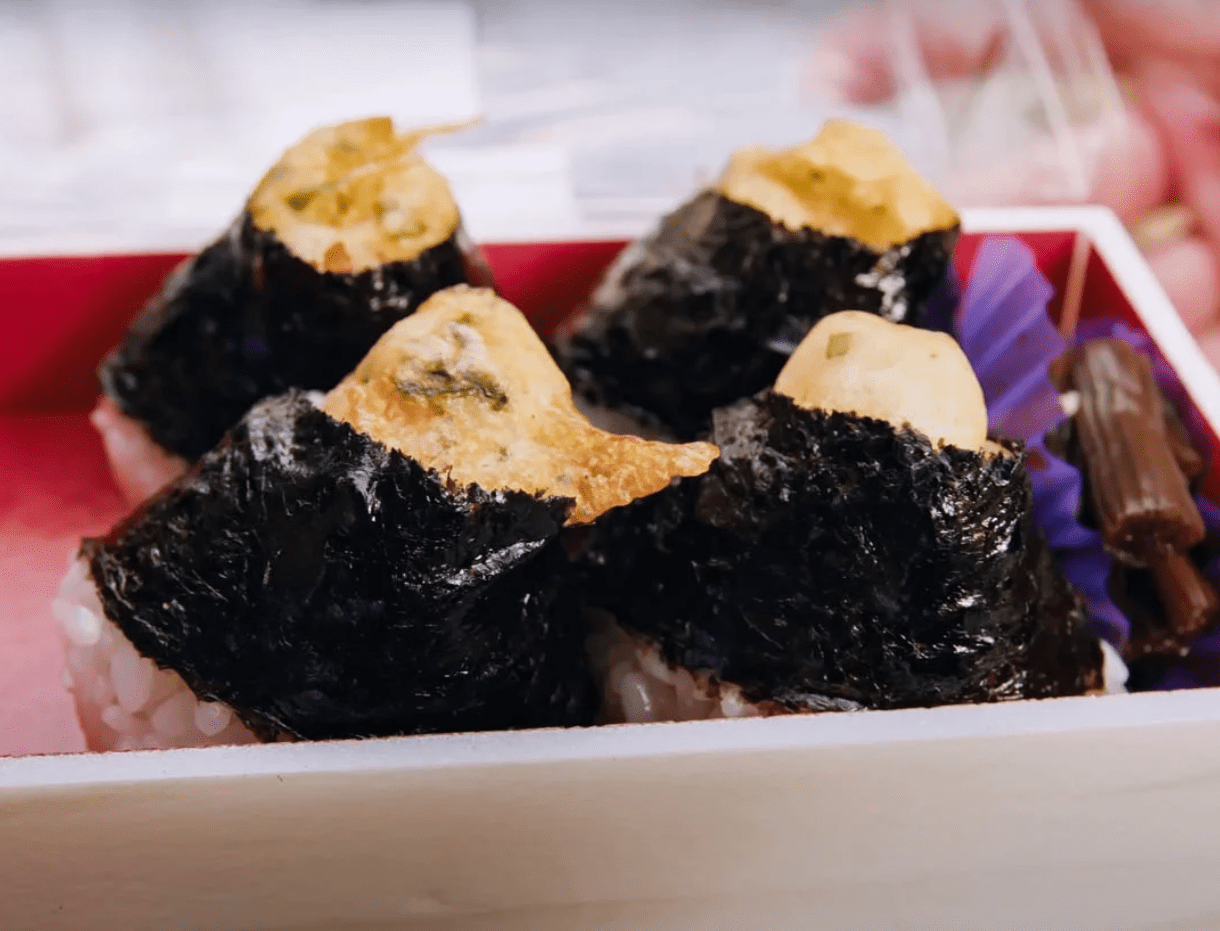
The next stop is another popular location for its food! The Osu Street Food Tour in Nagoya will dive deep into Nagoya’s history as you explore the vibrant Osu District, from its entertainment-rich past to its lively present and promising future.
Alongside temples and shrines, you’ll understand their distinct characteristics and even partake in traditional omikuji fortune-telling. But what’s a tour without flavors? Savor Nagoya’s unique delicacies, from the delectable Goheimochi and Karaage to the region’s takes on Uiro and Miso Kushi Katsu. And don’t miss Japan’s bubble tea craze! At the tour’s end, you’ll leave with both spiritual fulfillment and a satiated palate
<<Book Online: Osu Street Food Tour in Nagoya>>
9. Kyoto Night Foodie Tour in Gion & Pontocho
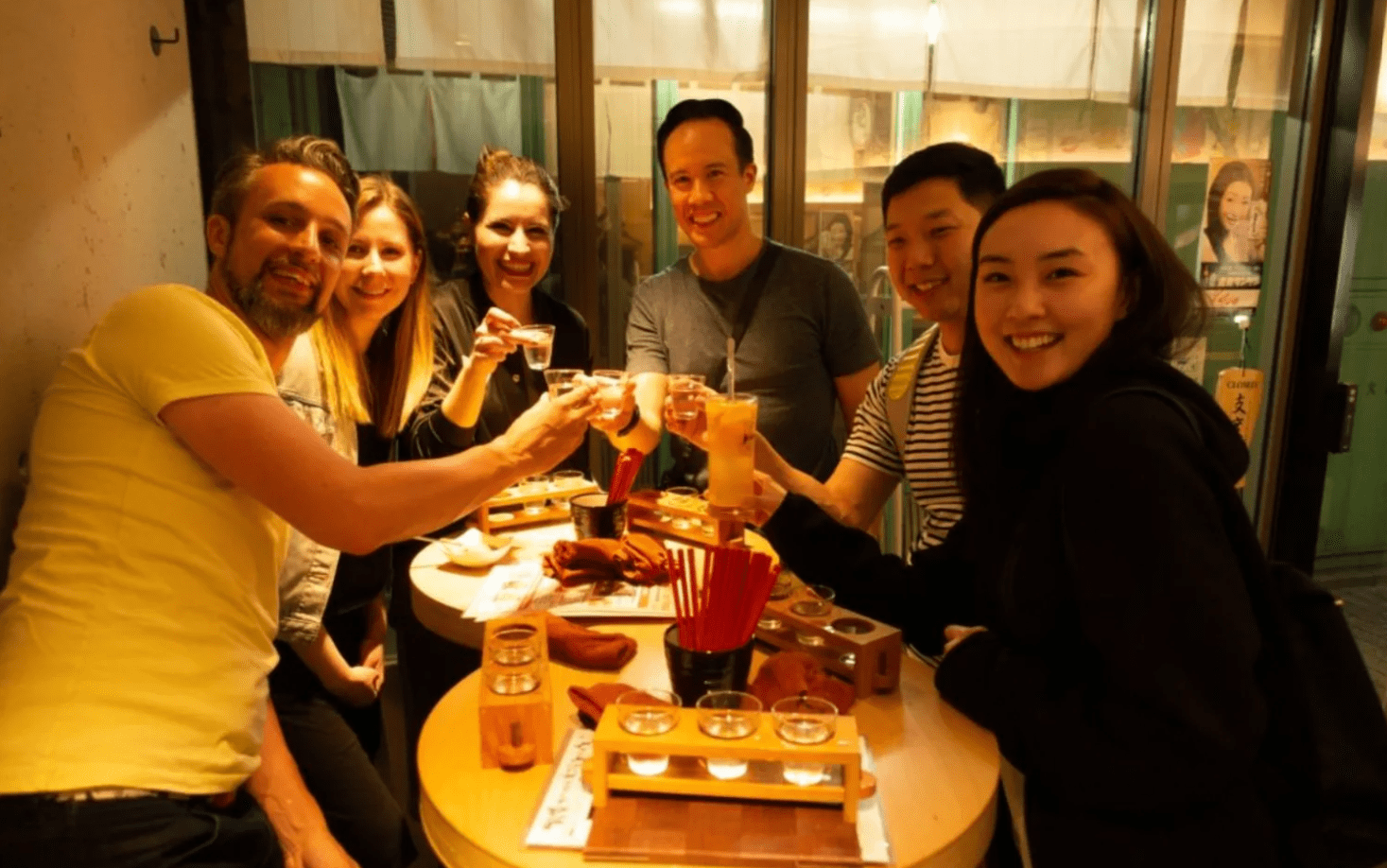
Take part in an intimate gastronomic adventure with the Kyoto Night Foodie Tour in Gion & Pontocho . Traverse the enchanting backstreets of Gion and Ponto-cho, discovering Kyoto’s genuine food culture under the canopy of night.
With a local guide leading the way, not only will you delight in Kyoto’s traditional dishes at a concealed Gion eatery, but you’ll also be introduced to an array of Kyoto sake, complete with insightful explanations. Perfect for families and culinary enthusiasts alike, the tour culminates in a taste of Kyoto’s signature desserts or perhaps even more local delicacies. Experience the genuine voice of Kyoto, one bite at a time.
<<Book Online: Kyoto Night Foodie Tour>>
10. Local Bar Hopping Experience in Fukuoka
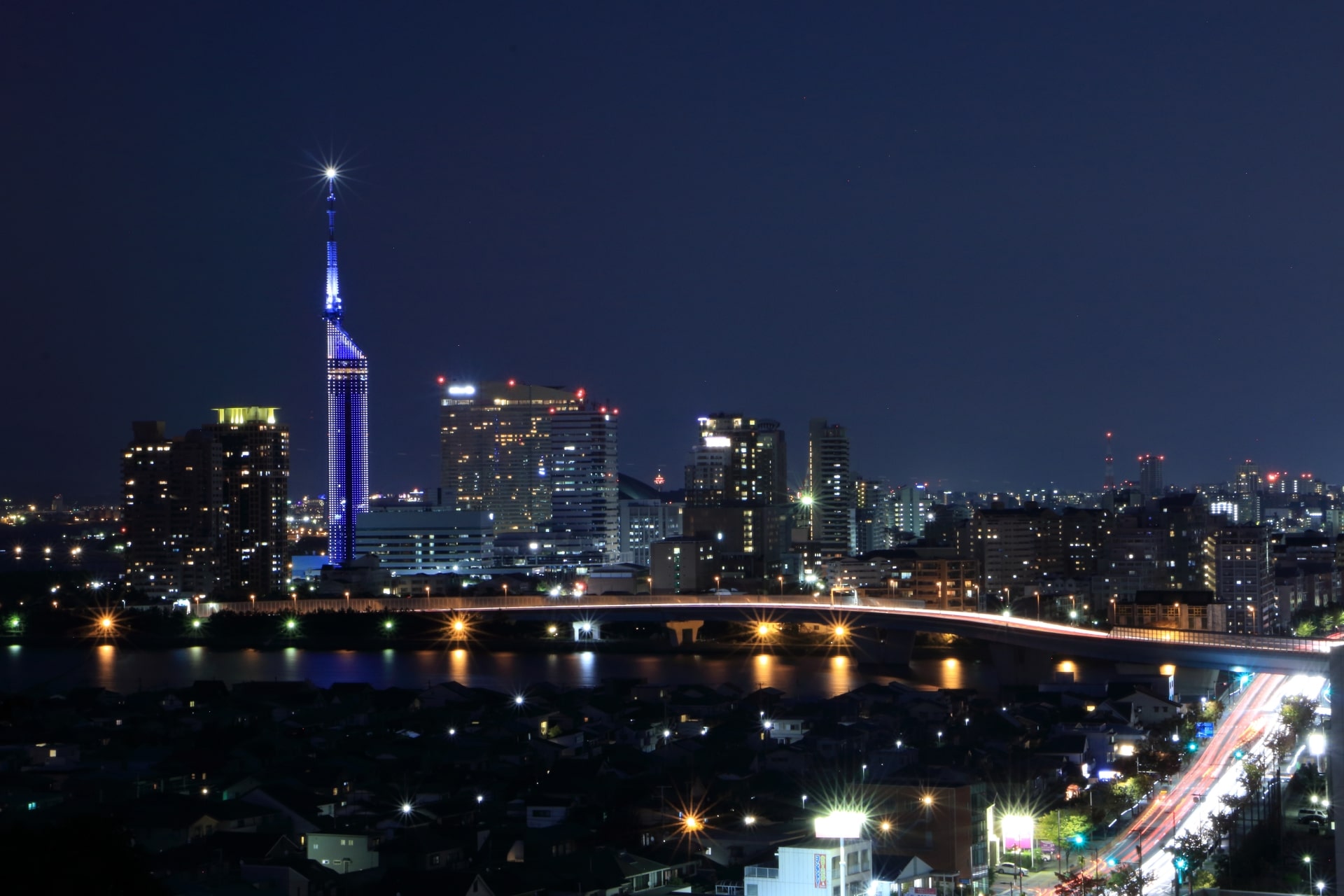
And we will finish our list all the way down south. Dive into Fukuoka’s vibrant nightlife with the Local Bar Hopping Experience in Fukuoka .
Wander through the bustling food alley of Hakata, one of Fukuoka’s premier nightlife hubs, under the guidance of an expert. Navigate the city’s hidden backstreets, savoring authentic treats like yakitori, mentaiko, and indulging in the finest Kyushu shochu and Japanese sake. This immersive journey will take you to two handpicked izakayas and a cherished local restaurant, offering a genuine taste of Fukuoka after dark.
<<Book Online: Local Bar Hopping Experience in Fukuoka>>
▽Here are more food tours in Japan!▽
▶12 Best Food Tours in Tokyo
▶Best Food Tours in Kyoto
For more information about food or traveling in Japan, check these articles below!
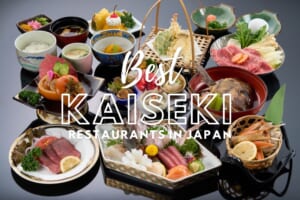
▽Related Articles▽
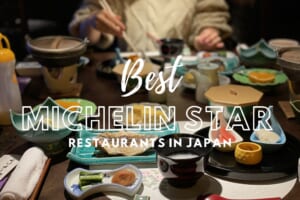
Born and raised in Costa Rica, I started living in Tokyo from college. I love traveling within Japan & around the world. Since I wasn’t born in Japan, I know the cultural impact that you can get when visiting Japan for the first time and what you might be worried about before your trip. And I’ve lived long enough to somewhat understand the nuances of the Japanese culture that make this country such an attractive place to visit. Hopefully I can provide to you both the information you’re looking for and the information you didn’t know you needed to know.
- Things to Do
- Food & Drinks
50 Japanese Foods to Try While You Are in Japan

- tetuya.asakura
In many countries, Japanese food typically meant sushi, sukiyaki and tempura, but now Japanese gourmet foods are making a name for themselves all around the world! No matter your tastes, you'll love eating your way through Japan. Here, we would like to introduce some of the most delicious Japanese dishes and foods to try during your stay in Japan.

This post may contain affiliate links. If you buy through them, we may earn a commission at no additional cost to you.
Sushi is a traditional Japanese food made by combining vinegar rice and seafood (although sometimes other ingredients are also used). There is a type of fermented sushi, known as nare-zushi, but the most typical types of sushi are nigiri-zushi and temaki-zushi.
There are plenty of other ingredients available for those who do not like raw fish, including boiled prawns and grilled conger eel. You can find sushi all around Japan, but the sushi from restaurants in high class areas like Ginza or close to fishing ports is especially delicious. If you are looking to eat cheaply, you can visit a kaitenzushi, or conveyor belt sushi restaurant , where you can enjoy sushi for 100 yen a plate.
Being the land of sushi, all the available options may be overwhelming. If you're looking for a delicious sushi restaurant in Tokyo, why not consider Ginza Saisho , where you can savor delicious, fresh seafood sushi. Meanwhile, Osaka is home to Amano , which is run by a chef with a stellar history when it comes to working with fish.
Don't miss our Ultimate Sushi Guide for important manners and tips you'll need to know when eating sushi in Japan!
Tempura is a Japanese dish made from seafood, fresh vegetables and other ingredients dipped in a flour and egg batter and fried in oil. While you can enjoy tempura at all sorts of restaurants, if you want to try it at its best, we recommend going to a specialist tempura restaurant, where each dish will be brought to your table as soon as it is ready, even if you order a lot!
If trying tempura at a specialty restaurant peaks your fancy, both Tempura Ono in Tokyo and Tenyu in Kyoto offer scrumptious tempura prepared with fantastically fresh ingredients.
3. Sukiyaki
Sukiyaki is a Japanese dish in which meat and vegetables are stewed in an iron pot. The sauce, known as warishita, is made from soy sauce and sugar. There is a lot of variation in the ingredients and way of eating the dish depending on the region, with some areas mixing beaten egg into the sauce to create a milder flavor. If you are looking to enjoy a lot of great beef, this is the dish for you!

Ramen is a noodle soup dish which has grown to become incredibly popular and is thought of as a byword for Japanese food. Originally, the soup was made from a chicken bones, but in recent years, pork, beef and seafood also being used in the soup, creating a diverse range of tastes. In addition to the typical salt, soy sauce and miso flavors, you can even find curry-flavored ramen now. There is also a type of ramen where the noodles and soup are served separately, known as tsukemen. If you want to visit a ramen restaurant in Japan, first check out 5 Things to Keep in Mind When Trying Ramen in Japan . It's a great primer to get you ordering like a pro!
As it is a staple in everyday Japanese cuisine, popular and famous shops will usually have lines out the door of people waiting to get a bite of their delicious ramen. Menya Itto is one such shop, attesting to its taste, and has configured a system to make waiting more convenient for its customers. How often can you say you've had a bowl of ramen from one of the most famous establishments in Japan?
5. Curry Rice
While curry has its origins in India, the curry we eat in Japan is a unique, localized dish based on the curry brought over to Japan from the UK. Made with meat and vegetables (carrots, potatoes, onions, etc.) flavored with curry powder, stewed, and served with rice. Sometimes fried foods, such as pork cutlets, are placed on top of the dish. While there are some specialist curry restaurants, you typically won't have any problems with the curry at a regular restaurant or chain restaurant.
6. Tonkatsu
Tonkatsu is a popular Japanese dish based on western pork cutlets, where a thick slice of pork is dipped in a flour and beaten egg batter, coated in breadcrumbs and fried in oil. There are both sirloin and fillet tonkatsu, with the fillet tonlatsu being more expensive. While quite tasty even at a cheap restaurant, we really recommend trying tonkatsu at a specialist restaurant.
This traditional Japanese food is a dish of noodles is made from soba (buckwheat) flour eaten with a soy sauce and sugar sauce, and toppings such as egg, tempura or other ingredients. The noodles you get from a soba noodle shop will be particularly good, but very expensive, so it might be good to try the soba at a standing restaurant. The different dishes and toppings are usually on display in a showcase outside the restaurant, making it easy to decided what to order.
Yamori is a soba restaurant run by a chef so knowledgeable about soba that the menu allows customers to taste soba in a wide variety of ways. It is the perfect place to understand the complexity of soba!
Udon are noodles made from kneaded wheat flour, and eaten with a sauce made from soy sauce and sugar, similar to soba. You can enjoy udon on at the standing soba restaurants, but as the firmness of the noodles, known as koshi, is a key part of the dish, we really recommend eating it at a specialist udon restaurant. In winter, why not try the delicious noodle stew, known as nabe yaki udon?
Karaage is chicken seasoned with soy sauce, salt and a number of different spices, sprinkled with starch and fried in oil. It is like the Japanese version of fried chicken, but the flavor is very different. There are a lot of local variations, with for example chicken nanban in Miyazaki, where the karaage are covered with tartare sauce, and tebasaki in Nagoya, where the karaage are covered in a sweet and spicy sauce. We definitely recommend trying these out!
10. Yakitori
Yakitori is a dish in which skewered chicken seasoned with a sweet salt or soy sauce based sauce and barbecued. You can usually find yakitori at Japanese bar/restaurants, known as izakaya, but we recommend eating it at a specialist yakitori restaurant, where you can enjoy all sorts of different parts of the chicken at quite a reasonable price (unless you go to a high class place, where it will cost quite a lot.).Another popular Japanese food is skewered pork, or yakiton in Japanese, which is delicious as well!
At Taira in Tokyo, guests can enjoy yakitori prepared with free-range chicken and a plethora of sake that perfectly complement the meticulously grilled skewers.
11. Yakiniku
Yakiniku is a dish in which beef dipped in a sauce and grilled directly over a fire. The freshness of the meat is very important to the dish. By lightly grilling the dish, you can enjoy the soft flavor of Japanese beef. The most popular dishes are sirloin (known as rosu in Japanese) and kalbi (Korean-style marinated meat), but at a yakiniku restaurant you can enjoy all sorts of different types of meat. The price of the meat depends on the quality, so if you want to try real yakiniku, we recommend going once to a high-class yakiniku restaurant. If you want to know more, our Ultimate Yakiniku Guide has you covered!
Both YAKINIKU 37west NY in Tokyo and Wagyu Kappo Toraichi in Osaka offer sublime dining experiences, serving delectable yakiniku among a luxurious atmosphere. Here, your mouthwatering beef is sure to be prepared to perfection!
12. Sashimi
Sashimi is a traditional Japanese food made of raw selfish cut into small pieces and served with soy sauce. By adding condiments like wasabi or ginger, sashimi becomes even more delicious. You can enjoy sashimi in places other than Japan, but the level of freshness is different. If you are looking for somewhere cheap to enjoy sashimi, why not try a set meal at a restaurant near a fishing port, but if you’re willing to spend a little more, you should visit a sushi restaurant or a traditional Japanese restaurant - we guarantee you won’t be disappointed! If you stay at a Japanese inn, you will probably find sashimi on the menu there.
13. Robatayaki
Robatayaki is not quite a type of food, but more of a type of restaurant. At the restaurant, fish and vegetables are cooked over the fireplace and handed to customers with a large wooden spoon, known as a horikaeshi-bera. The ingredients are cooked directly on the charcoal, giving them a unique flavor. Robatayaki restaurants also have a unique code when ordering. For example, if you ask for a potato, or jagaimo in Japanese, the waiter/waitress will call out, Jagaimo ippatsu! for the order rather than the regular ikko counter. If this sounds like a culinary experience you would like to try, you can check out Robatasho in Tokyo!
14. Shabushabu
A dish in which meat and vegetables are boiled in water flavored with a stock of konbu and other ingredients. The typical dipping sauce for shabushabu is either a ponzu or sesame based sauce. The key to the dish is lightly submerging the meat in the water before eating. You can order both beef and pork, and additional orders are possible, and we definitely want you to try the pork as well. There are also cases where udon noodles are added to the dish at the end of the meal. Unlike some of the other dishes, you can’t really find shabushabu in non-specialized restaurants, although a few sukiyaki restaurants do offer shabushabu as well.
A dish from Sendai where the beef tongue (gyutan) is prepared in a special way that softens the meat, and because of this, you can only find it in special beef tongue restaurants. In a typical dish, you will usually have rice cooked with barley (mugimeshi) and a beef tale soup along with the beef tongue. With the mugimeshi, you will usually be served tororo, or grated yam, along with various pickles, such as white cabbage or chili peppers peserved in miso. Different to beef tongue in yakiniku restaurants, the beef tongue in special gyutan restaurants is quite thick.
16. Kaiseki Ryori
Kaiseki ryori is again not a dish itself, but a style of eating most suited to a banquet. The menu for the meal usually consists of ichijusansai (a soup, sashimi, a grilled dish and a cooked dish), in addition to an appetizer (otooshi), fried dishes (agemono), steamed dishes (mushimono), a type of Japanese salad (aemono), and pickled dishes, including others. To close the meal, rice, miso soup, pickles (konomono) and fruit (mizugashi) are served. Naturally, this sort of meal is only available at special kaiseki ryori restaurants, and a reservation is usually required. On top of this, the price can be very high, which makes it difficult to recommend. On the other hand, you won’t be able to find this outside of Japan, so if your wallet or purse permits, why not visit a kaiseki ryori restaurant during your stay in Japan?
Both Fukudaya in Tokyo and Kentan Hirobe in Kyoto are Michelin-starred kaiseki restaurants, ensuring high-quality, delicious dishes made with fresh seasonal ingredients.
A Japanese dish in which a bowl of rice is topped with beef. Gyudon, or beef bowl, has already become a popular dish around the world, but the gyudon you have in Japan may be slightly different to what you find elsewhere. For a start, the quality of the rice is different. While in Japanese gyudon restaurants, the rice they are using is probably not that expensive, but the beef really goes well with Japanese rise. We also recommend pouring beaten egg on top of the beef!
18. Chankonabe
A Japanese food where highly nutritious meat and vegetables are boiled in a large pot. Chankonabe is famous as a dish used by sumo wrestlers to build up their bodies. If you want to try chankonabe, we recommend a restaurant run by a former sumo wrestler.
The long-standing Chanko Kawasaki is one such restaurant. Here, you can enjoy authentic chankonabe in an establishment located in a Tokyo neighborhood commonly associated with sumo wrestling.
19. Motsunabe
A famous Japanese dish from Fukuoka in which beef and pork offal meat is cooked in a pot with various vegetable, such as cabbage and Chinese leek, known as nira in Japanese. You can add more ingredients as you cook it, meaning you can eat as much as you want. After finishing the main dish, it is common to add Chinese style noodles, chanpon noodles to the soup, or rice to make a rice gruel from the soup. You can find motsunabe restaurants in Tokyo , but as you can imagine, the flavor is different from the original Fukuoka version.
20. Onigiri
An onigiri is a boiled rice ball lightly salted and often filled with ingredients such as umeboshi (dried plum), salmon or cod roe, all wrapped in a sheet of nori (dried seaweed). To start, we recommend trying the tuna mayonnaise-flavored ingot. The21.re are specialist onigiri stores, but you can find them at convenience stores as well, so you can enjoy them whenever and wherever you go. They are surprisingly popular with foreign people.
Onigiri Asakusa Yadoroku is one of the oldest onigiri specialty shops in Tokyo, where onigiri are made fresh for the customers. It is a great place to stop by when exploring the popular neighborhood of Asakusa.
Next: No.21-40 Further Japanese foods you must try in Japan
The information in this article is accurate at the time of publication.
tsunagu Japan Newsletter
Subscribe to our free newsletter and we'll show you the best Japan has to offer!

About the author
Related Articles
Related interests.
- Donburi & rice
- Fish & Seafood
- Sweets & snacks
- Other Japanese food
- Japanese alcohol
- Restaurant types
- Noodles & Pasta
- Non-alcoholic drinks
Restaurant Search
Tsunagu japan sns.
Subscribe to the tsunagu Japan Newsletter
Sign up to our free newsletter to discover the best Japan has to offer.
Connect with Japan through tsunagu Japan
Let us introduce you to the best of Japan through our free newsletter: sightseeing spots, delicious food, deep culture, best places to stay, and more!
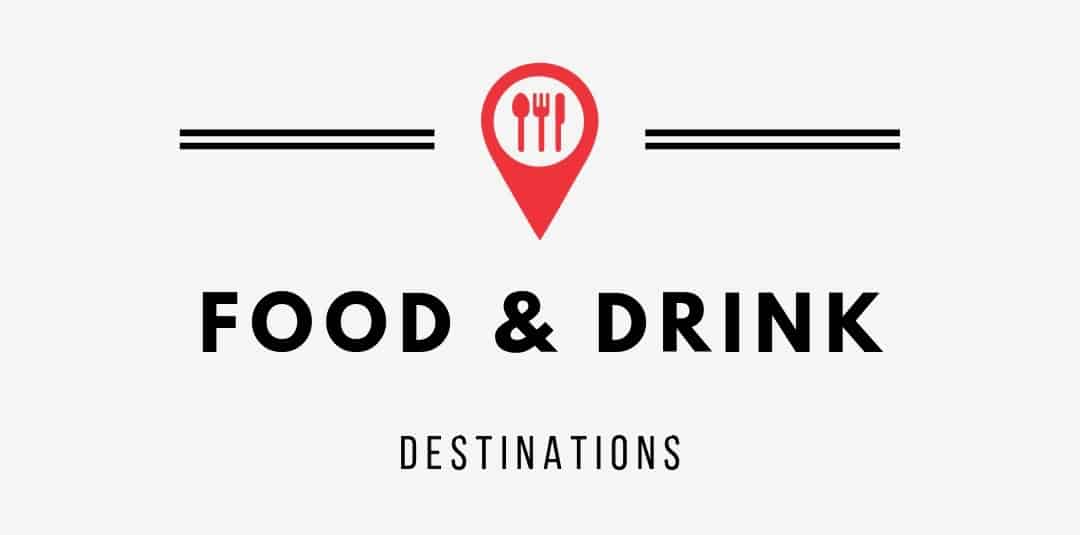
- Destinations
- Travel Guides
- For The Home
- Privacy Policy
Japan , Travel Guides
Food focused two week japan itinerary – 14 days of eating well.
We’ve taken several trips to Japan over the last decade, each time staying a bit longer and exploring a bit more than the last. I know many travelers don’t have the same flexibility in their schedules as we do. If you have the opportunity to spend two weeks in Japan, though, we want to ensure you eat well and drink well. Because Japan is one of the top culinary travel destinations in the world. In this post, I share our tips on how to plan a trip to Japan with a 14 day itinerary.
*This post contains compensated links. Find more info in my DISCLAIMER . As an Amazon Associate, I earn from qualifying purchases.
A 14 Day Trip To Japan For People Who Travel For Food
Most itineraries focus on the top Japan destinations, including Tokyo and Kyoto. There is always a focus on the “top things to see” and always includes plenty of visits to museums and temples. We include some of those activities in this guide.
But our real focus in this Japan travel blog is to focus on unique food experiences, those experiences that make Japan unique. This includes food tours , sake tastings, and plenty of recommendations on where and what to eat in Japan.
Another way this itinerary is different from others is that it goes beyond Tokyo and Kansai, which includes Kyoto and Osaka. Sure we include those cities as well. But our suggestions go a little bit beyond for a more authentic experience in Japan.
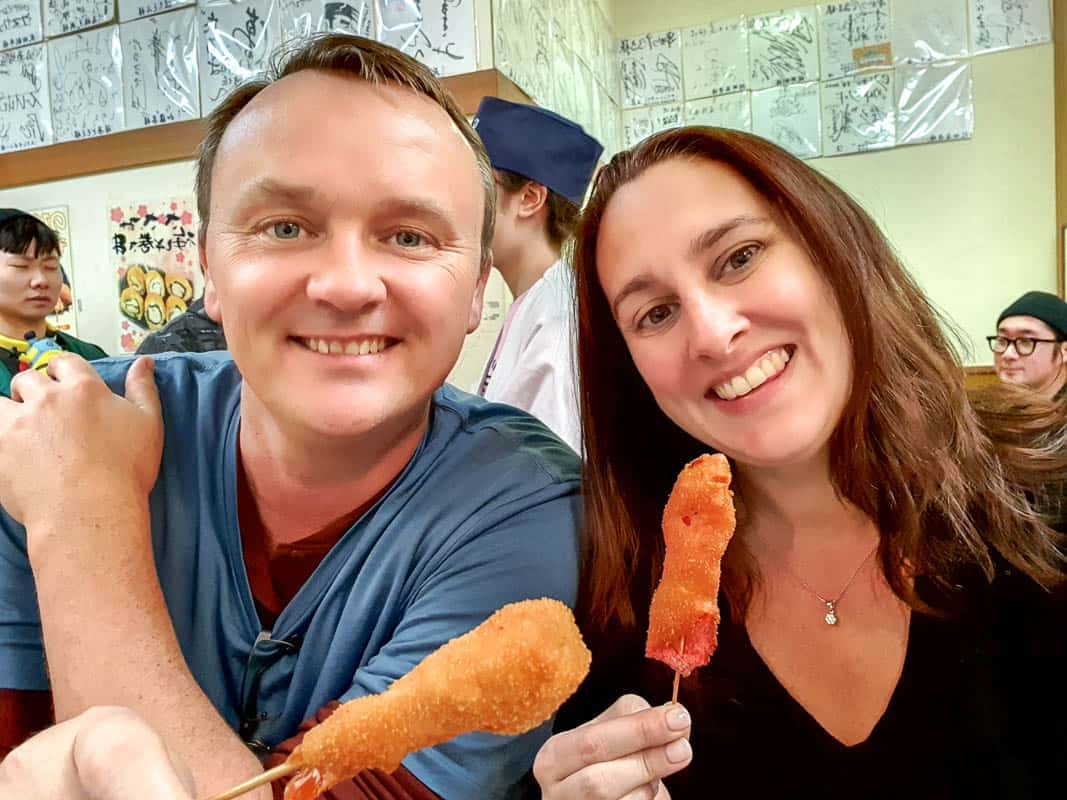
Only Have A Week In Japan? Check Out Our 7 Day Japan Itinerary
Help With Planning Your Japan Two Week Itinerary
Luggage : We used our Eagle Creek Load Warrior luggage for this trip. I always recommend packing light and if using the trains in Japan this is particularly important. Escalators and elevators are not readily available. And, most hotel rooms in Japan are pretty small. It can be hard to find space for large luggage! Even for a 2 week trip in Japan, it is possible to do laundry at least once or twice during your trip so it’s possible to pack light.
Rental cars : If you decide to rent a car in Japan, we recommend RentalCars.com . They compare prices at the top rental car companies to get you the best deal.
Rail Passes : Train travel is really efficient in Japan, particularly between our recommended cities. Check out the 14 Day Japan Rail Pass to help get you around. A rail pass must be purchased ahead of time before your arrival in Japan and is best purchased from Japan Rail Pass.
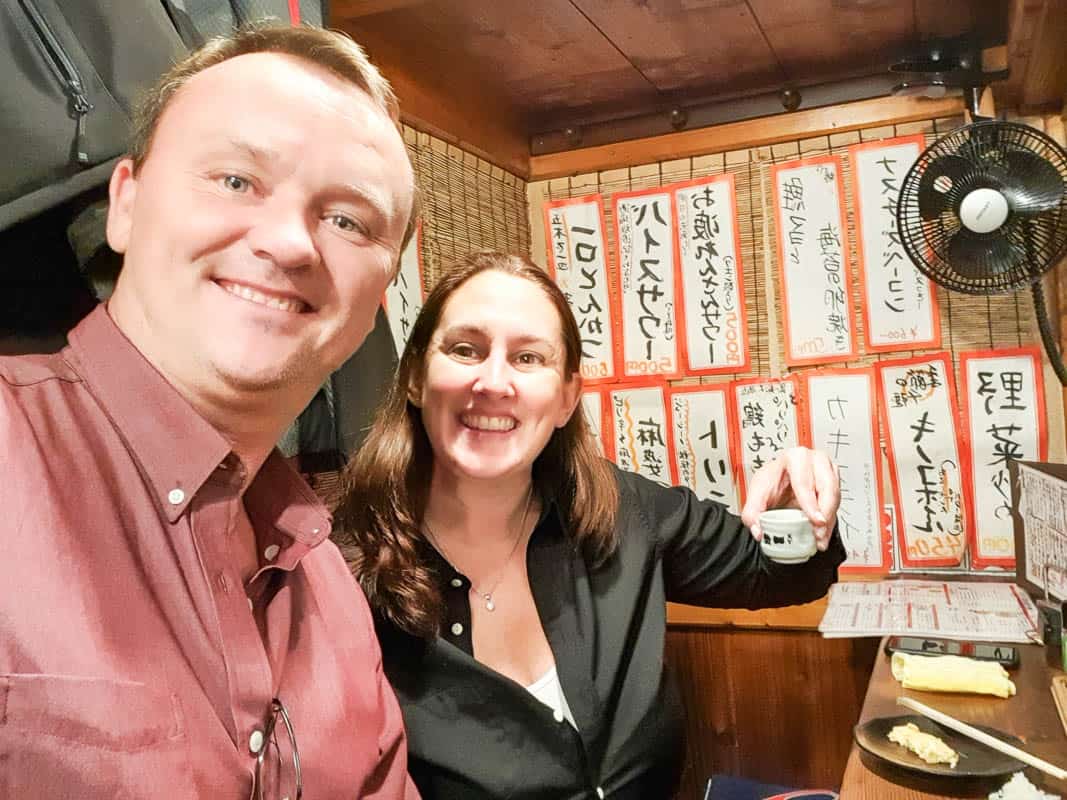
Eating at an izakaya in Kyoto
Best Japan Destinations For Food Travelers
Tokyo – Many travelers arrive or depart from Tokyo so it’s understandably on everyone’s itinerary. It’s a big city, with bright lights, and Japan to the extreme.
Osaka – The destination for food travelers in Japan. Known as Japan’s kitchen, Osaka is known for “kuidaore,” which essentially translates to eat until you drop or eat until you bankrupt yourself. This is why it’s one of our favorite cities.
Kyoto – The city of culture and temples, Kyoto is also one of the top sake producing regions in the country.
Wakayama – Just south of Osaka and Kyoto, Wakayama is often overlooked by travelers. It’s an easy addition to any Japan trip itinerary. It’s a destination with a focus on fresh fish and seafood, ramen, and Buddhist Monastery lodgings.
Kobe – The home of world-famous Kobe beef and easily visited as a day trip from Osaka or Kyoto.
Sapporo – The great white north of Japan and the city that is one of the snowiest in the world. It’s also home to its own unique cuisine unlike elsewhere in Japan.
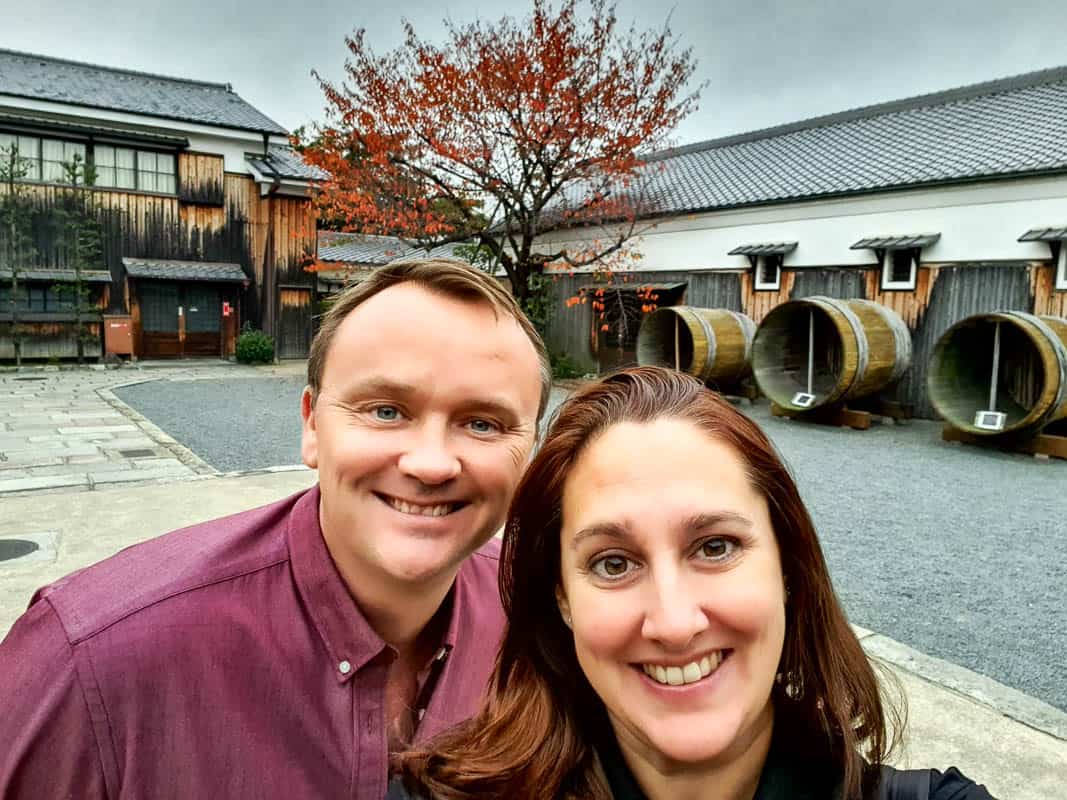
Visiting a sake brewery in Kyoto
Guided Tours Of Japan
We will provide tips on how to plan your own Japan 2 week itinerary, but I understand that Japan can be difficult to manage on your own. We have some recommendations for guided tours that included between 12 and 14 day itineraries.
Intrepid Travel offers a 12 day Real Food Adventure In Japan . It hits some of our favorite food cities in the Kansai region of Japan. That includes Osaka, Kyoto, and Kyosan in Wakayama. Along the way, travelers learn to make sushi , eat street food, and stay the night in a Buddhist monastery. These are all food experiences we’ve had in Japan and would totally recommend. We took an Intrepid Real Food Adventure in Morocco and learned a lot about the food culture. Learn more about Intrepid’s Japan tour .
As an alternative, G Adventures offers a small group tour for 14 days in Japan that departs from and returns to Tokyo. The Discover Japan Tour visits Tokyo, Kyoto, Hiroshima, and other interesting cities. There is more of a focus on culture and history than the Intrepid Tour but includes interesting food experiences. This includes visiting a sake brewery and dining in kaiseki cuisine in Kyoto. Learn more about the G Adventures Discover Japan Tour .

Eating ramen in Sapporo in Winter
Tips For Traveling to Japan For The First Time
Planning a trip to Japan for the first time can be entirely intimidating. That’s why booking a group tour can help. But, there are ways to plan an independent journey as well. We have a few key tips for first-timers to help make things easier.
Picture Menus Are Your Friend
When it comes to selecting restaurants in most touristy cities, we always recommend avoiding places with picture menus. This advice goes out the door in Japan. Many restaurants have picture menus, for both travelers and locals. The picture menus are your friend.
Almost every place we ate in Japan included picture menus with English descriptions. A few did not. Where they didn’t we relied on Google Translate to take pictures of the menu or to do an instant translation. But, this only works when you are online.
Japan Travel Guide Pro Tip
We use KeepGo for international data. It’s an international sim card that works in over 120 countries without setting up service in each country you visit. It doesn’t make a difference what kind of mobile service you have at home. You just register the sim before leaving home. It works on arrival in Japan. We had 4G access in Japan with KeepGo .
Japan Is A Cash-Based Society
Cash is still king in Japan. We were able to charge some meals, but most of the time we paid cash. This is particularly true in smaller places. We used ATMs to withdraw cash as we went. ATMs are not as easily found as in other cities. Look for them in the convenience stores like 7-11, Lawson, or Family Mart.
Don’t Try To Fit Too Much Into Your Itinerary
Imagine someone trying to see all of the US in a two week trip, impossible, right? Japan may be a smaller country, but there is so much to see and do. Even within a single city, there are loads of great activities, neighborhoods to explore, and food to eat. Don’t rush it and don’t try to cram everything into a short amount of time.
Our recommendations in this post make a great first time in Japan itinerary. In two weeks you can experience a lot of Japan, but I wouldn’t recommend visiting more than 4 cities. The movement in between, even with high speed trains, can be exhausting.
Also, consider basing yourself in a city like Osaka and taking day trips to Kyoto, Koyasan, Nara, and Kobe, to see a lot without the constant checking-in and checking-out of hotels and packing and repacking. You can access each of these cities in less than an hour from Osaka.

Visiting Temples In Wakayama
Food And Drink Experiences In Japan
There are loads of interesting and unique things to do in Japan. Some of these experiences relate to food and drink and others focus on culture and history. This is a great place to start your own Japan trip planner for how to spend 2 weeks in Japan.
- Visit a Robot Restaurant in Tokyo for one of the most unique dining experiences in the world
- Exploring traditional local markets including Kuromon in Osaka and Nishiki Market in Kyoto
- Tracking down the top street food in Dotonbori , Osaka’s food street
- Book a food tour in Osaka or a Kyoto cooking class to learn more about Japanese food culture on a half-day or full-day tour
- Eat some of the best Japanese sushi of your life, by visiting a conveyor belt sushi restaurant or a traditional sushi-ya
- Track down the best bowl of ramen in one of the official or unofficial ramen streets.
- Go Japanese craft beer bar hopping and learn about Japanese craft beer trends
- Enjoy a kaiseki meal at a traditional Japanese ryokan
- Spend the night at a Buddhist monastery and learn about shojin ryori, Buddhist vegetarian cuisine
- Eat some of the best beef in the world – Kobe beef
- Tour a Japanese sake brewery and learn how to order sake
- Spend the evening at an izakaya, a Japanese tavern, toasting over local beer and whiskey highballs
- Dine on Japanese giant crab and local seafood in the great white north of Japan
- Tour the famous Sapporo Brewery and dine on Genghis Khan

Eating sushi at a market in Osaka
How To Spend 14 Days In Japan When You Love Food
If planning your own self-guided tour of Japan, here are our recommended destinations. With a full two weeks in Japan, you can see a lot. There are two primary options here. We recommend about a half dozen cities to visit. It’s possible to visit each of them, spending approximately two nights in each.
Or, I would recommend staying in only about three cities and doing day trips. For example, you can stay in Tokyo, Osaka, and Sapporo and manage to have all of the experiences mentioned in this post over two weeks.
For each city, I recommend some of the top attractions or experiences, with a focus on food and drink. I also provide recommendations on what and where to eat and some recommended hotels. There are also links to some of our other posts for more information on some of these activities and travel tips.

Day 1-3 Tokyo
Most people start or end their trip to Japan in Tokyo. We prefer the smaller cities for more unique experiences and recommend spending more time there. At least give yourself enough time in Tokyo to beat the jet lag .
Top Attractions In Tokyo
Definitely check out the Shibuya district, one of the most iconic neighborhoods in Tokyo. If you’ve seen photos of Tokyo with loads of people crossing at a major intersection with neon lights and skyscrapers in the background – that’s Shibuya. It’s supposedly the busiest pedestrian crosswalk in the world. Stop for a katsu curry at Katsuya or hit one of the ramen or soba shops.
At night, head to the Shinjuku district, perhaps for a little karaoke and nightlife. Shinjuku is where the neon lights explode at night. There’s theater, food, bars, and plenty of people watching.
There are also two well-known bar and restaurant alleys in Shinjuku that are must-visits: Golden Gai and Memory Lane. It’s almost like stepping back in time considering much of Tokyo is covered in high-rises. Within this area is also Harajuku. This is where young people like to show off their fashion and old people like me are left to wonder why.
For a bit of culture, visit the Imperia l Palace or at least wander the gardens. Or, check out the art museums and galleries in the Roppongi neighborhood. This is also where the Tokyo Tower can provide you with a birds-eye view of the city.
Tours And Tickets For Tokyo
There are a few tours and attractions that we recommend booking ahead of time. Grab tickets for the Tokyo Robot Restaurant , one of the most popular and unique attractions in Tokyo. To make the most of your time in Tokyo, book a food tour. This Japanese Food And Drink Tour includes a tour of the world-famous Tsukiji Fish Market.
Where To Eat In Tokyo
In Golden Gai and Memory Lane sniff out late-night ramen and plenty of yakitori bars. In addition to Golden Gai and Memory Lane, there are a few other areas where you are guaranteed to eat well in Tokyo. Be sure to add a visit to Ginza for Michelin Star dining, including some of the most famous sushi restaurants in the world. Look for monjayaki in the Tsukishima district for Tokyo’s answer to okonomiyaki.
Where To Stay In Tokyo
We stayed at the Sheraton Miyako during our visit to Tokyo, but there are other options as well depending on your budget.
Park Hyatt Tokyo : One of the most luxurious hotels in the city and known for its role in the movie Lost in Translation. Check for rates here .
Pullman Tokyo Tamachi : A contemporary option in the center of Tokyo with a sun terrace. Check for rates here .
Nine Hours Shinjuku : On more of a budget, or looking for a uniquely Japanese experience, this capsule hotel is the perfect option. It’s also in the nightlife center of the city. Check for rates here .

Day 4-5 Osaka
I’m amazed to see how many sample Japan two week itineraries skip Osaka altogether. Sure, it doesn’t have the same concentration of temples and palaces as Tokyo or Kyoto, but you can only see so many temples on a trip before you get “templed out.”
Osaka is one of the best cities to visit if you love food and drink! From Tokyo, use the JR Rail Pass to hop the Shinkansen high-speed train to Osaka, Japan’s kitchen.
Top Attractions In Osaka
All of the top main attractions in Osaka are located within the city center and are accessible by train. Take a walk through the gardens of Osaka Castle or catch the view from a boat tour of the Dotonbori Canal. Explore Kuromon Market for street eats and hit Dotonbori, Osaka’s famous food street at night. At night, just wander through one of the many shopping and eating districts, including Namba, and Shinsaibashi.
Tours And Tickets For Osaka
If you want to make the most of your time in Osaka and want to experience all the main sights, pick up the Osaka Amazing Pass. It offers free admission to loads of different sites including Osaka Castle, plus offers unlimited train and bus rides as well.
Osaka is also the perfect place to take a food tour or cooking class. See our recommendations for the Best Food Tours In Osaka .
Or book tickets for Gotta. Gotta is pure Japanese-style entertainment. It’s a Japanese musical review show, which tells the story of the Dotonbori area through food and legend. Buy tickets ahead of time here . They offer three shows a day, with the last show being at 3:00 pm. The show is only 40 minutes, so it’s not a big time commitment. It’s just something quirky and unique to do in Dotonbori.
Where And What To Eat In Osaka
Between traditional Japanese dishes and Osakan specialties, there is no shortage of foods to eat in Osaka. From street food to craft beer, the city has it all. One of our favorite things to do in Osaka is to visit Daruma for kushikatsu, which is fried stuff on a stick.
Start any day eating in Dotonbori, near the canal. Then head north down the Shinsaibashi shopping street. At the top, in the Chuo Ward and near the Honmachi subway station, there are loads of great, non-touristy restaurants. On another night, head south from Dotonbori into the Namba area for plenty of standing bars and yakitori spots.
Check out these posts for more details and where and what to eat and drink in Osaka.
Osaka Food Guide – What To Eat In Osaka Japan
Dotonbori Food Guide – 15+ Must-Eat Dishes In Dotonbori Osaka
Osaka Craft Beer Guide – Drinking The Best Craft Beer In Osaka
Where To Stay In Osaka
When we visit Osaka we tend to stay a while and normally rent an Airbnb apartment. We’ve also stayed at the Sheraton Miyako . Here are some other recommended hotels in Osaka. If short on time, we recommend staying near Namba or in an adjacent neighborhood so that you are centrally located to all of the best foods.
Swissotel Nankai Osaka : Luxury, 5-star hotel, with views over the city. It’s located above the Namba station making it super convenient. Check current rates here .
Hotel Nikko Osaka : The Hotel Nikko is located in the Shinsaibashi shopping area and near the pedestrian shopping arcade that leads to Dotonbori. We’ve stayed near this neighborhood before and there are some great bars and restaurants nearby. Check current rates here .
Hotel Ichiei : For a more ryokan style experience, Hotel Ichiei is also near Namba Station and offers tatami style rooms. Check current rates here .
How Many Days In Osaka – Pro Tip
This is a question we often get. For any of our recommended Japan destinations, it’s up to you how much time you spend in each city. People often overlook Osaka, though, in favor of Kyoto. Kyoto is famous for its temples. Osaka is famous for its food and nightlife. We recommend spending more time in Osaka than in Kyoto if you love eating. Or, base yourself in Osaka for five or seven nights and visit Kyoto, Kobe, and even Nara from there. See the sites but enjoy the Osaka nightlife .
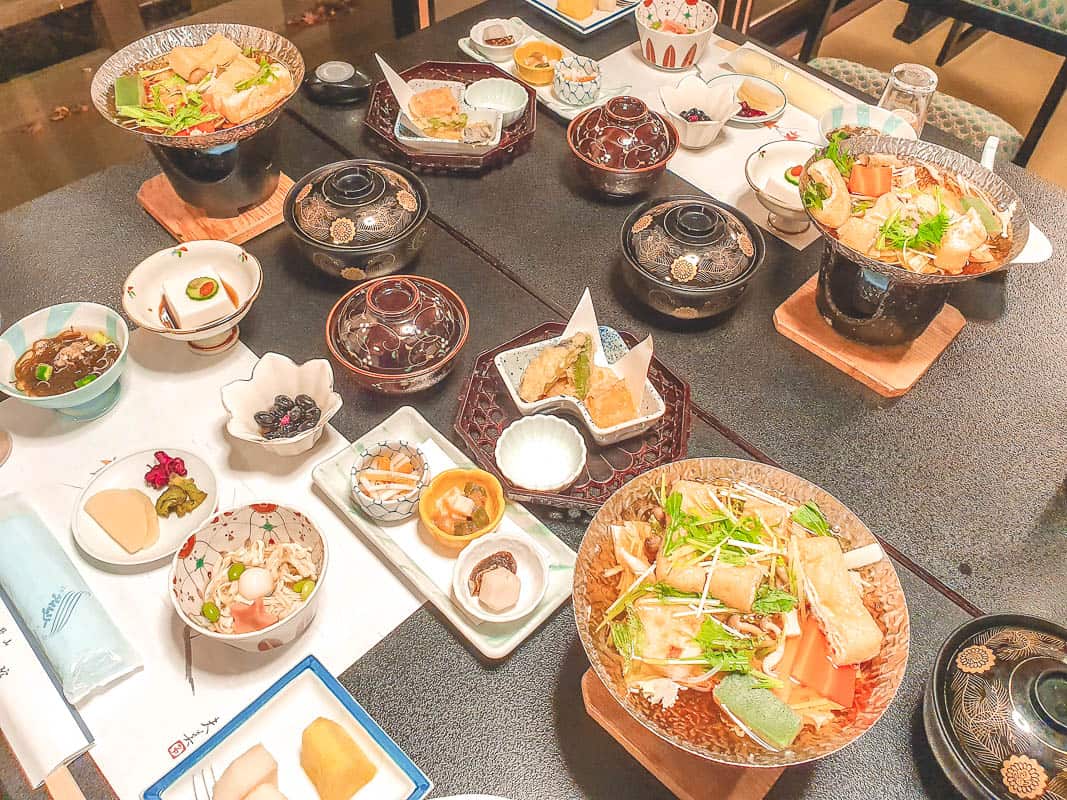
Day 6 Koyasan, Wakayama
If you can fit an overnight into your 14 day itinerary that will offer a totally unique experience, this is it. The Kii Peninsula in Kansai includes Kyoto, Osaka, and Wakayama.
Across the Peninsula are a series of Sacred Sites and Pilgrimage Routes, much like the Camino de Santiago in Spain. UNESCO recognized the region as a World Heritage Site. This makes Wakayama a perfect spot to spend the day hiking or exploring temples.
Wakayama is also a great destination for food travelers too. Koyosan is the center of Buddhism in Japan and is located within Wakayama. There are over 100 temples in Koyasan, about half of which provide temple lodging. One of the most interesting food experiences includes staying at a temple lodge in order to try their famous Buddhist Vegetarian Cuisine, known as Shojin Ryori.
Planning A Trip To Koyasan
You can train from either Osaka or Kyoto to Koyasan using the Japan Rail Pass. Once there, spend the afternoon exploring some of the famous temples. Also, take a walk through Okunoin, a famous Buddhis Cemetery. There are over 200,000 gravestones. It’s a beautiful and peaceful place to explore. (Please don’t take photos within the cemetery). There are a handful of restaurants that are known for vegetarian cuisine, which was even enough to fill Eric’s belly.
Spending The Night In Koyasan
Spending a night in the Mount Koya area is almost like an all-inclusive stay. Book at one of the temple lodgings. These are mostly simple places to stay for the night, normally with tatami-style rooms with futons on the ground. A shojin ryori vegetarian dinner is included. They do serve beer and sake, but we used it as a night to detox.
After dinner, head back to the temples to see them lit up at night. It’s quite peaceful. Then, it is time for bathing. Some of the temple lodges have private, western-style bathrooms. Others offer traditional Japanese bathing, which is sex separated, public, and nude. That alone is an experience.
It’s an early-to-bed experience. There is the option of observing a dawn ritual where the monks offer a service to practicing Buddhists. We stayed in a traditional lodge where we were the only foreigners. The entire proceeding was in a combination of Japanese and Sanskrit. As much as we didn’t understand a word, observing was fascinating.
Where To Stay In Koyasan
We recommend Jokiin , which offers all of the above experiences. They have a traditional Japanese public bath, but also offer some rooms with a private bath. All rooms are tatami-style, with futons on the floor. Book here .

Day 7-8 Kobe
Kobe City is located in the west end of central Japan. It’s a port town and hosts the 6th largest population in Japan. What most people know about Kobe is its namesake beef. It is also one of the top sake producers in the country as well. This makes it an interesting city to add to your two week itinerary.
Top Attractions In Kobe
Did you know that the Nada-Gogo, or the Five Regions of Nada, produces one-quarter of the sake in Japan. The Nada region includes Kobe, which makes Kobe the perfect place to learn about sake. They started producing sake in Nada over seven centuries ago. Try visiting the Kobe Shu-Shin-Kan Brewery, which is on the train line between Osaka and Kobe.
What To Eat In Kobe
Kobe beef is unique to Japan. The beef comes from a particular breed of cattle called Tajima-gyu. The cattle must be born and raised in the Hyogo Prefecture to be considered Kobe beef.
Eating Kobe beef in Japan is a bit of a ritual. Normally you sit at a counter and order the beef by weight and variety. The chef will often show it to you, sort of for approval, but really so that you can look and confirm the quality. The beef is cooked on a flat top grill, to rare or medium rare temperature. Organize your Kobe experience ahead of time, whether you stay in Kobe or visit as a day trip. Learn more here .

Where To Stay In Kobe
Check out the ANA Crown Plaza Kobe , which is part of the IHG hotel group. It’s close to the train station making it easy to explore the city and the surrounding area. Check rates here .

Eating Kitsune Udon In Kyoto
Day 8-10 Kyoto
One of the most popular cities for travelers to Japan, Kyoto is one of the best places to learn about Japanese culture. Kyoto means “capital city” because it once was the capital of Japan before it was moved to Tokyo. We tend to prefer the culinary scene in Osaka more, but there is still loads of good food in Kyoto.
Top Attractions In Kyoto
There are 17 UNESCO World Heritage Sites in Kyoto alone. There are hundreds of Shinto Shrines, loads of Buddhist temples, and Japanese gardens. Check out the Imperial Palace , which is free for travelers to wander through and take in all of the splendor of an ancient way of life in Japan.
Gion is one of the most popular neighborhoods to visit. It’s known for its Geiko, or geisha, culture. It’s one of the most well-preserved parts of the city with ancient houses and adorable alleyways. It is also one of the most touristy parts of the city, so be prepared.
Fushimi Inari-taisha S hrine is another popular destination and is just a short ride from Kyoto Station by train. After visiting the temples continue a little further south to the Fushimi Sake District, the sake producing area of Kyoto. There is a brewery tour and plenty of shops selling sake and offering tastings. It makes a great afternoon out of the center of Kyoto.
Tours And Tickets For Kyoto
Looking for the perfect Japanese Instagrammable moment? Book a Kimono rental for a day and then head to the temples or the narrow alleys of Gion for photos. Book a rental here .
If you love sake and want to learn more about it, check out this Sake Brewery Tour and Tasting .
Or, book an evening Food Tour in Gion and Pontchoco . See all of our recommended Kyoto Food Tours here.
What To Eat And Drink In Kyoto
Kyoto is known for its kaiseki and Buddhist vegetarian cuisine. There is also a great ramen scene. For food travelers, there’s Nishiki Market and the surrounding neighborhoods and alleyways near Shoji Jori, the main shopping street.
At night, head to Pontocho Alley, which runs along the river, west of Gion, for some of the best restaurants in the city. For someone on a budget, check out Kyoto Ramen Alley, which is actually on the 10th floor of the Kyoto train station.
Check out these related posts :
Kyoto Food Guide – What To Eat In Kyoto
How To Find The Best Ramen In Kyoto
Where To Stay In Kyoto
Like Osaka, Kyoto is also pretty easy to travel around. We stayed at the Westin Miyako Kyoto , which is lovely, with views over the mountains and the city. We’ve also stayed at a very simple guest house near the Imperial Palace. Here are some other recommended hotels in Kyoto.
Luxury Hotel Sowaka : Located at the southern edge of Gion, this is the epitome of Japanese luxury, with well-appointed rooms in a ryokan style. Check the best rates here .
Park Hyatt Kyoto : For luxury accommodations of a more western standard, Park Hyatt Kyoto is one of the top hotels in the city. Check the best rates here .
Mimaru Kyoto Horikawarokkaku : A four-star hotel in the center of some of the best eating in Kyoto and close to the Nishiki Market. Check the best rates here .
Help With Transit
If Kyoto is your last destination, then it is possible to fly out of Kansai Airport. Kansai is actually closer to Osaka, but still easy to access by train from Kyoto. Or, you can book a limousine bus from Kyoto here .
Also, consider picking up a transit pass for Kyoto. This pass can be purchased for one or two days and can be used in both Kyoto and Osaka. Learn more here .

Day Trips From Osaka (Or Kyoto)
We are not huge fans of checking in and out of hotels every couple of days. It gets exhausting. It also gets in the way of our eating. One way to be more efficient when planning a Japan travel itinerary for 14 days is to pick either Osaka or Kyoto as a home base and to see several sites and cities.
For food travelers, we definitely recommend Osaka as a home base. You can take a day trip to Kyoto to visit Gion, Fushimi Inari-taisha Shrine, and other spots all in one day. The fast train takes 14 minutes between the cities. The cheaper rapid train takes 24 minutes. Both are included in the Japan Rail Pass.
You can be back to Osaka in order to take advantage of the nightlife there. Accommodations in Osaka also tend to be less expensive.
Other Side Trips
Regardless of which city you base yourself in, you can spend four, five, or even six nights over a two week stay in Japan in either city and see a lot. Here are a few of the cities you can explore as a day trip from Osaka or Kyoto. If you don’t want to spend two nights in Kobe, it is also possible to do as a day trip from either Osaka or Kyoto.
Nara is located just between Osaka and Kyoto. There are a good number of ancient temples, but it is most known for the deer that roam the city. It’s also home to Tōdai-j, a Buddhist temple complex with one of the largest Buddha statues in Japan.
Another side trip is to Himeji Castle and then to Miyajima. Miyajima, or Itsukushima, is a famous temple located on an island in Hiroshima Bay. There is the famous Great Torii Gate, which is an orange gate surrounded by water.

Eating ramen in Sapporo in Hokkaido
Day 11-14 Sapporo
We just made our first trip to Sapporo and it was in the winter. Yes, it snowed. Even though we don’t like the cold, we loved our time in Sapporo and would definitely recommend adding to a 14 day Japan itinerary. Yes, you need to take a domestic flight there, but you can also book international flights from Sapporo to head home.
If heading to Sapporo in winter , be prepared for cold and snow. But that also means fun snow sports and skiing. The summers are warm, but not as hot as down south. The most important thing, the Hokkaido region is entirely unique within Japan and worth a visit.
Top Attractions In Sapporo
Many of the top things to do in Sapporo are located within the city center. This includes all of the best places to eat. It’s possible to walk to many of them. If heading a little further afield, the train is easily accessible. Just at the edge of the city is a town filled with onsen , the traditional Japanese hot springs. Learn more here .
Tours And Tickets For Sapporo
There are a couple of interesting activities for food travelers to Sapporo. First, check out the Sapporo Beer Factory and the Beer Garden. After a tour of the factory, enjoy a meal of the famous Genghis Khan in the garden. Learn more here . If looking to try Hokkaido’s world-famous crab, book a crab eating experience in Sapporo.
What To Eat And Drink In Sapporo
The main reason why we think Sapporo is worth a flight up north is that the food is so different and so great! Hokkaido is known for crab and other seafood. There are also a handful of dishes that are unique to the region. This includes ramen made with corn and butter, Genghis Khan, which is a lamb BBQ, and soup curry. Read more about all the great food in Sapporo here:
Sapporo Food Guide – What To Eat In Sapporo Japan
Finding The Best Ramen In Sapporo – Ramen Yokocho And More
Where To Stay In Sapporo
I recommend staying in the Susukino neighborhood of Sapporo. We stayed at the Mercure Sapporo in Susukino and couldn’t have been happier with our decision. The Mercure Sapporo is a 15-story contemporary high-rise hotel with French influences and is part of the Accor family of hotels.
The Mercure Sapporo is close to all of the best places to eat in Sapporo. It’s right in the heart of Susukino and only a few blocks away from ramen alley and Nijo Market. This was perfect for us, and really anyone who visits Sapporo. You can eat all of the best foods in Sapporo without traveling more than a few blocks from the hotel.

Hokkaido in winter
When Is The Best Time To Visit Japan
Japan is a year-round destination. Being a long country, there are a variety of climates. In the north, in Hokkaido, you have some of the top ski destinations in the winter. In the south, in Okinawa, there is a more tropical climate where it is warm in the winter.
This 14 day Japan itinerary focuses on Tokyo and the Kansai region, in the center of the country. But it also includes Hokkaido in the north. In the center of the country, expect warm summers and cold winters.
Top tourist sites in the summer can be crowded and hotels are more expensive. Winter is relatively mild, even when it snows. Tourist sites are less crowded and hotels are less expensive. The shoulder seasons of spring and fall are probably the best times to visit Japan, with one major exception. Cherry blossom season is in the spring, normally in April, and can be beautiful, but is considered the high season.
Winter In Japan
We’ve been to Japan twice when it was snowing and we don’t like the cold. But, it can be peaceful and beautiful visiting Japan in winter.
They do get some snow in the center of the country, but we’ve visited in Japan in both autumn and winter and found it warmer than expected for several days. The temperatures can change dramatically where it is warm one day and cold the next.
Hokkaido, in the north, has cooler summers but the snowiest winters in the world. If you love the cold and snow, definitely consider Hokkaido. If traveling to Japan in the winter, and you don’t like the snow, perhaps stay longer in the center of the country.
To better understand what it’s like to travel in Japan in the winter, check out these posts:
Top Things To Do In Sapporo In Winter
Getting To Japan
Many airlines fly directly to Japan. There are two airports in Tokyo. Narita is the largest but is farther from the city. Haneda is smaller, and closer to the city, but offers fewer international flights. Kansai Airport serves both Osaka and Kyoto. All of these airports are accessible by bus and train. Sapporo also has an international airport with plenty of flights.
There are two primary Japanese airlines that service these airports: ANA (All Nippon) and Japan Airlines (JAL). We’ve flown them both and they are reputable airlines. Other international airlines also service Japan.
Because train travel is so easy in Japan, it might help and it might save time, to fly into Tokyo and out of Kansai in Osaka or Sapporo in Hokkaido. This will help maximize your time on the ground, particularly if you are only limited to a two week trip.
Choosing An Airport In Japan Pro Tip
Sapporo only has one airport. Tokyo has two airports (NRT and HAN). The area around Osaka and Kyoto is also served by two airports (KIX and ITM). Just be sure to pay attention to which one you are booking. In each case, one is farther out from the city than the other. It’s most important when you are transferring back to the airport so you choose the right one. Trust us. We chose the wrong one in Osaka! Luckily we still made our flight in time.

How to Get Around in Japan
We’ve never rented a car in Japan. We’ve never found a reason to, particularly with this itinerary. There is so much to do, see, and eat within the cities or during day trips from the big cities.
Really, the best way to get around in Japan is by rail. Japan Rail offers a few different rail passes for either 7, 14, or 21 consecutive days. The rail pass is valid on all Japan Rail trains, including the high-speed trains (Shinkansen) between Tokyo, Kyoto, and Osaka.
The most important thing about the Japan Rail Pass is that you much be a resident of a country other than Japan. And you must purchase the rail pass before arriving in the country. They will actually mail you a rail pass so be sure to purchase it early.
If heading to Sapporo, it’s best to fly. Both ANA and JAL fly between Kansai near Osaka and Sapporo. It’s not all that expensive if you book ahead.
Learn more about Japanese food in our post about the Best Japanese Snacks To Try .
FAQs – PLANNING A JAPAN 14 DAY ITINERARY
This is a question we get about almost every destination. If you are American it is hard NOT to tip because it is so customary and even expected at restaurants and bars. Tipping is not customary in Japan. It can even actually be considered inconsiderate to leave a tip. It’s just better not to. In this case, it’s best to abide by the local culture and norms.
This is a hard question to answer because we understand a lot of people, particularly Americans, don’t have a lot of vacation time. Being able to spend a full two weeks in Japan gives you an opportunity to really experience the country. If you only have a week, see this post on how to make the most of your time.
It is no secret that Japan is an expensive country, but there are ways to spend money. It’s certainly possible to find accommodations is most cities for less than $100 a night. Meals can be expensive, but it is also possible to eat many meals for about $10-15 a person, even sushi! It is possible for two people to travel to Japan for between $100-150 a person and travel quite well.
Despite being a relatively small country, Japan is a highly diverse country. This makes it a year-round destination. In Winter, there’s skiing around Sapporo. Okinawa and the southern islands are great for a summer beach getaway. The Spring and Fall offer nature lovers stunning natural beauty.
Amber Hoffman
Amber Hoffman, food and travel writer behind With Husband In Tow, is a recovering attorney and professional eater, with a passion for finding new food and drink destinations. She lives with her husband, Eric, in Girona, Catalonia, Spain. Together over the last 20 years, they have traveled to over 70 countries. Amber is the author of the Food Traveler’s Guide to Emilia Romagna. She regularly lectures on social media marketing to travel professionals throughout Europe.
Leave a Reply Cancel reply
Your email address will not be published. Required fields are marked *
Save my name, email, and website in this browser for the next time I comment.
For a limited time, book your 2020, 2021 & 2022 group tour packages with no deposit required!!!

- Custom Groups Custom Groups Overview Student Groups MICE Special Interest Groups
- About Japan About Japan Destinations Attractions Must See & Do
- About Us About Us Contact us Testimonials Terms & Conditions Travel Agent Services Disclaimer Site Map
- News Press Releases Blog Media
- Your Trip Get Started How to make a reservation Travel Tip FAQs Inquiries
Last Name *
Japan Food Tour View Tours
Japan Deluxe Tours
Visit the must see sites of japan with group sizes ranging from 12 to 35 people..
These tours are great for first time visitors to Japan looking for comfortable accommodation with all entrance fees and most meals included. Our Japan Deluxe Tours are accomodated with professional tour guides, fluent in both Japanese and English, to ensure an educational and valuable visit. Air-conditoned, private coaches are also included, so you can enjoy a comfortable and hassle-free time in Japan. Our tours range from 7 to 21 days, to various regions of Japan.
Deluxe-Plus Small Group Tours
Experience the culture of japan at a slower pace with groups of 10 to 18 people. (smaller group departure available).
These tours combine enrichment, enjoyment, and education with time to truly absorb and appreciate your surroundings. Our Deluxe-Plus small group tours are created to cater to those who are interested in having a deeper understanding of Japan's culture. You will have the opportunity to participate in culturally rich activities and visit destinations only locals may know. Experience luxurious hotels and travel at a leisurely pace when you book a Deluxe-Plus small group tour.
Budget Group Tours
Our budget tours are designed for our guests who are on a limited budget..
Explore the must-see sights and enjoy the hassle-free trip to Japan at an affordable price. Our most cost-effective way to see the highlights of Japan while staying in budget-friendly accommodations. If you would like to have a quick stop to sample the must-see sights of Japan, or plan to explore Japan on your own but would like to take a short trip to learn about Japan before your self-guided journeys. These are the tours for you.
Active Small Group Tours
Travel japan more flexibly in groups of 6 to 13 people using public transportation..
Explore Japan off the beaten path via Japanese public transportation, walking, hiking, cycling and more. Take more time to enjoy local experiences and picturesque landscape. Our Active Small Group Tours combine the best of cultural destinations with off-the-beaten-path via Japanese public transportation, Discover the country of Japan the way the locals do and see Japan from a different angle. A focus on getting away from the crowds and into the real Japan, see the diversity of Japan’s countryside unfold before your eyes.
Group Tour | Active
Japan food tour.
Tokyo - Kanazawa - Gokayama - Shirakawa-go - Takayama - Hida Furukawa - Awaji Island - Kyoto - Uji
Departure Months:
All Japan Tours takes you on a culinary journey like no other. Experience famous locations in Kansai, such as the ancient imperial capital Kyoto, as well as hidden rural villages and the unique culture of Awaji Island located in Hyogo Prefecture, where culinary traditions have been passed down from generation to generation. Our journey will include searching for wild ingredients, harvesting the crops of the land, and cooking together alongside members of local communities. Food culture pla... View More
All Japan Tours takes you on a culinary journey like no other. Experience famous locations in Kansai, such as the ancient imperial capital Kyoto, as well as hidden rural villages and the unique culture of Awaji Island located in Hyogo Prefecture, where culinary traditions have been passed down from generation to generation. Our journey will include searching for wild ingredients, harvesting the crops of the land, and cooking together alongside members of local communities. Food culture plays a big role in Japanese society, as it is very closely related to festivals, rituals, and displays the way of life in each region. Our adventure starts in Tokyo, where we will travel by train to a local food market in Kanazawa. Here, we will be able to pick ingredients from the market, then later cook them with a professional chef. We will then travel to Gokayama to hunt for plants and vegetables native to the area, which we will later cook with the locals. Next we travel to Shirakawa-go, a World Heritage Site, and Takayama, where we learn about Okudo-san (earth oven) cooking and Furukawa’s specialty “Miso Senbei” crackers. We will also enjoy a kaiseki dinner, which is a traditional multi-course Japanese meal. Departing the mountainous region brings us to Sakai- City in Osaka, an area made famous by its steelwork. Learn about the art of Japanese knives and the forges that make them. Once we arrive on Awaji Island, we will experience a chef's artistry of "Foodscape", where seasonal foods are made to look like landscapes. From the island, we head to Uji where we learn more about Japan's unique tea culture and the origin of "sencha" tea. Our tour ends in Kyoto where we experience making tofu and participate in a traditional tea ceremony before saying goodbye at the farewell dinner. For those that admire Japanese cuisine and culture, this tour is a wonderful option. With exclusive experiences, such as tofu making and cooking with the locals, you will have insight into the unique cuisine of Japan. Travelling from mountain villages to fishing ports, staying in rural thatched-roof houses and in the dazzling cities, experience the food and the culture, awaken your senses, and share unforgettable moments with the people you’ll meet on this journey.

Tour Highlights
- Visit Kanazawa's local food market, which has attracted visitors for almost 300 years.
- Learn the art of earth-oven cooking with a local in Hida-Furukawa.
- Visit Awaji island to learn about its seafood culture and enjoy a beach lunch with a local food-designer chef.
- Hunt for wild vegetables (Sansai) with an expert and learn traditional cooking methods with locals.
- Travel to 'Kyoto's Kitchen', Nishiki Market, where you can buy snacks and local foods.
- Enjoy an exclusive and traditional Japanese Kaiseki meal.
- Participate in a traditional green tea ceremony.
- Witness the process and try your hand at making Kyoto-style Tofu.
Spring (Mar - May) (119)
Summer (Jun - Aug) (48)
Autumn (Sep - Nov) (95)
Winter (Dec - Feb) (21)
May 2024 (1)
September 2024 (1)
October 2024 (1)
Deluxe (222)
Deluxe-Plus (21)
Ultra-Deluxe (9)
Classic Tour (31)
Cherry Blossoms (73)
Autumn Leaves (41)
Festival (69)
Special Interest (94)
less than 9 nights (100)
9-14 nights (158)
15 nights + (25)
Hokkaido (49)
Tohoku (26)
Kanto (238)
Chubu (237)
Kansai (238)
Chugoku (110)
Shikoku (96)
Kyushu (32)
Okinawa (0)
Kyoto Aoi Festival (9)
Kawazu Cherry Blossoms (4)
Lavenders (11)
Snow Monkeys (52)
Shirakawago (85)
Gion Summer Festival (4)
Awa Odori Dance Festival (4)
Sapporo Snow Festival (5)
Otaru Snow Light Path (1)
Ice Breaker Cruise (5)
Wakasagi Smelt Fishing (5)
Shiretoko Nature Cruise (8)
Blue Pond (14)
Arashiyama Bamboo Forest (197)
Miho Museum (109)
Ise Grand Shrine (4)
Kumano (6)
Koyasan (20)
Himeji Castle (98)
Kurashiki Canal Area (99)
Miyajima Island (106)
Shimanami Kaido (88)
Takeda Castle (2)
Motonosumi-Inari Shrine (2)
Adachi Museum of Art (6)
Naoshima Island (12)
Tottori Sand Dunes (2)
Kyoto Cuisine with Maiko (35)
Shikoku Pilgrimage Route (4)
Takachiho (28)
Baby Blue Eyes Flowers (7)
Wisteria (11)
Takayama Festivals (16)
Shibazakura Festivals (10)
Tohoku 3 Great Summer Festivals (3)
Green Tea Ceremony with Maiko (163)
Sushi-Making (196)
Tateyama Kurobe Alpine Route (6)

Group Tour | Active
Group Tour | Active
11 Days 10 Nights | from US $5020.00 (Limit to 13 guests)
Tokyo / Kanazawa / Gokayama / Shirakawa-go / Takayama / Hida Furukawa / Osaka / Awaji Island / Kyoto / Uji
A small-group guided food tour through japan's best- kept culinary traditions..

Spring Tours (Mar - May)
Summer Tours (Jun - Aug)
Autumn Tours (Sep - Nov)
Winter Tours (Dec - Feb)
Travel Styles
Deluxe-Plus
Ultra-Deluxe
Walking Tour
Cherry Blossom Tours
Autumn Leaves Tours
Festival Tours
Special Interest Tours
Seasonal Attractions
Cherry Blossoms
Takayama Spring Festival
Kyoto Aoi Festival
Shibazakura Festivals
Baby Blue Eyes Flowers
Lavenders in Hokkaido
Gion Summer Festival
Tohoku 3 Great Summer Festivals
Awa Odori Dance Festival
Autumn Leaves
Takayama Autumn Festival
Snow Monkeys
Sapporo Snow Festival
Ice Breaker Cruise
Wakasagi Smelt Fishing
Kawazu Cherry Blossom Festival
Things Not to Miss
Shirakawago
Miho Museum
Naoshima Island
Himeji Castle
Shiretoko Nature Cruise
Sushi-Making Experience
Kyoto Cuisine with Maiko
Green Tea Ceremony with Maiko
Ise Grand Shrine
Most Beautiful Places in Japan
Otaru Snow Light Path
Tottori Sand Dunes
Arashiyama Bamboo Forest
Miyajima Island
Motonosumi-Inari Shrine
Adachi Museum of Art
Shimanami Kaido
Takeda Castle Ruin
Kurashiki Canal Area
Takachiho Gorge
- Tours & Experiences
- Tailor-made Trips
- Bahasa Indonesia
We are happy to see you again!
Continue with
Or use email.
No Account? Create one
Create account
Already have an account? Sign in
Quickly Sign up with
I agree to Japan Travel's Terms of Service and Privacy Policy . Terms of--> and acknowledge that Japan Travel's Privacy--> applies to me.-->
Email reset password link
Please check your inbox and click the link we will send to you.
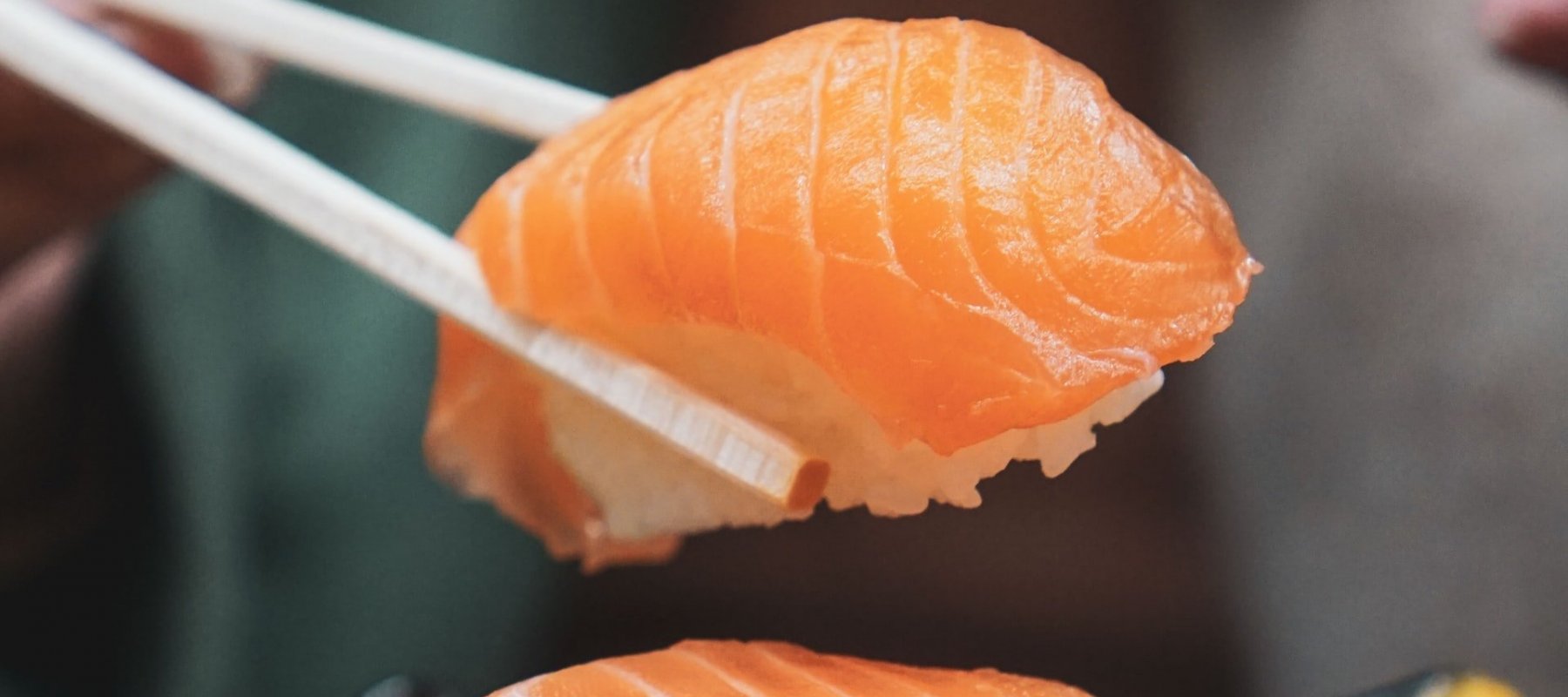
Kirby Cafe Tokyo
This new permanent cafe is located on the 4th floor of Solamachi, Tokyo Skytree, and is sure to bring a smile to any Kirby fan.

Mochi Pounding at Nakatanidou
Have your mochi pounded at breakneck speed by champion mochi-making experts before eating it fresh and warm on the spot.

Kill Bill Inspiration at Gonpachi
Gonpachi, the restaurant made famous by Quentin Tarantino in his 2004 film Kill Bill, serves delicious Japanese food to locals and..

Shirohige's Cream Puff Factory
Looking for the cutest cream puffs in town? Look no further! Shiro-Hige's Cream Puff Factory is the place for all you Studio..
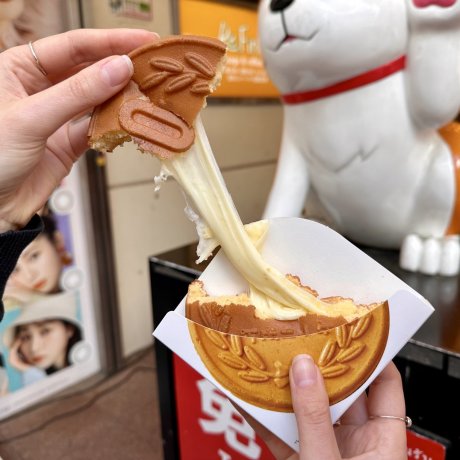
Viral ¥10-Shaped Bread
Are you a passionate foodie searching for the ultimate cheese pull? If so, look no further than the Mega Don Quijote store in ..
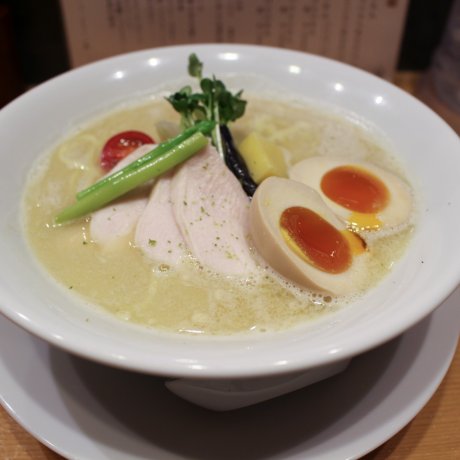
Kagari Ramen in Ginza
Experience tori paitan soba, or chicken ramen, at this much-loved hidden gem in Tokyo's Ginza district.

Okinawa Goat Misaki
What do you call a goat of wisdom and stamina? From the Maritime Silk Road to the byways of Sakae Machi, the past and present meet,..

Shinjuku's Memory Lane
Previously known as Piss Alley, over 60 bars and restaurants are crammed along the side of Shinjuku JR station on the grounds used..
Search filters
Food top 10.
- Recommended

Minoya Wagashi

Hagi City Food Guide: Best Local Eats

Foodies Guide to Authentic Japanese Cuisine

Four Seasons Steak House

Shu'n Wine and Dine Swissotel Namba

4 Must-Visit Hamburger Eateries in Shinagawa City

Tokyo Takes 2nd Place on Top Coffee Cities List

Only in Japan: Character Cafes in Tokyo

veJin: Vegan Ramen
Let us know how we can help.
Traveling Canucks
Canada Family Travel Blog
Beginner’s Guide to Food in Japan for tourists
01/23/2024 By Traveling Canucks 4 Comments Categories: Food Home Japan Kobe Kyoto Tokyo Travel Tips
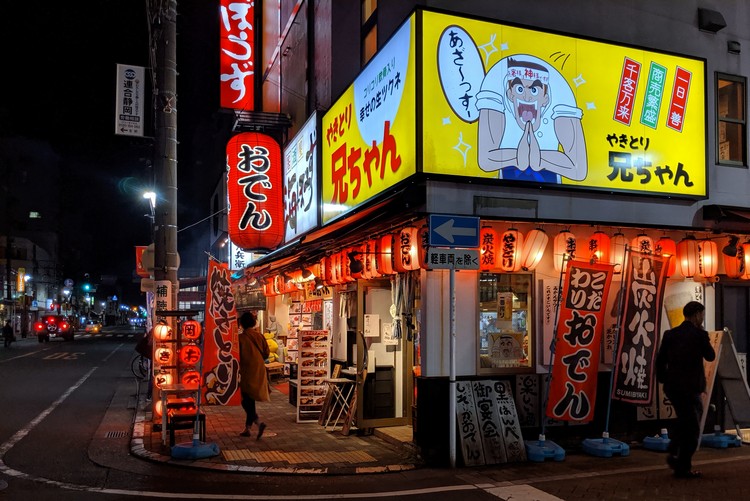
Beginners Guide to Food in Japan for first time visitors
Japan’s unique and diverse cuisine can be intimidating for first time visitors. Unadventurous eaters might experience a little anxiety when thinking about ordering Japanese food in Tokyo for the very first time. If you find yourself in this category, we’ve got you covered with this beginners guide to food in Japan.
We would argue that food is the reason to visit Japan.
However, for those unfamiliar with Japanese food culture, the idea of eating at restaurants in Japan might feel daunting. What do you order? How do you order? Do you tip in Japan? I remember feeling quite confused on our first trip to Japan; not being able to read Japanese characters didn’t help.
Thankfully, it didn’t take long before we started to feel comfortable.
We quickly turned our anxiety into curiousity. Sure, we sampled a few items that we will likely not order again (I’m talking to you, horumonyaki ), but we also discovered new foods and flavours that have forever changed our palate.
Most restaurants in high traffic areas will have food photos on the menu, plastic replicas in the windows, and/or English menus; so you’ll be fine even if you can’t read, speak or understand Japanese.
Skip ahead using the Table of Contents
Table of Contents
Readers note – we visited Japan prior to the Covid-19 pandemic. We recommend you do further research before your trip to Japan. Some of the Japan restaurants referenced in this blog post may have paused service, which might impact some recommendations.
Visit the Japan travel advisory for coronavirus updates here .
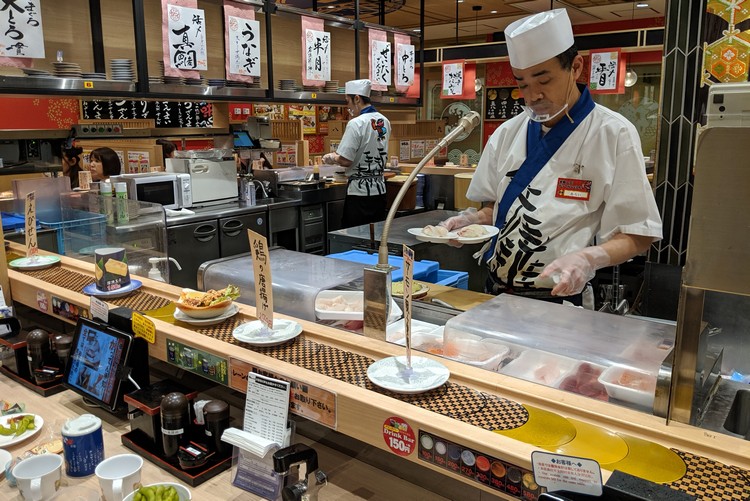
Read more posts from Japan
- 25 Japan travel tips for first timers
- 50 Photos of Kyoto that will inspire you to visit
- The perfect 3 day Tokyo itinerary for first time visitors
- 100 Photos of Tokyo Disneyland, Japan
- 15 things to do in Kobe, Japan
Let’s start with the most popular food in Japan for tourists
Given that this post is written with the first time visitor in mind, let’s start with the most popular Japanese cuisine for tourists. Below is a detailed list of Japanese food you should try in Japan.
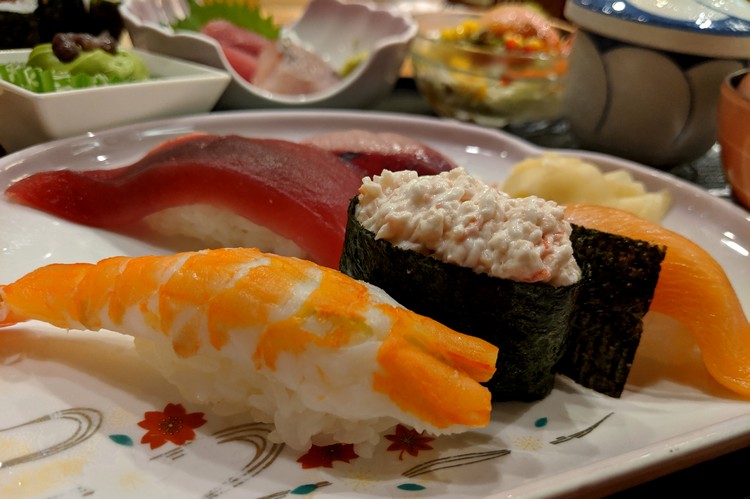
1. Sushi
Sushi is arguably the most famous food in japan. at least, it is for tourists. .
Without question, sushi is a big part of Japanese cuisine. You will find a variety of sushi shops in Japan, so you will have plenty of options.
If you’re not familiar with sushi, the thought of eating raw fish wrapped in thin sheets of seaweed might feel completely foreign and unsettling. You might even think that eating sushi is a big stretch for you. That’s okay, you’re not alone.
I think most people remember the first time they tried raw fish.
I know I do. It was a tuna sushi roll (tekka maki) at a small Japanese restaurant in North Vancouver. I had a mental block that prevented me from embracing the concept of raw fish. I wasn’t a fan of the texture or flavour, but it wasn’t as bad as I had built it up in my mind.
Now, years later, I can’t get enough sushi. I’m pretty sure we eat sushi at least once per week.
As one might expect, sushi tastes better in Japan. The fish is fresh and tasty and the sushi is prepared with a meticulous precision.
Travel tip – visit a Japanese restaurant in your hometown before you travel to Japan. Familiarize yourself with the menu and sample a few items. Let your curiousity run wild. This way, you have the advantage of reading the menu in English. Once you’ve seen and tried a few items, you’ll be much more comfortable with the food in Japan.
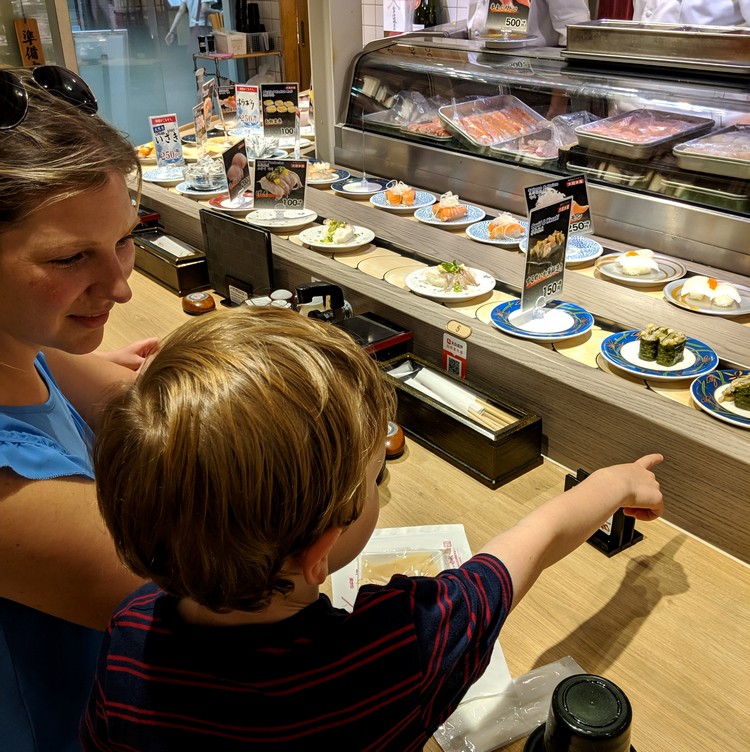
What sushi should you try first?
Sushi refers to any dish made with Japanese rice that’s seasoned with rice vinegar.
Sushi rolls are called maki or makizushi. Fresh fish and/or vegetables are wrapped with Japanese rice and a dried seaweed sheet (nori). The most common sushi rolls in Japan are salmon rolls, tuna rolls (tekka maki), unagi (freshwater eel), cucumber (kappa maki), f ermented soybean (Natto Maki) and f utomaki sushi rolls.
Here is list of useful sushi terms you should know before your visit to Japan.
Nigiri sushi are bite-sized mounds of sushi rice topped with slices of raw fish. The most popular nigiri sushi are sliced tuna, salmon, freshwater eel, squid and prawn. However, there are endless types of nigiri sushi available at Japanese sushi restaurants.
If you’re unsure about sushi and you want to ease in slowly, we recommend trying a non-fish sushi roll first, like cucumber, avocado, mushroom or egg (tamagoyaki).
Fun fact – California rolls and Dynamite Rolls are popular in North America, but not in Japan. Some Japanese restaurants in touristy areas will have these Westernized rolls on the menu, but most will not. These “safer” rolls are a good introduction to sushi because they do not have raw fish, but don’t expect to find these sushi rolls in Japan.
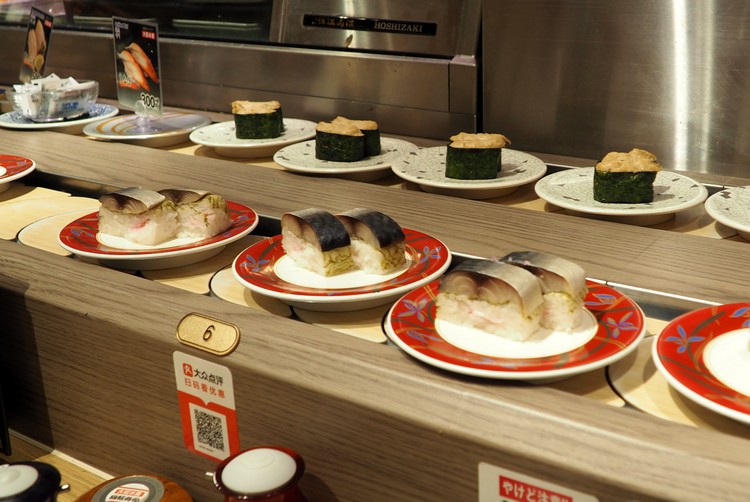
Conveyor belt sushi in Japan – Kaiten Sushi
A fun way to sample a variety of sushi is visiting a conveyor belt sushi restaurant, also called rotation sushi, sushi train and kaiten sushi . You may have seen or read about these innovative sushi restaurants during your research about Japanese food.
Basically, a conveyor belt transports small plates of various sushi around the restaurant. Typically, the conveyor belt passes beside tables or booths, or in front of a sushi bar, like the one pictured above.
Each item has a different price, which is identified by the colour or pattern on the plate. For example, the red plates might be 200 Yen each. If you see something you like, pick it up from the conveyor belt and enjoy. At the end of your meal, you add up the plates and pay for what you took from the conveyor belt.
We visited a few kaiten-zushi restaurants in Tokyo and Kyoto. They’re great. Not only does the sushi come out quickly, you can actually see the items as they pass your table. This is ideal for first timers who are nervous about trying raw fish for the first time.
And, you don’t need to worry about over-ordering, or under-ordering. The small bites allow you to pace yourself and try some items you might not have it you were to order from a menu.
Here’s an updated list of Conveyor Belt Sushi Restaurants in Tokyo.
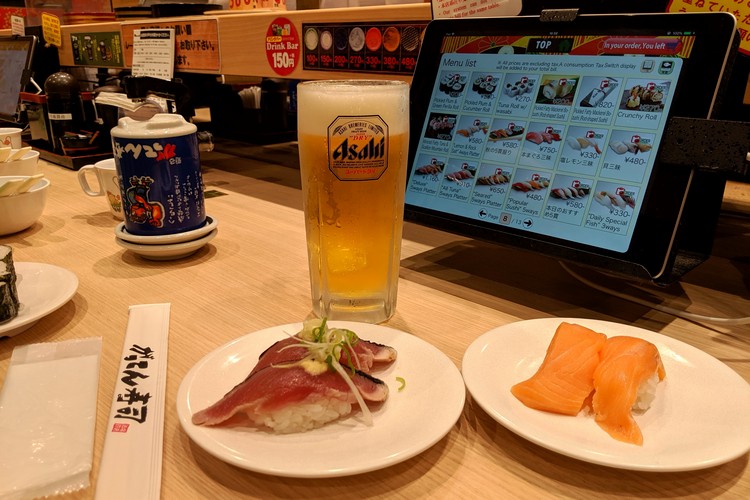
Most conveyor belt sushi restaurants in Japan have tablets at the table (see above photo). If you don’t see items you like on the conveyor belt, or you would like to order hot food items, you simply click the photos and place your order on the tablet.
Most tablet menus have an English option. This is helpful if you have specific items in mind.
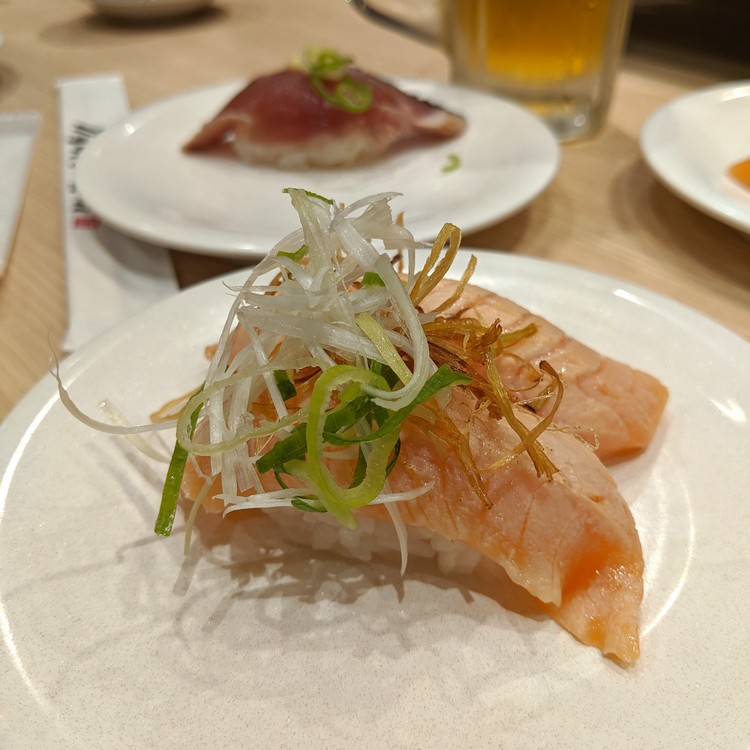
Above – a small plate of nigiri sushi at a kaiten sushi restaurant in Tokyo Japan.
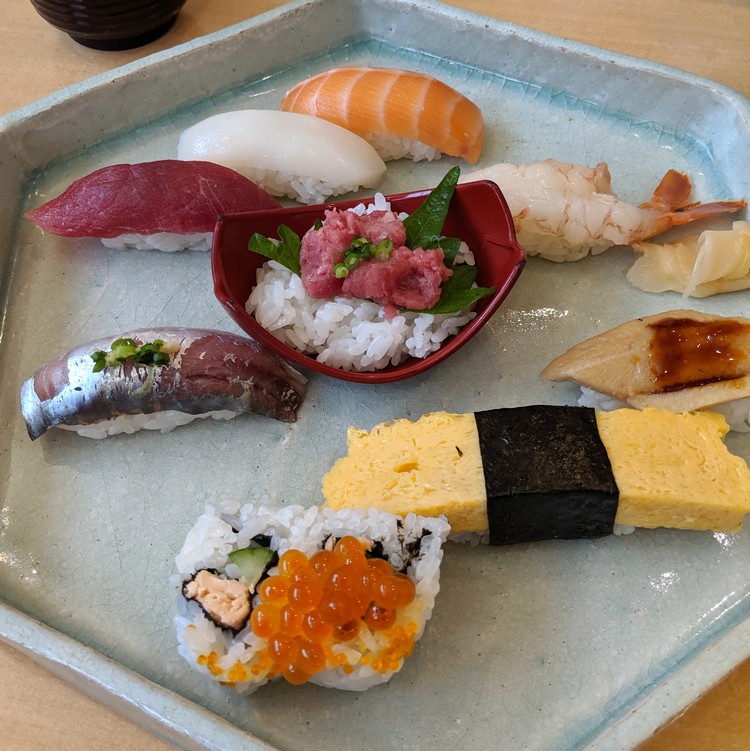
The above photo is a platter of various nigiri sushi.
Each piece of nigiri sushi a work of edible art. In the middle of the platter is chopped raw tuna belly served on rice. The big yellow sushi is tamago nigiri, which is a sweet folded omelet wrapped with seaweed.
Related post – Japan travel tips for first time visitors.
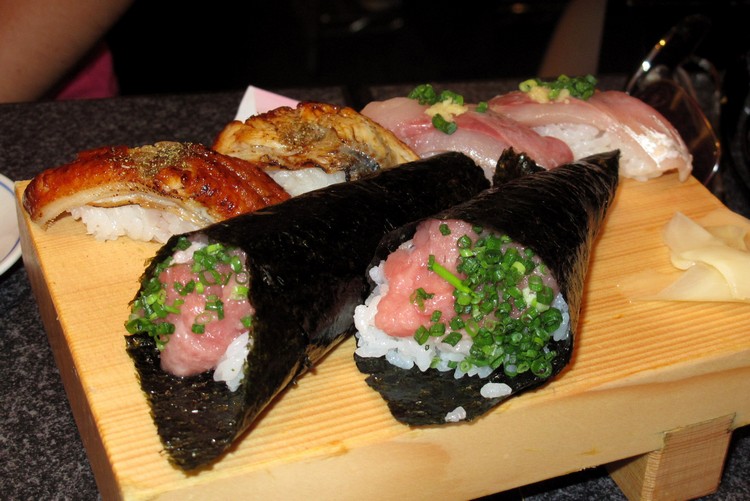
You can also order sushi cones, like in the above photo. These can get messy if you’re not careful. However, it’s one of our favourite food in Japan.
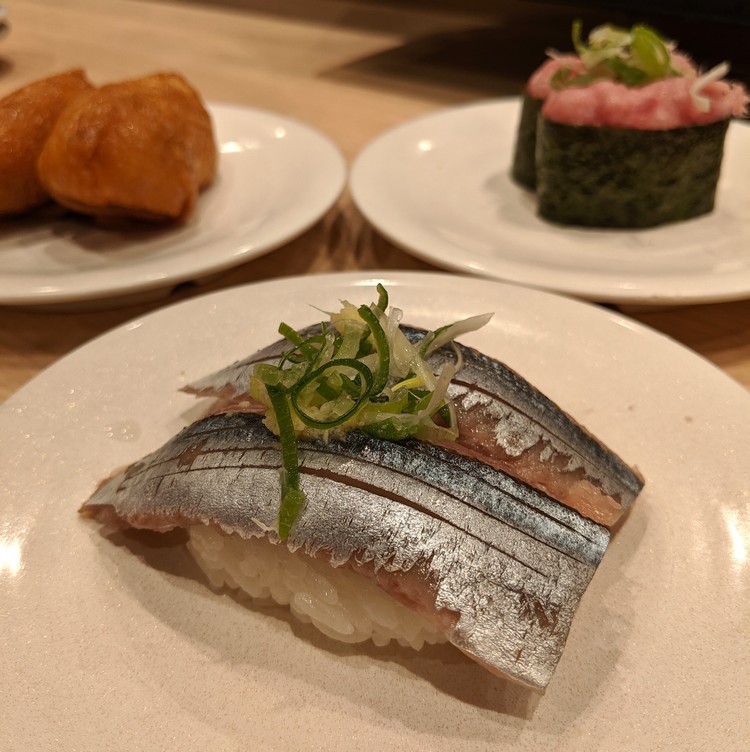
How to eat Sushi in Japan
We eat sushi often in Vancouver . At least once per week. We thought we knew the correct way to eat sushi, but we were wrong. How did we not know this before travelling to Japan?
Here’s an etiquette guide for how to eat sushi the correct way .
Apparently, the golden rules of eating sushi in Japan are:
- do not stick your chopsticks upright in the rice
- do not cut a piece of sushi in half with your chopsticks
- don’t mix wasabi in your soy sauce
There are a lot of things to know when it comes to Japanese culture. Most people will forgive foreigners for not knowing or understanding proper Japanese etiquette and customs, provided you’re respectful, quiet and polite. So, if you want to mix up your wasabi and soy sauce, do it subtly and don’t be surprised if the sushi chef rolls his eyes at you.
Related – Japan travel tips you should know before you go
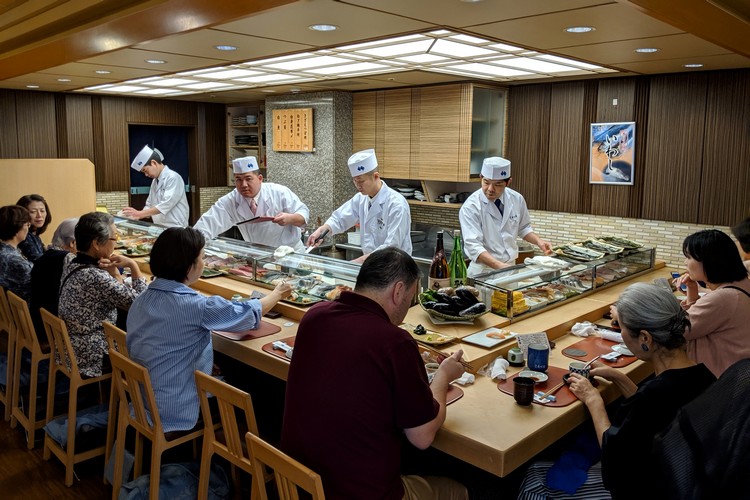
What is your favourite Japanese cuisine? Leave a comment below.
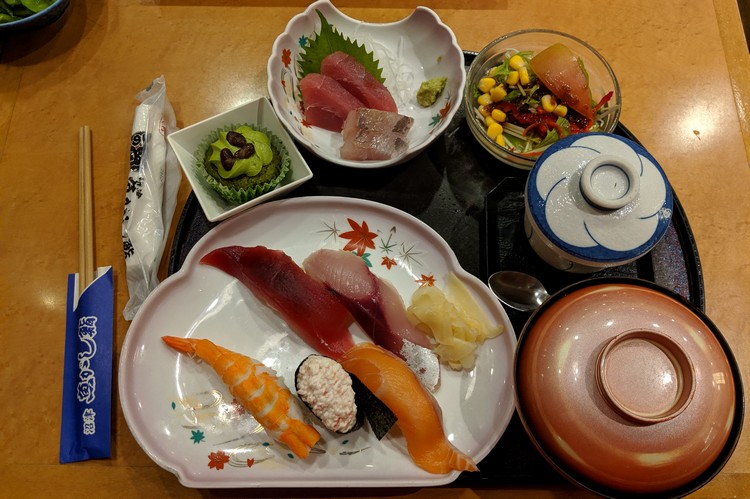
Sashimi is a Japanese delicacy that consists of thinly sliced raw fish, typically salmon, fatty tuna, yellowtail, mackerel, scallop and squid. You will also find sashimi-style meat, like chicken and beef.
Typically, sashimi is served plain and you dip the raw fish slices in soy sauce. However, some types of sashimi are served with a spicy sauce on top (example = spicy tuna sashimi).
What is the difference between sushi and sashimi?
There are a lot of similarities between sushi and sashimi. Some nigiri sushi, like the ones pictured above, have a strip of raw fish resting on a mound of Japanese rice. Same goes for some sushi rolls, like tekka maki (tuna), where the sushi roll is filled with slices of raw fish, which is basically sashimi.
In the above photo, the sashimi is located in the top dish. You can see the similarities between sashimi and nigiri sushi – the slices of fish on the nigiri sushi are so big that you actually can’t see the rice underneath.
Kaisendon traditional set menu
Kaisendon is a Japanese dish that consists of white rice and raw sashimi, such as prawns, octopus, squid, salmon, white fish, crab meat, egg, and sea urchin roes. It is often served with a traditional set menu (above photo).
In the covered brown bowl is miso soup, which is commonly served at Japanese restaurants.
The white bowl on the top right of the plate is chawanmushi , a steamed egg custard filled with meats and vegetables (including chicken, mushrooms, gingko nuts, kamaboko fish cakes, and carrots).
Other items typically found in a Japanese set menu are steamed vegetables, pickled vegetables, tempura (see below), salad, sushi rolls and/or a sweet desert like matcha cupcakes.
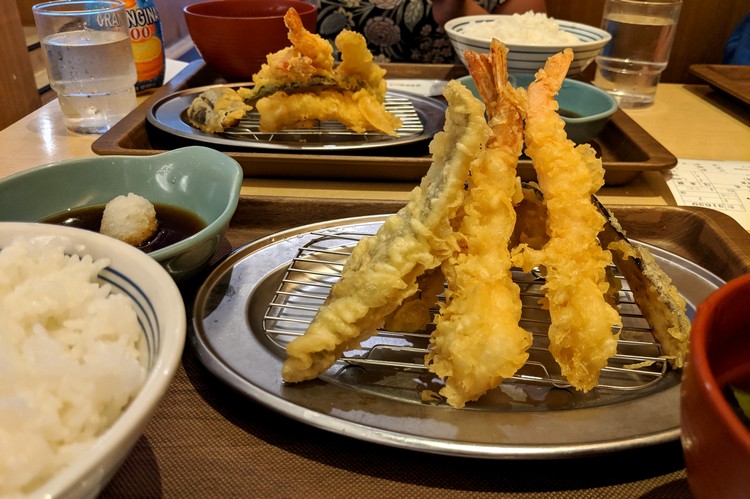
3. Tempura
Tempura is one of the most popular Japanese dishes in Japan. It’s a simple dish that consists of battered and deep fried seafood, meat and/or vegetables, served with a special dipping sauce called Tentsuyu.
Tempura is an easy introduction to Japanese food for tourists.
If you like crispy fish and chips, you’ll love tempura. Tempura batter is lighter than the batter that’s commonly used for fried fish and chicken.
Tempura can be served as an appetizer, side dish or as a stand-alone entrée. It’s typically made with prawns and/or vegetables, like yams, sweet potato, butternut squash, eggplant and green beans.
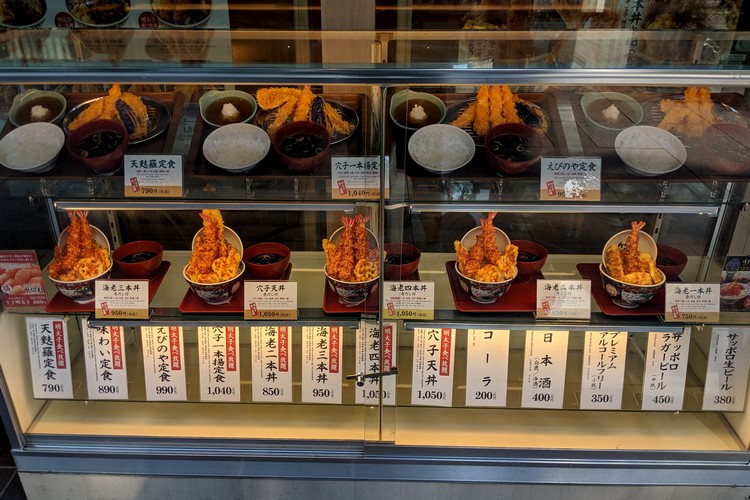
Many Japanese restaurants have plastic replicas of the dishes on display at the front or entrance to the restaurant. This makes it easy to visualize the menu and decide what you want to order before sitting down at a table. It’s very convenient when traveling with kids.
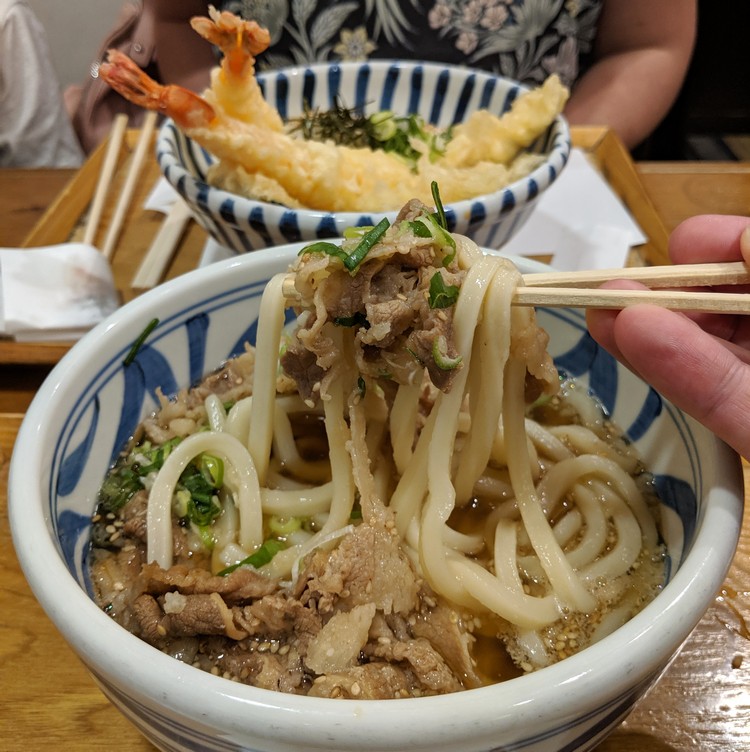
Udon is a popular Japanese dish that’s an easy introduction to Japanese food for tourists. It can be served a number of different ways, with a variety of ingredients, but it is most commonly served in noodle soups.
Pictured above is a delicious beef udon noodle soup that we enjoyed in Kyoto, Japan .
I like the simplicity of udon noodle soup. The flavourful savoury bowls are loaded with soft thick noodles, sliced chicken or beef, fresh vegetables and a variety of garnishes like green onion, sesame seeds, roasted seaweed slices, nora and dried garlic.
The most common udon noodle soups are Kitsune Udon, Tempura Udon (pictured above, in the backdrop) and Chikara Udon (topped with grilled mochi rice cakes).
You will also find udon noodles served in a stir fry dish, called Yaki Udon , mixed with meat, vegetables and a soy based sauce. It’s similar to yakisoba, but the noodles are different.
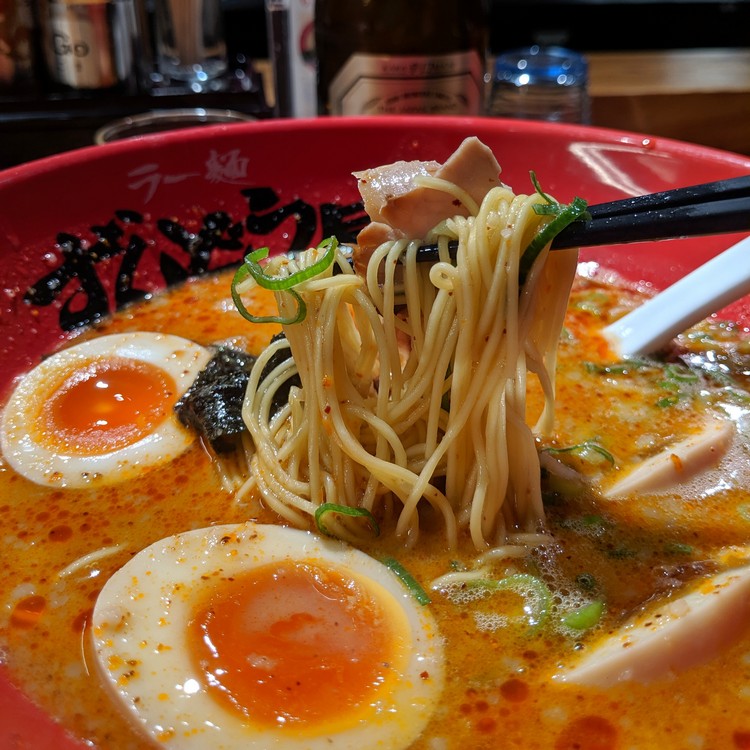
Ramen is probably the most popular Japanese cuisine for tourists.
Similar to udon, ramen is a noodle dish consisting of thinly sliced wheat noodles, protein, vegetables and is typically served in a rich savory broth. Ramen is the perfect Japanese food for beginners.
There are many types of broths, ingredients and garnishes that will completely change the flavour and texture of the ramen noodle soup. The four main ramen broth bases are soy, miso, salt and tonkotsu.
My favourite is miso ramen, but tonkotsu is a close second. Who and I kidding, I love them all!
You can also add items to your ramen. Typical ramen garnishes include chashu pork, menma (bamboo shoots), narutomaki (fish cake), scallion, shiraga negi (Japanese long green onion) and a marinated soft boiled egg ( Ajitsuke Tamago ). I love adding an extra soft boiled egg – they are heavenly when prepared properly.
Ramen is an inexpensive and popular dish that can be found almost anywhere in Japan. You won’t have a problem finding ramen restaurants in Tokyo or Kyoto.
That said, like most restaurants, some are better than others. If you’re only in Tokyo for a few days, research online reviews to find the best ramen restaurants in Japan. Make it count!
Related post – How to spend 3 days in Tokyo
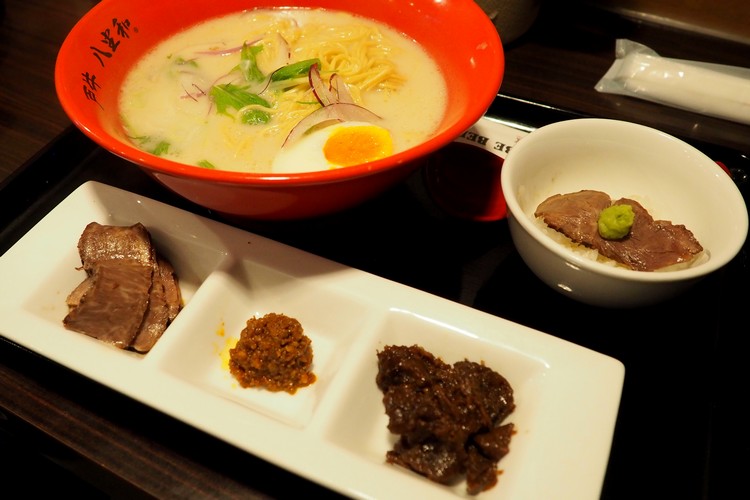
The above photo was captured at a small ramen restaurant in Kobe that was recommended to us. This particular miso ramen dish is served with a variety of Kobe beef.
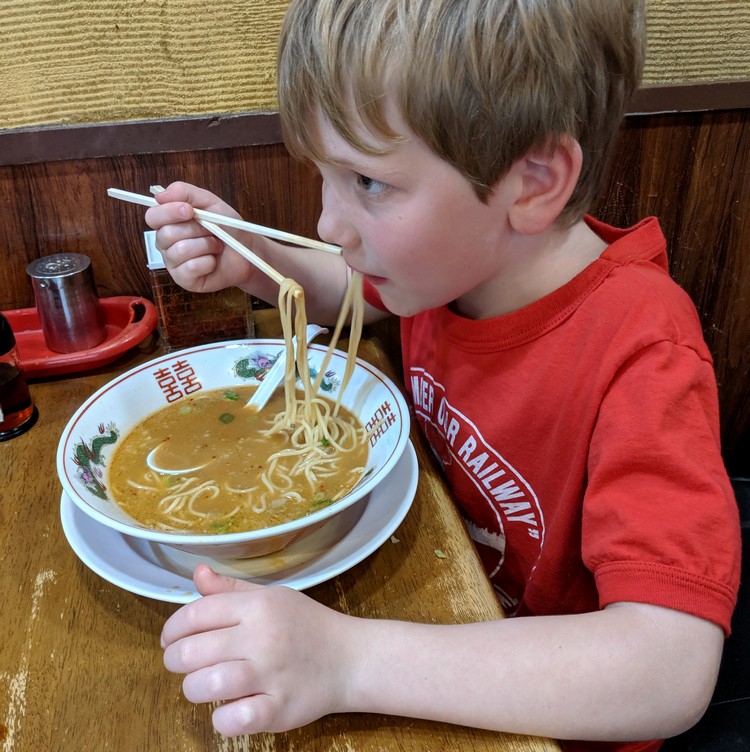
Ramen is an easy introduction to Japanese food for kids. Our 8 year old son loves miso ramen.
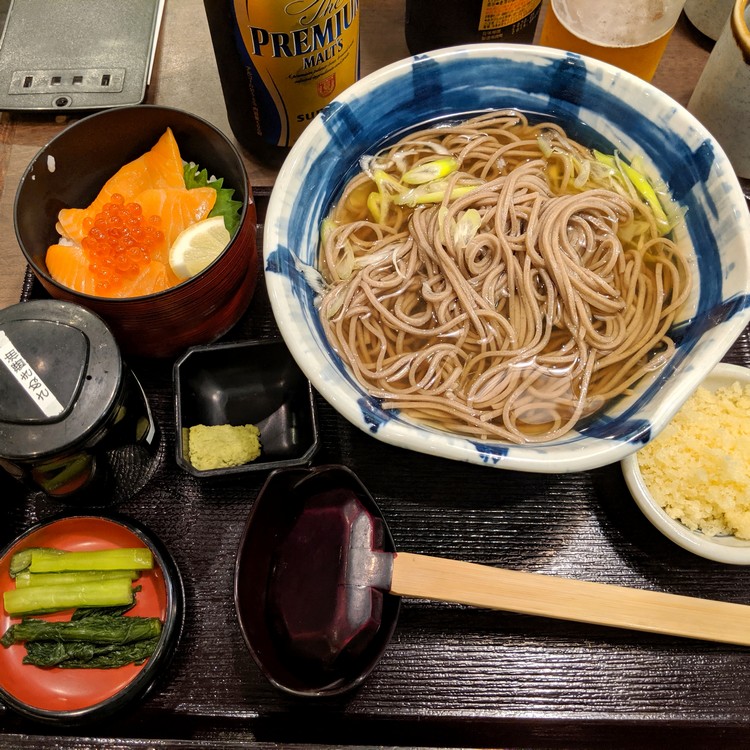
Soba is the Japanese name for thin noodles made from buckwheat flour, or a combination of buckwheat and wheat flours. Similar to udon and ramen, soba noodles are often found in savory soup broth. However, soba noodles are also served cold with a dipping sauce or as a hot stir fry dish.
There are many soba noodle recipes and dishes to taste, from spicy peanut soba noodle salad (served cold) to beef and vegetable stir fry soba noodles (yakisoba).
Many restaurants in Japan offer a set menu with soba noodle soup as the main dish, accompanied by a variety of side dishes, like tuna sushi, salmon sashimi, grilled vegetables, steamed spinach with peanut sauce (Goma-ae), crispy tempura batter and chawanmushi (traditional savory egg custard).
Related – 50 Photos of Kyoto that will inspire you to visit
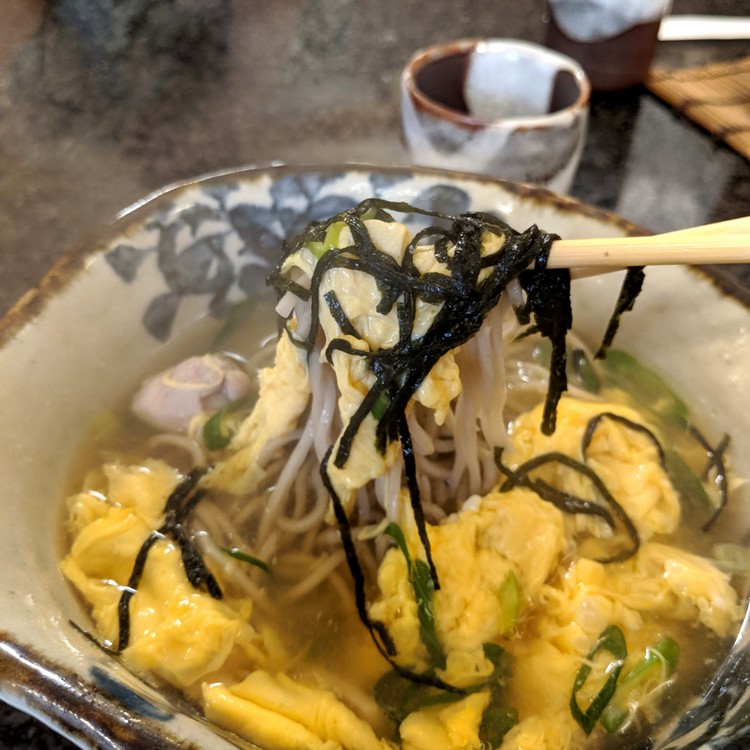
Above is a soba noodle soup with egg, chicken and sliced nori (dried seaweed).
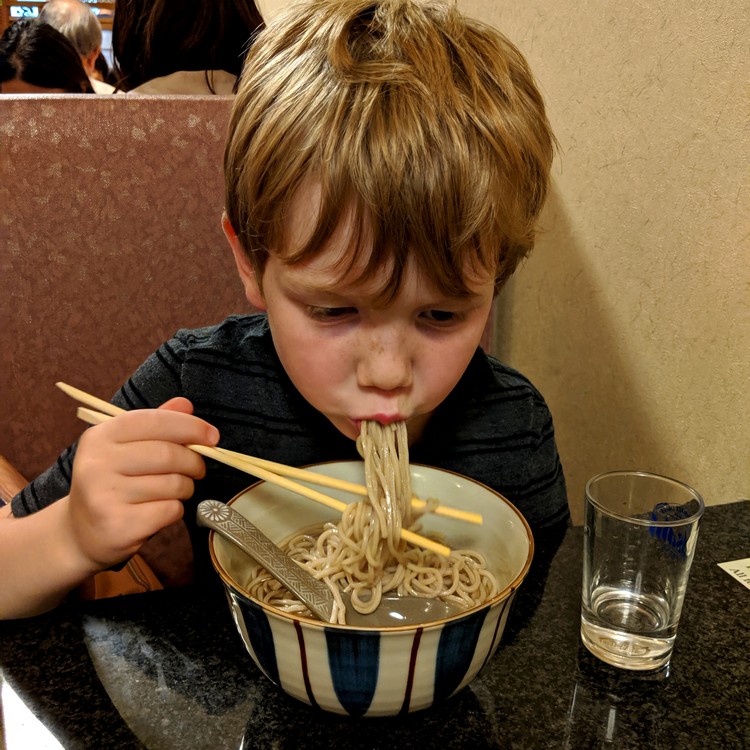
Another day, another bowl of noodles for this little guy.
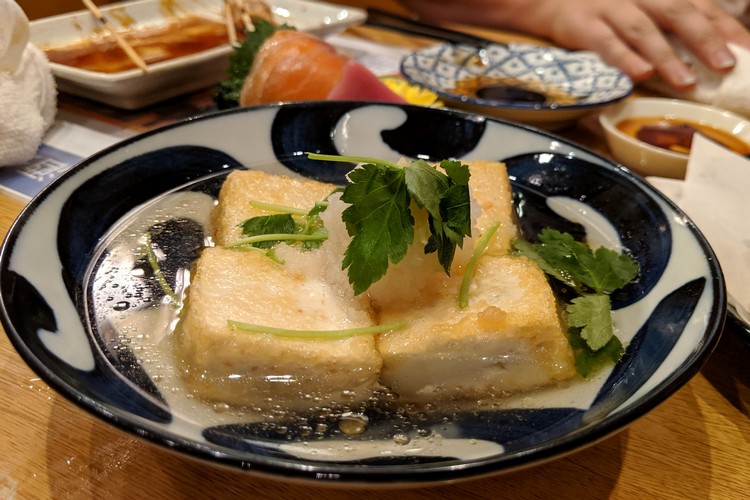
7. Agedashi Tofu
Agedashi tofu is cubes of soft or silken tofu coated with potato starch and deep fried so that the outer shell is crispy. It’s typically served as an appetizer or side dish, but can also be the main item in a bento box or served as an entrée.
If you’re vegetarian or don’t like to eat meat or fish, agedashi tofu is a great alternative.
Agedashi tofu is typically served with a flavourful tsuyu sauce for dipping. It is sometimes served with grated radish, green onion, and bonito flakes as garnishes.
Be careful. Agedashi tofu is deep fried and it comes out hot, hot, hot! We’ve burnt the roof of our mouths several times because we were too eager to dive in. The trick is to stab the middle of each piece of tofu with your chopstick so the steam releases and the tofu cools down. Consider yourself warned.
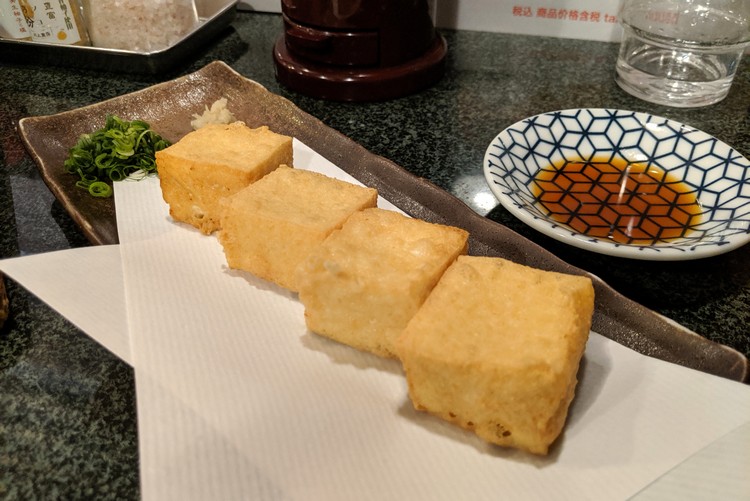
Above is a plate of large cubed agedashi tofu at a restaurant in Arima Onsen , an ancient hot spring town located near the city of Kobe.
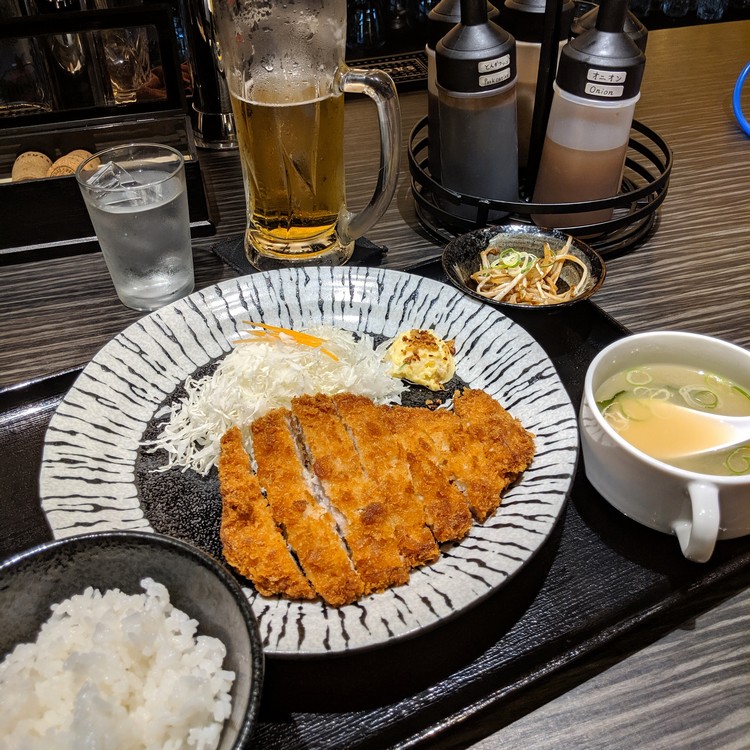
8. Tonkatsu (deep fried pork cutlet)
Tonkatsu is a breaded, deep-fried/tempura pork cutlet that is traditionally served with rice and sliced cabbage. It is a popular Japanese food for beginners because, well, who doesn’t like deep fried <insert anything and everything>?
Tonkatsu is similar to German schnitzel. However, the bread crumbs used for tonkatsu is called panko, which is different from the breadcrumbs used in Western cuisine.
You will find variations of tonkatsu in Japan, including katsudon , which consists of tonkatsu served on a bowl of rice, and katsu sando , which is a sandwich with tonkatsu between two slices of plain white bread.
Katsukare is another Japanese cuisine that consists of sliced tonkatsu pork cutlet served with Japanese curry rice and curry.

9. Yakitori
Yakitori is the japanese version of chicken skewers..
There are many variations of yakitori , however, typically the skewers are made with bamboo skewers and seasoned with tare sauce and/or salt and spice.
Yakitori comes in many forms, including white chicken skewers, chicken and spring onion, chicken meatballs, chicken small intestines, gizzard and chicken heart, to name a few. Some restaurants and specialty shops also have deep fried options available.
Yakitori a popular Japanese street food that is commonly found at outdoor markets, food courts, sporting events and Yakitori-ya, which are small shops that specialize in yakitori. It’s widely available at izakayas, informal Japanese bars that serve alcoholic drinks and snacks. Here’s a list of best izakaya alleys in Tokyo.
Related – The best things to do in Tokyo for first time visitors
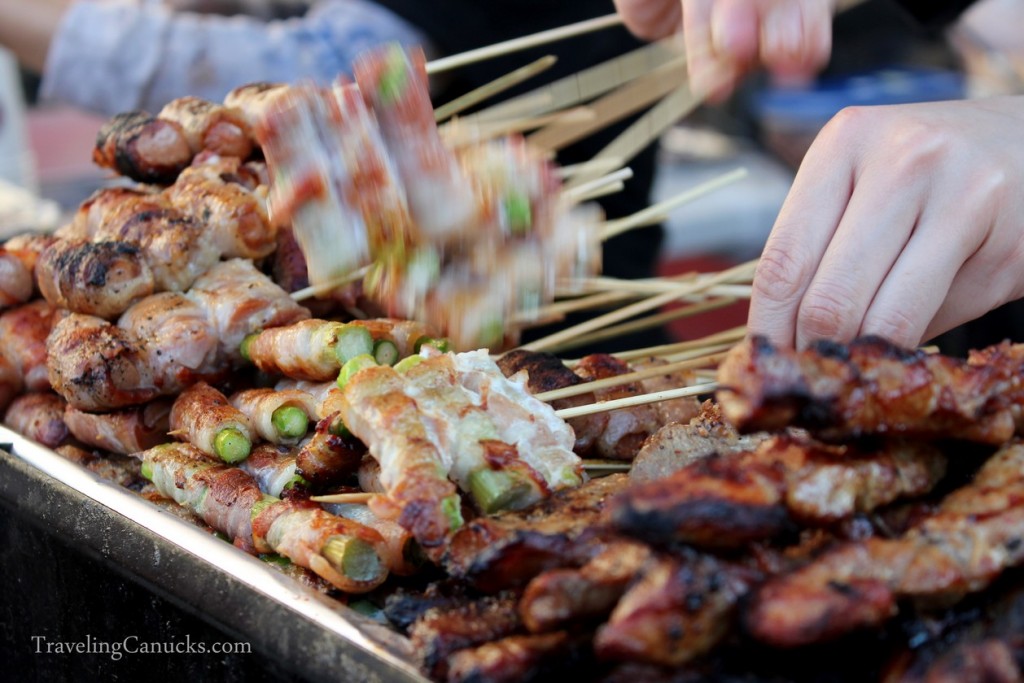
Freshly grilled yakitori at a market in Japan.
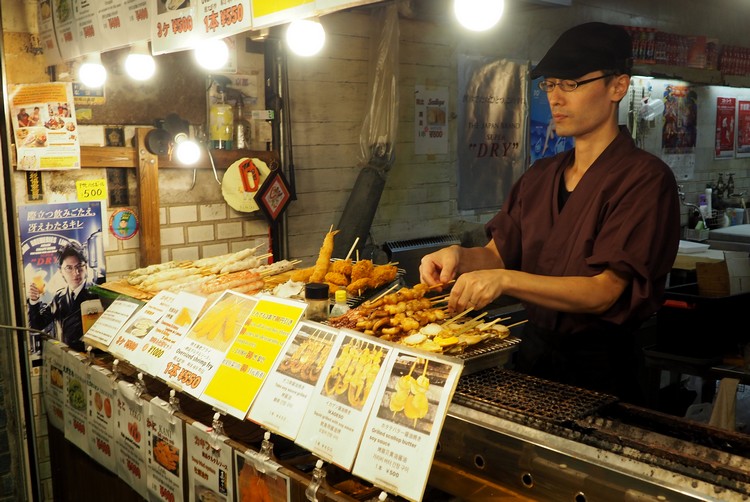
Yakitori and deep fried skewers at a stall in Nishiki Market in Kyoto.
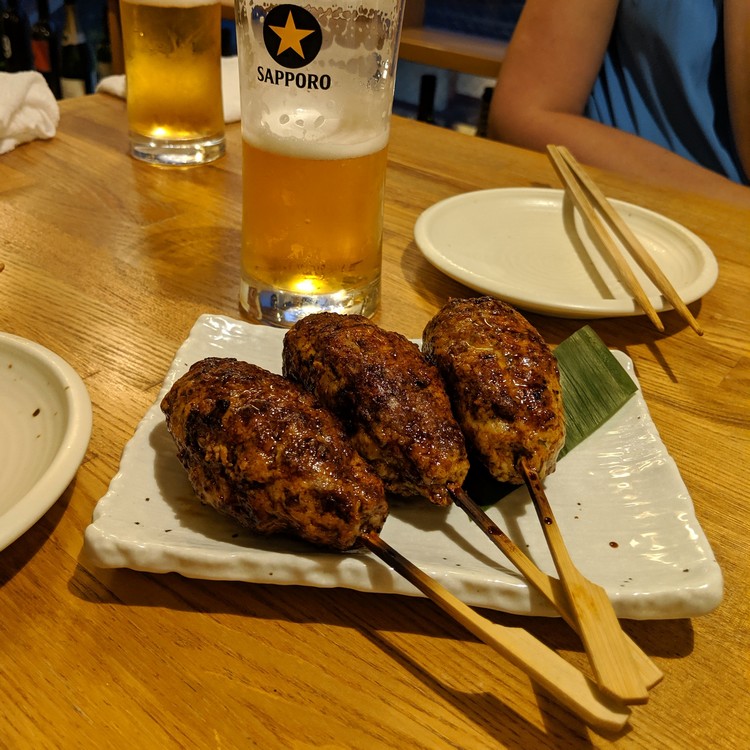
Chicken meatball yakitori served at a restaurant in Kyoto.
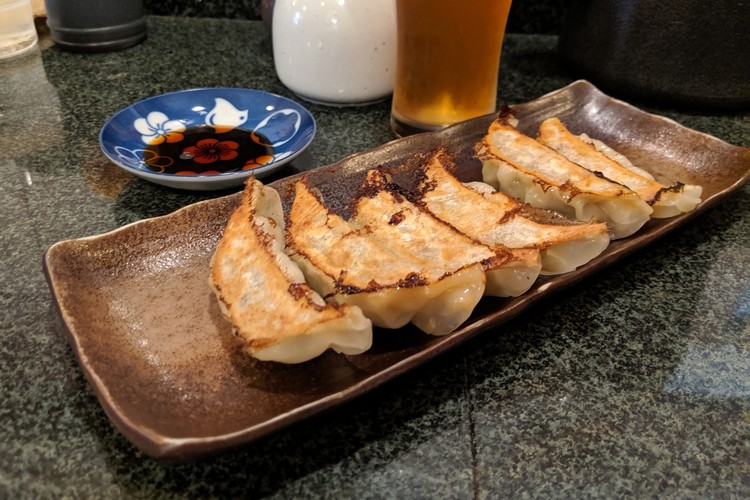
Gyoza is another popular Japanese dish that is a must try food in Japan. It’s commonly served as an appetizer or side dish at sushi restaurants.
Gyoza is Japan’s version of the dumpling. It’s most similar to Chinese potstickers or jiaozi dumplings. These tasty Japanese dumplings are typically filled with minced pork, cabbage, scallions, garlic, and ginger. Vegetarian options are typically available, too.
Gyozas are typically fried in sesame oil on one side, until they have a crispy bottom. The top of the gyoza is steamed, giving it a soft texture. They’re served with a dipping sauce of rice vinegar, soy sauce and chilli oil.
Gyozas are an easy introduction to Japanese food for unadventurous eaters.
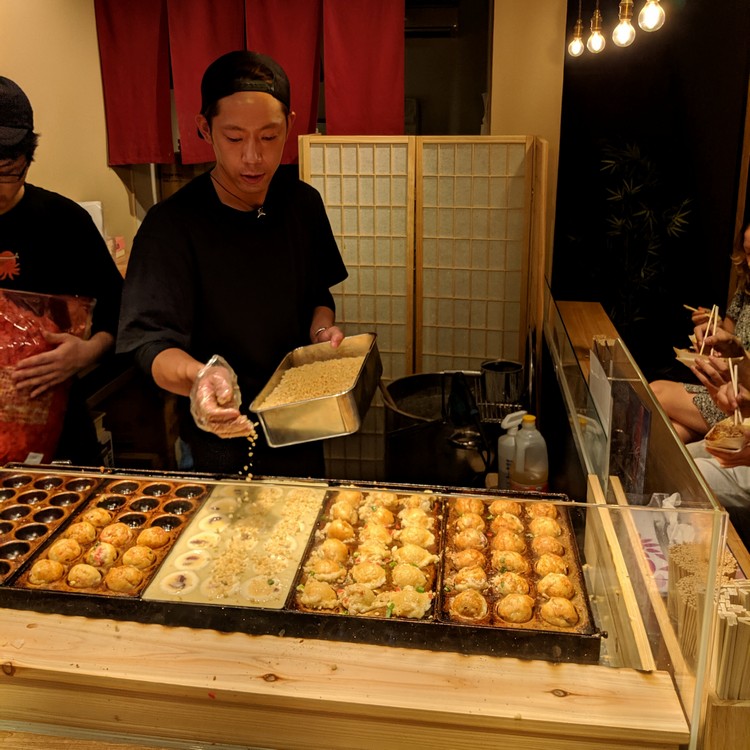
11. Takoyaki
Takoyaki, also known as octopus balls , is a delicious doughy ball filled with minced or diced octopus, tempura scraps, pickled ginger and green onion..
They are commonly eaten as a snack or appetizer and are served with takoyaki sauce (similar to Worcestershire sauce) and mayonnaise, and garnished with shavings of dried seaweed and fish flakes.
You will find small shops and street food vendors serving takoyaki throughout Japan.
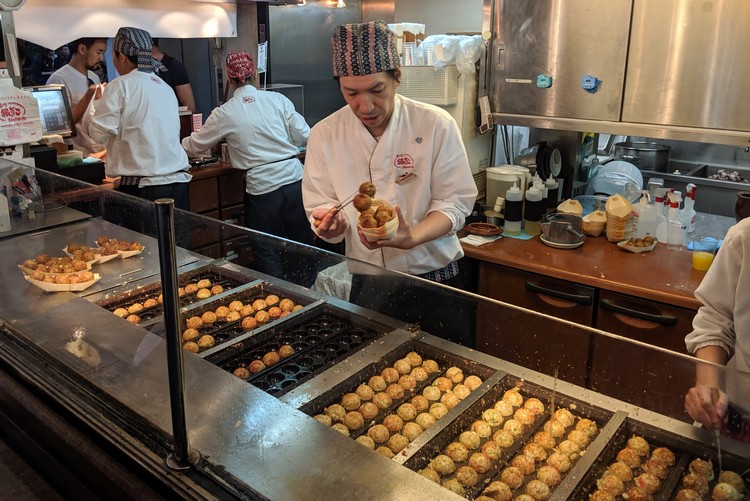
Gindaco Takoyaki is the famous takoyaki restaurant near Harajuku train station in Tokyo.
We highly recommend you visit this location. They serve the best takoyaki in Tokyo, in our opinion.
Be prepared to wait your turn, as this location is very popular. It’s worth wait. Do it.
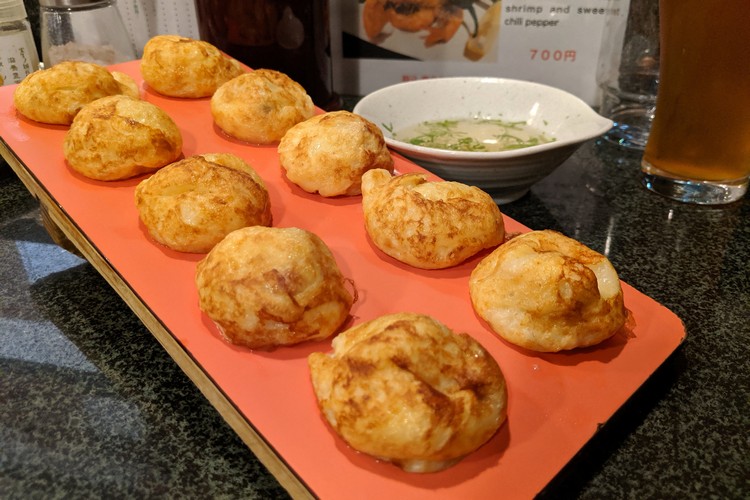
This takoyaki platter is served plain with a light vinegar dipping sauce on the side.
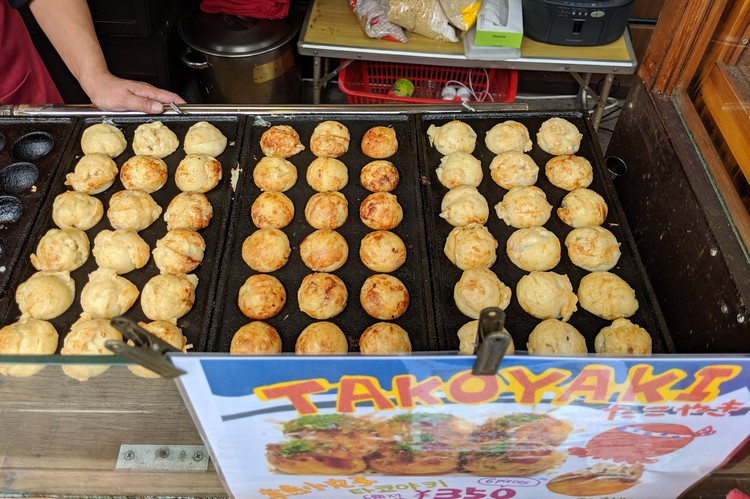
Takoyaki street food vendor near Fushimi Inari temple in Kyoto.
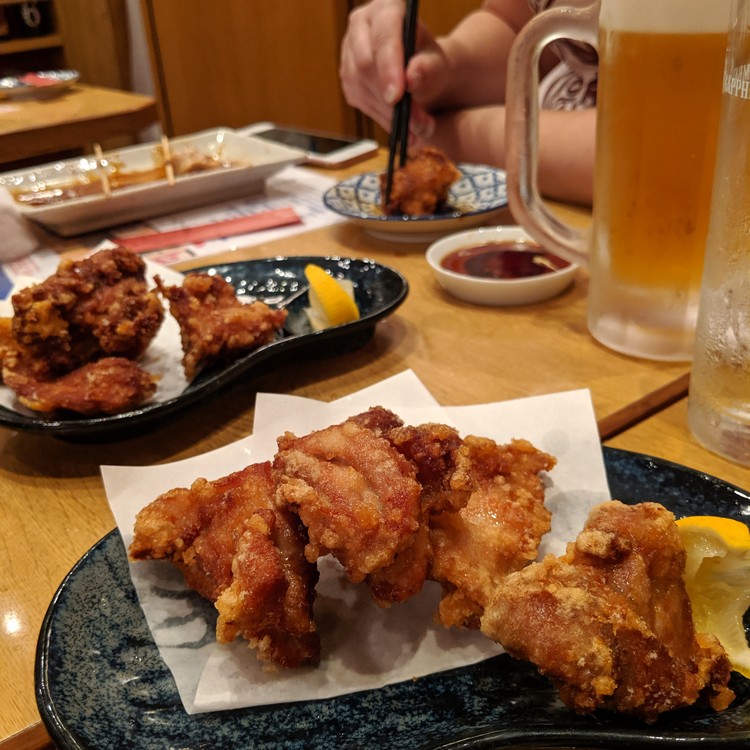
12. Chicken Karaage
Karaage is Japan’s version of fried chicken. The chicken is battered and deep fried until crispy on the outside. The chicken is often marinated prior to being coated with batter.
Karaage is served alone or with rice and shredded cabbage. It’s often served as an appetizer but it can also be a stand alone dish. You will find karaage served at most Japanese restaurants, as well as street food vendors at outdoor and indoor markets.
Our boys love chicken nuggets, so this tasty Japanese cuisine is one of their favourites.
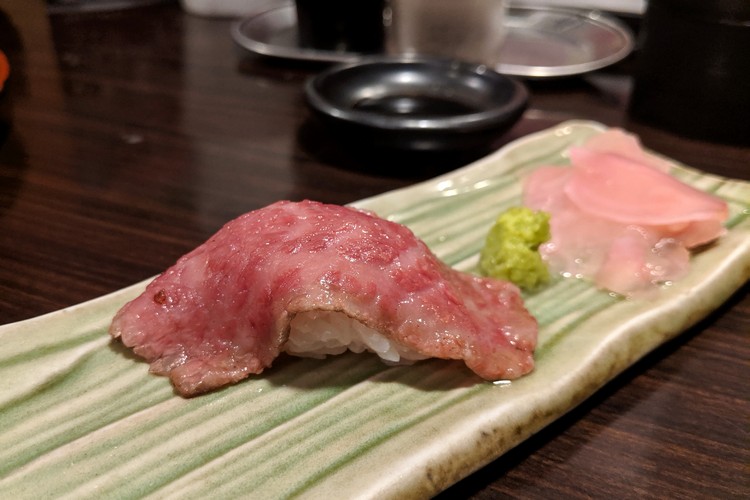
13. Kobe beef in Kobe Japan
For all you steak lovers out there, you must try kobe beef in kobe..
Kobe is famous for its Wagyu beef , arguably the finest cut of beef in the world, which comes from the Tajima strain of Japanese Black cattle.
Kobe beef is a Japanese delicacy , valued for its flavour, tenderness, and fatty, well-marbled texture. Foodies flock to Kobe to sample it’s famous namesake.
First time visitors to Kobe will have no trouble finding a restaurant serving Kobe beef. It’s heavily advertised from the moment you get off the train at the Kobe train station.
There are a number of ways to sample this popular Japanese style of beef, from Kobe beef teppanyaki to Kobe beef hamburgers to Kobe beef sushi (pictured above).
Kobe beef is an expensive cut of meat , so your budget may dictate the best way to experience this celebrated Japanese cuisine. High-end steakhouses offer multi-course meals that serve a variety of cuts and styles of wagyu beef.
Or, you can enjoy Kobe beef on the cheap by sampling kobe beef sushi from a variety of restaurants or street food vendors. That’s what we did, because only one of us likes beef (hint – it’s not Nicole or the boys).
Now, if Kobe City is not on your original Japan travel itinerary, you can easily add it by taking a day trip to Kobe from Kyoto, Tokyo or Osaka. Or, you can simply get off the train in Kobe and have lunch or dinner, then get back on the train and continue to your next destination.
You will find wagyu beef throughout Japan, so don’t worry if you aren’t able to make it to Kobe. There are dozens of restaurants in Tokyo that serve wagyu beef, including Kobe beef, Omi beef and Matsusaka beef.
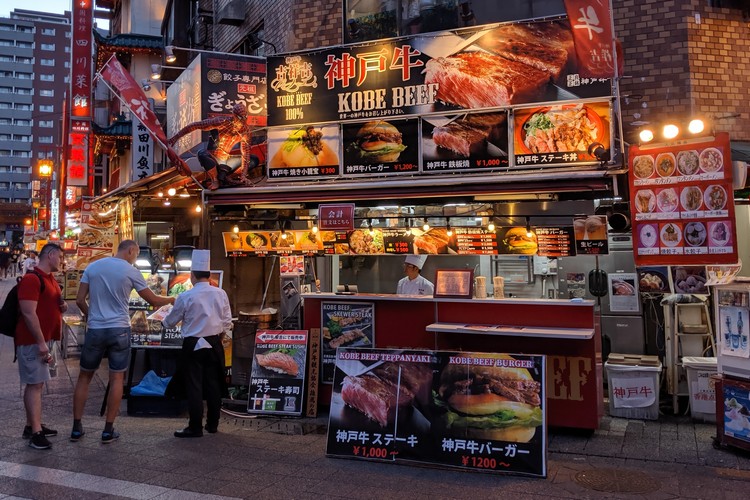
Street food vendors in Kobe Chinatown serve a variety of Kobe beef to hungry visitors.
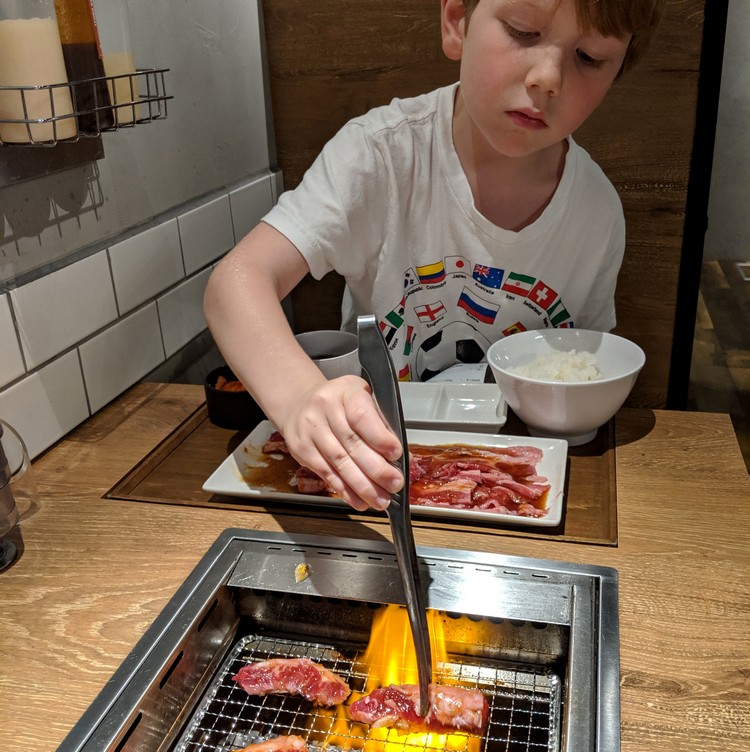
14. Yakiniku
Yakiniku is a Japanese term that refers to grilled meat. Basically, you grill your meat on an open flame at your table. It’s a fun Japanese dining experience that you should try on your Japan vacation.
We stumbled upon a great yakiniku restaurant, Yakiniku LIKE , while exploring the Akihabara district in Tokyo. There are tablets at each table with an English menu and photos of each dish, so it’s an easy process with limited ‘lost in translation’ moments.
We ordered a variety of pork and beef to grill at our table. The raw meat is marinated and sliced, so you just add to the flame and cook it as much, or as little, as you like. Meals are served with rice and there are several condiments at your table.
Our boys loved grilling meat on the table. This was there first time and it remains a highlight for them when we talk about our family trip to Japan.
Related – The top things to do in Tokyo for tourists
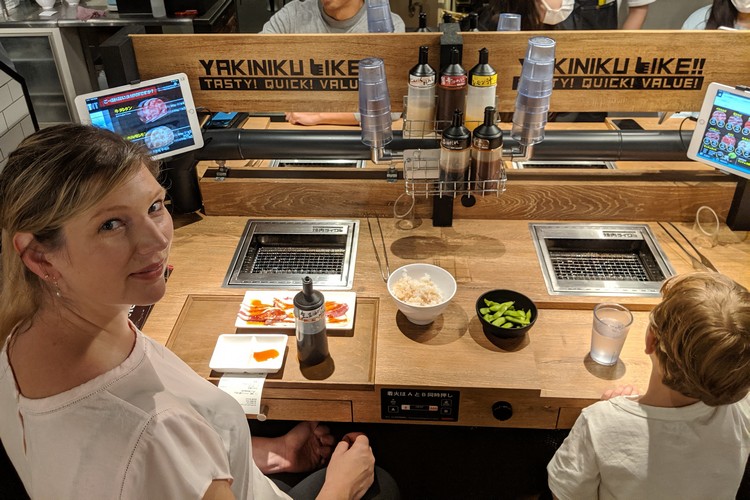
Follow us on Facebook for the latest travel updates.
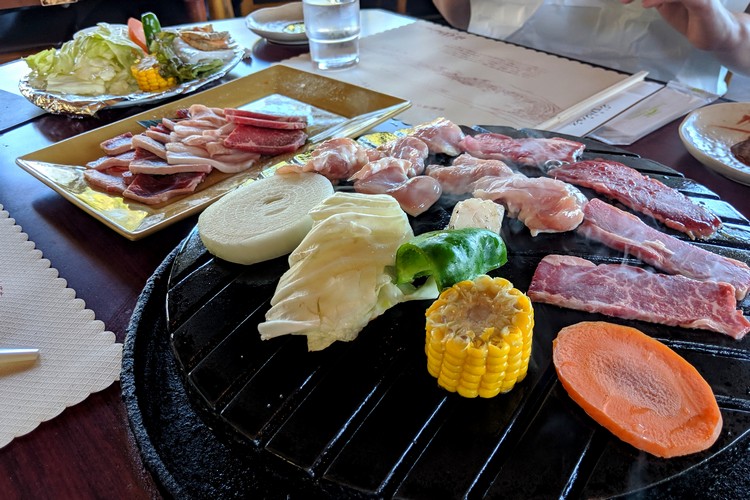
Japanese BBQ at your table
We enjoyed a fun lunch at Rokkosan Genghis Khan Palace on Mount Rokkō in Kobe City. Rather than being grilled on an open flame, like yakiniku, this Japanese barbecue grill is on a hot iron plate.
We ordered a variety of vegetables and meat, including Kobe beef, chicken and marinated pork, and grilled the food at our table. Our boys enjoyed using the tongs to flip the meat and listen to it sizzle on the iron plate. It’s a fun Japanese dining experience for tourists.
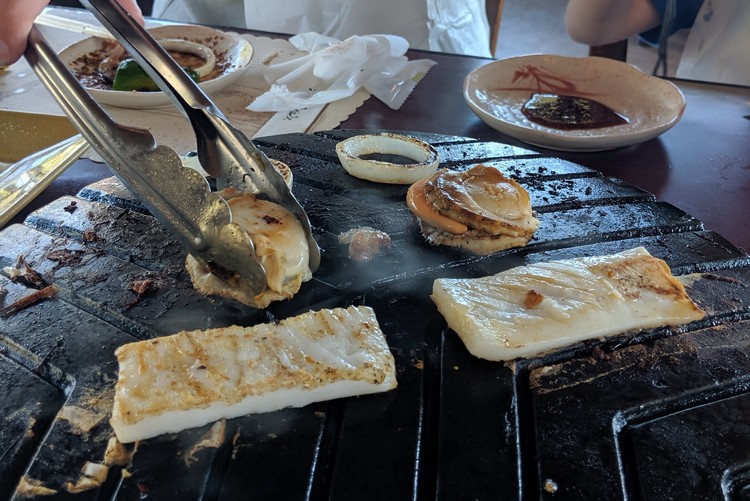
Grilling squid and giant mussels on an iron plate at our table .
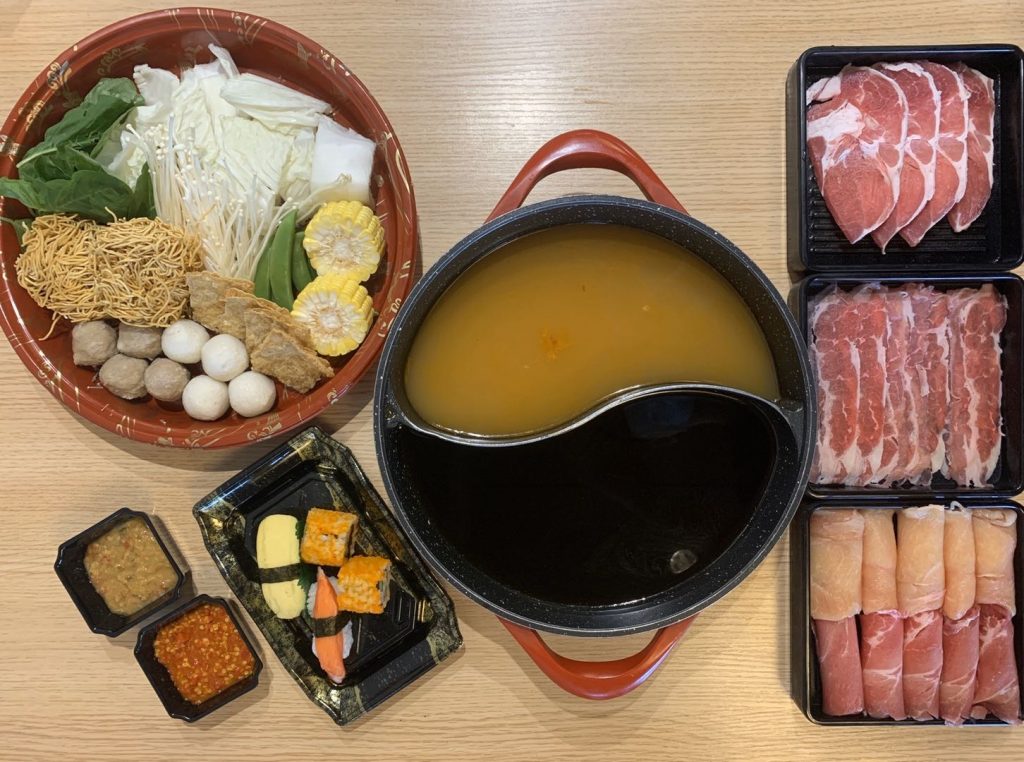
15. Shabu-shabu
Shabu-shabu is a hotpot dish that’s a big part of japanese food culture..
Basically, you cook your food at the table in a large heated pot with boiling water or broth. Some hotpots are split in half, like in the above photo, with each side having a different broth.
Most platters come with a variety of vegetables, seafood and thinly sliced meat, as well as dipping sauces, spices and garnishes so you can play with the flavours and heat.
Shabu-shabu is a fun Japanese dining experience to enjoy with friends and family. The idea is that you take your time and socialize around this bubbling hotpot. You dip your meat or vegetable as needed, rather than all at once. It’s a must try Japanese cultural experience for your Japan holiday.
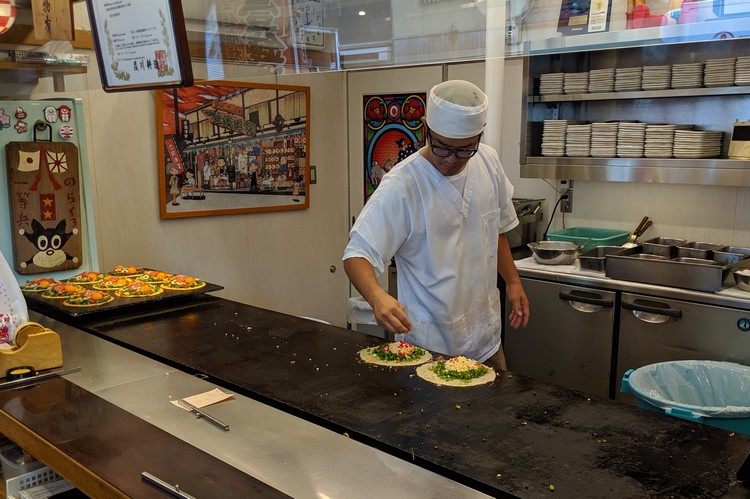
16. Okonomiyaki
Okonomiyaki is a japanese savory pancake with a variety of ingredients..
It’s a popular food in Japan for tourists because it’s a uniquely Japanese. There are different types of okonomiyaki throughout Japan, with toppings and batters varying depending on the region.
Okonomiyaki is mainly associated with the Kansai or Hiroshima areas of Japan, though it’s said to have originated in Osaka. It is sometimes compared to an omelette and may be referred to as a Japanese pizza or Osaka soul food .
The Kansai style okonomiyaki is the most common version found throughout Japan and typically contains meat (thinly cut pork belly or bacon), octopus, squid, shrimp, vegetables, green onion, and/or cheese. We prefer the Hiroshima style okonomiyaki because we like the ingredients to be layered, rather than mixed.
There’s also a semi-liquid okonomiyaki found in Tokyo called monjayaki. The ingredients in monjayaki are finely chopped and mixed into the batter before frying.
Here’s a list of the best Okonomiyaki in Kyoto.
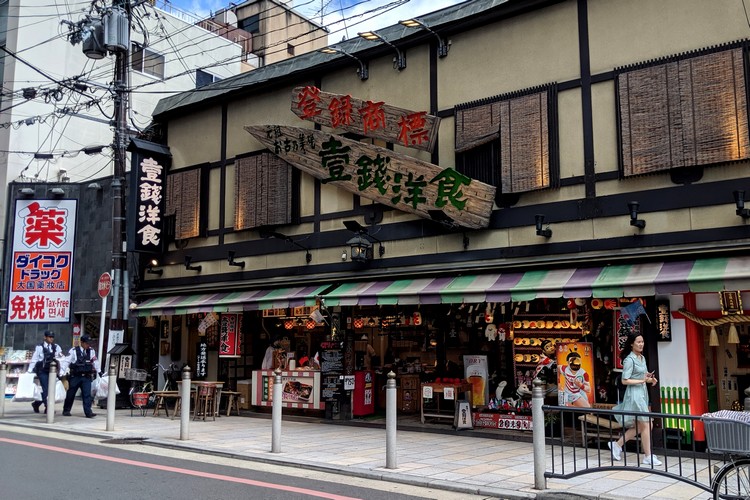
Issen Yoshoku is a famous okonomiyaki restaurant in Gion, Kyoto.
While the savoury pancakes are delicious, this okonomiyaki restaurant in Kyoto might be more famous for its statue at the front entrance. See photo below.
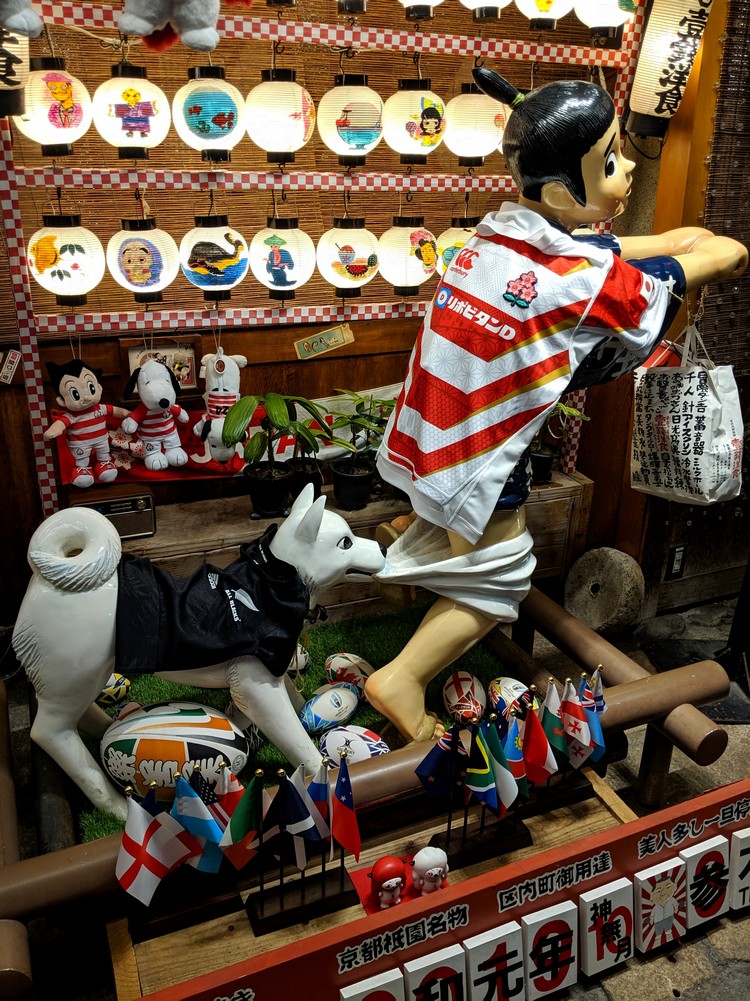
When we visited Kyoto a decade ago, we stumbled upon this funny statue of a boy getting bitten by a dog with his pants down in front of a restaurant. We thought it was an odd statue, so we took a photo.
When we returned last year, we stumbled upon it once again, by pure chance. Of course, we had to take another photo to capture the memory. This time, the boy is wearing a Japan rugby jersey because we visited for the Japan Rugby World Cup .
While thousands of people may have a photo of this strange statue, few will have a photo of it decorated for the Japan Rugby World Cup.
Related – Our experience at the Rugby World Cup in Japan
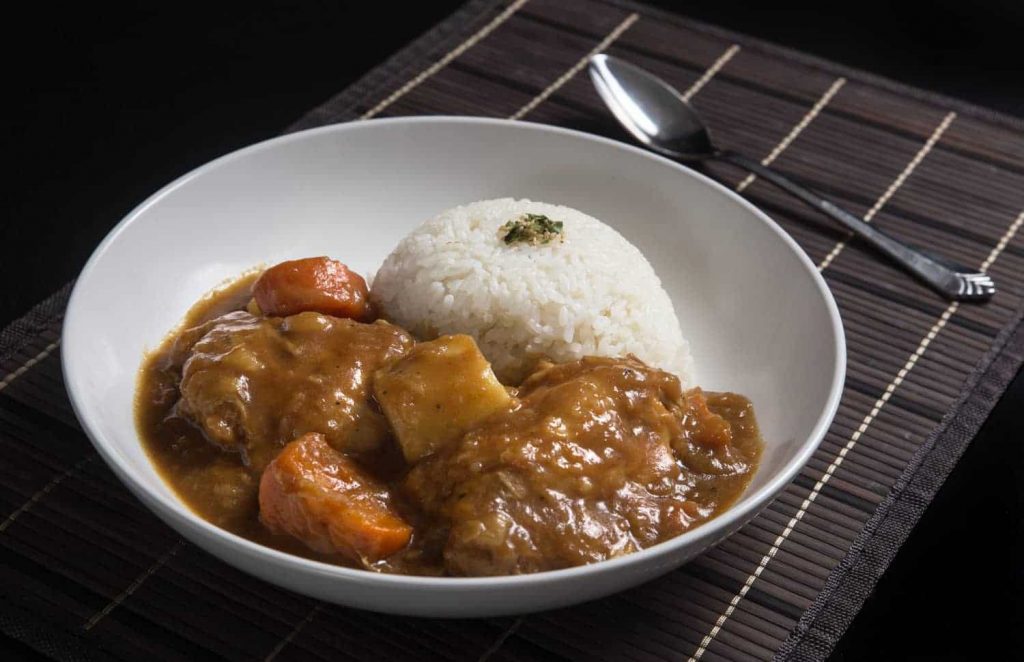
17. Kare Raisu (Japanese Curry Rice)
When we think of Japanese food, rarely does curry come to mind. That’s why we were surprised to see how popular kare raisu is throughout Japan.
Japanese curry rice tastes different from the curry you find in India or Southeast Asia. The main ingredients for Japanese curry are a variety of meats (chicken, pork or beef), vegetables (onions, carrots and sweet potatoes/yams) and spices. We found Japanese curry to taste more like a thick gravy with a curry flavour.
We’re told that kare raisu is a good example of yoshoku , which takes dishes from Western culture and adapts them to meet Japanese tastes and preferences (fusion cuisine). Japanese curry rice is an inexpensive Japanese dish that can easily be found throughout Japan.
We enjoyed Japanese curry rice for lunch when we visited Tokyo Disneyland .
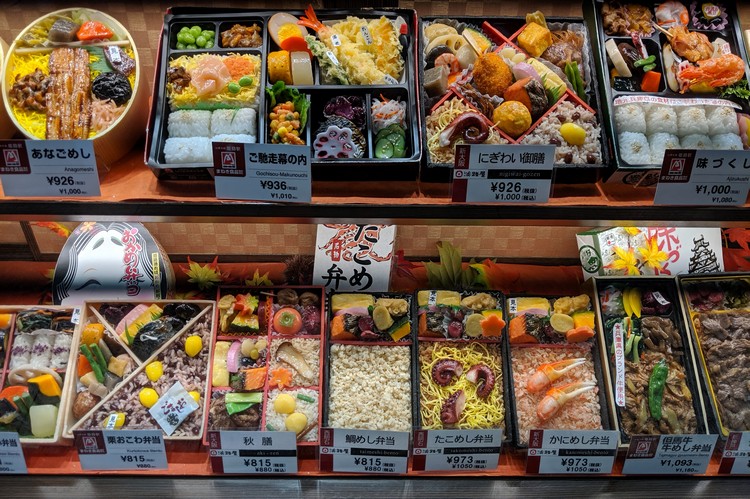
18. Bento Box
If you have not tried a japanese bento box, you are missing out. .
There are literally hundreds of varieties of bento boxes in Japan. A bento box is typically a single portion takeout or prepackaged meal, however you can also order bento boxes at restaurants. A typical bento box has a balance of dishes, most often including rice, meat or fish, and pickled vegetables.
We often order bento boxes for lunch at sushi restaurants because they offer a variety of items to sample.
During our travels in Japan, we would pick up bento boxes and bring them back to our hotel room or apartment rental. They are convenient, inexpensive and mostly healthy. Bento boxes are also a great way to sample a variety of side dishes that you might not have ordered otherwise.
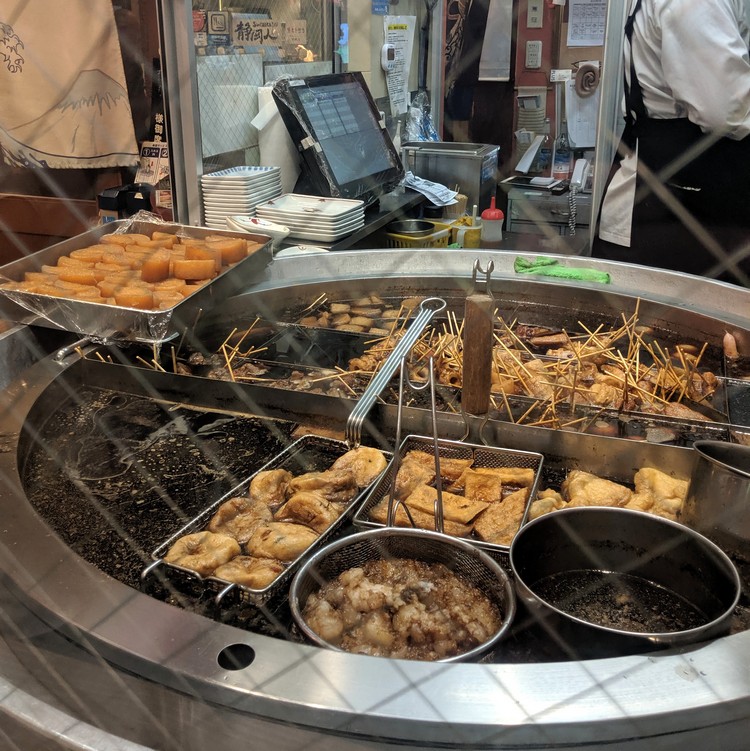
19. Oden (Japanese one-pot dishes)
Oden is an interesting part to Japanese food culture. It’s a common food in Japan that gets mixed reactions from tourists and first time visitors.
Basically, oden is a type of hotpot with an assortment of vegetables and proteins, including sausages, processed fish cakes, mochi rice cakes, daikon radish, konjac yam, tofu, and boiled eggs, to name a few. These items are stewed in a light broth and served to order. Ingredients vary according to region.
As a tourist, we had a hard time deciphering each item. In the photo above, this restaurant has a variety of items soaking in a hot broth. Guests walk up to the window and order items to take home.
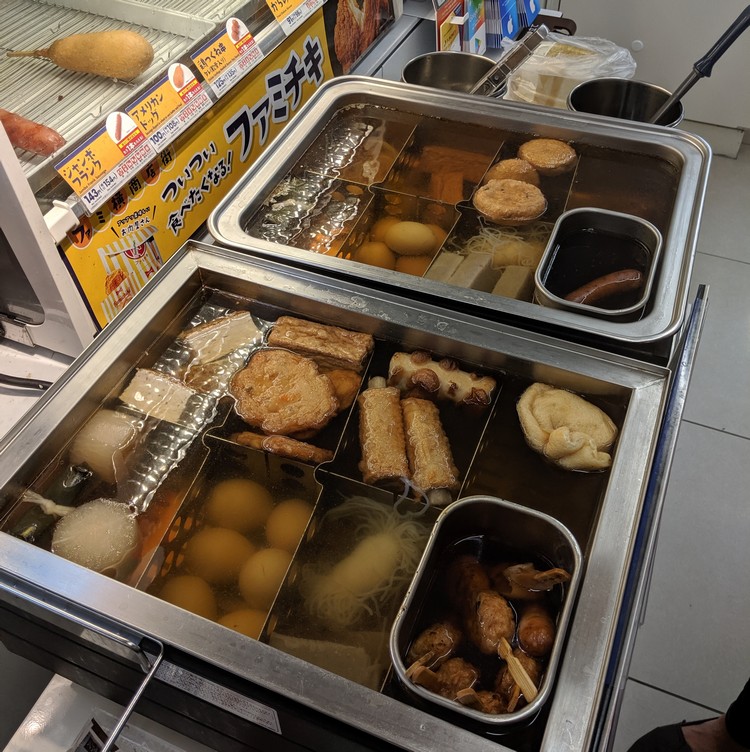
Oden at Convenience Stores in Japan
Most convenience stores in Japan will have oden during the winter months. You typically find this food at the front of the store, near the cashier. The most common convenience stores in Japan are Seven Eleven, Lawson and Family Mart.
You will find at least one of these convenience stores on virtually every block in the city. Purchasing premade food items at convenience stores is an easy way to travel cheap in Japan.
In some stores, an employee will serve you. In other stores, you help yourself. You simply take a bowl and add the specific items you would like. It’s common to add broth to the bowl to keep your items hot.
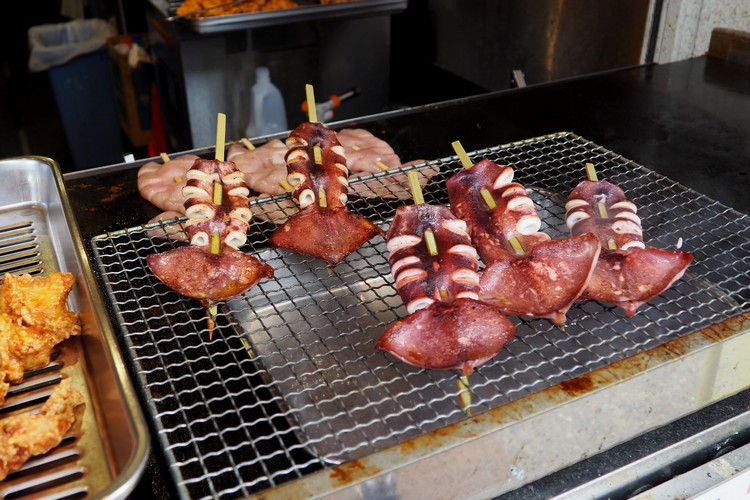
20. Street food at Japanese markets
There’s no shortage of interesting japanese cuisine at food markets in japan..
We like visiting markets when we travel because they provide insight into the food culture of a country. They typically have several vendors selling a wide variety of food items, so they’re a great place to let your curiousity run wild.
Some of the popular temples in Kyoto have rows of vendors selling grilled meats and traditional Japanese quick eats, like yakitori, grilled squid (above photo), takoyaki, hanami dango (sweet rice balls) and deep fried pastries.
If you’re looking for food to try in Tokyo, check out this list of the best food markets in Tokyo.
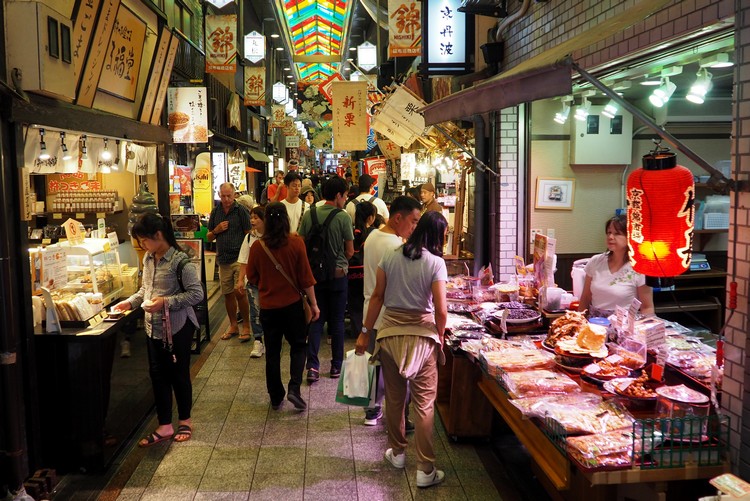
Nishiki Market in Kyoto
Known as Kyoto’s Kitchen , Nishiki Market is a great place to sample food in Japan. It’s a narrow, five block long shopping street that specializes food related items, like fresh seafood, grilled meats, produce, pickled food, dried foods and sushi.
If you’re unsure of what to try in Kyoto, Nishiki Market is a great place to start.
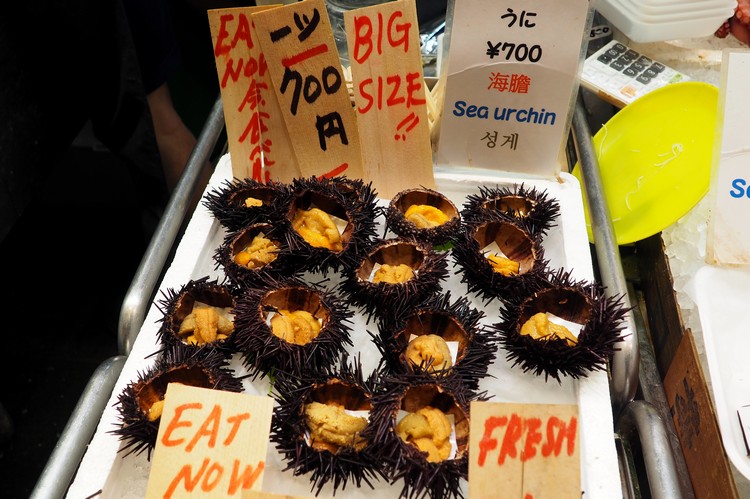
Ready to eat sea urchin at Nishiki Market.
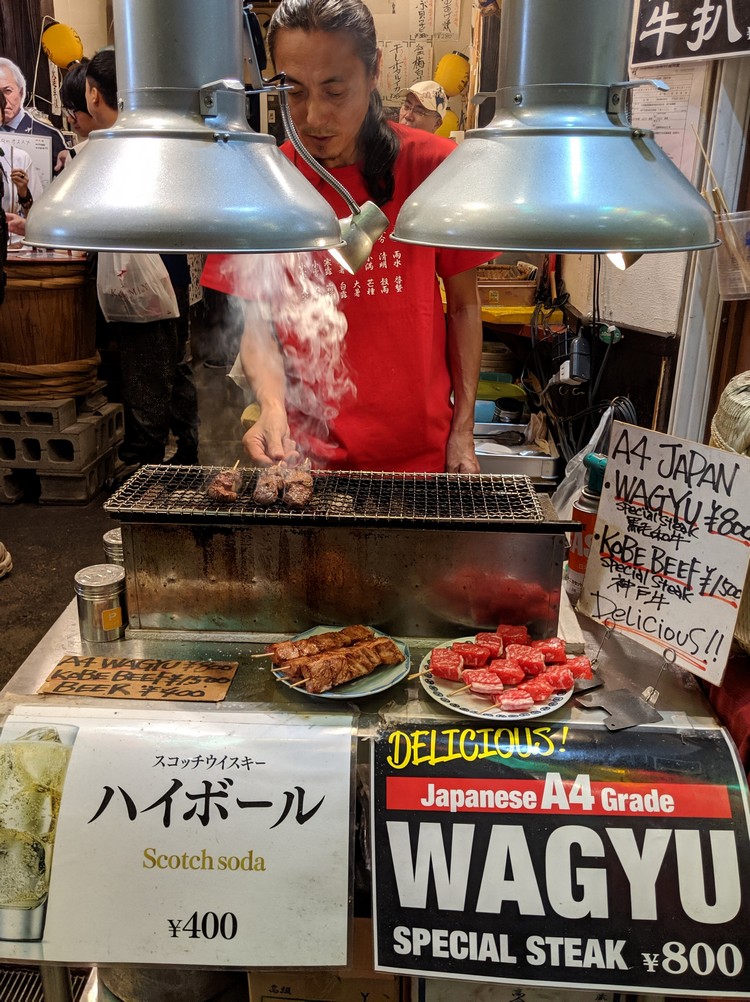
Grilled wagyu beef on a skewer at Nishiki Market in Kyoto.
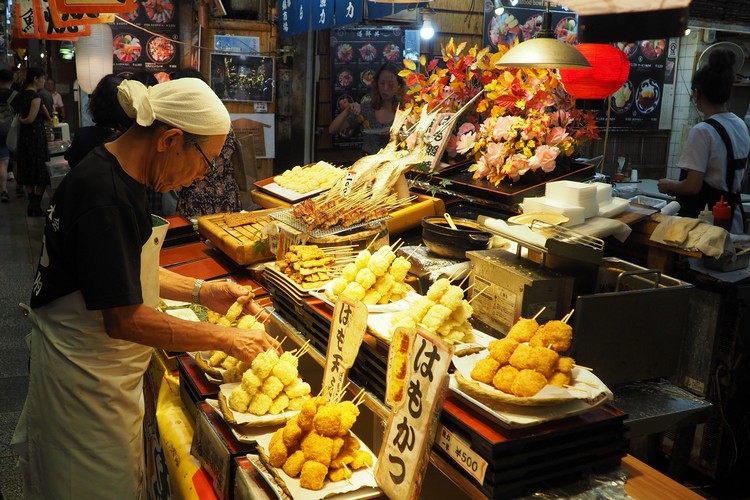
This vendor is selling a variety of steamed and fried food on a stick.
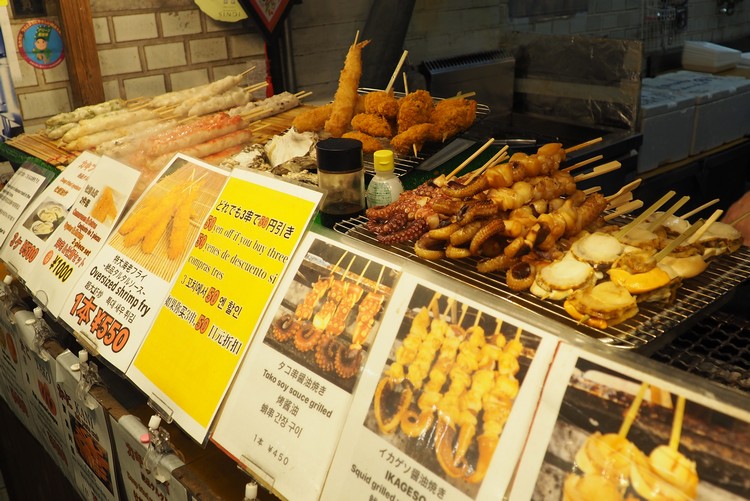
We like visiting small food vendors that sell a wide range of bite size items. It’s quick and easy way to try several different items.
Most vendors at Nishiki Market have English menus, which makes it easy for tourists to understand what they’re ordering. Each item costs between 400-800 yen, which is about $5.00 to $10.00 CAD.
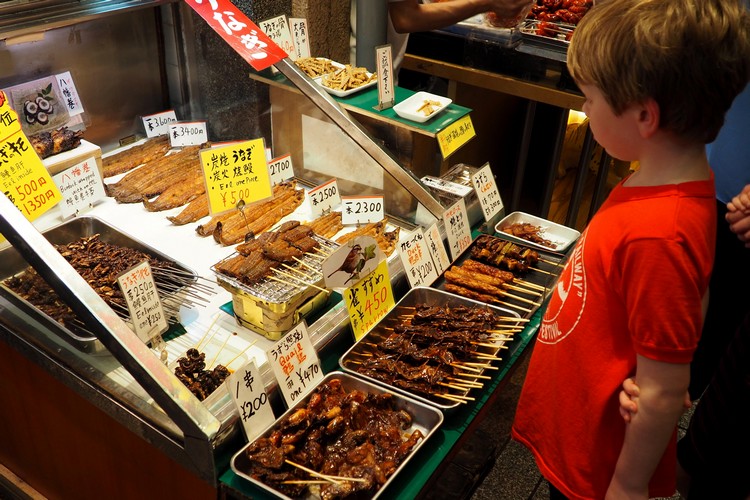
He’s not sure about these interesting food items on display at the market.
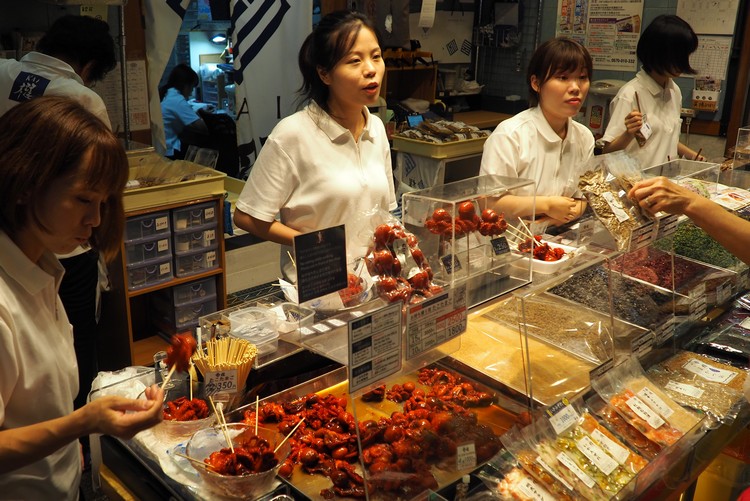
Sweet baby octopus with an egg brain?
One of the most popular and eccentric street food snacks found at Nishiki Market is Tako Tamago, which is a little red octopus on a stick.
The glazed baby octopus have a quail egg stuffed into the head, which makes for a unique flavour combo. The baby octopus has a sweet, candy-like flavour and the egg has a mushy, hard boiled egg texture. It’s quite rubbery and chewy. Not my favourite, but not too bad, either.
It’s certainly one of the more unique foods to eat in Japan, though I’m pretty sure most tourists purchase these little red octopus on a stick for the novelty. Because, let’s be honest, it’s not every day you get to eat an entire octopus on a stick, am I right?
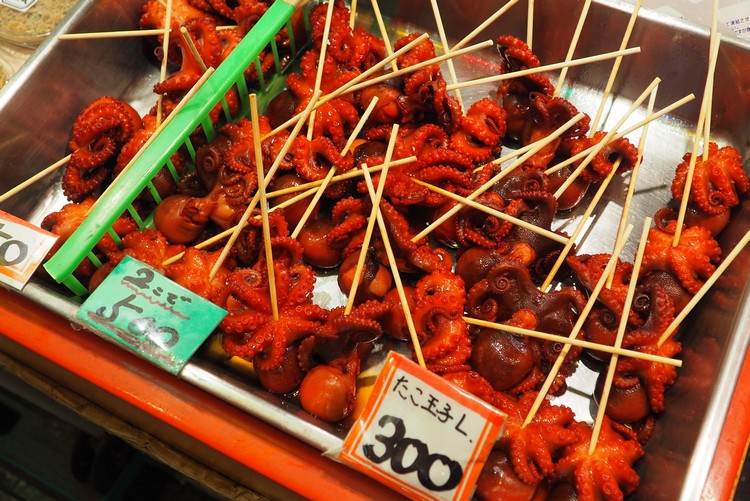
Dozens of vendors sell the popular red octopus on a stick at the popular Kyoto market.
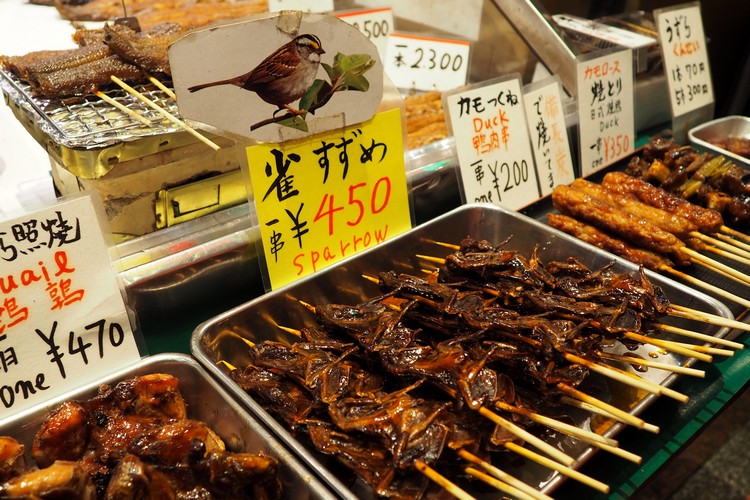
Another strange food in Kyoto is the grilled sparrow bird on a stick.
We’re told that grilled sparrow is a Japanese delicacy, but we couldn’t stomach eating this bat-like bird on a stick.
Have you tried grilled sparrow on a stick? Did you like it? Leave us a comment below.
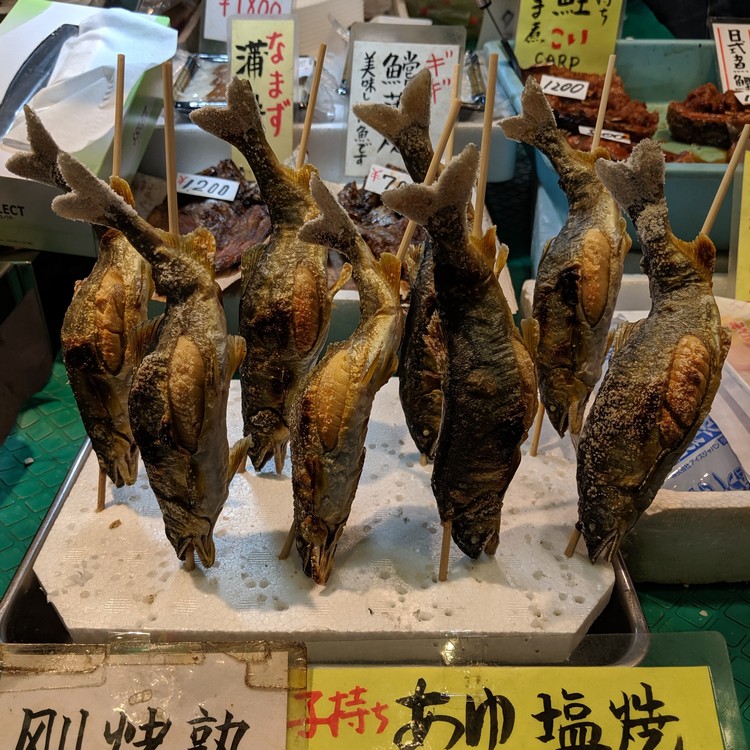
Salted fish on stick? This particular item stood out to us because we don’t often consider eating an entire fish, including the skin, tails, eyes, gills, bones, etc. I’m sure there’s a graceful way to tackle this fish without consuming everything, although I’m not sure this fish stick is for me.
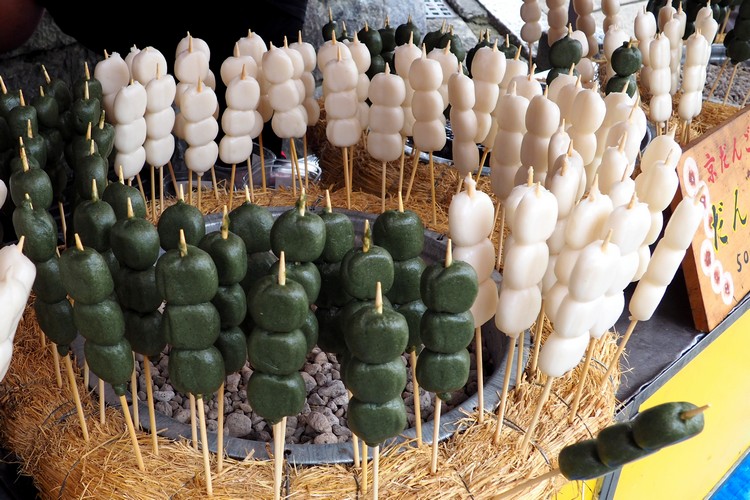
Dango is a popular Japanese sweet dumpling, similar to mochi. It’s typically served on a skewer with 3 balls per skewer. We sampled these green dango skewers near the entrance to Fushimi Inari Shrine in Kyoto.
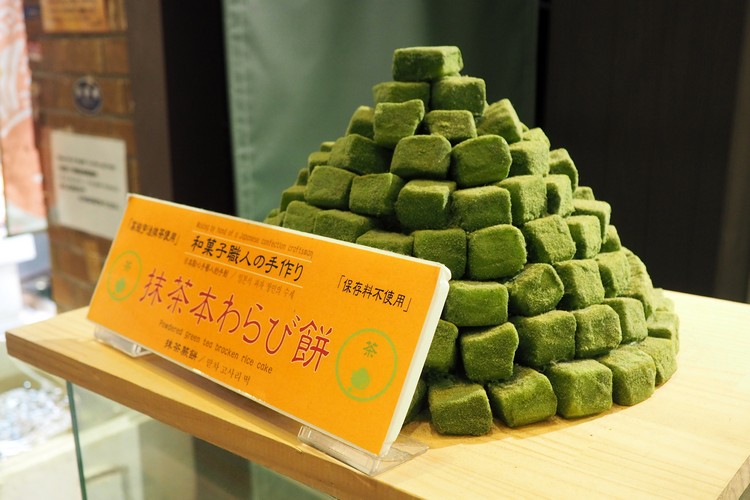
Matcha sweet rice cake on display at Nishiki Market. Matcha green tea is a big part of Japanese cuisine. You will find matcha flavoured everything in Japan, from chocolate bars to potato chips to ice cream.
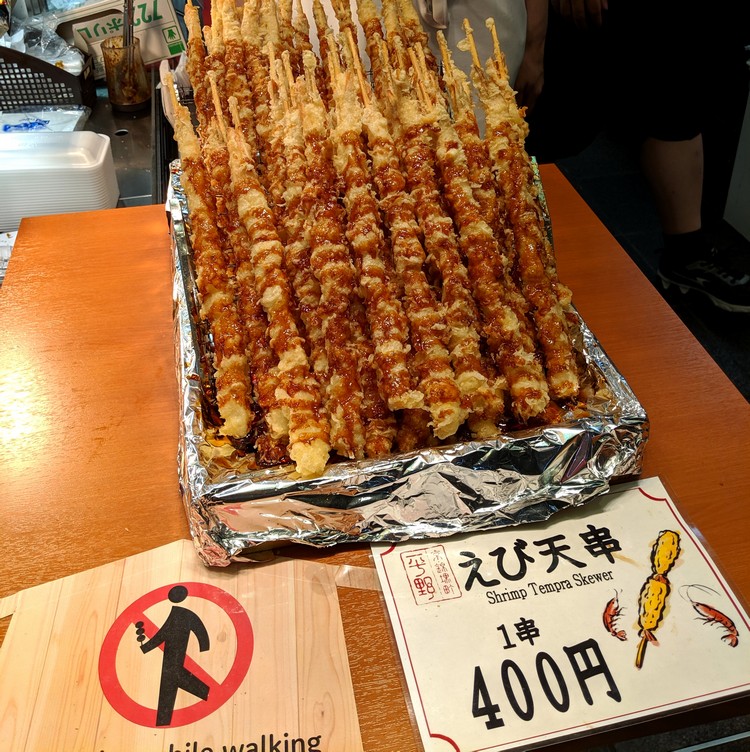
Is it okay to walk and eat in Japan?
Unlike north america, it is considered rude to walk and eat at the same time..
First time visitors to Japan will quickly learn that walking and eating in Japan is frowned upon. If you purchase food from a market or street vendor, the expectation is that you will NOT walk down the street or market while eating your food.
This applies to food purchased at convenient stores, like 7 Eleven and Family Mart. It is acceptable to eat at the place of purchase or close to the store. There’s usually a designated area for eating. If not, you will need to find an acceptable place to eat your food or bring it back to your hotel and eat it there.
Park benches in public spaces are generally okay, but avoid eating messy or strong smelling foods. It is also acceptable to drink while standing beside a vending machine.
Eating and drinking on local trains and public transportation is frowned upon. However, eating food on long distance express trains, like the Shinkansen, is acceptable.
Learn about the Do’s and Don’ts of Japan travel .
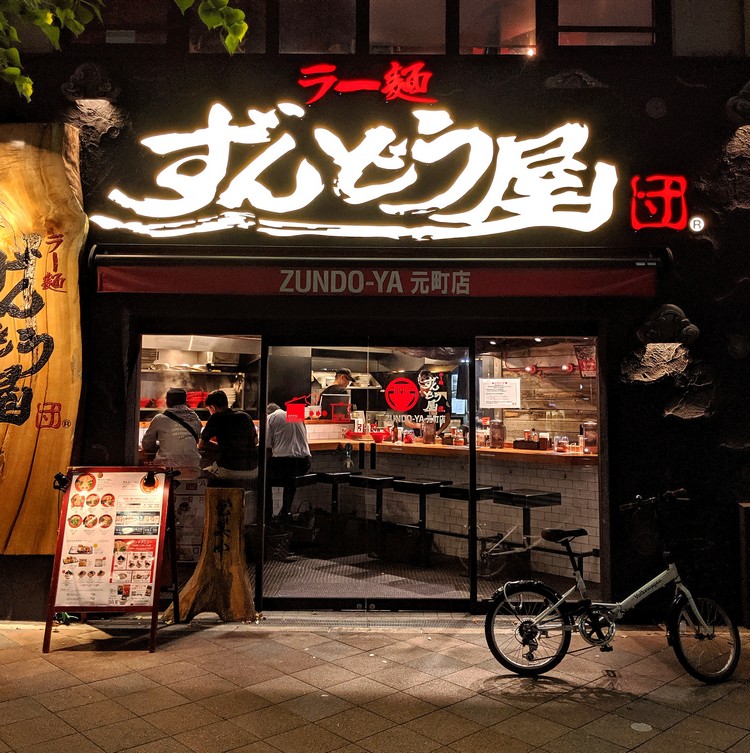
Do NOT tip at restaurants
One of the most common questions for first time visitors is – do you need to tip in Japan?
Tipping is not expected in Japan. In some cases, it’s actually considered to be rude.
This is one of the best Japan travel tips we can give – you do NOT tip in Japan.
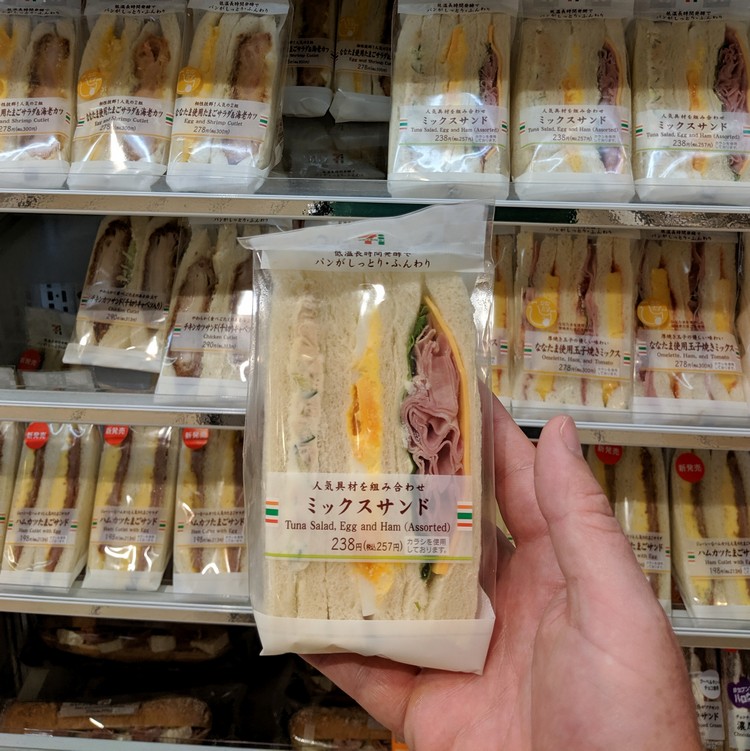
Food from convenience stores in Japan
We rarely eat at convenience stores in Canada, unless we’re on a road trip or there aren’t other food options available. In Japan, eating at convenience stores is quite common.
Japanese convenience stores have a good selection of prepared food, from sandwiches to bento boxes to baked goods. We often grabbed prepackaged sandwiches (picture above) and pastries for breakfast each morning.
One of the most popular snacks to eat in Japan is Onigiri . Onigiri are rice balls formed into triangular or round shapes and wrapped in seaweed (nori). Some are filled with fish (tuna, salmon, mackerel, shrimp, etc), chicken, pork, vegetables, egg and fried food, like tempura and tonkatsu. Onigiri is a cheap Japanese food that’s is easy and widely available at almost every convenience store in Japan.
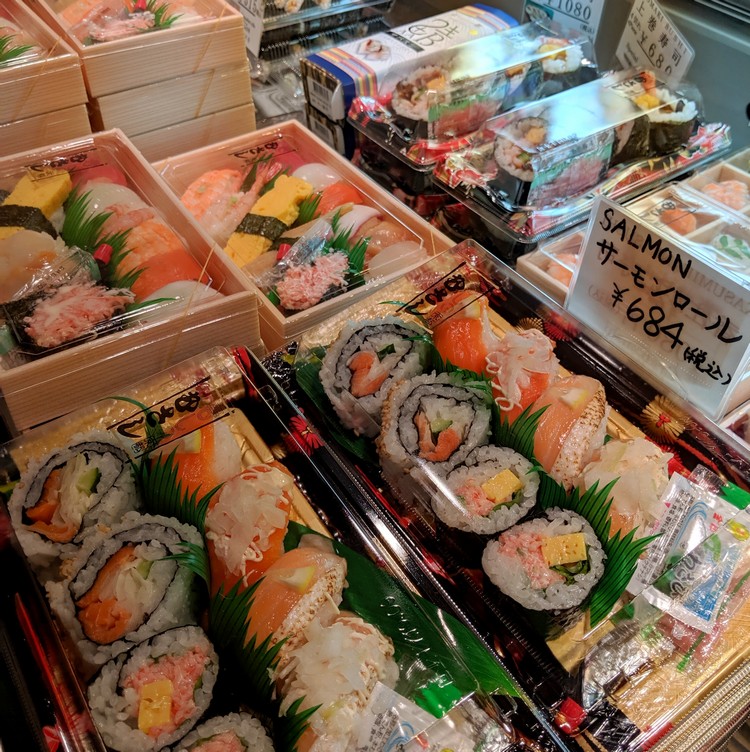
Variety of prepackaged sushi rolls and nigiri combos at the Kyoto train station.
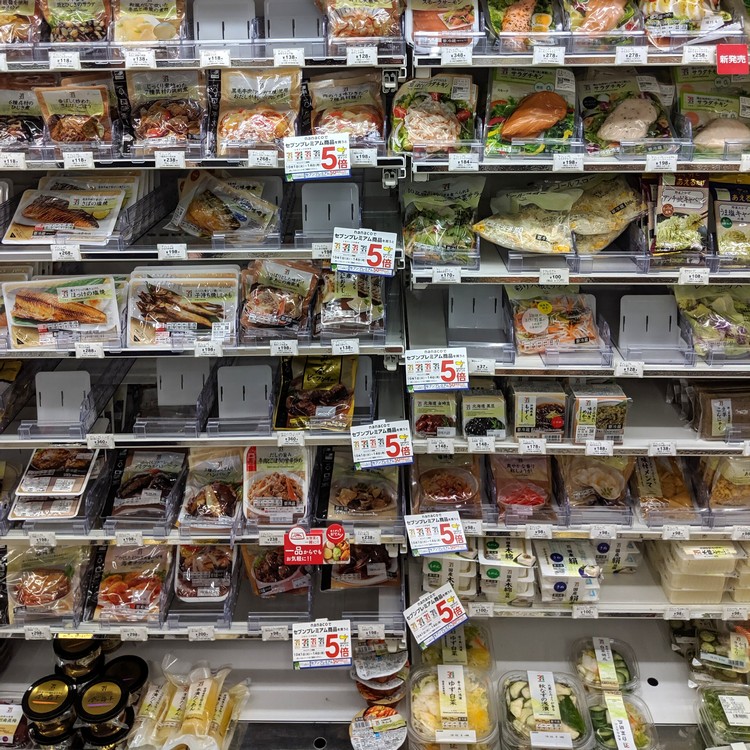
Convenience stores in Japan have plenty of prepackaged meals available for takeaway.
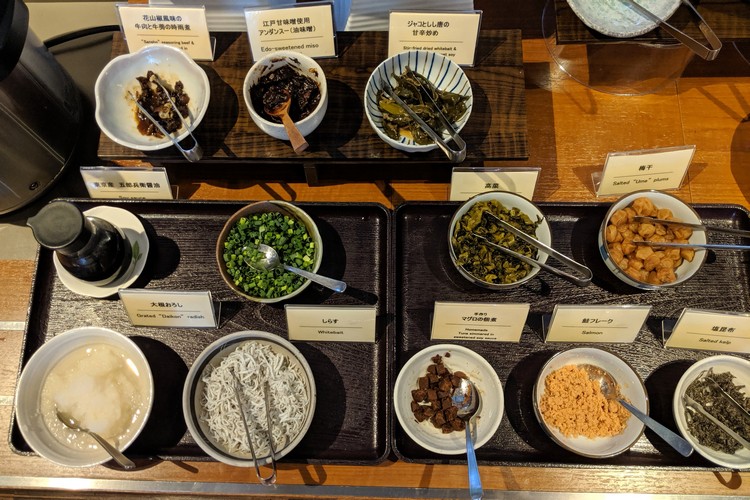
Japanese Breakfast at Hotels
I though it worth mentioning the hotel breakfast situation in Japan, given that many European travellers expect breakfast to be included with the hotel price.
Depending on your hotel, breakfast may be available. But don’t expect breakfast to be included in the hotel room price. Some budget hotels will not have breakfast available at all.
Japanese breakfast is quite different from North American and European breakfast.
Typically, a traditional Japanese breakfast consists of steamed rice, miso soup, grilled fish and a variety of side dishes. You will find a lot of pickled vegetables, garnishes, dried food and other items that you might not associate with breakfast.
This is a great way to sample new flavours and items you might not order at a restaurant. Ask questions and give the Japanese breakfast items a try. You never know, you might just like fermented soy beans (natto) and dried horse mackerel for breakfast?
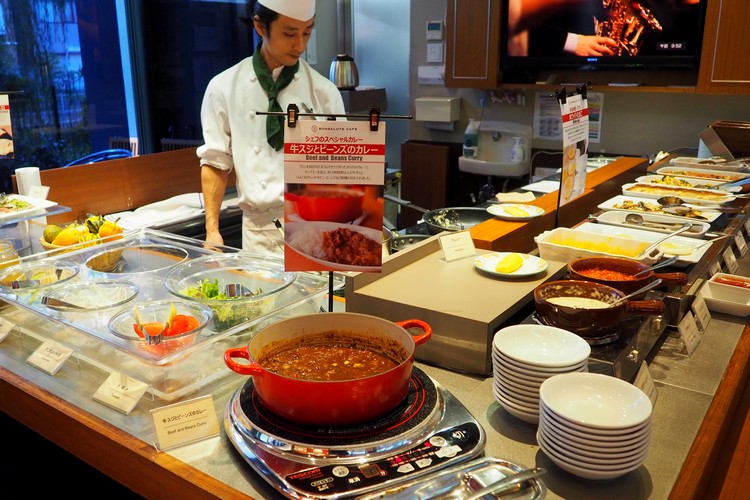
The breakfast buffet at the Hotel Gracery Tamachi in Tokyo.
Order your food from a Vending Machine
One of the things we love about Japan is that everything is efficient and convenient. A perfect example of this efficiency is the electronic vending machines located outside many Japanese restaurants.
The touch screen machines often have photos of each dish, which is convenient and avoids the potential language barrier that may arise if you had to order from a server who does not speak English.
The process is simple. You select the food you want from the touch screen machines, pay with cash or credit card, grab your receipt and head inside. The food is then delivered to your table or your number is called and you pick it up from the counter.
Once you are finished eating your meal, you simply get up and leave. No need to wait for a server to bring the bill or wait to pay. It’s a very efficient system that removes service breakdown.
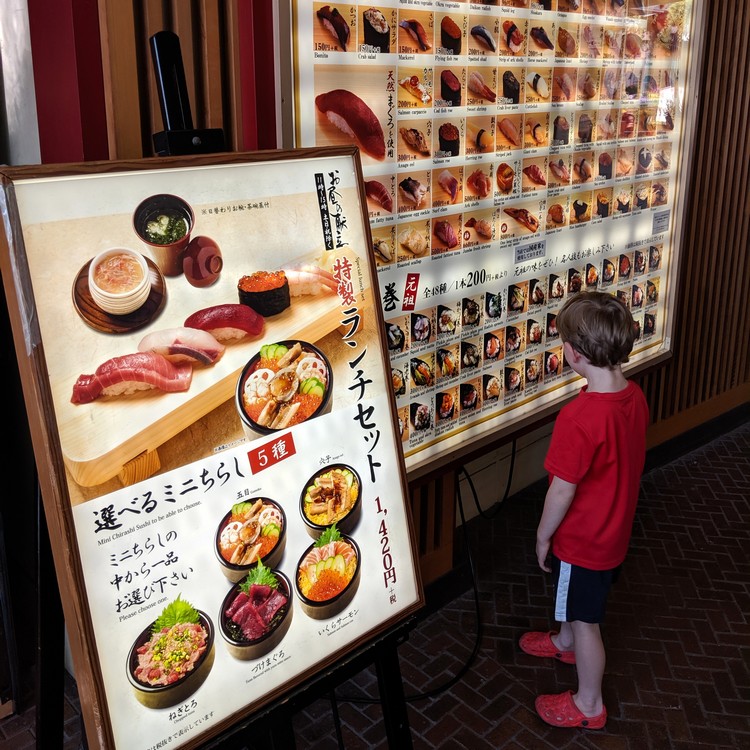
Food in Japan for kids
If you’re travelling to Japan with kids, you’re liking concerned about whether your kids will enjoy the food in Japan. There’s nothing worse than constantly battling your kids to eat.
Our boys like Japanese food, so we knew they would like eating at Japanese restaurants. However, our concern was that after a few days they would get bored and start complaining.
Fortunately, Japanese food is quite diverse and, as you’ve seen in this beginner’s guide to food in Japan, there are plenty of options to choose from.
Travel tips for eating in Japan with kids
- Shop at convenience stores. Pick up prepackaged food, snacks, pastries and drinks from convenience stores and bring them back to your hotel room. You don’t have to dine out for every meal. Give yourself a break if your kids are burnt out.
- Vending machines are everywhere in Japan. Keep some change in your pocket because you’ll find these vending machines do the trick when your kids are thirsty.
- Look at the plastic dishes in the window. Most Japanese restaurants have plastic replicas on display. Let your kids see the available options and pick a dish that interests them before you enter the restaurant. That way there’s no confusion over what to order when you sit down.
- Download Google translate. When you have a Lost in Translation moment, ask the Google for help.
- Eat breakfast in your hotel room. We purchased a bag of Frosted Flakes from a Family Mart and our boys had cereal for breakfast each morning. It saved us time and money.
- Bring snacks from home. Pack your luggage with your kid’s favourite snacks, treats and cereal. Sometimes a familiar treat is all it takes to get your kids feeling normal again.
- There are lots of fast food restaurants in Japan. Sometimes chicken nuggets from McDonald’s is the answer. We get it. Don’t worry, Japan has most of the big names in fast food. It’s okay to give yourself some comfort food from home when you’re travelling.
Read these helpful Japan travel tips for first timers .
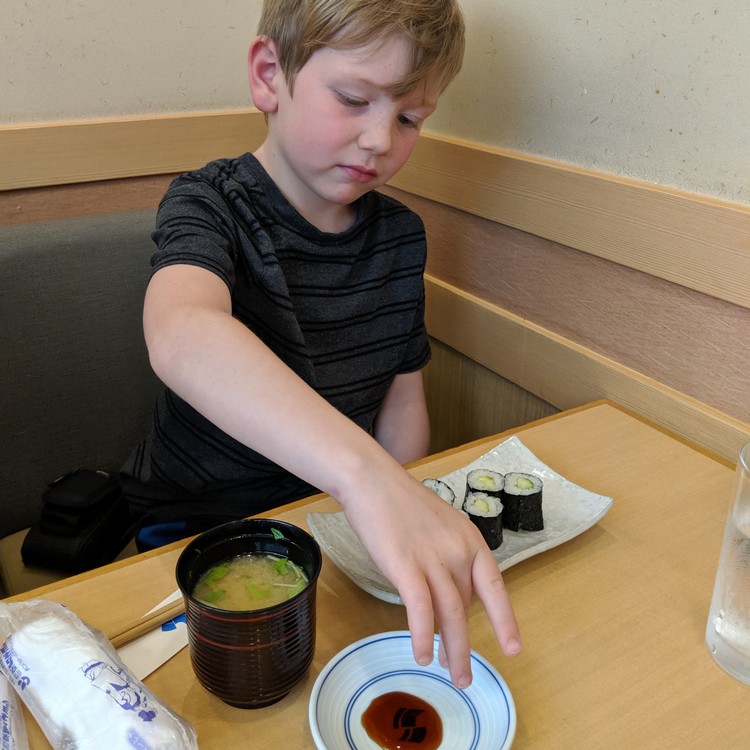
For an easy introduction to sushi, order your kids the cucumber roll (kappa maki) with a miso soup. Let them play with the chopsticks and experiment. If they don’t like the sushi roll, no big deal. These are typically the cheapest items on the menu.
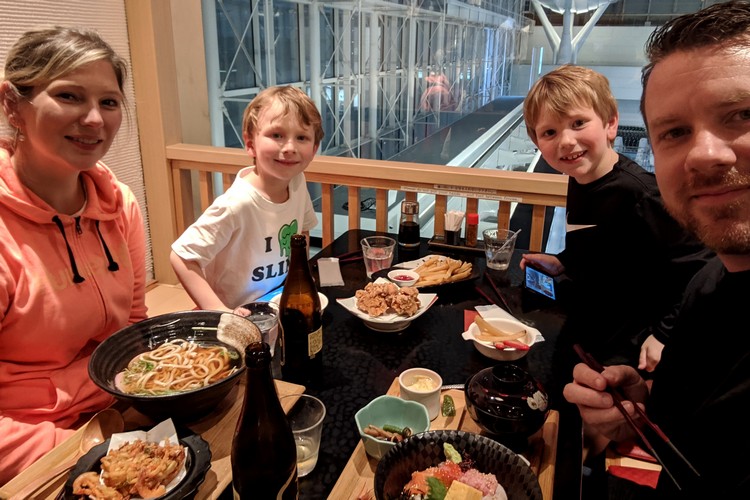
Most Japanese restaurants that serve chicken karaage will also have French fries on the menu. We told our boys that we ordered them chicken nuggets and fries. They rarely noticed the difference.
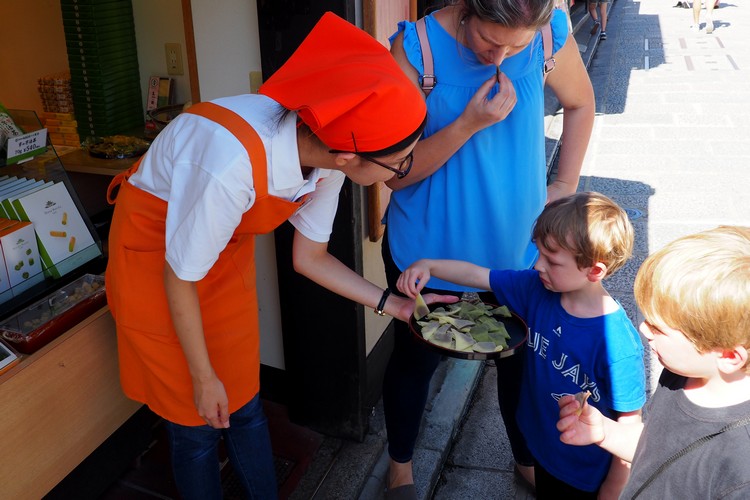
Our boys did pretty good at trying new food. Like most kids, their natural default is to resist food that is different or foreign. However, the more Japanese food they tried, the more comfortable they got.

Don’t worry, if your kids don’t like the food in Japan, there’s always donuts!
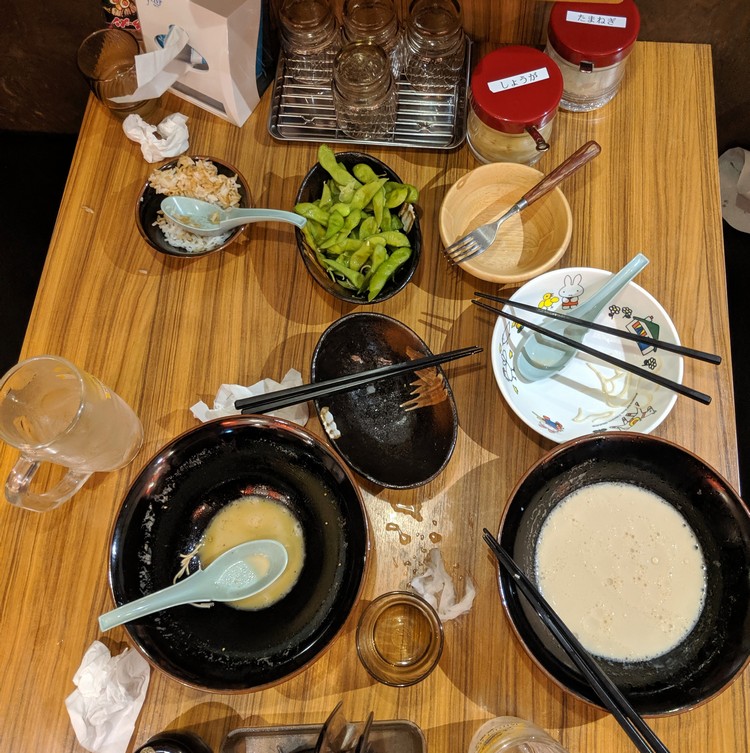
And that’s a wrap! We hope you enjoyed this tasty beginner’s guide to food in Japan.
More blog posts from our trip to Japan:
- How to spend 3 days in Tokyo: Travel guide for first time visitors
- Staying at Tokyo Disney Resort – what you need to know
Have you visited Japan? What is your favourite food in Japan?
Leave a comment below. Our readers thank you!
Related posts:
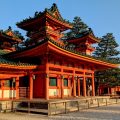
10/20/2020 at 3:33 pm
Very good presentation of food in Japan! Having family in Tokyo we have been traveling around Japan the last 8 years, so I find this post the best about your experience in Japan! It is a pleasure to follow you ,thank you for sharing your travel experiences! You inspired us to go to some places in BC! And it was worth it…We can’t wait to take our grandchildren living in Tokyo to some places where you have been traveled with yours! Wonderful travel blog!
12/21/2020 at 7:14 pm
This is a great intro to Japanese food! Japan is obviously one of the great places to try new things!! And it looks like you and your family tried a lot!! Thanks for sharing and happy #TravelBlogTuesday 🙂
02/19/2021 at 3:31 pm
What a great source and extensive knowledge of food from here. A great read and will certainly be using the post in the future
07/19/2021 at 5:53 am
What a fabulous post about food in Japan! Should be required reading for first-time travellers to Japan. Happy travels.
Leave a Reply Cancel reply
Your email address will not be published. Required fields are marked *
Yes - Subscribe me to your monthly newsletter!
This site uses Akismet to reduce spam. Learn how your comment data is processed .
40 Must Try Foods in Japan
Conveniently listed in alphabetical order, here are the top 40 foods in Japan you need to try on your next trip to Japan!
- Japanese Curry
- Kaiseki Ryori
- Okonomiyaki
- Shabu Shabu
- Shojin Ryori
To kickstart your tastebuds with Japanese cuisine, the humble bento box is a great place to begin if you enjoy trying different delicious morsels of food. Bento boxes are lunch boxes in Japan that are generally divided up into different compartments, each with different bits and pieces to eat. Perfect for on-the-go scenarios, generally a bento will include some protein and rice, plus a range of side dishes like pickles and salads. You can easily purchase them at convenience stores, larger train stations, or department store food courts.
Try making your own bento in one of byFood's Bento Cooking Classes !
Donburi is the overarching word in Japanese for “rice bowl.” You can order a range of donburi rice bowls with different toppings, depending on your preference. “Katsu donburi” or simply “katsudon” is one of my favorite donburi bowls in Japan, featuring rice covered with a slab of panko-crumbed and deep-fried pork cutlet surrounded by a soft, soy sauce-flavored omelet with sauteed onions. Oyakodon is a popular variant simmered with chicken and eggs, meaning "mother and child". It’s a delicious and easy lunch when you’re out for a day being a tourist.
Fugu is the Japanese word for pufferfish ! If you’re game enough to step up to the plate, Japan is one of the best places in the world to enjoy this deadly but delicious fish. Many specialty restaurants in Japan have qualified chefs who can prepare the fugu in various ways such as deep-fried or freshly sliced and served as sashimi.
Originally introduced to Japan from China, gyoza is the word for dumplings in Japanese. Typically filled with a mix of meat or veggies and the right seasonings, these bite-sized dumplings are crunchy on the outside and juicy on the inside. Cooked to perfection on a sizzling hot plate, gyoza goes perfectly with a cold glass of Japanese beer or a steaming bowl of ramen.
Learn how to make gyoza yourself in a Gyoza Cooking Class !
Translating to mean “beef bowl,” gyudon is a rice bowl topped with juicy strips of thinly sliced beef and onions simmered in a sweet soy sauce flavor. With scallions, pink pickled ginger and an oozy onsen-style soft-boiled egg on top, it’s a hearty, homey and affordable meal in Japan you can find sold at many Japanese fast food chain stores. Just order from a vending machine and sit down alongside salarymen having a quick bite to eat after a long day at the office.
Join this Japanese Beef Bowl Experience to create your perfect gyudon.
6. Japanese Curry
The concept of curry was introduced to Japan in the Meiji era. Since then, Japanese curry has evolved into its own special dish with a local twist. With a gently spiced flavor and gravy-like texture, Japanese curry consists of a fluffy bed of rice doused in a generous serving of deep brown Japanese curry roux. Sometimes served with potatoes, carrots, and meat in the curry, it pairs well with a side of pickled ginger to cut through the rich curry flavor.
You can buy instant Japanese curry roux and easily make it yourself at home, too.
7. Kaiseki Ryori
Kaiseki Ryori or kaiseki cuisine is an opulent banquet-style meal in Japan. If you’ve got some cash to splash, it’s a wonderful experience featuring a series of individual Japanese dishes served up throughout the meal. Served with beauty and an essence of tranquility, each dish focuses on a different cooking technique such as frying, simmering, raw and more. Often set in a tatami room or a luxury restaurant venue, menus are carefully designed by the chef and the ingredients of a kaiseki meal are usually influenced by seasonal and local ingredients.
8. Kaisendon
With “kaisen” meaning “seafood” and “don” referring to “bowl”, a kaisendon is a rice bowl in Japan that’s topped with fresh, raw seafood. Best enjoyed at bustling seafood markets, these rice bowls can have a mix of seafood sashimi slices placed delicately on top of the bowl, or you can order ones that focus more on one ingredient such as salmon or fatty tuna.
Karaage is Japan’s fried chicken! With a moreish seasoned batter to encase the succulent chicken, it crisps up perfectly in a deep fryer while keeping the chicken inside moist and juicy. A delicious snack at any time of day or night to munch on (best with a frothy Japanese beer), karaage is an accessible and tantalizing food for everyone!
Matcha is Japanese green tea, typically founded in tea houses and whisked up to be served during a Japanese tea ceremony. While being a cultural drink, you’ll also find many matcha-flavored sweets throughout Japan such as mochi, ice creams, cookies, and more! No longer bitter when balanced with sugar, it can be divisive or delicious, depending on the tendency of your tastebuds.
The best way to enjoy match is by attending a Japanese Tea Ceremony .
11. Miso Soup
Made using fermented soybeans, warm miso soup is a common accompaniment to most meals in Japan. Somewhere between a clear and cloudy broth, miso soup will sometimes also have pieces of tofu, scallions or other additions floating around in it. Some ramen dishes will feature a miso-heavy soup broth as well, and red miso is particularly famous in the city of Nagoya with their rich slathering of miso on all sorts of dishes.
With both sweet and savory types you can try, mochi is the blanket word for “Japanese pounded rice cakes.” There are many types of such sweets including plump, sweet red bean-filled daifuku mochi pieces, triangular yatsuhashi style mochi from Kyoto, or kinako mochi sprinkled with pale brown powdered soybean dust.
Unsweetened mochi can be eaten with soy sauce and nori seaweed, or softened in miso soup. It’s a versatile but essential Japanese food you should try if you like its stretchy and chewy texture.
Make your own squishy treats in a Mochi Making Class .
13. Monjayaki
Monjayaki is the more liquidy cousin to okonomiyaki, the traditional savory cabbage pancakes that hail from the Osaka-Kansai region. With a similar but runnier batter, monjayaki is a mix of cabbage, meat and other finely cut ingredients sizzled on a teppanyaki hotplate. These savory pancakes have a different, finer texture to regular okonomiyaki slabs.
“Nabe” is a simmering Japanese hotpot . It’s a fun group activity where a communal hotpot stands in the middle of the table, bubbling with a rich broth brimming with your favorite ingredients. The broth becomes richer over time as more ingredients get added, and you can continue to top up the simmering ingredients as you go. Soy sauce, miso and other milky style broth flavors make nabe different every time.
Not for the faint of heart, natto is a healthy and nutritious Japanese food that can be divisive for its sticky, stretchy texture. Almost nutty in essence, natto is actually made from soybeans fermented with a special bacteria which gives its signature stringy characteristic. Natto is commonly eaten for breakfast in Japan with rice and sometimes a raw egg. Its taste and smell is certainly acquired, but certainly something unique and full of protein to start your day in Japan.
Simmered in a light soy sauce broth, oden is a seasonal Japanese dish that consists of a range of fish cakes and meatballs. Eaten as a light, umami-rich broth with your favorite type of fish cakes, it’s warming yet bright. You will often find oden available at festivals or convenience stores in a sort of Japanese bain marie, with all the different items warming in their soup. You can choose what you like, pour yourself some soup, and pay per piece.
17. Okonomiyaki
One of the most important dishes from Osaka, okonomiyaki are Japanese savory pancakes. Incredibly moreish and fun to sizzle on a hotplate at a cook-it-yourself restaurant, okonomiyaki is generally made from a batter of eggs, cabbage, bamboo shoots, tempura pieces, scallions, pickled ginger, and your choice of protein.
Mixed with flour and grilled in large circles, you can cut them like pizza slices once they’re flipped and cooked through. Best topped with mayonnaise, okonomiyaki sauce, more scallions and katsuobushi bonito flakes, okonomiyaki are a must-eat in Japan.
Okonomiyaki is an easy recipe perfect for beginners to Japanese cooking. Learn how to make one yourself in an Okinomiyaki Cooking Class .
18. Omurice
Omurice is a warming meal that appeals to all ages. Meaning “omelet rice,” omurice is a bed of tomato-sauce-based fried rice wrapped in a soft, eggy omelet. Add more tomato sauce or a drizzle of demi-glace over the top and voila! It’s ready to be enjoyed by the whole family, and normally eaten with a spoon.
19. Onigiri
A perfect snack for travelers on-the-go, onigiri are rice balls wrapped in nori seaweed. Easily bought individually apiece from a specialty onigiri shopfront or at a 7-Eleven convenience store, you can unwrap one neatly parcelled piece and enjoy the rice filled with all kinds of fillings like salmon, konbu seaweed, tuna mayo, teriyaki chicken and more.
Originally hailing from China, ramen is now a signature and favored dish in Japan for its versatility and ample ingredients, ramen is ideal to feed a hungry salaryman or weary traveler. The broader term for noodle soup, "ramen" usually consists of a broth, noodles and carefully designed toppings. The main topping ingredients can change as well as the broth to complement each other, often depending on the restaurant’s specialty.
Typical flavors include soy sauce, miso, or tonkotsu (pork bone broth), and a sliver of rich chashu barbeque pork never goes astray. Whether its in a tiny 5 seater restaurant or a cup noodle, ramen is a must-eat in Japan anywhere you go!
The best way to try a variety of ramen is on a Ramen Tour !
21. Sashimi
Japan is known for serving up some of the best raw fish in the world, so you have to try sashimi if you’re a keen seafood eater! Sashimi is the word for raw fish, covering many types from salmon and tuna to mackerel and kingfish. Freshly sliced, sashimi in Japan is always prepared to a high standard and just melts in the mouth. Perfect when enjoyed as juicy slices on their own or enhanced with a lick of soy sauce or a dab of wasabi.
22. Shabu Shabu
Named after the onomatopoeic phrase in Japanese for the swooshing sound of liquids splashing, “shabu shabu” is a special type of Japanese hotpot. It’s a fun group activity, where a hotpot stands in the middle of the table over a burner filled with a delicious broth. Using chopsticks to dip their ingredients, diners add different thinly sliced meats and vegetables to the broth and cook as they go. The soup gets richer as more ingredients are added, and best of all, you can pick and choose to eat what you like!
23. Shojin Ryori
Fully vegan, “shojin ryori” is Buddhist cuisine eaten by Buddhist monks in Japan. Best enjoyed as part of a humbling temple experience, Shojin Ryori is often served as a set banquet with many small dishes to try. Including different pickles, vegetables and other plant-based ingredients, shojin ryori is textural, spiritual and seasonal.
Soba is a type of Japanese noodles made from buckwheat. With a dense texture and a gray-ish color, soba noodles are delicious either when they're served up in a rich, warm broth at winter time or cold and dipped in soy sauce in summer. They’re especially satisfying when made freshly and quickly cooked. Note that soba are also full of antioxidants and health benefits.
Try making these healthy noodles from scratch in a Soba Cooking Class .
25. Sukiyaki
Boiled in a signature broth that's rich and sweetened, sukiyaki is a special type of hotpot with thin strips of meat and vegetables. Even better when made with high-quality wagyu beef, the strips are simmered in the broth till lightly cooked, then dipped in beaten raw egg before being eaten! The coating of tamago (egg) gives a rich texture.
Available in many delicious formats, sushi is one of Japan’s signature foods! From rolled maki sushi to hand-pressed nigiri sushi, these are just some types of sushi you'll find made from freshly sliced fish and seafood, served beautifully in bite-sized pieces with rice. Whether they're skilfully sliced before your eyes by a personal chef during a sushi omakase dining experience , or picked up plate by plate at a 100 yen sushi train, you have to try sushi in Japan, especially if you love fish and seafood.
For those who don’t eat seafood, there are lots of vegetarian or non-seafood meat sushi options like egg, cucumber, avocado, or beef options.
27. Takoyaki
Famous street food from the Osaka and Kansai region, takoyaki is a must-eat in Japan for anyone with an adventurous palette! They’re individual balls made from a rich batter that's sizzled over special rounded griddles. Each is filled with tempura pieces, scallions, pickled ginger and pieces of tako, which is the Japanese word for octopus! Oily, morish, and molten on the inside, takoyaki balls are best enjoyed with a generous squirt of mayonnaise and a rich brown sauce made from soy sauce and worcestershire. Not to forget the wiggling katsuobushi dried bonito flakes sprinkled over the top, dancing in the heat!
28. Teishoku
A “teishoku” is a classic set meal in Japan, usually including a main protein and several side dishes served together on one tray. It’s based on the traditional meal of “ichiju-sansai” meaning “one soup, three sides,” which includes rice, miso soup, and three sides (such as various pickles). Nowaways, teishoku is a convenient meal set served at restaurants and cafeterias around Japan.
29. Tempura
A treat for the whole family, tempura is Japan’s answer to all things deep-fried. Tempura batter in Japan is famous for being somehow so light yet perfectly crispy, and can encase all of your favorite ingredients from meat to seafood to veggies. Iconic tempura pieces include pumpkin and prawns, best enjoyed both at upscale restaurants and casual lunch joints as part of set menus or single tempura rice bowls.
Try a variety of tempura in a premium dining experience .
You’ll find tofu everywhere in Japan. Characteristically textural and made from fermented soybeans, tofu is made into all shapes and forms. Firm or silken tofu are common in many dishes, and used in both savory and sweet dishes from tofu doughnuts to little pieces swirling in your miso soup. Other tofu focused dishes include fried tofu made into pockets to form inari sushi, or deep-fried pieces simmered in a soy sauce broth with scallions, which is called agedashidofu.
31. Tonkatsu
Breaded with light panko crumbs and fried till golden perfection, tonkatsu is the word for deep-fried pork cutlet. You can enjoy slices of freshly fried tonkatsu dipped in rich tonkatsu sauce accompanied by a pile of finely slice cabbage and pink pickled ginger, or have it simmered with sumptuous chicken pieces in a delicious eggy broth over rice in an “katsudodon” rice bowl.
32. Tsukemen
Tsukemen are plain noodles that you dip into a separate dipping sauce, and all sorts of Japanese noodles can be used in this dish. Often enjoyed cold, tsukemen makes for a filling meal in summer. Dipped in a special side broth with scallions and ginger or wasabi, it can be fresh or spicy, depending on the soup.
33. Tsukemono
Tsukemono is the Japanese word for condiments, referring to pickles and other additions to a meal that are served on the side. Common tsukemono you might receive with a Japanese meal includes pickled cabbage, kimchi, or daikon radish. Sometimes with bright colors and crunchy textures, tsukemono always make for a nice accompaniment to any meal by adding a freshness and cleansing element.
Typically thick and slippery, udon noodles are iconic in Japan. They’re versatile too, enjoyed in a light soy sauce broth with fried tofu slices in kitsune udon, or replacing rice in Japanese curry to create Curry Udon. Udon noodles are popular and accessible, served in many fast food chains or sometimes as a filling side dish to a main meal. Different regions throughout Japan specialize in different thicknesses of udon, as well.
Udon is a fun noodle to make (often involving stepping on the bag of dough to knead it) and Udon Cooking Classes are great for families.
As you may know from the hit TV show Friends, unagi is the Japanese word for “eel,” and if you’re game enough to try it, unagi is truly delicious! Either in perfectly cooked slivers over a piece of nigiri sushi or simmered in a sweet soy sauce served over rice, unagi has a rich flavor that’s done well in Japan.
36. Wagashi
Japan has a lot of traditions, and sweets are one certainly of them. Wagashi are traditional Japanese-style sweets that are usually made using plant-based ingredients, meaning they’re ideal for vegans and vegetarians. In beautiful colors plus seasonal shapes and flavors, there are many types to try such as soft mochi pieces and dry candied higashi, as well as as other regional specialties.
An edible work of art, Wagashi Making Classes are a creative way to enjoy these traditional Japanese sweets.
Want to know what to eat in Japan if you don’t like fish? Available in different grades of incredible quality, wagyu is top-shelf Japanese beef. Including Matsusaka and Kobe beef, there are a few prefectures in Japan that are known for their high-quality wagyu or regional Japanese beef that you should try if you’re a serious meat eater. If you love juicy meat, it's definitely worth the price tag when perfectly seared on a teppanyaki grill.
Enjoy mouthwatering Japanese beef in a Wagyu Premium Dining experience.
38. Yakiniku
Meaning “grilled meat,” yakiniku is a kind of blanket term for Japanese barbeque. Either sizzled on a teppanyaki hotplate or on a grill over hot coals, this is a great activity meal, especially for groups. You can cook and chat while you grill away, alternating meat and vegetables to have a lot of variety throughout the meal, eating as you go.
39. Yakisoba
Grilled on a teppanyaki hotplate, yakisoba means “grilled noodles.” They’re usually mixed with a generous splash of brown yakisoba sauce and thinly sliced meat like pork or chicken plus veggies such as carrot, bean sprouts and cabbage. This flavoring is rich and savory, where its sweet soy sauce and worcestershire sauce deeply caramelizes on the grill. Great at festival street food stalls or teppanyaki restaurants.
40. Yakitori
Can you guess the food from the name? Literally translating to “grilled chicken,” yakitori are Japan’s famous grilled chicken skewers. Best enjoyed at an izakaya bar or as a snack while wandering through a festival, you can enjoy a range of different meats perfectly cooked over a charcoal grill. Classic flavor options include shio (salt) or tare (sauce).
Enjoy a large variety of yakitori on a Yakitori Food Tour for the full izakaya experience!
Regional Specialties
Not just what to eat in Japan in general, what about local specialties? The 47 different prefectures and regions of Japan pride themselves on making high-quality local ingredients, products and dishes due to the diverse and bountiful landscape of each areas throughout the country. From regional noodles, sweets, rice, sake and more, each city and prefecture has some famous local cuisine you should try. For a snapshot of local cuisine , here are a few dishes you should look for.
Ever bustling and brightly lit with neon, Tokyo is Japan’s mega-metropolis with every type of food imaginable available almost on-tap. For what to eat in Japan’s capital city, you can try some street food at the outdoor market in Ueno’s Ameya Yokocho, taste a range of colorful sweets in the modern Harajuku district, or sample some of the best fish you’ll ever eat at Toyosu Market.
If you’ve got some cash to splash, go all-in on an omakase dining experience or book in for night at a Michelin-starred restaurant . You could also try and bring home some of the famous Tokyo Banana as a souvenir omiyage sweet for your friends or family.
The cultural capital of Japan, Kyoto is full of tradition and regional flavors throughout its local cuisine, among which locally made soba and mackerel sushi are highly prized. The phrase Kyo-Ryori refers to the 5 styles of traditional cuisine, including kaiseki ryori (banquet style cuisine), shojin ryori (Buddhist cuisine) and Obanzai (Kyoto-style home cooking).
At a local tea house or nearby one of the many temples and shrines, taste local matcha sweets and Yatsuhashi cinnamon-flavored mochi. You should try yuba (tofu skin) and tsukemono (pickled vegetables) are famous products in Kyoto.
Check out our blog on What to Eat in Kyoto for more information.
The lively “kitchen of Japan,” Osaka is a bustling foodie hub where all-you-can-eat restaurants and late night bars burst with delicious local cuisine day and night. Other than the famous Kansai region cuisine of okonomiyaki and takoyaki, Osaka is also famous for its kushikatsu. These are different morsels of meat and veggies skewered, crumbed and deep-fried. Order individual skewers by the piece and enjoy with a glass of sake , or instead grill up some tastier than it sounds offal pieces in some Horumon barbeque.
Don't miss any of the best eats in Osaka, use our What to Eat in Osaka blog as your guide!
The northernmost island of Hokkaido is famous for its high-quality produce of meat, fish, dairy and fruit . Some famous dishes include Jinguisukan mutton barbeque, richly flavored Soup Curry, and miso butter Hokkaido Ramen as local specialites. There are also a number of famous sweet shops in Hokkaido as well that make delicate sweets from local, seasonal ingredients and high-quality milk products. For something different, the cuisine of the Indigenous Ainu people of Hokkaido is a warming soup for the cold winters up north.
Don't miss any of the best foods in Hokkaido; read our Top 10 Food's to Try in Hokkaido for more information.
With a mix of yatai street food stalls and Michelin-starred restaurants, there are a lot of delicious local food options in Fukuoka . As a large port city to the southwest of Japan, the region is famous for its zingy mentaiko (cod roe) and juicy saba (mackerel). Local dishes you should try include the famously creamy tonkotsu based Hakata Ramen, Mizutaki hotpot with its milky broth, or an over-filled pork offal Motsunabe hotpot.
Explore beyond the yatai with the What to Eat in Fukuoka blog post.
The southernmost island of Japan, Okinawa is a tropical paradise with its own climate and plenty of local specialties. To name a few, taste the locals' take on ramen, Okinawa soba, best topped with juicy chunks of rafute, which are deliciously braised pork belly cubes. For something a bit fresher, try goya champuru, which is a bitter melon stir-fried with other veggies, or the fusion dish of taco Rice, a dish influenced by the US.
Be sure to check our What to Eat in Okinawa post before island hopping!
Local food in the industrial hub of Nagoya is called “Nagoya-meshi” and it always packs a punch. Citizens of Nagoya are mad about miso, and put it in everything from their local Miso Nikomi Udon dishes to their deep-fried katsu pieces. Also with influence from other cultures as a historical trade center, you should try the spicy Taiwan Ramen and Chinese-influenced Ankake Spaghetti, or the local specialty of Kishimen flat udon noodles.
Passing through Nagoya? Then don't miss any of the local speciality- check our What to Eat in Nagoya guide for more info.
The capital city of Miyagi, Sendai is famous for its spectacular Tanabata festival. In the culinary sense, Sendai is best known for its local seafood, roasted beef tongue and green mashed edamame soybeans. You should also try the local kamaboko fish cakes and the oysters from Matsushima Bay.
Make sure to try all the food on the What to Eat in Miyagi blog!
Now a thriving region, Hiroshima is the home to high-quality local oysters, lemons and water eels. If you’re visiting the area, taste the local style okonomiyaki which is better known as Hiroshima-yaki, or grab a bowl of spicy tsukemen. Make sure to eat Onomichi Ramen if you’re visiting the local seaside town of its namesake, or snack on traditional Momiji Manju sweets in the shape of autumn leaves on Miyajima Island.
Try all the local specialties listed on the What to Eat in Hiroshima post.
Located in the southern prefecture of Kyushu, Miyazaki is famous for it’s local Miyazaki beef. It’s also known for growing juicy “hyuganatsu” citrus fruits and deliciously fleshy mangos in its tropical climate. You should try the local favorite dish of fried chicken and mustardy mayonnaise “Chicken Nanban” or the local “Kamaage udon” noodles, which are characteristically thick.
Read our What to Eat in Miyazaki post for more details.
The wintery prefecture famous for skiing is also known for its comfort food cuisine! Ramen made with warming miso, steamed oyaki buns, and raw horse meat sashimi are local favorites. Nagano also has a decent amount of craft beer, and thanks to its large population of tourist-frequenting ski resorts, a good selection of western cuisine as well.
Make sure to grab a hot oyaki bun and the other local treats listed in our What to Eat in Nagano post.
Lucy's Favorite Japanese Food
I’d have to say my favorite type of Japanese food is Japanese street food , or delicious morsels designed to share. Whether it be some local shop fronts selling sweets in an unassuming backstreet or shotengai (shopping street), a bustling local produce or seafood market with lots of fishy taste testers and condiments, or heaving street food stalls doing a roaring trade at a festival, I love it all!
My favorite Japanese street food is takoyaki. They’re fun to watch getting made, and they are always worth the wait. Crunchy on the outside but oozing with molten batter on the inside, these octopus balls are one of the most unique foods in the country. I’d recommend them as a top dish to try for adventurous eaters wondering what to eat in Japan on their next trip! You should also give sake a try, especially as different regions sell local brews which can be really special.
Make food one of the key parts of your next trip to Japan and try all of these traditional and region dishes with tips from our comprehensive list! From delicate pieces of sushi to all types of noodle dishes, sizzling grilled snacks, and desserts, there are so many delicious Japanese foods to try. Packed full of flavor, you’ll certainly find your favorite food in the land of the rising sun, from savory to sweet!
A staff member prepares small bowls of noodle for participants of Tokyo Ramen Tours at Shinbusakiya, a ramen shop which offers “Hokkaido classics,” at Shibuya district on April 2, 2024, in Tokyo. (AP Photo/Eugene Hoshiko)
- Copy Link copied
Participants eat the noodle at Shinbusakiya, a ramen shop which offers “Hokkaido classics,” during Tokyo Ramen Tours at Shibuya district on April 2, 2024, in Tokyo. (AP Photo/Eugene Hoshiko)
Frank Striegl, standing at center, a guide of Tokyo Ramen Tours, explains foreign participants of a ramen tasting tour at Nagi which offers “Fukuoka fusion,” type ramen at Shibuya district on April 2, 2024, in Tokyo. (AP Photo/Eugene Hoshiko)
Frank Striegl, center, a guide of Tokyo Ramen Tours, leads several participants of a ramen tasting tour near Shibuya pedestrian crossing at Shibuya district on April 2, 2024, in Tokyo. (AP Photo/Eugene Hoshiko)
Participants of Tokyo Ramen Tours enter Shinbusakiya, a ramen shop which offers “Hokkaido classics,” at Shibuya district on April 2, 2024, in Tokyo. (AP Photo/Eugene Hoshiko)
Chefs prepare noodles for participants of Tokyo Ramen Tours at Syuuichi, which means “once a week,” featuring curry-flavored ramen, at Shibuya district on April 2, 2024, in Tokyo. (AP Photo/Eugene Hoshiko)
Frank Striegl, bottom right, a guide of Tokyo Ramen Tours, explains participants of a ramen tasting tour at Nagi, which offers “Fukuoka fusion,” type ramen at Shibuya district on April 2, 2024, in Tokyo. (AP Photo/Eugene Hoshiko)
A staff member prepares to serve noodles for participants of Tokyo Ramen Tours at Syuuichi, which means “once a week,” featuring curry-flavored ramen, at Shibuya district on April 2, 2024, in Tokyo. (AP Photo/Eugene Hoshiko)
A chef cooks noodle for participants of Tokyo Ramen Tours at Nagi, which offers “Fukuoka fusion,” type ramen at Shibuya district on April 2, 2024, in Tokyo. (AP Photo/Eugene Hoshiko)
Frank Striegl, a guide of Tokyo Ramen Tours, walks inside Nagi, which offers “Fukuoka fusion,” type ramen at Shibuya district on April 2, 2024, in Tokyo. (AP Photo/Eugene Hoshiko)
Frank Striegl, right, a guide of Tokyo Ramen Tours, explains foreign participants of a ramen tasting tour at Shinbusakiya, a ramen shop which offers “Hokkaido classics,” at Shibuya district on April 2, 2024, in Tokyo. (AP Photo/Eugene Hoshiko)
A staff member cooks one of their ramen merchandise sold online at Gourmet Innovation, in Tokyo Wednesday, April 10, 2024. Gourmet Innovation has signed on 250 of the country’s top ramen joints to sell packaged versions of their soup, noodles and toppings, to be heated up in boiling water and served at home. (AP Photo/Eugene Hoshiko)
A staff member cooks one of their ramen merchandise sold online at Gourmet Innovation in Tokyo, on April 10, 2024. Gourmet Innovation has signed on 250 of the country’s top ramen joints to sell packaged versions of their soup, noodles and toppings, to be heated up in boiling water and served at home. (AP Photo/Eugene Hoshiko)
Co-founder and executive Kenichi Nomaguchi of Tokyo-based Gourmet Innovation, explains on the merchandise during an interview with The Associated Press, in Tokyo on April 10, 2024. Gourmet Innovation has signed on 250 of the country’s top ramen joints to sell packaged versions of their soup, noodles and toppings, to be heated up in boiling water and served at home. (AP Photo/Eugene Hoshiko)
Co-founder and executive Kenichi Nomaguchi of Gourmet Innovation, speaks during an interview with The Associated Press in Tokyo, on April 10, 2024. Gourmet Innovation has signed on 250 of the country’s top ramen joints to sell packaged versions of their soup, noodles and toppings, to be heated up in boiling water and served at home. (AP Photo/Eugene Hoshiko)
Kota Kobayashi prepares a bowl of noodle at his chain called “Ore No Ikiru Michi” in Tokyo on April 17, 2024. (AP Photo/Eugene Hoshiko)
Kota Kobayashi, owner of a chain ramen shop called “Ore No Ikiru Michi,” speaks during an interview with The Associated Press on April 17, 2024, in Tokyo. (AP Photo/Eugene Hoshiko)

TOKYO (AP) — Spicy, steaming, slurpy ramen might be everyone’s favorite Japanese food.
In Tokyo, long lines circle around blocks, and waiting an hour for your ramen is normal. What awaits might be just a dive, but a hot bowl of ramen rarely fails to hit the spot.
Often cooked right before your eyes behind dingy counters, the noodle dish starts here at around 1,000 yen ($6.50), and comes in various flavors and local versions. There’s salty, soy-based “shoyu” or “miso” paste. Perhaps it’s red-hot spicy with a dash of chili. Sometimes there’s no soup at all but a sauce to dip the noodles in.
The curly noodles are lighter than the darker buckwheat “soba,” or “udon,” which are also usually flatter or thicker.
GLOBAL SUCCESS
Ramen has also surged in popularity in the U.S. , South Korea and other countries. Retail sales in the United States have risen 72% since 2000, according to NielsenIQ, a sales tracker. In the 52 weeks ending April 13, Americans bought more than $1.6 billion worth of ramen.
In restaurants, versions beyond the traditional soup are appearing, said Technomic, a research and consulting company for the restaurant industry. Del Taco, a Mexican chain, recently introduced Shredded Beef Birria Ramen, for example.
Packaged ramen that’s easily cooked in hot water at home is called instant noodles; it’s precooked and then dried. The story of how Momofuku Ando invented instant ramen in a backyard shed in 1958, when food was still scarce, is the stuff of legend in Japan . He went on to found the food giant Nissin Foods.
Although convenient, instant noodles aren’t the same as the ramen served at restaurants.
THE EXPERIENCE
Some Japanese frequent ramen shops twice or three times a week. They emerge, dripping with sweat, smacking their lips.
“I’m probably a talking bowl of ramen,” says Frank Striegl as he leads a dozen American tourists through the back alleys of Tokyo’s funky Shibuya district on what he calls “the ultimate ramen experience.”
The crowd is led behind a shabby doorway, sometimes down narrow stairs, to a dim-lit table where ramen gets served in tiny bowls, practically the size of a latte cup, or about a quarter of a regular ramen bowl. That’s so guests have enough room in their tummies to try out six different kinds of ramen, two at each spot during the tour.
One restaurant, Shinbusakiya, offers “Hokkaido classics” from the northernmost main island, while another, Nagi, offers “Fukuoka fusion,” from the southern main island of Kyushu. It includes a green ramen, similar to pasta al pesto. Syuuichi, which means “once a week,” features curry-flavored ramen.
“It’s not just, of course, about eating delicious ramen, but also learning about it,” said Striegl, a Filipino American who grew up in Tokyo. He calls ramen “people’s food.”
“A lot of countries around the world have their version of ramen in a way,” he said. “So I think because of that, it’s a dish that’s easy to understand. It’s a dish that’s easy to get behind.”
While the tour participants were relishing their noodles, Striegl outlined a brief history of ramen: Its roots date back to the samurai era, when a shogun took a fancy to Chinese noodles, setting off the localizing journey for ramen that continues today.
Katie Sell, a graduate student on Striegl’s tour, called ramen “a kind of comfort food, especially in the winter. Get a group of friends, go have some ramen and just enjoy it.”
Kavi Patel, an engineer from New Jersey, said he was glad he included the humble ramen on his tour of Japan, along with more established attractions like the ancient capital of Kyoto and the deer park in Nara. “I’m having good fun,” he said.
ADJUSTING TO CHANGE
While ramen has never been more popular in Japan, ramen places have struggled because of the pandemic, the weakening Japanese yen, and the higher cost of wheat imports and energy, according to a study by Tokyo Shoko Research.
One beneficiary of the pandemic is a home delivery service for frozen, professionally cooked ramen. Called takumen.com, it boasts some 500,000 subscribers in Japan.
Another Tokyo operation, Gourmet Innovation, has signed on 250 of the country’s top ramen joints to sell packaged versions of their soup, noodles and toppings, to be heated up in boiling water and served at home.
Co-founder and executive Kenichi Nomaguchi, who hopes to expand his business overseas, says ramen and animation are Japan’s most successful exports.
Why ramen? Unlike pasta or curry, ramen is difficult to replicate at home, he said, Making it from scratch involves hours of cooking stock, with pork, beef or chicken, various fish or bonito flakes, and “kombu” kelp. Some stock uses oysters.
LOTS OF VARIETY
Besides the different soup stocks and flavors, onions, grated garlic, ginger or sesame oil can be added for extra punch. Toppings can include bean sprouts, barbecued pork, boiled or raw eggs, seaweed, fermented bamboo shoots called “menma,” chopped green onions, cooked cabbage, snow peas or corn.
Some insist a bowl of ramen is not complete without a slice of narutomaki, a whitefish cake with a pink spiral pattern.
Unusual varieties include coffee ramen and ramen topped with ice cream or pineapple.
Jiro-style ramen, named for a legendary restaurant in Tokyo, features mounds of vegetable toppings, huge steak-like barbecued pork and pungent, grated garlic seeped in a fatty pork-based stock.
“Impact is important. So the pork has to be big so it’s truly memorable,” said Kota Kobayashi, who serves Jiro-style ramen at his chain, “Ore No Ikiru Michi,” which translates to, “The way I live my life.”
Kobayashi is a former professional baseball player at the Yokohama Bay Stars, and played with the minor league Cleveland Guardians before switching to his ramen business.
“When I quit baseball, I chose ramen as my way of life,” he said with a smile.
He can wax philosophical about ramen. One cultural difference he has observed is that Americans tend to leave the noodles and drink all the soup, while the Japanese mostly do the opposite.
And taste is only part of what makes good ramen. One must also offer entertainment, Kobayashi said.
At his restaurants, the chopsticks are tucked in a box on a shelf, so first-time visitors ask where they are. Repeat customers go straight to that box. Kobayashi calls out, “Welcome back,” making the customers feel a connection, even if he doesn’t remember a thing about them.
Dee-Ann Durbin contributed to this story from Detroit.
Yuri Kageyama is on X: https://twitter.com/yurikageyama


The Japanese dish that has become a tourist attraction for thousands: ‘It’s a way of life’
Spicy, steaming, slurpy ramen is many people’s favorite food.
In Tokyo , long lines circle around blocks, and waiting an hour for your ramen is normal. What awaits might be just a dive, but a hot bowl of ramen rarely fails to hit the spot.
Often cooked right before your eyes behind dingy counters, the noodle dish starts here at around 1,000 yen ($6.50), and comes in various flavors and local versions. There's salty, soy-based “shoyu” or “miso” paste. Perhaps it's red-hot spicy with a dash of chili. Sometimes there's no soup at all but a sauce to dip the noodles in.
The curly noodles are lighter than the darker buckwheat “soba,” or “udon,” which are also usually flatter or thicker.
Ramen has also surged in popularity in the US , South Korea and other countries. Retail sales in the United States have risen 72 per cent since 2000, according to NielsenIQ, a sales tracker. In the 52 weeks ending April 13, Americans bought more than $1.6 billion worth of ramen.
In restaurants, versions beyond the traditional soup are appearing, said Technomic, a research and consulting company for the restaurant industry. Del Taco, a Mexican chain, recently introduced Shredded Beef Birria Ramen, for example.
Packaged ramen that's easily cooked in hot water at home is called instant noodles; it's precooked and then dried. The story of how Momofuku Ando invented instant ramen in a backyard shed in 1958, when food was still scarce, is the stuff of legend in Japan. He went on to found the food giant Nissin Foods.
Although convenient, instant noodles aren't the same as the ramen served at restaurants.
Some people in Japan frequent ramen shops twice or three times a week. They emerge, dripping with sweat, smacking their lips.
“I’m probably a talking bowl of ramen,” says Frank Striegl as he leads a dozen American tourists through the back alleys of Tokyo’s funky Shibuya district on what he calls “the ultimate ramen experience.”
The crowd is led behind a shabby doorway, sometimes down narrow stairs, to a dim-lit table where ramen gets served in tiny bowls, practically the size of a latte cup, or about a quarter of a regular ramen bowl. That's so guests have enough room in their tummies to try out six different kinds of ramen, two at each spot during the tour.
One restaurant, Shinbusakiya, offers “Hokkaido classics” from the northernmost main island, while another, Nagi, offers “ Fukuoka fusion,” from the southern main island of Kyushu . It includes a green ramen, similar to pasta al pesto. Syuuichi, which means “once a week,” features curry-flavored ramen.
“It’s not just, of course, about eating delicious ramen, but also learning about it,” said Striegl, a Filipino-American who grew up in Tokyo. He calls ramen “people’s food.”
“A lot of countries around the world have their version of ramen in a way," he said. "So I think because of that, it’s a dish that’s easy to understand. It’s a dish that’s easy to get behind.”
While the tour participants were relishing their noodles, Striegl outlined a brief history of ramen: Its roots date back to the samurai era, when a shogun took a fancy to Chinese noodles, setting off the localizing journey for ramen that continues today.
Katie Sell, a graduate student on Striegl’s tour, called ramen "a kind of comfort food, especially in the winter. Get a group of friends, go have some ramen and just enjoy it.”
Kavi Patel, an engineer from New Jersey, said he was glad he included the humble ramen on his tour of Japan, along with more established attractions like the ancient capital of Kyoto and the deer park in Nara. “I’m having good fun,” he said.
While ramen has never been more popular in Japan, ramen places have struggled because of the pandemic, the weakening Japanese yen, and the higher cost of wheat imports and energy, according to a study by Tokyo Shoko Research.
One beneficiary of the pandemic is a home delivery service for frozen, professionally cooked ramen. Called takumen.com, it boasts some 500,000 subscribers in Japan.
Another Tokyo operation, Gourmet Innovation, has signed on 250 of the country's top ramen joints to sell packaged versions of their soup, noodles and toppings, to be heated up in boiling water and served at home.
Co-founder and executive Kenichi Nomaguchi, who hopes to expand his business overseas, says ramen and animation are Japan’s most successful exports.
Why ramen? Unlike pasta or curry, ramen is difficult to replicate at home, he said, Making it from scratch involves hours of cooking stock, with pork, beef or chicken, various fish or bonito flakes, and “kombu” kelp. Some stock uses oysters.
Besides the different soup stocks and flavors, onions, grated garlic, ginger or sesame oil can be added for extra punch. Toppings can include bean sprouts, barbecued pork, boiled or raw eggs, seaweed, fermented bamboo shoots called “menma,” chopped green onions, cooked cabbage, snow peas or corn.
Some insist a bowl of ramen is not complete without a slice of narutomaki, a whitefish cake with a pink spiral pattern.
Unusual varieties include coffee ramen and ramen topped with ice cream or pineapple.
Home ramen recipe
Ramen noodles are so popular they have become one reason to visit Japan . But ramen can easily be cooked at home too, especially if you can find the ingredients at your neighborhood Asian grocery store.
A Japanese cookbook author who goes by one name, Rii, believes food should be more than delicious — it must be easy to make.
Her book, “Lunches Children Love,” is about making cute bento lunches filled with laughing faces and animals made out of food. And she shares recipes for adults on her Instagram account (only in Japanese), including healthy vegetarian rice gruel and curry.
Rii shared this ramen recipe. It uses packaged noodles, since making ramen noodles from scratch is a long and complicated process.
SUPEREASY RAMEN, By RII
Start to finish: 20 minutes
Servings: 5
INGREDIENTS:
Five packages ramen noodles (120 grams or about 4 ounces each)
7.5 cups water
Half a cup soy sauce
5 tablespoons Japanese mentsuyu soup base sauce
2 tablespoons oyster sauce
2 tablespoons chicken soup stock
3 tablespoons chicken oil
1 tablespoon sesame seed oil
Some grated garlic and grated sesame seeds
Boil the water in a large pot. Add the sauces and other ingredients to the boiling water. Then add the noodles and cook until tender. Add your favorite toppings, such as chopped green onions, canned or packaged “menma” bamboo shoots and a sliced boiled egg. Serve in a bowl.
Jiro-style ramen, named for a legendary restaurant in Tokyo, features mounds of vegetable toppings, huge steak-like barbecued pork and pungent, grated garlic seeped in a fatty pork-based stock.
“Impact is important. So the pork has to be big so it’s truly memorable,” said Kota Kobayashi, who serves Jiro-style ramen at his chain, “Ore No Ikiru Michi,” which translates to, “The way I live my life.”
Kobayashi is a former professional baseball player at the Yokohama Bay Stars, and played with the minor league Cleveland Guardians before switching to his ramen business.
“When I quit baseball, I chose ramen as my way of life,” he said with a smile.
He can wax philosophical about ramen. One cultural difference he has observed is that Americans tend to leave the noodles and drink all the soup, while the Japanese mostly do the opposite.
And taste is only part of what makes good ramen. One must also offer entertainment, Kobayashi said.
At his restaurants, the chopsticks are tucked in a box on a shelf, so first-time visitors ask where they are. Repeat customers go straight to that box. Kobayashi calls out, “Welcome back,” making the customers feel a connection, even if he doesn't remember a thing about them.
The Independent is the world’s most free-thinking news brand, providing global news, commentary and analysis for the independently-minded. We have grown a huge, global readership of independently minded individuals, who value our trusted voice and commitment to positive change. Our mission, making change happen, has never been as important as it is today.

More than just a bowl of noodles, ramen in Japan is an experience and a tourist attraction
Spicy, steaming, slurpy, ramen might be everyone’s favorite Japanese food
TOKYO -- Spicy, steaming, slurpy ramen might be everyone’s favorite Japan ese food .
In Tokyo, long lines circle around blocks, and waiting an hour for your ramen is normal. What awaits might be just a dive, but a hot bowl of ramen rarely fails to hit the spot.
Often cooked right before your eyes behind dingy counters, the noodle dish starts here at around 1,000 yen ($6.50), and comes in various flavors and local versions. There's salty, soy-based “shoyu” or “miso” paste. Perhaps it's red-hot spicy with a dash of chili. Sometimes there's no soup at all but a sauce to dip the noodles in.
The curly noodles are lighter than the darker buckwheat “soba,” or “udon,” which are also usually flatter or thicker.
Ramen has also surged in popularity in the U.S., South Korea and other countries. Retail sales in the United States have risen 72% since 2000, according to NielsenIQ, a sales tracker. In the 52 weeks ending April 13, Americans bought more than $1.6 billion worth of ramen.
In restaurants, versions beyond the traditional soup are appearing, said Technomic, a research and consulting company for the restaurant industry. Del Taco, a Mexican chain, recently introduced Shredded Beef Birria Ramen, for example.
Packaged ramen that's easily cooked in hot water at home is called instant noodles; it's precooked and then dried. The story of how Momofuku Ando invented instant ramen in a backyard shed in 1958, when food was still scarce, is the stuff of legend in Japan. He went on to found the food giant Nissin Foods.
Although convenient, instant noodles aren't the same as the ramen served at restaurants.
Some Japanese frequent ramen shops twice or three times a week. They emerge, dripping with sweat, smacking their lips.
“I’m probably a talking bowl of ramen,” says Frank Striegl as he leads a dozen American tourists through the back alleys of Tokyo’s funky Shibuya district on what he calls “the ultimate ramen experience.”
The crowd is led behind a shabby doorway, sometimes down narrow stairs, to a dim-lit table where ramen gets served in tiny bowls, practically the size of a latte cup, or about a quarter of a regular ramen bowl. That's so guests have enough room in their tummies to try out six different kinds of ramen, two at each spot during the tour.
One restaurant, Shinbusakiya, offers “Hokkaido classics” from the northernmost main island, while another, Nagi, offers “Fukuoka fusion,” from the southern main island of Kyushu. It includes a green ramen, similar to pasta al pesto. Syuuichi, which means “once a week,” features curry-flavored ramen.
“It’s not just, of course, about eating delicious ramen, but also learning about it,” said Striegl, a Filipino American who grew up in Tokyo. He calls ramen “people’s food.”
“A lot of countries around the world have their version of ramen in a way," he said. "So I think because of that, it’s a dish that’s easy to understand. It’s a dish that’s easy to get behind.”
While the tour participants were relishing their noodles, Striegl outlined a brief history of ramen: Its roots date back to the samurai era, when a shogun took a fancy to Chinese noodles, setting off the localizing journey for ramen that continues today.
Katie Sell, a graduate student on Striegl’s tour, called ramen "a kind of comfort food, especially in the winter. Get a group of friends, go have some ramen and just enjoy it.”
Kavi Patel, an engineer from New Jersey, said he was glad he included the humble ramen on his tour of Japan, along with more established attractions like the ancient capital of Kyoto and the deer park in Nara. “I’m having good fun,” he said.
While ramen has never been more popular in Japan, ramen places have struggled because of the pandemic, the weakening Japanese yen, and the higher cost of wheat imports and energy, according to a study by Tokyo Shoko Research.
One beneficiary of the pandemic is a home delivery service for frozen, professionally cooked ramen. Called takumen.com, it boasts some 500,000 subscribers in Japan.
Another Tokyo operation, Gourmet Innovation, has signed on 250 of the country's top ramen joints to sell packaged versions of their soup, noodles and toppings, to be heated up in boiling water and served at home.
Co-founder and executive Kenichi Nomaguchi, who hopes to expand his business overseas, says ramen and animation are Japan’s most successful exports.
Why ramen? Unlike pasta or curry, ramen is difficult to replicate at home, he said, Making it from scratch involves hours of cooking stock, with pork, beef or chicken, various fish or bonito flakes, and “kombu” kelp. Some stock uses oysters.
Besides the different soup stocks and flavors, onions, grated garlic, ginger or sesame oil can be added for extra punch. Toppings can include bean sprouts, barbecued pork, boiled or raw eggs, seaweed, fermented bamboo shoots called “menma,” chopped green onions, cooked cabbage, snow peas or corn.
Some insist a bowl of ramen is not complete without a slice of narutomaki, a whitefish cake with a pink spiral pattern.
Unusual varieties include coffee ramen and ramen topped with ice cream or pineapple.
Jiro-style ramen, named for a legendary restaurant in Tokyo, features mounds of vegetable toppings, huge steak-like barbecued pork and pungent, grated garlic seeped in a fatty pork-based stock.
“Impact is important. So the pork has to be big so it’s truly memorable,” said Kota Kobayashi, who serves Jiro-style ramen at his chain, “Ore No Ikiru Michi,” which translates to, “The way I live my life.”
Kobayashi is a former professional baseball player at the Yokohama Bay Stars, and played with the minor league Cleveland Guardians before switching to his ramen business.
“When I quit baseball, I chose ramen as my way of life,” he said with a smile.
He can wax philosophical about ramen. One cultural difference he has observed is that Americans tend to leave the noodles and drink all the soup, while the Japanese mostly do the opposite.
And taste is only part of what makes good ramen. One must also offer entertainment, Kobayashi said.
At his restaurants, the chopsticks are tucked in a box on a shelf, so first-time visitors ask where they are. Repeat customers go straight to that box. Kobayashi calls out, “Welcome back,” making the customers feel a connection, even if he doesn't remember a thing about them.
Dee-Ann Durbin contributed to this story from Detroit.
Yuri Kageyama is on X: https://twitter.com/yurikageyama
Top Stories

Trump immunity case takeaways: Worry over lawlessness or hobbling POTUS dominates
- Apr 25, 9:09 AM

What witnesses said about Trump's handling of classified info while president
- Apr 24, 4:58 PM

2 military horses that broke free and ran loose across London are in serious condition
- Apr 25, 6:21 AM

Trump trial updates: Pecker believes campaign was motivation for killing stories
- 4 minutes ago

Plastic bags from Walmart US recycling tracked to facilities in Southeast Asia
- Apr 23, 9:48 PM
ABC News Live
24/7 coverage of breaking news and live events
Subscribe Now! Get features like

- Latest News
- Entertainment
- Real Estate
- SRH vs RCB Live Score
- Crick-it: Catch The Game
- Election Schedule 2024
- IPL 2024 Schedule
- IPL Points Table
- IPL Purple Cap
- IPL Orange Cap
- AP Board Results 2024
- The Interview
- Web Stories
- Virat Kohli
- Mumbai News
- Bengaluru News
- Daily Digest

Beyond noodles: Ramen in Japan transforms into an unforgettable culinary experience and tourist attraction
Dive into the world of japan's beloved dish, from its global popularity to the intricate flavours and cultural significance behind each bowl..
Spicy, steaming, slurpy ramen might be everyone’s favorite Japanese food. In Tokyo, long lines circle around blocks, and waiting an hour for your ramen is normal. What awaits might be just a dive, but a hot bowl of ramen rarely fails to hit the spot. Often cooked right before your eyes behind dingy counters, the noodle dish starts here at around 1,000 yen ($6.50), and comes in various flavors and local versions. There's salty, soy-based “shoyu” or “miso” paste.

Perhaps it's red-hot spicy with a dash of chili. Sometimes there's no soup at all but a sauce to dip the noodles in. The curly noodles are lighter than the darker buckwheat “soba,” or “udon,” which are also usually flatter or thicker.
GLOBAL SUCCESS
Ramen has also surged in popularity in the U.S., South Korea and other countries. Retail sales in the United States have risen 72% since 2000, according to NielsenIQ, a sales tracker. In the 52 weeks ending April 13, Americans bought more than $1.6 billion worth of ramen. In restaurants, versions beyond the traditional soup are appearing, said Technomic, a research and consulting company for the restaurant industry. Del Taco, a Mexican chain, recently introduced Shredded Beef Birria Ramen, for example.
Packaged ramen that's easily cooked in hot water at home is called instant noodles; it's precooked and then dried. The story of how Momofuku Ando invented instant ramen in a backyard shed in 1958, when food was still scarce, is the stuff of legend in Japan. He went on to found the food giant Nissin Foods. Although convenient, instant noodles aren't the same as the ramen served at restaurants.
THE EXPERIENCE
Some Japanese frequent ramen shops twice or three times a week. They emerge, dripping with sweat, smacking their lips. “I’m probably a talking bowl of ramen,” says Frank Striegl as he leads a dozen American tourists through the back alleys of Tokyo’s funky Shibuya district on what he calls “the ultimate ramen experience.”
The crowd is led behind a shabby doorway, sometimes down narrow stairs, to a dim-lit table where ramen gets served in tiny bowls, practically the size of a latte cup, or about a quarter of a regular ramen bowl. That's so guests have enough room in their tummies to try out six different kinds of ramen, two at each spot during the tour.
One restaurant, Shinbusakiya, offers “Hokkaido classics” from the northernmost main island, while another, Nagi, offers “Fukuoka fusion,” from the southern main island of Kyushu. It includes a green ramen, similar to pasta al pesto. Syuuichi, which means “once a week,” features curry-flavored ramen.
“It’s not just, of course, about eating delicious ramen, but also learning about it,” said Striegl, a Filipino American who grew up in Tokyo. He calls ramen “people’s food.” “A lot of countries around the world have their version of ramen in a way," he said. "So I think because of that, it’s a dish that’s easy to understand. It’s a dish that’s easy to get behind.”
While the tour participants were relishing their noodles, Striegl outlined a brief history of ramen: Its roots date back to the samurai era, when a shogun took a fancy to Chinese noodles, setting off the localizing journey for ramen that continues today. Katie Sell, a graduate student on Striegl’s tour, called ramen "a kind of comfort food, especially in the winter. Get a group of friends, go have some ramen and just enjoy it.”
Kavi Patel, an engineer from New Jersey, said he was glad he included the humble ramen on his tour of Japan, along with more established attractions like the ancient capital of Kyoto and the deer park in Nara. “I’m having good fun,” he said.
ADJUSTING TO CHANGE
While ramen has never been more popular in Japan, ramen places have struggled because of the pandemic, the weakening Japanese yen, and the higher cost of wheat imports and energy, according to a study by Tokyo Shoko Research. One beneficiary of the pandemic is a home delivery service for frozen, professionally cooked ramen. Called takumen.com, it boasts some 500,000 subscribers in Japan.
Another Tokyo operation, Gourmet Innovation, has signed on 250 of the country's top ramen joints to sell packaged versions of their soup, noodles and toppings, to be heated up in boiling water and served at home. Co-founder and executive Kenichi Nomaguchi, who hopes to expand his business overseas, says ramen and animation are Japan’s most successful exports.
Why ramen? Unlike pasta or curry, ramen is difficult to replicate at home, he said, Making it from scratch involves hours of cooking stock, with pork, beef or chicken, various fish or bonito flakes, and “kombu” kelp. Some stock uses oysters.
LOTS OF VARIETY
Besides the different soup stocks and flavors, onions, grated garlic, ginger or sesame oil can be added for extra punch. Toppings can include bean sprouts, barbecued pork, boiled or raw eggs, seaweed, fermented bamboo shoots called “menma,” chopped green onions, cooked cabbage, snow peas or corn.
Some insist a bowl of ramen is not complete without a slice of narutomaki, a whitefish cake with a pink spiral pattern. Unusual varieties include coffee ramen and ramen topped with ice cream or pineapple. Jiro-style ramen, named for a legendary restaurant in Tokyo, features mounds of vegetable toppings, huge steak-like barbecued pork and pungent, grated garlic seeped in a fatty pork-based stock.
“Impact is important. So the pork has to be big so it’s truly memorable,” said Kota Kobayashi, who serves Jiro-style ramen at his chain, “Ore No Ikiru Michi,” which translates to, “The way I live my life.” Kobayashi is a former professional baseball player at the Yokohama Bay Stars, and played with the minor league Cleveland Guardians before switching to his ramen business.
“When I quit baseball, I chose ramen as my way of life,” he said with a smile. He can wax philosophical about ramen. One cultural difference he has observed is that Americans tend to leave the noodles and drink all the soup, while the Japanese mostly do the opposite. And taste is only part of what makes good ramen. One must also offer entertainment, Kobayashi said.
At his restaurants, the chopsticks are tucked in a box on a shelf, so first-time visitors ask where they are. Repeat customers go straight to that box. Kobayashi calls out, “Welcome back,” making the customers feel a connection, even if he doesn't remember a thing about them.
Join Hindustan Times
Create free account and unlock exciting features like.

- Terms of use
- Privacy policy
- Weather Today
- HT Newsletters
- Subscription
- Print Ad Rates
- Code of Ethics
- Elections 2024
- DC vs SRH Live Score
- India vs England
- T20 World Cup 2024 Schedule
- IPL Live Score
- IPL 2024 Auctions
- T20 World Cup 2024
- Cricket Teams
- Cricket Players
- ICC Rankings
- Cricket Schedule
- Other Cities
- Income Tax Calculator
- Budget 2024
- Petrol Prices
- Diesel Prices
- Silver Rate
- Relationships
- Art and Culture
- Taylor Swift: A Primer
- Telugu Cinema
- Tamil Cinema
- Board Exams
- Exam Results
- Competitive Exams
- BBA Colleges
- Engineering Colleges
- Medical Colleges
- BCA Colleges
- Medical Exams
- Engineering Exams
- Horoscope 2024
- Festive Calendar 2024
- Compatibility Calculator
- The Economist Articles
- Explainer Video
- On The Record
- Vikram Chandra Daily Wrap
- PBKS vs DC Live Score
- KKR vs SRH Live Score
- EPL 2023-24
- ISL 2023-24
- Asian Games 2023
- Public Health
- Economic Policy
- International Affairs
- Climate Change
- Gender Equality
- future tech
- Daily Sudoku
- Daily Crossword
- Daily Word Jumble
- HT Friday Finance
- Explore Hindustan Times
- Privacy Policy
- Terms of Use
- Subscription - Terms of Use
- Media & Industry
- Meetings & Events
- Select Language 简体中文 繁體中文(香港) 繁體中文(臺灣) India (English) Bahasa Indonesia 한국어 ภาษาไทย Tiếng Việt Singapore (English) Philippines (English) Malaysia (English) Australia/New Zealand (English) Français Deutsch Italiano Español United Kingdom (English) Nordic countries(English) Canada (English) Canada (Français) United States (English) Mexico (español) Português العربية Japan(日本語) Global (English)
- India (English)
- Bahasa Indonesia
- Singapore (English)
- Philippines (English)
- Malaysia (English)
- Australia/New Zealand (English)
- United Kingdom (English)
- Nordic countries(English)
- Canada (English)
- Canada (Français)
- United States (English)
- Mexico (español)
- Global (English)
- Fujiyoshida
- Shimonoseki
- Ishigaki Island
- Miyako Island
- Kerama Island
- Tokyo Island
- Koka & Shigaraki
- Hida Takayama
- Ginza, Nihonbashi
- Beppu & Yufuin (Onsen)
- Ginzan Onsen
- Nagasaki Islands

- Kumano Kodo
- Shikoku Karst
- Amami Oshima
- Hachimantai
- Omihachiman
- Aizuwakamatsu

- Diving in Japan
- Skiing in Japan
- Seasonal Flowers in Japan
- Sustainable Outdoors
- Off the Beaten Track in Japan
- Scenic Spots
- World Heritage
- Home Stays & Farm Stays

- Japanese Gardens
- Japanese Crafts
- Temple Stays
- Heritage Stays
- Festivals and Events
- Theater in Japan
- Japanese Tea Ceremony
- Cultural Experiences in Japan
- Culture in Japan

- Local Cuisine Eastern Japan
- Local Cuisine Western Japan
- Local Street Food
- Japan's Local Ekiben
- Japanese Whisky
- Vegetarian and Vegan Guide
- Sushi in Japan Guide
- Japanese Sake Breweries

- Art Museums
- Architecture
- Performing Arts
- Art Festivals
- Japanese Anime and Comics
- Japanese Ceramics
- Local Crafts

- Scenic Night Views
- Natural Wonders
- Theme Parks
- Samurai & Ninja
- Iconic Architecture

- Wellness Travel in Japan
- Japanese Ryokan Guide
- A Guide to Stargazing in Japan
- Relaxation in Japan
- Forest Bathing (Shinrin-yoku)

- Experiences in Japan
- Enjoy my Japan
- National Parks
- Japan's Local Treasures
- Japan Heritage
- Snow Like No Other
- Wonder Around Japan

- Visa Information
- Getting to Japan
- Airport Access
- COVID-19: Practical Information for Traveling to Japan
- Anime Tourism
- Countryside Stays
- Accessible Tourism
- Hokkaido Great Outdoors
- Scenic World Heritage in Tohoku
- Shikoku’s Nature and Traditions
- Southern Kyushu by Rail

- Traveling by Rail
- How to Travel by Train and Bus
- JR Rail Passes
- Scenic Railways
- Renting a Car
- Sustainable Travel in Japan
- Travel Brochures
- Useful Apps
- Online Reservation Sites
- Eco-friendly Accommodation
- Luxury Accommodations
- Traveling With a Disability
- Hands-free Travel
- How to Book a Certified Tour Guide
- Volunteer Guides
- Tourist Information Center

- Japanese Manners
- Spring in Japan
- Summer in Japan
- Autumn in Japan
- Winter in Japan
- Cherry Blossom Forecast
- Autumn Leaves Forecast

- Japan Visitor Hotline
- Travel Insurance in Japan
- Japan Safe Travel Information
- Accessibility in Japan
- Vegetarian Guide
- Muslim Travelers
- Safety Tips

- JAPAN Monthly Web Magazine
- Arts & Cultures
- Nature & Outdoor
- Festivals & Events
- Insider Blog
- Things to do
- Local Guides
- Food & drink
- Traditional
- Hokuriku Shinetsu

My Favorites
${v.desc | trunc(25)}
Planning a Trip to Japan?
Share your travel photos with us by hashtagging your images with #visitjapanjp
An epic eating adventure
From kaiseki to branded beef: sushi, sashimi and starred restaurants. unbeatable and unique taste adventures await..
Japanese cuisine offers an exceptionally rich and rewarding eating experience. While sushi, wagyu beef and kaiseki cuisine need little introduction, no self-respecting foodie should miss out on street food like yakitori and ramen either. Perhaps the epitome of Japanese cuisine is the kaiseki food served at ryotei (traditional Japanese restaurants). But the scope also includes numerous vegetarian varieties, river fish dishes, sushi, eel, tempura, soba, udon, takoyaki, okonomiyaki, yakiniku and more. Each region also has its own local specialties and culinary traditions in dishes unique to each area. Wherever you go and whatever you enjoy, why not accompany your meal with sake from a local brewery?
Vegans and vegetarians can also expect a feast of fine food choices.
Abundant Japanese Food
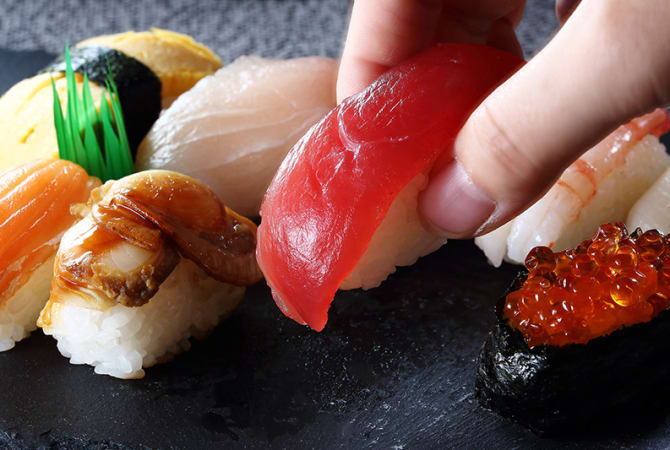
A city where you can enjoy food
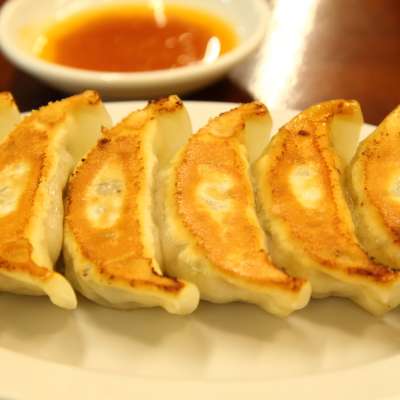
Distinctive Markets
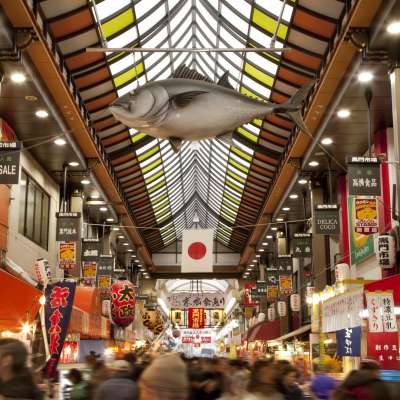
Food features
A gastronomic journey in nara.
Please Choose Your Language
Browse the JNTO site in one of multiple languages
More than just a bowl of noodles, ramen in Japan is an experience and a tourist attraction
TOKYO — Spicy, steaming, slurpy ramen might be everyone’s favorite Japanese food.
In Tokyo, long lines circle around blocks, and waiting an hour for your ramen is normal. What awaits might be just a dive, but a hot bowl of ramen rarely fails to hit the spot.
Often cooked right before your eyes behind dingy counters, the noodle dish starts here at around 1,000 yen ($6.50), and comes in various flavors and local versions. There’s salty, soy-based “shoyu” or “miso” paste. Perhaps it’s red-hot spicy with a dash of chili. Sometimes there’s no soup at all but a sauce to dip the noodles in.
The curly noodles are lighter than the darker buckwheat “soba,” or “udon,” which are also usually flatter or thicker.
GLOBAL SUCCESS
Ramen has also surged in popularity in the U.S. , South Korea and other countries. Retail sales in the United States have risen 72% since 2000, according to NielsenIQ, a sales tracker. In the 52 weeks ending April 13, Americans bought more than $1.6 billion worth of ramen.
In restaurants, versions beyond the traditional soup are appearing, said Technomic, a research and consulting company for the restaurant industry. Del Taco, a Mexican chain, recently introduced Shredded Beef Birria Ramen, for example.
Packaged ramen that’s easily cooked in hot water at home is called instant noodles; it’s precooked and then dried. The story of how Momofuku Ando invented instant ramen in a backyard shed in 1958, when food was still scarce, is the stuff of legend in Japan . He went on to found the food giant Nissin Foods.
Although convenient, instant noodles aren’t the same as the ramen served at restaurants.
THE EXPERIENCE
Some Japanese frequent ramen shops twice or three times a week. They emerge, dripping with sweat, smacking their lips.
“I’m probably a talking bowl of ramen,” says Frank Striegl as he leads a dozen American tourists through the back alleys of Tokyo’s funky Shibuya district on what he calls “the ultimate ramen experience.”
The crowd is led behind a shabby doorway, sometimes down narrow stairs, to a dim-lit table where ramen gets served in tiny bowls, practically the size of a latte cup, or about a quarter of a regular ramen bowl. That’s so guests have enough room in their tummies to try out six different kinds of ramen, two at each spot during the tour.
One restaurant, Shinbusakiya, offers “Hokkaido classics” from the northernmost main island, while another, Nagi, offers “Fukuoka fusion,” from the southern main island of Kyushu. It includes a green ramen, similar to pasta al pesto. Syuuichi, which means “once a week,” features curry-flavored ramen.
“It’s not just, of course, about eating delicious ramen, but also learning about it,” said Striegl, a Filipino American who grew up in Tokyo. He calls ramen “people’s food.”
“A lot of countries around the world have their version of ramen in a way,” he said. “So I think because of that, it’s a dish that’s easy to understand. It’s a dish that’s easy to get behind.”
While the tour participants were relishing their noodles, Striegl outlined a brief history of ramen: Its roots date back to the samurai era, when a shogun took a fancy to Chinese noodles, setting off the localizing journey for ramen that continues today.
Katie Sell, a graduate student on Striegl’s tour, called ramen “a kind of comfort food, especially in the winter. Get a group of friends, go have some ramen and just enjoy it.”
Kavi Patel, an engineer from New Jersey, said he was glad he included the humble ramen on his tour of Japan, along with more established attractions like the ancient capital of Kyoto and the deer park in Nara. “I’m having good fun,” he said.
ADJUSTING TO CHANGE
While ramen has never been more popular in Japan, ramen places have struggled because of the pandemic, the weakening Japanese yen, and the higher cost of wheat imports and energy, according to a study by Tokyo Shoko Research.
One beneficiary of the pandemic is a home delivery service for frozen, professionally cooked ramen. Called takumen.com, it boasts some 500,000 subscribers in Japan.
Another Tokyo operation, Gourmet Innovation, has signed on 250 of the country’s top ramen joints to sell packaged versions of their soup, noodles and toppings, to be heated up in boiling water and served at home.
Co-founder and executive Kenichi Nomaguchi, who hopes to expand his business overseas, says ramen and animation are Japan’s most successful exports.
Why ramen? Unlike pasta or curry, ramen is difficult to replicate at home, he said, Making it from scratch involves hours of cooking stock, with pork, beef or chicken, various fish or bonito flakes, and “kombu” kelp. Some stock uses oysters.
LOTS OF VARIETY
Besides the different soup stocks and flavors, onions, grated garlic, ginger or sesame oil can be added for extra punch. Toppings can include bean sprouts, barbecued pork, boiled or raw eggs, seaweed, fermented bamboo shoots called “menma,” chopped green onions, cooked cabbage, snow peas or corn.
Some insist a bowl of ramen is not complete without a slice of narutomaki, a whitefish cake with a pink spiral pattern.
Unusual varieties include coffee ramen and ramen topped with ice cream or pineapple.
Jiro-style ramen, named for a legendary restaurant in Tokyo, features mounds of vegetable toppings, huge steak-like barbecued pork and pungent, grated garlic seeped in a fatty pork-based stock.
“Impact is important. So the pork has to be big so it’s truly memorable,” said Kota Kobayashi, who serves Jiro-style ramen at his chain, “Ore No Ikiru Michi,” which translates to, “The way I live my life.”
Kobayashi is a former professional baseball player at the Yokohama Bay Stars, and played with the minor league Cleveland Guardians before switching to his ramen business.
“When I quit baseball, I chose ramen as my way of life,” he said with a smile.
He can wax philosophical about ramen. One cultural difference he has observed is that Americans tend to leave the noodles and drink all the soup, while the Japanese mostly do the opposite.
And taste is only part of what makes good ramen. One must also offer entertainment, Kobayashi said.
At his restaurants, the chopsticks are tucked in a box on a shelf, so first-time visitors ask where they are. Repeat customers go straight to that box. Kobayashi calls out, “Welcome back,” making the customers feel a connection, even if he doesn’t remember a thing about them.
Dee-Ann Durbin contributed to this story from Detroit.
Yuri Kageyama is on X: https://twitter.com/yurikageyama


IMAGES
VIDEO
COMMENTS
Food Tours Japan helps you discover the best gourmet experiences in Japan, the world's number one food destination. Pack your chopsticks, and dive into elegant and harmonious cuisines developed from centuries of artistry, to deliciously addictive soul foods. Tokyo.
Food tours, cooking classes, dining experiences & tastings in Japan. Enjoy a meal in Japan and help children around the world. Experiences, Restaurants, Market. ... There's more to Japanese food than just sushi and ramen. Areas of Japan. Learn about the 47 prefectures of Japan, their top attractions, and what to do there.
Most Comprehensive Japan Food Tour. Immerse yourself in a captivating culinary journey with our Flavors of Japan 7 Day Tour Package. Showcasing the delectable cuisines of Tokyo and Kyoto, this tour is perfect for foodies seeking a blend of history, culture, and delectable delights. With pre-arranged accommodations and activities, you can relax ...
Sit at a sushi counter, dine at a traditional ryotei, eat vegetarian shojin ryori in a monastery or enjoy casual food at an izakaya or yatai food stall. Complement traditional and modern takes on Japanese cuisine with sake from a local brewery in Niigata, sip on sweet potato shochu in Kagoshima , or try one of Japan's highly-acclaimed whiskies ...
Chris D. Grand Cayman104 contributions. Ninja Shinjuku—Don't Miss It! Review of: Shinjuku Izakaya Food Tour. Written April 20, 2024. This review is the subjective opinion of a Tripadvisor member and not of Tripadvisor LLC. Tripadvisor performs checks on reviews. Vacation14252104344. 1 contribution.
Osaka Food Tour (13 delicious dishes at 5 hidden eateries) With Andy, your Japanese-Australian cultural guide and interpreter, you'll experience Osaka like a local. Hop between food stalls and eateries, drinking and eating your way through the city's best hidden gems. from ¥13,000. (23) With 2 drinks.
Small Group Gourmet Food Tours, Japan. Our 2024 &2025 Food Tours of Japan are adventures, where you can see the sights and nature, experience the culture, and eat exceptional food. Journey to the East's Food Tours of Japan are a wonderful way to see Japan. Their foundation,' Washoku', Japanese food, is UNESCO recognised as an Intangible ...
Scrumptious food tours in Tokyo Japan you need to experience. Home to over 36 million people making it the globe's largest populated city, it's obvious that Tokyo is one of the best places to visit in Japan for foodies.In turn, a food tour is one of the most fun things to do in Tokyo!
Karaage: Japan's mouthwatering take on fried chicken. Katsuobushi: Some travelers resist the ubiquitous bonito fish flakes, but those who love them do so with a passion. They're served on top of a variety of foods, including tofu and takoyaki. Kushi-katsu: Deep-fried skewered meats and vegetables.
To assist you in making a decision, we have assembled a list of 32 delectable Japanese dishes that everyone should experience. 1. Buta-No-Shogayaki (豚の生姜焼き): The 'B-Grade Gourmet' Ginger Pork Classic. Buta-No-Shogayaki: A sizzling ginger-infused pork dish that's a household favorite.
What are Food Tours? Japan's culinary landscape is a delightful fusion of tradition, innovation, and an unparalleled commitment to quality. What makes Japanese food truly special is its emphasis on fresh, seasonal ingredients, meticulous preparation methods, and a deep-rooted respect for the art of cooking.
6. Tonkatsu. Tonkatsu is a popular Japanese dish based on western pork cutlets, where a thick slice of pork is dipped in a flour and beaten egg batter, coated in breadcrumbs and fried in oil. There are both sirloin and fillet tonkatsu, with the fillet tonlatsu being more expensive.
We have some recommendations for guided tours that included between 12 and 14 day itineraries. Intrepid Travel offers a 12 day Real Food Adventure In Japan. It hits some of our favorite food cities in the Kansai region of Japan. That includes Osaka, Kyoto, and Kyosan in Wakayama.
4. Japanese Food is Popular Abroad. Another main reason for the increase in food tourism in Japan is the worldwide recognition and popularity of Japanese cuisine. Between 2006 and 2017, the number of Japanese restaurants abroad increased nearly fivefold! In 2019, New York City gained 16 Michelin-starred restaurants; of these, half are Japanese ...
Hunt for wild vegetables (Sansai) with an expert and learn traditional cooking methods with locals. Travel to 'Kyoto's Kitchen', Nishiki Market, where you can buy snacks and local foods. Enjoy an exclusive and traditional Japanese Kaiseki meal. Participate in a traditional green tea ceremony. Witness the process and try your hand at making ...
Explore the best of Japan's food - from its popular classics like sushi, ramen, Wagyu, tonkatsu, teppanyaki and soba, through to its regional favourites like Kobe beef, Hiroshima okonomiyaki and Okinawan soul food. ... Japan Travel is the leading resource for Japan travel information and the primary destination for visitors planning and ...
Tsukiji Fish Market Food Walking Tour. 287. Foodies and seafood lovers won't want to miss this tour to one of the most famous markets in the world: Tokyo's Tsukiji Fish Market. See where tons of fish and seafood are traded every day, and get the chance to try some seriously fresh seafood at the stalls around the market.
Guided food tours in Tokyo and Kyoto helping visitors discover the best Japanese foods in hidden local gems. Cart 0. ... Japan Food Tours. The best food tour. As Featured In. Sushi Bowl and Uni. Book a tour. Footer_home . Japan Food Trips. Shibuya, Japan. 8183704358 [email protected]. Hours.
4. Udon. Udon is a popular Japanese dish that's an easy introduction to Japanese food for tourists. It can be served a number of different ways, with a variety of ingredients, but it is most commonly served in noodle soups. Pictured above is a delicious beef udon noodle soup that we enjoyed in Kyoto, Japan.
Common tsukemono you might receive with a Japanese meal includes pickled cabbage, kimchi, or daikon radish. Sometimes with bright colors and crunchy textures, tsukemono always make for a nice accompaniment to any meal by adding a freshness and cleansing element. 34. Udon.
Spicy, steaming, slurpy, ramen might be everyone's favorite Japanese food. In Tokyo, there are lines around the block, and the ramen is often cooked right before your eyes behind dingy counters. ... Frank Striegl, right, a guide of Tokyo Ramen Tours, explains foreign participants of a ramen tasting tour at Shinbusakiya, a ramen shop which ...
The story of how Momofuku Ando invented instant ramen in a backyard shed in 1958, when food was still scarce, is the stuff of legend in Japan. He went on to found the food giant Nissin Foods.
A staff member prepares to serve noodles for participants of Tokyo Ramen Tours at Syuuichi, which means "once a week," featuring curry-flavored ramen, at Shibuya district on April 2, 2024, in Tokyo.
The story of how Momofuku Ando invented instant ramen in a backyard shed in 1958, when food was still scarce, is the stuff of legend in Japan. He went on to found the food giant Nissin Foods.
Perhaps the epitome of Japanese cuisine is the kaiseki food served at ryotei (traditional Japanese restaurants). But the scope also includes numerous vegetarian varieties, river fish dishes, sushi, eel, tempura, soba, udon, takoyaki, okonomiyaki, yakiniku and more. Each region also has its own local specialties and culinary traditions in dishes ...
More than just a bowl of noodles, ramen in Japan is an experience and a tourist attraction By: Yuri Kageyama, The Associated Press Posted: 11:31 PM CDT Wednesday, Apr. 24, 2024 Last Modified: 4:10 ...
Food, Travel and Tech Japan is launching a digital nomad visa—here's everything you need to know Life 13 budget-friendly places couples can retire abroad and live on $1,500/month
A staff member prepares small bowls of noodle for participants of Tokyo Ramen Tours at Shinbusakiya, a ramen shop which offers "Hokkaido classics," at Shibuya district on April 2, 2024, in Tokyo.